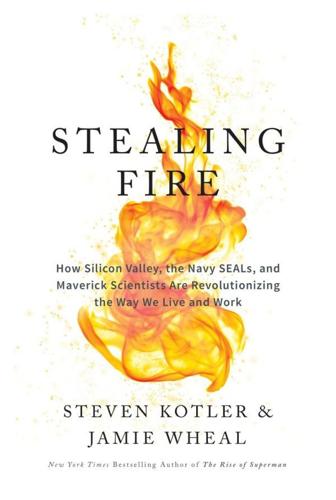
Stealing Fire: How Silicon Valley, the Navy SEALs, and Maverick Scientists Are Revolutionizing the Way We Live and Work
by
Steven Kotler
and
Jamie Wheal
Published 21 Feb 2017
With so much experience in self-organizing”: Peter Hirshberg, From Bitcoin to Burning Man and Beyond ([N.p.]: Off the Common Books, 2014). 22. It’s for this reason that Rosie von Lila: Author interview with Rosie von Lila, July 25, 2016. 23. Burning Man demonstration projects”: Washoe Tribe installing solar panels at seven sites,” Record-Courier, June 8, 2015; “Stained Glass ‘Space Whale’ to Blow Minds at Burning Man,” Reno-Gazette Journal, November 13, 2015; “How a Chat App for Burning Man Turned into a Tool for Revolution,” AdWeek, March 25, 2015. 24. Burning Man didn’t invent the festival: Hirshberg, From Bitcoin to Burning Man and Beyond. 25.
…
Whatever else can be said about the event, Burning Man holds the undisputed title as the world’s largest ecstatic trade show. “Burning Man aggressively extends the tradition of hedonic ecstasy,”1 writes Erik Davis. “[Wild] visuals, disorienting sonics, and a self-conscious excess of sensory stimulation . . . all help undermine stabilized frames. . . . [It’s a] full-sensorium brain machine designed to bring us in tune with our mind’s ongoing construction of real-time on the fly.” Michael Michaels, one of Burning Man’s original founders2 (and known as “Danger Ranger” at the event), explains it this way: “At Burning Man, we’ve found a way to break out of the box that confines us.
…
“I do not seek recognition”: Posted by Mark Divine, “The Navy Seal Code,” NavySeals.com, 2016. 12. “Larry and I [had] managed”: Gregory Fernstein, “How CEOs Do Burning Man,” Fast Company, August 27, 2013. 13. . . . New York Times’ John Markoff’s assessment”: John Markoff, “In Searching the Web, Google Finds Riches,” New York Times, April 13, 2003. 14. The company that set the bar: For a complete breakdown of Google’s involvement at Burning Man, see Fred Turner, “Burning Man at Google,” New Media & Society 11 (2009): 73–94. 15. Eric was the only one: Gregory Ferenstein, “How CEOs Do Burning Man,” Fast Company, August 27, 2013; John Markoff, “In Searching the Web, Google Finds Riches,” New York Times, April 13, 2003; and the original citation, Doc Searls, Harvard Berkman fellow, 2002, http://doc.weblogs.com/2002/12/10. 16.

Future Sex
by
Emily Witt
Published 10 Oct 2016
In the background was the sound of whip-its, of orgasms, of water falling from a shower into a porcelain tub. BURNING MAN I wanted to go to Burning Man because I saw the great festival in the desert as the epicenter of the three things that interested me most in 2013: sexual experimentation, psychedelic drugs, and futurism. But everyone said Burning Man was over, that it was spoiled. It was inundated with rich tech people who defied the festival’s precious tenet of radical self-reliance by their overreliance on paid staff. Burning Man, which started in 1986 when twenty people burned an effigy on the beach, was turning into a dusty version of Davos.
…
He was dour, as one hopes a Russian to be. “First time in America. First time at Burning Man,” he said with a thick accent. We asked if he would take Burning Man back to Russia. “There is no place like this in Russia,” he said. “There would be rain.” We left the space station, bicycling toward the Temple of Whollyness, where some friends of friends of his were due to be married that afternoon. We passed a Mayan pyramid topped with the giant thumbs-up of a Facebook “like,” which would later be set on fire. Lunar Fox told me about the first time he had come to Burning Man, in 1999. None of this had yet existed—Facebook likes, cell phone cameras, Russian delegations.
…
Humans were supposed to be silly from time to time, was what Elizabeth now suspected—also that the anticipated punishment for having too much fun would not arrive like an answer to a question. Punishment might, in fact, never arrive at all. On the final Saturday of the festival, when the Burning Man was set on fire and tens of thousands of people converged in the expanse of the desert to dance, Elizabeth met a man. He was an engineer, so probably smart. He smelled bad but it was Burning Man. She was on MDMA, feeling as certain as a plumb line, as constant as neon. The dust was velveteen, the sky concave and luminous, the music circadian. She fell in and out of love on the same roll, but they had sex, and she confirmed a second fundamental principle of the way she wanted to be in the world, something she had felt since the first time she took MDMA.
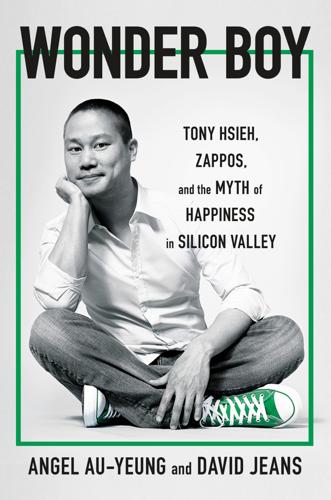
Wonder Boy: Tony Hsieh, Zappos, and the Myth of Happiness in Silicon Valley
by
Angel Au-Yeung
and
David Jeans
Published 25 Apr 2023
Two years before, on the final night of the festival, Tony had been watching the main ceremony—the burning of the sculpture at the center of Black Rock City—when a man he had just been talking to ran into the fire and died. Now it was Tony’s ninth time at Burning Man and Tyler’s sixth. There were first-time Burners in their camp this year, including Tony’s parents and his former girlfriend Michelle D’Attilio. For Tony, Burning Man was a place where he could search for inspiration and ideas. Weeks after his first burn on the playa in 2011, he invited four of the founding leaders of Burning Man to Las Vegas to discuss how he could apply the ten principles of Burning Man to Zappos and to the yet undeveloped Downtown Project he planned to build. And through the years, he continued the tradition of taking what he could out of the playa into “the default world”—a term that Burners used in reference to the rest of the year spent away from the festival.
…
he invited four of the founding leaders: Burning Man Project, “Tony Hsieh’s Legacy Reminds Us All of the Importance of Community,” December 10, 2020, https://journal.burningman.org/2020/12/news/global-news/tony-hsieh-legacy/. Tony purchased a gutted Boeing 747: Johnson, Shea, “Zappos Will Use Burning Man 747 Jet for Downtown Project,” Las Vegas Review-Journal, February 17, 2020, https://www.reviewjournal.com/news/politics-and-government/las-vegas/zappos-will-use-burning-man-747-jet-for-downtown-project-1959430/. “Metamorphoses”: “2019 Art Theme: Metamorphoses,” Burning Man website, https://burningman.org/about/history/brc-history/event-archives/2019-event-archive/2019-art-theme-metamorphoses/.
…
But he was no longer that kid, and he was excited to experience the community that had inspired so much of Tony’s work in Zappos and downtown Las Vegas. That first year, Tony never left his side; he wanted to make sure his newest member of the Burning Man crew was having a good time. It was almost as if he wanted to vicariously experience going to Burning Man for the first time again through Tyler. He took videos of Tyler’s awed reactions to Black Rock City: tens of thousands of individuals coming together to create a world of kaleidoscopic art and rapture as the sun went down. He had gone to Burning Man every year since, and they had experienced some wild events. Two years before, on the final night of the festival, Tony had been watching the main ceremony—the burning of the sculpture at the center of Black Rock City—when a man he had just been talking to ran into the fire and died.
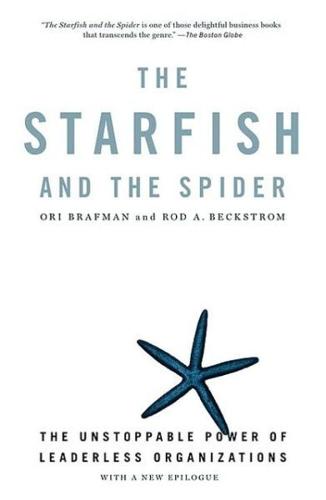
The Starfish and the Spider: The Unstoppable Power of Leaderless Organizations
by
Ori Brafman
and
Rod A. Beckstrom
Published 4 Oct 2006
The matter is then debated in the public forum until users agree on some sort of compromise, at which time the page is quickly unlocked. But Wikipedia always strives to keep pages open. Even Quadell's page—though regularly vandalized— remains open. Burning Man The Burning Man festival, which happens yearly in the Nevada desert, is known for eclectic costumes, rave music, and a host of naked people on Ecstasy and pot. It's also the only 24/7 decentralized experience you can find these days. Because of its wild reputation, there's a certain embarrassment associated with going to Burning Man—if your coworkers ever tell you that they're taking "a weekend trip to the desert" just before Labor Day, chances are they're not telling you the whole truth.
…
That's the second decentralized quality of Burning Man—it's based on a gift economy. You provide things—from snow cones to hand-decorated T-shirts—because you want to, as a way to contribute to the community, not because you expect anything in return. The only things that you can pay for at Burning Man are ice and coffee. All proceeds rom both go to support the local school district. It's strange how quickly you get used to this gift economy. It's liberating to feel that nobody is trying to sell you anything. If you want their product, you can have it. If you don't, that's fine. But Burning Man wasn't all about exchanging free gifts.
…
Circles gain freedom and flexibility when they go virtual, but THE STARFISH AND THE SPIDER there's a reason thousands of people travel all the way to the Nevada desert for a week once a year. Being in the physical presence of other participants adds a dimension of closeness, and a sense of ownership emerges. Members make Burning Man what it is, not some event production company. When you attend Burning Man, you become part of the organization. You own the experience and develop a sense of responsibility and belonging. That's why a virtual Burning Man isn't very appealing. Similarly, an AA circle depends on physical contact to keep members accountable to one another. When you see people face to face, it's harder to brush them off. Because circles don't have hierarchy and structure, it's hard to maintain rules within them; no one really has the power to enforce them.

Survival of the Richest: Escape Fantasies of the Tech Billionaires
by
Douglas Rushkoff
Published 7 Sep 2022
Douglas, “Gamification to Prevent Climate Change: A Review of Games and Apps for Sustainability,” Current Opinion in Psychology 41 (December 1, 2021): 89–94, https:// doi .org /10 .31219 /osf .io /3c9zj. 107 Evgeny Morozov points out : Evgeny Morozov, To Save Everything, Click Here: The Folly of Technological Solutionism (New York: PublicAffairs, 2013). 107 Hook Model : Nir Eyal, Hooked: How to Build Habit-Forming Products (New York: Portfolio, 2014). 108 Red flags abound : Andrea Valdez, “This Big Facebook Critic Fears Tech’s Business Model,” Wired , March 10, 2019, https:// www .wired .com /story /this -big -facebook -critic -fears -techs -business -model /. 108 “as big an existential threat” : The Social Dilemma, directed by Jeff Orlowski (Exposure Labs, The Space Program, Agent Pictures, 2020). 109 “They’re willing to see” : Douglas Rushkoff, interview with Naomi Klein, Team Human podcast, August 4, 2021, https:// www .teamhuman .fm /episodes /naomi -klein. Chapter 9: Visions from Burning Man 112 Shark Tank : A reality show where entrepreneurs pitch billionaires including Mark Cuban and Barbara Corcoran for investment. 113 “It’s well documented” : Nellie Bowles, “ ‘Burning Man for the 1%’: The Des ert Party for the Tech Elite, with Eric Schmidt in a Top Hat,” Guardian , May 2, 2016, https:// www .theguardian .com /business /2016 /may /02 /further -future -festival -burning -man -tech -elite -eric -schmidt. 113 “It’s important” : Bowles, “ ‘Burning Man for the 1%.’ ” 118 funneling capital from Colombia : Keith Larsen, “Investors Accuse Prodigy Network of Fraud at Troubled Park Ave Development,” Real Deal, September 24, 2020, https:// therealdeal .com /2020 /09 /24 /investors -accuse -prodigy -network -of -fraud -at -troubled -park -ave -development /. 118 charges of fraud : Global Property and Asset Management Inc., “Panic at Prodigy,” October 3, 2019, https:// globalpropertyinc .com /2019 /10 /03 /panic -at -prodigy /. 118 “game of life” : “Akasha—The Game of Life,” https:// www .playakasha .com, accessed August 10, 2021. 119 “exponential technologies … moonshots” : Singularity University, “An Exponential Primer,” https:// su .org /concepts /, accessed August 10, 2021. 119 “entrepreneurial leaders … planetary scale” : Singularity University, “Singularity University,” https:// su .org /, accessed August 10, 2021. 120 MacArthur Foundation : MacArthur Foundation, “100 & Change,” https:// www .macfound .org /programs /100change /. 122 She hated Robert Moses’s : Jane Jacobs, Systems of Survival: A Dialogue on the Moral Foundations of Commerce and Politics (New York: Random House, 1992). 123 new urbanism now amounts to : Rushkoff, Life Inc.: How Corporatism Conquered the World, and How We Can Take It Back (New York: Random House, 2009), 74–83. 124 Rutt has applied : Jim Rutt, “A Journey to Game B,” Medium , January 14, 2020, https:// medium .com /@memetic007 /a -journey -to -gameb -4fb13772bcf3. 125 President Eisenhower : Center for the Study of Digital Life, http:// digitallife .center /, accessed August 10, 2021. 125 “Yet in holding scientific” : Dwight D.
…
As Google’s Eric Schmidt put it, “It’s well documented that I go to Burning Man. The future’s driven by people with an alternative worldview. You never know where you’ll find ideas.” This style of engagement and exploration has grown so intense that A-list executives have created a version of Burning Man just for themselves—without the throngs of artists, musicians, and commoners who are attending for the experience of collective creativity alone. The Further Future festival of 2016, for example, adapted the aesthetics of Burning Man into an expensive alternative where entrepreneurs could do the same psychedelics but under luxury conditions, and with the express purpose of making deals.
…
Like the birth of the internet itself, the life cycle of a techno-savior tends to begin with a psychedelic initiation, where the hero takes the red pill. This often happens at Burning Man, which has, since its humble origins as an impromptu summer solstice ritual for a couple of dozen people, grown into a desert festival with an attendance of over 70,000 burners. Instead of small tents and sleeping bags, participants—particularly the wealthy ones—now arrive in air-conditioned RVs with servants and chefs. While opinions vary on whether Burning Man has stayed true to its original ethos, the festival remains highly psychedelic, and has made the taking of acid, mushrooms, or even stronger entheogens into something of a rite of passage for the would-be enlightened tech executive.

Life After Google: The Fall of Big Data and the Rise of the Blockchain Economy
by
George Gilder
Published 16 Jul 2018
In 2009, the Stanford philosopher Fred Turner published a paper titled “Burning Man at Google: A Cultural Infrastructure for New Media Production,” in which he unveiled the religious movement behind Google’s system of the world. An annual weeklong gathering at Black Rock in the Nevada desert, Burning Man climaxes with a kind of potlatch. While some thirty thousand ecstatic nerds, some of them half-naked, dance and ululate below, techno-priests ignite a forty-foot genderless wooden statue together with a temple in the sand full of vatic testimonies. Like Google, Burning Man might be termed a commons cult: a communitarian religious movement that celebrates giving—free offerings with no expectation of return—as the moral center of an ideal economy of missionaries rather than mercenaries.
…
Immediacy: no idea can substitute for immediate experience . . . participation in society, and contact with a natural world exceeding human powers. But Brin and Page see no contradiction between Burning Man’s ethos and Google’s. They attend Burning Man often, as does Eric Schmidt, whose hiring was allegedly eased by the knowledge that he was a fellow devotee. Google’s headquarters, Building 43 in Mountain View, is often decorated with photographs of the desert rites. The first Google logo bore a burning man stick figure.7 To the extent that Google’s founders profess religious impulses, this gathering in the desert sums them up. A critic might cavil at the stress on “art offered as a gift.”
…
Open source gives Google platforms a facile extensibility that casts a shadow over the projects of potential rivals. Meanwhile, Google cherishes secrecy where its own intellectual property and practices are concerned. Perhaps the liturgies of Burning Man simply reveal the sanctimony of Silicon Valley atheists at play. Echoing the 10 Principles of Burning Man is Google’s corporate page presenting “Our Philosophy,” a guide to its system of the world in the form of “ten things we know to be true.” These ten principles, like Burning Man’s, seem unexceptionable on the surface, but each item harbors a subversive subtext. Focus on the user and all else will follow. (Google’s “gifts” to the user bring freely granted personal information, mounting to the revelatory scale of Big Data.)

Girl Walks Into a Bar . . .: Comedy Calamities, Dating Disasters, and a Midlife Miracle
by
Rachel Dratch
Published 29 Mar 2012
Imagine my glee when forcing myself out of the comfort zone gave me results: A cute guy who seemed nice and funny asked me out. I had been invited to a holiday party by a friend named Henry, whom I met at Burning Man a few years back. Yes, I, Rachel, went to Burning Man—odd, since I’m not into doing drugs or walking around without my shirt on, which are the two most popular activities that occur at Burning Man. I went one year with one of my best friends, also named Rachel, who has gone to Burning Man every summer for eight years. If you aren’t familiar with Burning Man, it’s a festival out in the middle of a desert in Nevada, where you have to bring in all your own food, supplies, tents, RVs, what have you.
…
The favorite description I saw was for a seminar on oral sex that you were supposed to attend with your partner. It advised, “Bring wipes. The desert can give you that not-so-fresh feeling.” The coolest part about Burning Man to me were the huge art installations, some several stories high, which are truly amazing. There are also “art cars”: Someone will take, say, an old school bus and magically transform it into a light-up dinosaur that, when driven through the desert at night, is absolutely beautiful. That said, one Burning Man was enough for me. I’m not an eight-timer like my friend Rachel. I’m no high-maintenance traveler, but being out in the middle of the desert with inconveniently located port-a-potties when you are not high on some drug to make you think you are somewhere else just isn’t really my jam.
…
But let me warn you now, that can happen at Burning Man. It wasn’t the Pee Robot Police. It was just an accidental intersection of art and human need. Flooded in bright white light as if I were in a sci-fi movie, I frantically struggled to pull up my pants, getting pee all over myself in the process. Besides having the social instinct to not be caught with my pants down, for a second I was consumed with the primal fear that this robot was going to fix its metal eye on me, lean in, pick me up, and fling me across the desert. A sculpture of a fifty-foot woman in the middle of the desert—just another day at Burning Man. A lot of people walk around naked at Burning Man, as I said.

This Is Your Country on Drugs: The Secret History of Getting High in America
by
Ryan Grim
Published 7 Jul 2009
Eventually, I had a network of people poking around for it at concerts and festivals across the country, as well as in towns where you’d expect to find it, such as Boulder and San Francisco. They found nothing—and no one who’d even seen a hit of LSD since sometime in 2001—even at Burning Man, a gathering of thousands in the desert of Nevada. Strolling around Burning Man and being unable to find acid is something like walking into a bar and finding the taps dry. In the fall of 2002, I enrolled at the University of Maryland ’s public-policy school in College Park, in the suburbs of Washington, D.C. Here, too, I continued my search for acid—and found the campus dry.
…
Larry Page and Sergey Brin, the founders of Google, are longtime Burners, and the influence of San Francisco and Seattle tech culture is everywhere in the camps and exhibits built for the eight-day festival. Its Web site suggests, in fluent acidese, that “[t]rying to explain what Burning Man is to someone who has never been to the event is a bit like trying to explain what a particular color looks like to someone who is blind.” At the 2007 event, I set up my tent at Camp Shift—as in “Shift your consciousness”—next to four RVs rented by Alexander and Ann Shulgin and their septua- and octogenarian friends from northern California. The honored elders, the spiritual mothers and fathers of Burning Man, they spent the nights sitting on plastic chairs and giggling until sunrise. Near us, a guy I knew from the Eastern Shore—an elected county official, actually—had set up a nine-and-half-hole miniature golf course.
…
It was a spectacle of consumption, hedonism, and philanthropy that was as multifaceted and American a phenomenon as you could imagine, but I was there with just one real purpose: looking, again, for LSD. When acid disappeared earlier in the decade, its near total absence at Burning Man was the example given by heads to demonstrate the profundity of the loss. “There was no acid at Burning Man!” said astonished longtime Burner Mark Pesce when I asked him about the drought a couple of years before. When I first wrote about acid’s disappearance, in 2004, I relied on published data, some cultural musing, and a lot of personal observation in the form of interviews with dozens of people who ought to know whatever there was to know about LSD.

Valley of Genius: The Uncensored History of Silicon Valley (As Told by the Hackers, Founders, and Freaks Who Made It Boom)
by
Adam Fisher
Published 9 Jul 2018
R. U. Sirius: And then, again, there was this huge adoption of Burning Man by the tech culture. Really, suddenly, it became this massive thing that everybody had to do. Joey Anuff: The SRL, rave kind of vibe coalesced into the Burning Man thing. Tiffany Shlain: Burning Man was a big through line! We all went there for years. Amy Critchett: So Michael Mikel, who was one of the founders of Burning Man, was a handyman for Wired. So it definitely was a presence in the early days of Wired. Michael Mikel: I was involved with Burning Man from pretty close to the beginning. I brought in a lot of tech people.
…
He liked us and he just wanted to sort of push us forward. Larry Page: It was pretty unreal. Sergey Brin: It was like, That was pretty easy! Brad Templeton: Then they went to Burning Man. Ray Sidney: Sergey put up a Burning Man logo on the website. It was the first Google Doodle. Marissa Mayer: It was more of an out-of-office notification than anything else—it said, “We’re all at Burning Man.” Brad Templeton: There was a Google contingent that camped at Burning Man. I remember saying something rude to Marissa that I shouldn’t have said about wanting to see her naked. She won’t remember that, I hope. Marissa Mayer: Remember, we were all young, and we were all, in addition to being coworkers, friends.
…
Amy Critchett: My crew, we started going in 1994. Justin Hall: Burning Man in 1994 was just a mass of people who were all parked in the middle of the desert in any which way. I don’t remember where people pissed and shit. There certainly were no Porta Potties. There were no organized roads. There were motorcycles and there were dogs and there were fireworks and there were probably guns. I remember dropping acid that had Beavis’s and Butt-Head’s faces printed on it. Then this man burned and I jumped over it in my toga and Birkenstocks or whatever. It was the core essence of what Burning Man is today just with two thousand people or something.

Nothing but Net: 10 Timeless Stock-Picking Lessons From One of Wall Street’s Top Tech Analysts
by
Mark Mahaney
Published 9 Nov 2021
Finally, they were impressed by the fact that Schmidt was the only CEO applicant who had actually been to Burning Man, the annual communal event in the Nevada desert geared around “creation, revelry, inclusion, and endurance.” Maybe, in fact, attendance at Burning Man should be considered a key criterion for management excellence. Table 8.3 recalls Table 8.1, suggesting a loose correlation between tech company success and CEO Burning Man attendance. Perhaps the right question for investors to ask any tech CEO is: “Have you been to Burning Man?” TABLE 8.3 Correlation Between Burning Man Attendance and Tech CEO Excellence Steve Jobs’s tenure excludes the period when Jobs left Apple in 1985 and rejoined in 1997; it’s unclear whether Jobs went to Burning Man, but his image was in the musical Burning Man.
…
TABLE 8.3 Correlation Between Burning Man Attendance and Tech CEO Excellence Steve Jobs’s tenure excludes the period when Jobs left Apple in 1985 and rejoined in 1997; it’s unclear whether Jobs went to Burning Man, but his image was in the musical Burning Man. Market cap as of Febuary 9, 2021. As for the ability to be forthright about mistakes and challenges, three quick examples come to mind. First, the October 19, 2011, public video apology by Reed Hastings (“Netflix CEO Reed Hastings Apologizes for Mishandling the Change to Qwikster”) is a rare public mea culpa in the annals of corporate America. Hastings took a lot of flak for that—including for wearing a teal, partly buttoned shirt during the video—but his directness and willingness to accept responsibility did give him and the company long-term credibility in the eyes of some investors.
…
Founder-led companies (practically all the biggest tech stocks have been founder-led), long-term orientation (like Zuckerberg with 1-, 5-, and 10-year goals), great industry vision (Hastings essentially inventing streaming), a maniacal focus on customer satisfaction (read the Amazon shareholder letters), deep technology backgrounds and operating benches, a deep focus on product innovation, the ability to recruit and retain the best talent, and the ability to be forthright with employees and investors about mistakes and challenges. You will rarely get all of these, and you don’t need to have all of these. But you’ll want to find most of these to believe in the quality of the management team. Finding management teams that pass the Burning Man Test might also be useful. . . .) Unlike investment funds, with management teams, past performance is an indicator of future performance. When you have management teams that have built successful track records, you stick with them. A successful track record doesn’t mean consistently beating Street quarterly earnings estimates—that’s expectations management, not fundamentals generation.
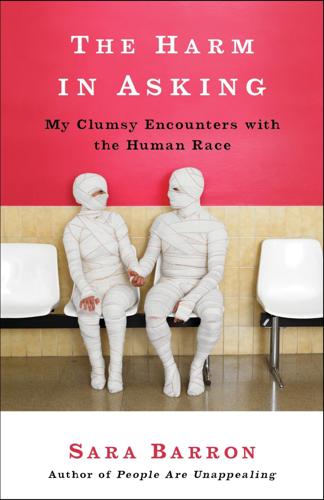
The Harm in Asking: My Clumsy Encounters With the Human Race
by
Sara Barron
Published 25 Mar 2014
The event felt terribly precious, and this was in light of the fact that my partner in crime was a Burning Man enthusiast who measured in at five-foot-four. I’m not talking shorter than I am if I’m in heels, I’m talking shorter than I am. Done. The Burning Man and I had been set up by Gwen, a mutual friend, and although Gwen had good intentions, she had horrific matchmaking skills. The Burning Man showed up to our date late and wearing a backpack, and then proceeded to talk almost entirely about Burning Man. On the rare occasions when the Burning Man permitted me to speak, he wouldn’t look me in the eye. He preferred scanning the room as I spoke. Now, in fairness, the Burning Man surely had complaints of his own about me: Like that I showed up in an unsavory thrift-store ensemble.
…
Like that I slapped myself to stay awake as he spoke incessantly about Burning Man. All in all, it was an unpleasant evening out. The thing was, though, our mutual disdain was this weird sort of turn-on, and that, I think, was how we wound up having sex. A little booze, a lot of self-loathing. You wind up having sex with people you despise. The Burning Man and I arrived in my bedroom. We got on with the usual business of things, but not before I forgot to draw the curtain on my window. It faced the street. Things went relatively well for, I don’t know, eight minutes? Maybe ten? But then I noticed the Burning Man watching himself in the mirror.
…
You can just imagine where the sexual momentum was at that stage. There’d been the mirror gazing, the chin knocking, the cherry-on-top that was the verbal interaction with Jan. I could not have felt any less engaged, and so was delighted when the Burning Man did an awkward slither of a dismount and said, “Uh, well, I should get going, I guess. I’ve got a full day of work tomorrow. And I’ve got all my Burning Man photos, which I have to edit down and post to Facebook.” I slapped myself in the face. “That sounds … rewarding,” I said. “But also exhausting. So, well, like you said: it’s probably time to go.” TWO WEEKS LATER, I was out for a power-walk through Prospect Park.
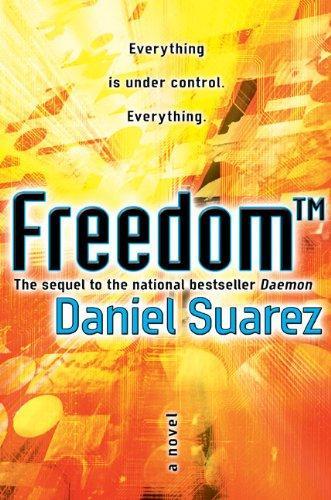
Freedom
by
Daniel Suarez
Published 17 Dec 2009
They nodded to each other, and then suddenly Ross saw a very strange series of D-Space alerts running through his HUD listing--all highest priority. They indicated the launch of a number of different processes he'd never heard of, but one of which caught his eye: Burning Man Instantiated. "Wait a minute. . . ." The sheriff frowned at him. "What?" Ross was tracking something moving along Main Street--a D-Space call-out unlike any he'd seen before. It was wreathed in flame and bore the name Burning Man, a two-hundredth-level Champion. Ross had never heard of such a level before. It was coming their way. "Get your HUD glasses on, Sheriff. Something's up." He looked like he'd had enough games, but he moved out of Ross's sight, while Ross tried to peek out into the street.
…
Table of Contents Title Page Copyright Page Dedication Epigraph Part One - December Chapter 1: // Dark Pool Chapter 2: // Operation Exorcist Chapter 3: // Going Viral Chapter 4: // End of the Line Chapter 5: // Getting with the Program Chapter 6: // Waymeet Chapter 7: // Shamanic Interface Chapter 8: // Erebus Part Two - March Chapter 9: // Seed Police Chapter 10: // Corn Rebellion Chapter 11: // Hunted Chapter 12: // Masterwork Chapter 13: // Epiphany Chapter 14: // The China Price Chapter 15: // Political Inversion Chapter 16: // Pwned Chapter 17: // Immortality Chapter 18: // Underworld Chapter 19: // Crossroad Chapter 20: // Data Curse Chapter 21: // Exploit Chapter 22: // Identity Theft Part Three - July Chapter 23: // Ultimatum Chapter 24: // Green Desert Chapter 25: // Black Ops Chapter 26: // Privacy Policy Chapter 27: // Reunion Chapter 28: // Sky Ranch Chapter 29: // Scorched Earth Chapter 30: // Quarantine Chapter 31: // Extermination Chapter 32: // The Burning Man Chapter 33: // Epic Fail Chapter 34: // Cold Reality Chapter 35: // Infil Chapter 36: // Downtime Chapter 37: // Logic Bomb Chapter 38: // Ghost from the Machine Chapter 39: // End Game Chapter 40: // Exit Strategy Further Reading Acknowledgements About the Author ALSO BY DANIEL SUAREZ Daemon DUTTON Published by Penguin Group (USA) Inc. 375 Hudson Street, New York, New York 10014, U.S.A.
…
Chapter 3: // Going Viral Darknet Top-rated Posts +175,383| What makes Roy Merritt's legend so powerful is that it was unintentional. He was a mere artifact on the surveillance tapes at the Sobol mansion siege, but his successful struggle against the impossible is what immortalized him as the Burning Man. PanGeo**** / 2,194 12th-level Journalist "Roy Merritt represented all that was best in us. That's what makes the loss of him so hard to bear." Standing before a flag-draped casket, the minister raised his voice to carry above a cold, Kansas wind. "I knew Roy from the time he was a child.
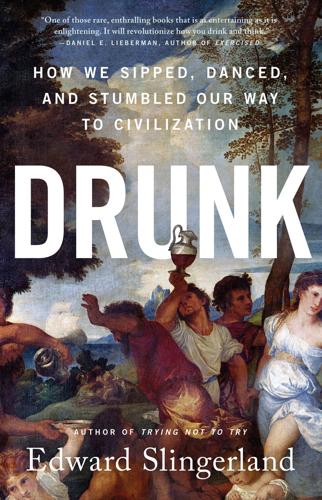
Drunk: How We Sipped, Danced, and Stumbled Our Way to Civilization
by
Edward Slingerland
Published 31 May 2021
In 1999, Google’s founders, Larry Page and Sergey Brin, featured the Burning Man logo on the Google home page to signal to the world that they (along with many of their staff) were headed to the festival, and CEO Eric Schmidt was reportedly hired because he was also a “Burner.” Collective experience of the intensity and physical discomfort of Burning Man is seen in the Valley as a way of building internal cohesion and culture. As Turner notes: Larry Harvey [one of the founders of the original Burning Man event in San Francisco] explained that the world outside Black Rock City was “based on separating people in order to market to them.” At Burning Man, he argued, participants would encounter the “immediacy” of art and through it, ecstatic feelings of community.
…
As the authors noted, “It appears that Disraeli’s observation that ‘There is moderation even in excess’ provides an appropriate context for the present results.”90 Perhaps the most epic bender one can imagine is the annual, weeklong event called Burning Man, held in the Black Rock Desert of Western Nevada. Burning Man is probably the closest experience a modern person will have to ancient Dionysian revels, an exhilarating, buzzing confusion of heat and dust, art and sex, music and dancing, mutant vehicles and wild outfits, social activism and experiments in collective living, all fueled by startling quantities of alcohol, psychedelics, and uppers, and heightened by severe sleep deprivation. As the sociologist Fred Turner notes, going to Burning Man has become something of a rite of passage among tech and information industry workers in Silicon Valley.
…
At Burning Man, he argued, participants would encounter the “immediacy” of art and through it, ecstatic feelings of community. In that sense, he implied that Burning Man would offer its participants the feeling of “effervescence” that Durkheim long ago argued formed the basis of religious feeling. Gathered in the desert, participants in the festival can feel an electric sense of personal and collective transformation.91 Some companies have even taken a shot at creating smaller versions of Burning Man in their own work retreats, aiming to capture that same sense of “group flow.” “One CEO of a small [tech] start-up,” Emma Hogan reports, “describes how, on an away-day with his company, everyone took magic mushrooms.
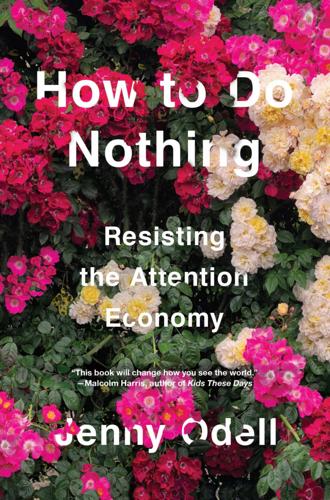
How to Do Nothing
by
Jenny Odell
Published 8 Apr 2019
In his tribute to Felix, who passed away in 2017 after a battle with brain cancer, Smiley Poswolsky writes that “Levi would spend hours (literally, hours) walking around with the production team at night, making sure each tree was perfectly lit and would make someone feel the magical power of being in nature.”6 The camp’s aesthetics, philosophy, and madcap humor suggest that the vibe that Felix was so meticulously designing for was specifically informed by Burning Man. And indeed, Felix was a Burning Man enthusiast. Poswolsky fondly recalls the time Felix was invited to speak alongside Dennis Kucinich at IDEATE, a camp at Burning Man. Felix took the opportunity to evangelize: Levi took a shot of tequila, made himself a Bloody Mary, and wearing a white dress and a pink wig, went over and spoke for forty-five minutes on the importance of unplugging from technology, as our friend Ben Madden played a Casio synth in the background.
…
I couldn’t tell you exactly what Levi said that morning since I was delirious, but I do remember that everyone who was there said it was one of the most inspiring talks they had ever heard. Much has been written lately about how Burning Man is not what it used to be. Indeed, it breaks most of the rules that Levi adopted for his own experiment. The festival, which started as an illegal bonfire on Baker Beach in San Francisco in 1986 before moving to Black Rock Desert, has become an attraction for the libertarian tech elite, something Sophie Morris sums up nicely in the title of her piece on the festival: “Burning Man: From far-out freak-fest to corporate schmoozing event.” Mark Zuckerberg famously helicoptered into Burning Man in 2015 to serve grilled cheese sandwiches, while others from the upper echelon of Silicon Valley have enjoyed world-class chefs and air-conditioned yurts.
…
Smiley Poswolsky, “The Man Who Gave Us All the Things: Celebrating the Legacy of Levi Felix, Camp Grounded Director and Digital Detox Visionary,” Medium, January 12, 2017: https://medium.com/dear-levi/the-man-who-gave-us-all-the-things-e83ab612ce5c. 5. Digital Detox, “Digital Detox® Retreats”: http://digitaldetox.org/retreats/. 6. Poswolsky. 7. Sophie Morris, “Burning Man: From far out freak-fest to corporate schmoozing event,” The Independent, September 1, 2015: https://www.independent.co.uk/arts-entertainment/music/festivals/burning-man-from-far-out-freak-fest-to-corporate-schmoozing-event-10481946.html. 8. Digital Detox, “Corporate Offerings”: http://digitaldetox.org/corporate-2/. 9. Richard W. Hibler, Happiness Through Tranquility: The School of Epicurus (Lanham, MD: University Press of America, 1984), 38. 10.
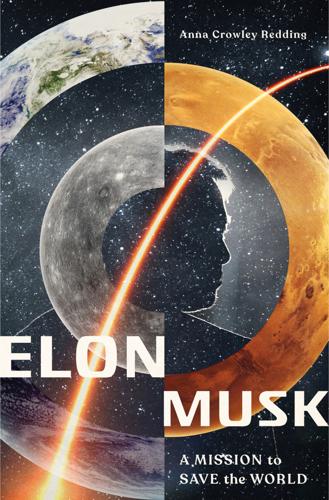
Elon Musk: A Mission to Save the World
by
Anna Crowley Redding
Published 1 Jul 2019
The task ahead was clear: prove to the world that an electric vehicle could be completely, totally, and utterly awesome. They had a lot of work ahead of them. DESERT In August 2004, Elon got behind the wheel of an RV, steered toward the open road, and headed for Nevada. Sure, he had two start-ups to worry about, but it was time for Burning Man. And he wasn’t going to miss it. Burning Man is a huge event in the Nevada desert. The pop-up community is built by the people who attend. Thirty-five thousand people came in 2004. The point? Build community, take on social issues, freely express yourself while following ten principles like self-reliance, self-expression, inclusion, and, oh, leave no trace.
…
“Elon Musk Reveals SpaceX’s New Scifi-Inspired Drone Ship—A Shortfall of Gravitas.” Teslarati, 12 Feb. 2018. www.teslarati.com/spacex-new-drone-ship-a-shortfall-of-gravitas/. Ressi, Adeo. “About.” www.adeoressi.com/index.php/about/. Rive, Lyndon. Interview by Brian Dumaine. “SolarCity’s Burning Man Roots.” Fortune, 9 Oct. 2014. Video, 1:15. fortune.com/video/2014/10/09/solarcitys-burning-man-roots/. _____. “Turning Toward the Sun.” New York Times, 20 April 2013. nyti.ms/11peOqU. Robertson, Adi. “Tesla Repays $465 Million Government Green Energy Loan Ahead of Schedule.” Verge, 22 May 2013. www.theverge.com/2013/5/22/4356860/tesla-repays-465-million-government-green-energy-loan.
…
94 That last question tied into the Rive brothers’ expertise. Lyndon was excited and started talking to his brother Peter about it. Elon offered his cousins money and any guidance they wanted, if they would run the company. He believed in their entrepreneurial talent. And now, with that out of the way, they could enjoy Burning Man. BRICK BY BRICK Tesla needed a bigger work space to actually build a car and accommodate their growing team. They quickly moved into a ten-thousand-square-foot industrial building and got started—with, um … one toolbox, furniture from IKEA, and a few computers. But that space wouldn’t be so empty for long.
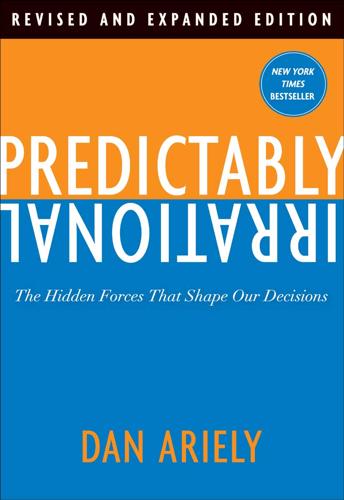
Predictably Irrational, Revised and Expanded Edition: The Hidden Forces That Shape Our Decisions
by
Dan Ariely
Published 19 Feb 2007
At first this was all very strange, but before long I found myself adopting the norms of Burning Man. I was surprised, in fact, to find that Burning Man was the most accepting, social, and caring place I had ever been. I’m not sure I could easily survive in Burning Man for all 52 weeks of the year. But this experience has convinced me that life with fewer market norms and more social norms would be more satisfying, creative, fulfilling, and fun. The answer, I believe, is not to re-create society as Burning Man, but to remember that social norms can play a far greater role in society than we have been giving them credit for.
…
At that time, I got a phone call from John Perry Barlow, a former lyricist for the Grateful Dead, inviting me to an event that proved to be both an important personal experience and an interesting exercise in creating a moneyless society. Barlow told me that I had to come to Burning Man with him, and that if I did, I would feel as if I had come home. Burning Man is an annual weeklong event of self-expression and self-reliance held in Black Rock Desert, Nevada, regularly attended by more than 40,000 people. Burning Man started in 1986 on Baker Beach in San Francisco, when a small crowd designed, built, and eventually set fire to an eight-foot wooden statue of a man and a smaller wooden dog. Since then the size of the man being burned and the number of people who attend the festivities has grown considerably, and the event is now one of the largest art festivals, and an ongoing experiment in temporary community.
…
Since then the size of the man being burned and the number of people who attend the festivities has grown considerably, and the event is now one of the largest art festivals, and an ongoing experiment in temporary community. Burning Man has many extraordinary aspects, but for me one of the most remarkable is its rejection of market norms. Money is not accepted at Burning Man. Rather, the whole place works as a gift exchange economy—you give things to other people, with the understanding that they will give something back to you (or to someone else) at some point in the future. Thus, people who can cook might fix a meal.
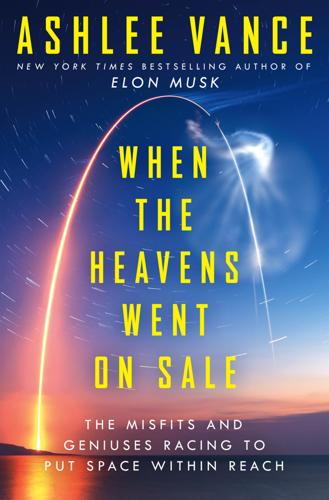
When the Heavens Went on Sale: The Misfits and Geniuses Racing to Put Space Within Reach
by
Ashlee Vance
Published 8 May 2023
He became an “entrepreneur in residence” at a venture capital firm, which is a fancy way of saying that some investors gave him office space to sit around and think up ideas for a new company. And he increased his involvement with the people who run Burning Man, the annual sex, drug, and art–fueled gathering in the Black Rock Desert that has become enough of a cliché to always be described as a sex, drug, and art–fueled gathering in the Black Rock Desert. A couple of years earlier, Kemp had a revelation at Burning Man that triggered a transformation from data center tech nerd to man of industry and action. Post Nebula, his dealings with the Burning Man* elders were part of a personal commitment to solidify those character changes and embrace the new and improved Chris Kemp.
…
You tend to need to bring a lot of energy together in order to catalyze something and make something happen that’s magic. Just this morning, I’m talking to one of the people that is very involved in the Burning Man organization. And I’m thinking about this huge facility that we’re soon going to have at Skyhawk. We’re not going to use a lot of it. Artists need places to keep their sculptures here in the Bay Area. And so we’re also going to find a way to build a Burning Man gallery. Or, like, when we wanted a place to test rockets on the airfield, I said to the city, “We’re going to launch rockets here.” Which is insane. Obviously, we’re not going to launch our rocket twenty minutes by car from downtown San Francisco or five seconds from downtown San Francisco by rocket.
…
My girlfriend asks them what they do, and they told her that they work at Google. They never gave anything away. “Then Sergey sent me a note afterwards. He’d analyzed our route on Google Maps and was wondering why we’d chosen certain paths. He thought we’d taken a crazy route. After that, we ended up hanging out at Burning Man, and we’ve been friends ever since.” As in any communal setup, the house had its tensions and interpersonal debates. Dishes were often stacked up by the sink, awaiting a volunteer to clean them and upsetting the more fastidious members of the group. People shared the food in the house, and you needed to slap your name on any precious items that were for personal consumption only.

Elon Musk
by
Walter Isaacson
Published 11 Sep 2023
On an earnings call with analysts that year, Musk admitted that the process had been harder than he expected back in 2016. “Ultimately, what it comes down to,” he said, “is that to solve Full Self-Driving, you actually have to solve real-world artificial intelligence.” 42 Solar Tesla Energy, 2004–2016 Lyndon and Peter Rive Burning Man “I want to start a new business,” Musk’s cousin Lyndon Rive said as they were driving in an RV to Burning Man, the annual art-and-tech rave in the Nevada desert, at the end of the summer of 2004. “One that can help humanity and address climate change.” “Get into the solar industry,” Musk replied. Lyndon recalls that the answer felt like “my marching orders.”
…
Then they all went to his tiny house and gathered in the even tinier backyard studio cottage where Grimes worked. It was furnished only with big floor pillows, and they hung around—Musk lying flat on the floor with a pillow behind his neck—and talked until sunrise. Burning Man 2021 For Elon and Kimbal, going to Burning Man—the massive late-summer festival of art and self-expression in the Nevada desert—had been, since the late 1990s, a treasured spiritual ritual and a chance to bond, dance, and party in an encampment with Antonio Gracias, Mark Juncosa, and other friends. After the event was canceled in 2020 because of COVID, Kimbal took up the cause of raising money to make sure that it would resume at the end of summer 2021.
…
“Are you fucking kidding me?” he kept asking. He and some of the other Burning Man stalwarts organized an unauthorized “Renegade Burn” in the same desert locale. About twenty thousand attendees, rather than the usual eighty thousand, showed up, but that gave the event an intimate rebel magic, like the festival had in its earlier days. Because they had no permit, they could not do the ritual huge bonfire of the wooden effigy that gives the festival its name, so Kimbal worked with a friend to replicate the look of a burning man using lighted drones. “This is a religious experience for a loyal community,” Kimbal said.
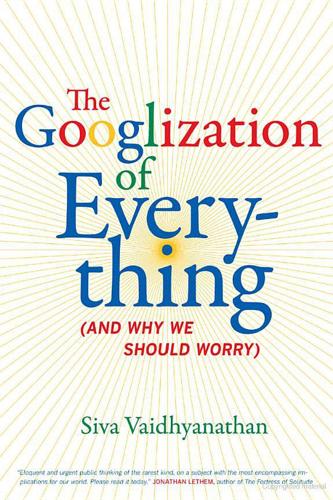
The Googlization of Everything:
by
Siva Vaidhyanathan
Published 1 Jan 2010
It’s a peculiar story: cultural anarchism melded with technologies developed for and by the U.S. military, unleashed in the service of both commerce and creativity, yet also accused of undermining both.49 Google, in particular, incorporates a twenty-first-century form of countercultural hedonism in its corporate structure and everyday work environment: the ethos of Burning Man. Burning Man is an annual festival held at the end of August in the Black Rock Desert in northern Nevada. Thousands of people gather to camp and celebrate with music, drugs, art, and digital technology. Turner highlights the fact that many important players in the technological industries of Northern California regularly participate in Burning Man. For two weeks a year, Silicon GOOGL E ’S WAYS A ND ME A N S 71 Valley’s elite can immerse themselves in a grand network of human beings connecting for the sake of creating.
…
“If the workers of the industrial factory found themselves laboring in an iron cage, the workers of many of today’s post-industrial information firms often find themselves inhabiting a velvet goldmine: a workplace in which the pursuit of selffulfillment, reputation, and community identity, of interpersonal relationships and intellectual pleasure, help to drive the production of new media goods,” Turner writes.50 Google’s founders, Larry Page and Sergey Brin, have been regular Burning Man attendees since the 1990s. At the festival, Page and Brin would have encountered a radically decentralized social structure, one that facilitates creativity, collaboration, and experimentation with little or no “command and control.” Burning Man, Turner concludes, is a distillation of the “cultural infrastructure” that nurtures Google, a spiritual manifestation of what Yochai Benkler calls “commons-based peer production.”51 As the sociologist Dalton Conley has described, many of the most highly rewarded workers—those on the creative side of the technology industries—are either trapped in something like a velvet goldmine or struggling to get into one.
…
So the human element in Google’s search business is present and perhaps growing. It’s important to look critically at the people who are making these decisions and the cultural backgrounds from which they have emerged. They are, as might be expected, by and large technicians and technocrats. A “SOVIET OF TECHNICIANS” AT BURNING MAN Google is built to support a technocratic way of working. Its founders, Larry Page and Sergey Brin, and most of its early employees are computer scientists by training. It has always been the sort of place where those devoted to solving some of the biggest challenges in logic, mathematics, and linguistics can find a supportive yet challenging environment.41 It’s the paradigm of the sort of practice that has emerged quickly over the past twenty years and that now dominates the scientific agenda in many fields: entrepreneurial science—the intersection of academic “pure” science and industrial technoscience.42 This technocratic mode of organization is anything but new.

Israel: A Simple Guide to the Most Misunderstood Country on Earth
by
Noa Tishby
Published 5 Apr 2021
Second, I didn’t know what to wear. Burning Man is as much about the costumes as it is about societal experimentation, and dressing up is yet another form of radical self-expression. And it shows. The outfits at Burning Man are jaw-dropping. Think Mad Max meets Moulin Rouge, and you get the picture.1 But still, something pulled me toward it, and before I knew it I’d registered. In preparation, I spent hours in thrift stores, researched ideas online, and spoke to my actual Burner friends. Still, I couldn’t zero in on what I wanted to wear—or, rather, who I wanted to be—in Burning Man. After days of anxiously trying to coordinate my costumes with the quicksilver Playa weather, something clicked, and I realized that Northern Nevada was nothing more than a desert.
…
To them I would like to say: “Give it back to whom, exactly? The Mamluks?” CHAPTER THREE A BRIEF HISTORY OF THE MIDDLE EAST IN THE LAST CENTURY AND WHAT A MESS IT WAS BEFORE ISRAEL EVEN GOT THERE BURN, BABY, BURN A couple of years ago I decided to go to Burning Man for the first time. If you haven’t been or seen the pictures, here’s the general vibe: Burning Man is an annual event held at a specifically erected town called Black Rock City in Northern Nevada, on a dried-up lakebed called the Playa. Once a year for a week, some eighty thousand or so people practice new ways of society building, artistic creation, self-expression, and other radical social experiments.
…
To set the record straight: while rocking a hair covering can be a choice ranging from tradition to modesty to self-expression, hijabs are mainly worn by Muslim women in the presence of men outside their family. While I love a badass accessory as much as the next woman, my experience with headgear is limited to a sunny day or Burning Man (for more on that, see chapter three). Stories like this repeated themselves in hundreds of variations for years to come. Over and over, I would find myself telling the story of Israel. Explaining that we are not, in fact, Afghanistan. Explaining how the country came to be, how the borders came to be, drawing hundreds of maps of the region on hundreds of napkins at various dinner parties.

Move Fast and Break Things: How Facebook, Google, and Amazon Cornered Culture and Undermined Democracy
by
Jonathan Taplin
Published 17 Apr 2017
Like Sean Parker, Page liked Burning Man, saying, “[It’s] an environment where people can try new things. I think as technologists we should have some safe places where we can try out new things and figure out the effect on society. What’s the effect on people, without having to deploy it to the whole world?” In fact, Page and his partner Sergey Brin were so entranced with Burning Man that they cited Eric Schmidt’s attendance there as one of the major reasons they agreed to hire him as CEO after the Google board decided that Page and Brin needed “adult supervision.” I suppose Parker and Page both embrace Burning Man because for a long weekend it approximates the “free cities” model they embrace—in which polities are privately owned and unregulated by states—an ideal way for capitalists to avoid the “mob mentality” of democracy.
…
In the same interview Parker bemoaned contemporary culture’s scarcity of revolutionary thinkers like Jim Morrison or Jack Kerouac. It is a bit rich to hear the rebel venture capitalist who travels every year to the Burning Man festival in the hope of recapturing his Jim Morrison dream bemoan the tired thinking of his fellow Americans—despite the wholesale wreckage his adventures have wrought on American culture, including the very music business Morrison depended upon. For the uninitiated, Burning Man is an annual gathering that takes place in the Black Rock Desert of Nevada over Labor Day weekend. It has been described as “an experiment in community and art” influenced by ten main principles, including “radical inclusion, self-reliance, and self-expression.”
…
Chapter Five: Digital Destruction The film The Social Network, written by Aaron Sorkin and directed by David Fincher, is a remarkably honest telling of the birth of Facebook. David Kirkpatrick, The Facebook Effect (New York: Simon and Schuster, 2010). David Kirkpatrick, “With a Little Help From His Friends,” Vanity Fair, September 6, 2010, www.vanityfair.com/culture/2010/10/sean-parker-201010. Samantha Krukowski (ed.), Playa Dust: Collected Stories from Burning Man (San Francisco: Black Dog, 2014). Ken Auletta, Googled: The End of the World as We Know It (New York: Penguin, 2009). Most of the email quotes from YouTube come from depositions in the Viacom International, Inc. vs. YouTube, Inc. lawsuit. Austin Carr, “Reddit Co-Founder, The Band’s Ex-Tour Manager Debate SOPA, Anti-Piracy and Levon Helm’s Legacy,” Fast Company, April 19, 2012, www.fastcompany.com/1834779/reddit-cofounder-bands-ex-tour-manager-debate-sopa-antipiracy-and-levon-helms-legacy-video.
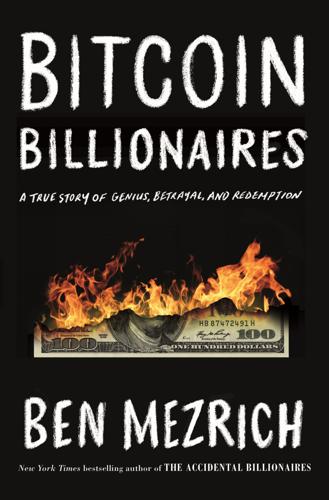
Bitcoin Billionaires: A True Story of Genius, Betrayal, and Redemption
by
Ben Mezrich
Published 20 May 2019
Eventually, The Man would be set on fire toward the end of the one-week festival, a tradition that gave this place its name and symbolized one of the main principles of the gathering: “Radical self-expression.” To many of the seventy thousand people populating the desert around Cameron, known as “Burners,” it was an annual pilgrimage or raison d’être that bordered on being religious. And nearby to the Burning Man was the Temple, a spiritual structure that housed the “Soul” of the Man. A cathartic wooden sanctum, where people left photos and notes and inscribed messages written to themselves, to loved ones, or sometimes to no particular person at all, just anyone passing by. They contained advice, wisdom, joy, happiness, gratitude, inspiration, heartbreak, heartache, loss, trauma, pain; the entire range of deep inner emotions and experiences that cut to the core of what it meant to be a human, experiencing life on this earth with all of its vicissitudes.
…
When the Temple burned on the last day of the festival, it unlocked all of its emotional content in a release, a rebirth, so powerful, so spiritual, that it helped assuage the grief and begin the healing process, closing a chapter to begin anew. Cameron wasn’t exactly sure what had brought Tyler and him to Burning Man that summer; a friend’s invite, an escape from East Coast humidity, pure curiosity—but he was glad they’d come. No matter who you were when you headed to that desert, the atmosphere could change you; even if the change was momentary, it was something worth experiencing. They were staying in the “Lost Lounge,” a conglomerate of canvas, tentlike cubes stacked together, a sort of makeshift desert motel.
…
For the moment, Cameron was content to wander along the edge of the Esplanade and Airstrip, stopping every once in a while to venture down the radial streets and alleys that cut across all of the clocks at fifteen- and thirty-minute intervals and explore some of the thousands of camps that covered this desert timepiece. Having nothing to do, and nowhere to be, was a large part of Burning Man’s charm. As they walked they passed groups of other Burners doing the same thing, men and women of all ages, anywhere from late teens into their seventies, dressed—and in some cases undressed—in costumes to fit the scenery. Leather, feathers, goggles, straps, chains, boots, gloves, hats—the sort of fashion show you’d expect to see moments before the end of the world.

The Achievement Habit: Stop Wishing, Start Doing, and Take Command of Your Life
by
Bernard Roth
Published 6 Jul 2015
When the festival arrived, I went at a prearranged time to Mike’s campsite at Burning Man. I brought along Adrian and Steve, two very capable engineers who were part of my Burning Man group and who had a keen interest in seeing the final product. Mike’s presentation was a disaster. Clearly he had not finished, and during his demonstration the instrument worked badly or not at all. Mike was embarrassed, I was embarrassed, and Adrian and Steve were embarrassed for him. Had I been asked to evaluate Mike for a job at that moment I would not have been able to recommend him in good conscience. Fast-forward three years. I was again at Burning Man with Adrian and Steve, watching a dance performance by a group called the Flaming Lotus Girls, done in conjunction with an amazing animated sculpture called Serpent Mother, a 168-foot-long metallic sculpture of a skeletal serpent coiled around her egg.
…
To learn how to get a better handle on your perceptions, emotions, and behavior, it is useful to look at how you think. YOU GIVE EVERYTHING ITS MEANING Mike, a graduate student in my class at Stanford University, planned to design a musical instrument for that summer’s Burning Man festival as his project. The festival is held each year the week before Labor Day in the Black Rock Desert in Nevada; among the main attractions at Burning Man are massive art pieces, machines, and structures created by the participants. Mike got the idea of doing his project in my class because we both attend the festival. Mike wanted to construct a wearable pipe organ powered in a most unusual way: it would contain a small fire-powered boiler that would then provide steam that could be directed through different pipes to produce music.
…
No matter what city I was in, every time I left my hotel there would be people waiting outside wanting to practice English. I was enthralled by their eagerness to learn, and at times ended up sitting in the street correcting pronunciation while several people read aloud to me. Some years later, when I started participating in the Burning Man festival, I was again struck by the power of self-motivation. I witnessed thousands of people who put in endless hours of labor (and, in some cases, lots of money) to create things that had no commercial value. They were doing it for self-satisfaction and the entertainment of their friends; they thought what they were making was cool and they were proud to show it off.
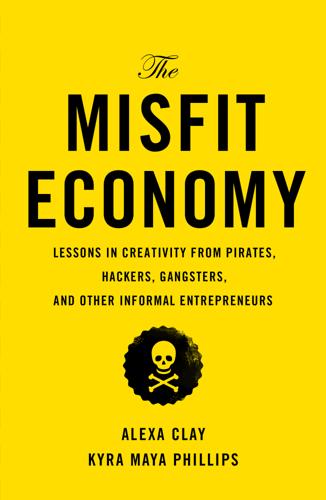
The Misfit Economy: Lessons in Creativity From Pirates, Hackers, Gangsters and Other Informal Entrepreneurs
by
Alexa Clay
and
Kyra Maya Phillips
Published 23 Jun 2015
MacDonald told us that science fiction writers are sometimes invited to speak at NASA conferences. Science fiction author and blogger Cory Doctorow, for example, published a novella for Project Hieroglyph, a platform for science fiction stories. Doctorow wrote about maker-space hardware hackers and Burning Man devotees who build 3-D printing robots to send to the moon. Accompanying the story, Hieroglyph hosts on their website a discussion with scientists around the feasibility of 3-D printing on the moon. Hieroglyph is a matchmaker of sorts, encouraging the conversion of science fiction stories into reality.
…
Historically, harvest festivals and religious festivals and feasts were used to usher in celebratory and sacred events that offered a departure from the hardship of everyday life. Many of today’s festivals are big music festivals like Coachella and Glastonbury, but increasingly, there are more experimental festivals like the Secret Garden Party in England, the Borderland in Sweden, and Burning Man in Black Rock City, Nevada. As Kenning told us, he was interested in exploring how the goodwill of festival culture could be brought “outside the festival gates to combat the tedium and isolation of working life.” What he found was that for many, festivals provided an escape from self-consciousness.
…
A protest movement doesn’t last forever. A science fiction novel is only so many pages. A prank holds its surprise only so long before it is revealed. But groups of people who ask the right questions or probe alternatives often pave the way for true change to emerge. Cultures like live-action role-playing or Burning Man that pop up temporary worlds can generate insights that spill over into mainstream reality. We may not all want to spend all our time dressed in festival garb and bartering in a desert gift economy, isolated in a simulated Mars mission, or protesting in Zuccotti Park, but the temporary worlds created by the provocateurs spark dialogue in our mainstream culture and create the conditions for innovation to occur.
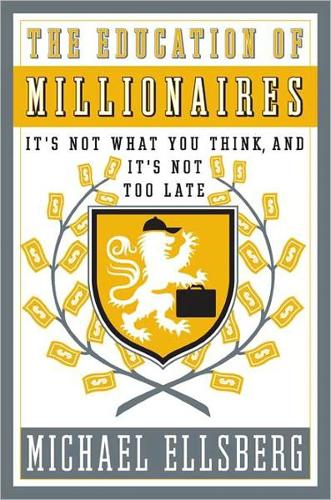
The Education of Millionaires: It's Not What You Think and It's Not Too Late
by
Michael Ellsberg
Published 15 Jan 2011
The water about to burst out is being pushed up by water below it. If you want to succeed, find leaders who are doing amazing things in the world, and push them up. Find powerful people and help them reach their goals. If you’re of service to them, they will be of service back.” Almost a year later, I was at the Burning Man festival in Nevada with Jena. I heard through the grapevine that Eben was at the festival and that he’d be giving a talk. Jena and I have a friend named Annie Lalla, who is an amazing relationship coach, but who was struggling in her business because she was resisting learning sales and marketing skills.
…
Little did I know that I had just brought to Eben his future fiancée. (Now that’s quite a way to “push the water up”!) Of course, at the time, all it involved was us standing around him after the talk, shaking his hand and asking him questions about his talk. But later it turned into much more than that, for Eben and Annie . . . When we got back from Burning Man, I saw a post late one night on Eben’s blog, saying he was organizing a small, private gathering in Ojai, California, with relationship teacher David Deida, one of the experts I’d learned most from about how to have a great relationship with Jena. I leapt out of my desk chair, ran to our bedroom, woke Jena up, and yelled, “Eben is hosting a private gathering with David Deida later this month!
…
It costs twenty-five hundred dollars a person to attend and it’s in California. We’re going!” Jena mumbled something semi-coherent about talking about it in the morning, and went back to sleep. I called Annie and told her about the opportunity; she said she fell madly in love with Eben the second he opened his mouth at the talk at Burning Man (he is a rather dashing fellow), but she hadn’t gotten further than hand-shaking after Eben’s talk. She signed up instantly. Jena questioned me about the wisdom of spending that much for a weekend. But I told her: “One connection with a powerful teacher can change your life forever. Is that worth it?”
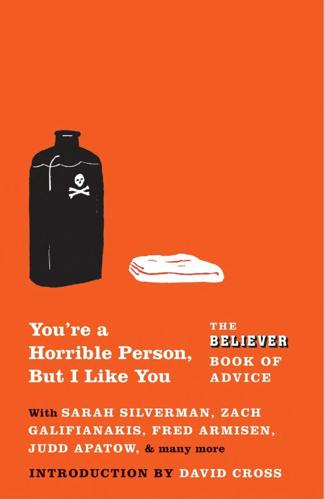
You're a Horrible Person, but I Like You: The Believer Book of Advice
by
The Believer
Published 15 Mar 2010
So you start seeing turtles like I do—as pawns in a cultural war. Morgan Murphy Dear Morgan: My boyfriend wants to go to Burning Man, but the last time he was there, he had sex with a man covered in silver body paint. He says it was just a onetime thing—how often do you get to fuck a silver man?—but I’m worried that it might happen again. Am I right to be concerned? Glenn Davenport, IA Dear Glenn: I hate to break it to you, but your boyfriend is gaaaaay. You two fellas have obviously been together awhile if this is his second Burning Man, but if he’s fucking a man (covered in silver paint, no less), then he is a homosexual, and you need to figure out if that’s something you’re willing to live with.
…
I would advise approaching him gently on this subject, as nobody wants to be dragged out of the closet. Perhaps bring it up to him while he’s blowing you. Above all, don’t judge him. I happen to know that you’re required to fuck a man covered in silver paint to get into Burning Man. It’s a policy established in 1998, after a complaint that paper tickets were wasteful and added to the festival’s already excessive littering. Inserting one’s penis into a silver man is the ultimate form of recycling. That way, if the Burning Man Police want to know if you’ve paid your entrance fee, they can simply ask to see your silver penis. It’s quite brilliant in its simplicity, and kind to Mother Earth. Other events now implementing the “fuck a man covered in silver body paint” policy include Lollapalooza, various FM radio stations’ “Jingle Balls,” and the Westminster Dog Show.

The Internet Is Not the Answer
by
Andrew Keen
Published 5 Jan 2015
Secession In a May 2013 speech to his company’s Internet developers, Larry Page, Google’s cofounder and CEO, confessed his fantasy about the future. “We are at maybe 1% of what is possible. We should be focused on building the things that don’t exist,” he said.67 “Maybe we could set apart a piece of the world. I like going to Burning Man, for example. An environment where people can try new things.” Thus did Page lay out what one critic identified as his “techno-libertarian utopia.”68 Burning Man, the annual countercultural festival of what it calls “radical self-expression” and “self-reliance”69 in Nevada’s Black Rock Desert, has already established itself as one of the most fashionable events on the Silicon Valley calendar, with tech entrepreneurs bringing their own celebrity chefs, hiring teams of “Sherpas” to treat them like “kings and queens,” and erecting air-conditioned yurts in the desert.70 But Page’s vision is to take Burning Man out of the desert.
…
Thus did Page lay out what one critic identified as his “techno-libertarian utopia.”68 Burning Man, the annual countercultural festival of what it calls “radical self-expression” and “self-reliance”69 in Nevada’s Black Rock Desert, has already established itself as one of the most fashionable events on the Silicon Valley calendar, with tech entrepreneurs bringing their own celebrity chefs, hiring teams of “Sherpas” to treat them like “kings and queens,” and erecting air-conditioned yurts in the desert.70 But Page’s vision is to take Burning Man out of the desert. “I think as technologists we should have some safe places where we can try out new things and figure out the effect on society,” he explained to his developers. “What’s the effect on people, without having to deploy it to the whole world.” But Page—or “Larry,” as everyone in Silicon Valley likes to call this member of America’s 0.0001% multibillionaire class—may already have the “safe place” for his vision of secession. That laboratory where technologists can experiment with new things on society actually exists. Burning Man has already been liberated from the Nevada desert.
…
As critics like Tim Wu have argued, the answer lies in our new digital elite becoming accountable for the most traumatic socioeconomic disruption since the industrial revolution. Rather than thinking differently, the ethic of this new elite should be to think traditionally. Rather than seceding to Burning Man or Mars, this plutocracy must be beamed back down to earth. “Move fast and break things” was the old hacker ethic; “you break it, you own it” should be the new one. Rather than an Internet Bill of Rights, what we really need is an informal Bill of Responsibilities that establishes a new social contract for every member of networked society.
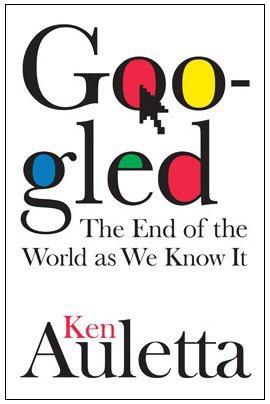
Googled: The End of the World as We Know It
by
Ken Auletta
Published 1 Jan 2009
It’s also a way to encourage engineers to push the envelope, to assume that their mission is to disrupt traditional ways of doing things. There is at Google a utopian spirit not unlike that found at Burning Man, the annual anarchic-animistic retreat in Nevada’s Black Rock Desert that culminates in the burning in effigy of a giant wood and desert brush “man.” It does not go unnoticed by their friends that Brin and Page have been regular attendees at this weeklong retreat in August, whose Woodstock-like spirit is captured in Burning Man’s ten stated principles, which include a devotion “to acts of gift giving”; creating “social environments that are unmediated by commercial sponsorships, transactions, or advertising”; and “a radically participatory ethic” that can lead to “transformative change.”
…
They declined to place ads on their most valuable piece of real estate, the uncluttered opening Google page containing the search box. Brin and Page resisted ads because they shared an allergy then common among Webheads and many folks who attended Burning Man: that advertising was like a rude stranger interrupting a conversation to sell you something you neither wanted nor needed. “These guys were opposed to advertising because they had a purist view of the world,” said Shriram. Like some Burning Man attendees, Page and Brin were—no other word will do—odd. Barry Diller, the CEO of the InterActiveCorp, a diverse collection of such e-commerce sites as Expedia and Ticketmaster, recalled visiting Page and Brin in the early days of Google.
…
Andy Kaufman: author interview with Marc Andreessen, May 5, 2007. 17 “I sometimes feel”: author interview with Eric Schmidt, March 2, 2007. 17 seventy million dollars: Adam Lashinsky, “Where Does Google Go Next?” Fortune, May 26, 2008, and confirmed by Google. 18 conveys a sense of freedom: author interview with Krishna Bharat, September 12, 2007. 18 Burning Man’s ten stated principles: Burning Man Web site. 18 “Google is a cross”: author interview with Peter Norvig, August 21, 2007. 18 She described the culture as “flat”: author interview with Stacy Savides Sullivan, August 21, 2007. 19 the best U.S. company to work for: Fortune, January 2008. 19 salaries are modest: SEC 14-A filing, March 24, 2009. 19 stock option grants: Google 10-K filed with the SEC for the fiscal year ending December 31, 2008. 19 more applicants are accepted by Harvard... packet about each: author interviews with Lazslo Bock, August 22, 2007, Leesa Gidaro, September 12, 2007, and David Drummond, March 25, 2008, and Google orientation for new employees, October 8, 2007, attended by author. 20 consisted of 130 people: author interview with David Krane, August 22, 2007. 20 a total of eight hours of his time: author interview with a senior executive at Google. 20 a blog explaining why he left: “Why Designer Doug Bowman Quit Google,” Google Blogoscope, March 21, 2009. 20 “knowledge workers”: author interview with Hal Varian, March 28, 2008. 20 “In some ways”: author interview with Paul Buchheit, June 9, 2008. 21 user experience matters most: author interview with Matt Cutts, August 20, 2007. 21 “church/state wall”: author interview with Larry Page, March 25, 2008. 21 four thousand dollars a day: Jason Calacanis blog from AdSense, July 28, 2008. 21 one thousand employees have received this subsidy: supplied to the author by Google. 22 “moral force”: author interview with Eric Schmidt, June 11, 2008. 22 “great values”: author interview with Al Gore, June 10, 2008. 23 “How can you”: author interview with Eric Schmidt, September 12, 2007. 23 Winograd . . . recounted a discussion at a TGIF: author interview with Dr.

Hype: How Scammers, Grifters, and Con Artists Are Taking Over the Internet―and Why We're Following
by
Gabrielle Bluestone
Published 5 Apr 2021
In all, the feds say, McFarland made about $36,000 from that single email. He was just getting started. A week later, he sent out an email offering Burning Man tickets at a steep discount, especially for tickets that weren’t even in presales yet. “We were going to save this, but the snow in NYC today has us thinking of the playa. We have 2018 Burning Man (8/26–9/3) passes today only for $325 per person,” the email read. “Ticket prices go up to $525 tomorrow until we sell our allocation.” One of the recipients of the Burning Man email, a man named Joel Remland, responded asking how that was possible. “We partner with sponsors to get bulk access,” Tribble/McFarland responded, attaching a contract and credit card authorization form to the email.
…
In any event, he definitely wasn’t sitting at home thinking about what he had done wrong. For weeks, I had been getting credible reports that Fyre Festival attendees were being targeted with emails from a new company called NYC VIP Access, which was offering ludicrously expensive tickets to exclusive celebrity events like the Met Gala, the Victoria’s Secret Fashion Show, and Burning Man. That someone would be brokering these types of exclusive opportunities wasn’t totally implausible—high-price concierge services accounted for an estimated $297 million market in 20174—but something just felt off about these offers, in the same way the Fyre Festival website had felt off when I first clicked through.
…
He went on to suggest he might deign to sell me a pair if I filled out and returned a credit card authorization form that same day. But that year’s show hadn’t even announced its location yet, and the annual casting, which famously guarantees no spot to any model—even if she walked the year before—was still months away. A simple Google search revealed Burning Man had no corporate sponsors to provide NYC VIP with the tickets they assured me had been provided by corporate sponsors, and I was able to confirm that, despite NYC VIP’s backstage Reputation tour offers, Taylor Swift had stopped selling meet and greets some time ago, due to security concerns. On June 12, 2018, having debunked almost all of NYC VIP’s offers, I published a final article in a series focused on the many connections between this shady new access company and Billy McFarland, who had repeatedly denied any involvement.5 About six hours after the piece went live, McFarland was rearrested and charged with a pair of felonies related to the ticket-selling scheme.

Is Everyone Hanging Out Without Me? (And Other Concerns)
by
Mindy Kaling
Published 1 Nov 2011
Sorry, Pete, you don’t know the freedom of the seventeen-dollar coat when caught at a party with an ex-boyfriend and his new hot girlfriend. And that, my friends, is how to execute an Irish exit. Thank you, Forever 21! *I feel like I’m constantly being ditched for the Burning Man Festival. The Burning Man Festival is an annual festival that is an “experiment in human expression.” Only something reprehensible would be so vague. There are only a few things that I’ve never actually done that I can say I categorically hate. One is Burning Man. The others are sky-diving, ménage à trois, and when parents tell stories about their babies and incorporate impressions of their babies’ voices. I love hearing about your kid!
…
There has really been only one time when someone actually busted me on it. It occurred at my friend Louisa’s birthday, on the roof of the Downtown Standard Hotel in L.A. when I was twenty-seven. I was having a crummy time because I was supposed to go with my friend Diana but she couldn’t make it at the last minute because she was going to Burning Man.* Diana was going to be my wingwoman because I knew my ex-boyfriend was coming to the party with his new girlfriend, Chloe. A word about Chloe: Chloe was so young (or young-looking) she’d actually played the daughter of an actress four years older than me on a TV show. But the worst thing about Chloe is that she was sweet.

Brave New Work: Are You Ready to Reinvent Your Organization?
by
Aaron Dignan
Published 1 Feb 2019
More and better information, and more and better ways to make sense of it, is the source of competitive advantage in complexity. MEMBERSHIP How we define and cultivate relationships; the boundaries and conditions for entering, inhabiting, and leaving teams and organizations. Once a year, about a hundred miles outside of Reno, the Burning Man festival descends upon the desert for a weeklong social experiment in community, art, transcendence, and bacchanalia. Seventy thousand people supported by two thousand volunteers appear out of nowhere and stand up a self-contained society founded on ten principles: radical inclusion, self-reliance, self-expression, community cooperation, civic responsibility, gifting, decommodification, participation, immediacy, and leaving no trace.
…
And the total cost to participate in this cashless economy where you’ll be totally reliant on the people around you? It could be $2,000 or more. Tickets for last year’s event sold out in just thirty-five minutes. This isn’t Lollapalooza. It’s not a few hours in the sun with your friends. This is a way of life. Burning Man is a classic example of membership done well. When it comes to membership, it’s helpful to think of an organization as a set of membranes—cells within cells within cells. Each membrane, or team boundary, is made up of requirements and agreements, both spoken and unspoken. Honor them and you’re in.
…
It’s a living agreement. Boundaries can be clearly defined or purposefully blurry. Agreements within teams can be explicit or informal. Enforcement can be lenient or strict. What matters is that we are intentional. Evolutionary Organizations play with these continuums in an increasingly nonbinary way. Burning Man blurs the lines between attendee and host, customer and volunteer, and in so doing creates a richer and more participatory experience. Airbnb does the same. A host in one city is often a guest in another. Wikipedia does the same, as do countless open-source projects and peer-to-peer platforms. The future of membership may end up looking like many ways to play, clearly defined and held simultaneously.
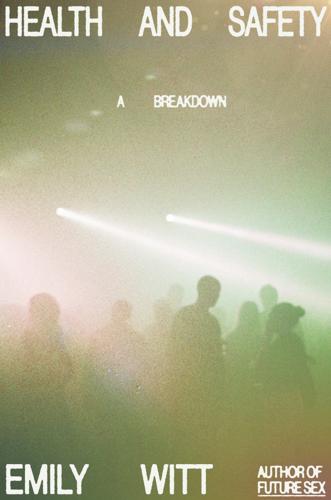
Health and Safety: A Breakdown
by
Emily Witt
Published 16 Sep 2024
I moved away for several years and wasn’t there for it, but the small and somewhat nerdy electronic music scene that reemerged in New York in the mid-to-late 2000s, and was the precursor to Bossa and Sustain, seemed to have taken its cues and its ethics from Berlin as much as from the Black American origins of techno in Detroit, or in the country’s 1990s underground rave scene, or in New York’s own long-suppressed nightclub tradition. The aesthetics of the revival were austere and knowing, almost to the point of churchiness, and to differentiate itself from the major-label EDM of Electric Daisy Carnival or the fur coats and leggings of Burning Man there was an outright aversion to Merry Prankster–ish interpretations of psychedelia. At Sustain I was self-conscious of the Burning Man stickers on my water bottle—this was not a place to express one’s inner hippie. The aftermath of the recession still lingered; there was a simplicity in people’s clothes and a rejection of excess materialism. Sustain had a “no costumes” rule at one point, and in 2016, when I went for the first time, nearly everyone still dressed in black.
…
Of all the courses of study a person of means and intelligence could undertake, or causes to which I could devote myself in the prime of life, this one was silly, and put me in contact with dissipated people who believed in things that weren’t real. Nevertheless, I listened with genuine interest to the theories about the primitive computing power of crystals, and to McKenna’s predictions of the eschaton. In 2013, I went to Burning Man for the first time; I went to Horizons, a conference on psychedelics held at Judson Memorial Church in Manhattan; I wrote about the drug website Erowid for The New Yorker. These were middle-class entry points, and like most conformist strivers who also did drugs I convinced myself of an idea of responsible drug use.
…
My interest in the music was related to my interest in drugs. The scene @DanceBitchBK posted about seemed like it might bring together the kind of people I wanted to find. I was looking for a psychedelic setting that did not have the Wikipedia pantheism of the ayahuasca circles or the tech-industry libertarianism of late Burning Man or the cheesy commercialism of an EDM festival or that tried, like the MAPS practitioners I’d seen lecture at the Horizons conference, to turn every experience of altered consciousness into therapy. But the drugs were only one part of it; it was also my wanting to be around people who were world-building, who went out at night prepared to present themselves, with their bodies, their sexuality, their fashion, and their music, in confrontation to the forces of contemporary triteness.

Dawn of the New Everything: Encounters With Reality and Virtual Reality
by
Jaron Lanier
Published 21 Nov 2017
Instead, guru candidates would talk about VR. There would be speaker after speaker, plus VR-themed bands, weird party decorations, strange locations, all evoking what VR might be like someday. That old world of speculative VR obsession, the psychedelic tech party circuit, evolved into today’s Burning Man festival, or at least Burning Man as it is at night, when you no longer see the mountains but only the blinking lights of human invention. A simulation of what it might be like to be able to improvise reality fully; a simulation of a simulation. Remembering the era of VR-themed parties evokes feelings of guilt and anger in me, even today.
…
This conference straddled industry and academia, so I wondered if being there in an official capacity might give me an opening. That year’s SIGGRAPH, in Boston, turned out to be nutso and exuberant. It was one of those countercultural gatherings that was still small enough to get away with genuine chaos, like the first few years of Burning Man. Also, as was true back in the hut, computers weren’t fast enough to do much yet, so people had to get weird to pass the time until Moore’s Law came through. All the strands of fate clustered during my first visit to the Boston area. Before SIGGRAPH was over, I had decided to move there for a while, found a few new lifelong friends, met a woman I would eventually marry (if only bizarrely and briefly), met my most cherished mentor, and got my first real research gig.
…
The Suicide Club is in the city, the Whole Earth Catalog moved to Marin—sigh—and Survival Research Lab doesn’t even come around anymore. No one interesting can afford the rents anymore.” You might not know about these early Silicon Valley institutions. The Suicide Club was a punk urban adventure club that would do things like climb the Golden Gate Bridge illegally. It was one of the progenitors of Burning Man. That’s where “Leave No Trace” comes from.7 Survival Research Labs staged walloping, genuinely dangerous, and giant performance art with equipment scrounged in Silicon Valley. Like a living, unsupervised guinea pig operating—for real—a tank with a thirty-foot flamethrower. You’d have to sign your life away to attend a show.
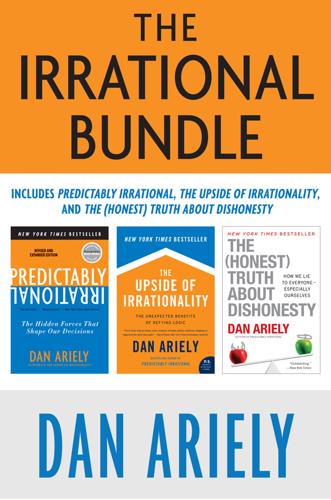
The Irrational Bundle
by
Dan Ariely
Published 3 Apr 2013
At first this was all very strange, but before long I found myself adopting the norms of Burning Man. I was surprised, in fact, to find that Burning Man was the most accepting, social, and caring place I had ever been. I’m not sure I could easily survive in Burning Man for all 52 weeks of the year. But this experience has convinced me that life with fewer market norms and more social norms would be more satisfying, creative, fulfilling, and fun. The answer, I believe, is not to re-create society as Burning Man, but to remember that social norms can play a far greater role in society than we have been giving them credit for.
…
At that time, I got a phone call from John Perry Barlow, a former lyricist for the Grateful Dead, inviting me to an event that proved to be both an important personal experience and an interesting exercise in creating a moneyless society. Barlow told me that I had to come to Burning Man with him, and that if I did, I would feel as if I had come home. Burning Man is an annual week-long event of self-expression and self-reliance held in Black Rock Desert, Nevada, regularly attended by more than 40,000 people. Burning Man started in 1986 on Baker Beach in San Francisco, when a small crowd designed, built, and eventually set fire to an eight-foot wooden statue of a man and a smaller wooden dog. Since then the size of the man being burned and the number of people who attend the festivities has grown considerably, and the event is now one of the largest art festivals, and an ongoing experiment in temporary community.
…
Since then the size of the man being burned and the number of people who attend the festivities has grown considerably, and the event is now one of the largest art festivals, and an ongoing experiment in temporary community. Burning Man has many extraordinary aspects, but for me one of the most remarkable is its rejection of market norms. Money is not accepted at Burning Man. Rather, the whole place works as a gift exchange economy—you give things to other people, with the understanding that they will give something back to you (or to someone else) at some point in the future. Thus, people who can cook might fix a meal.

City: A Guidebook for the Urban Age
by
P. D. Smith
Published 19 Jun 2012
It had no contact with the outer world; it was a universe itself.’50 At the centre of the circular city is a ‘green heart’, the Park, an Eden of forest and rivers, ‘a memory of what Earth had been in the days before the desert swallowed all but Diaspar’.51 Of course, this is a bleak vision of the distant future, but it is one that reveals the profound trust we have placed in the city as a bulwark against the vagaries of a hostile universe, a trust that has served our species well for millennia. For this reason, it is certain that whatever shape they take, cities are where the future of humanity lies. Burning Man Burning Man is a unique arts event, as well as an exercise in city building. It began with a small evening bonfire on a San Francisco beach in 1986. This gathering of twenty friends evolved into today’s temporary city of some 47,000 people known as Black Rock City. The event now takes place in the savage 40°C heat and blinding dust storms of the Black Rock Desert, 120 miles north of Reno, Nevada, for one week each year.
…
The forty-foot effigy of ‘the Man’ is burned the night before Labor Day. The next day everyone packs up their things, removes all traces of the city and drives off across the flat, white desert. Aerial view of Black Rock City, a temporary community created for the Burning Man event in the Nevada desert. Unlike other festivals, Burning Man is created entirely by its participants. Black Rock City is viewed by the organisers as an experimental community, which encourages its members to express themselves by creating artworks and challenges them to be self-reliant to a degree not normally encountered in everyday life.
…
Trade played a vital role in the growth of cities in medieval Europe. Fairs helped kick-start trade on the continent. Fairs were sprawling wood and canvas temporary cities, which had been held outside the walls of cities since the Dark Ages. They resembled today’s Black Rock City, created for a few weeks each year in the Nevada desert for the Burning Man festival. Fairs were great occasions in the life of the city – ‘vast and elaborate pageants’, which usually took place during religious holidays and attracted droves of traders, entertainers and visitors.25 As Richard Sennett has said, fairs helped to develop ‘the first tissues between cities, connecting market to market’.

Whole Earth: The Many Lives of Stewart Brand
by
John Markoff
Published 22 Mar 2022
In early July the Loefflers met Brand at Pyramid Lake in northwest Nevada and the trio spent several days exploring the hot springs, including a creek that ran with warm water; you could sit under a thundering waterfall in a pool that was a perfect temperature. For Brand it was his first visit to the desert, and he quickly fell under its spell. A week later, following the Loefflers, who had gone ahead, he made his way through the Black Rock Desert. (It would be more than a quarter century before it was discovered by the people who created Burning Man.) The Black Rock Desert playa is one of the flattest places on Earth, covering approximately two hundred square miles with no inhabitants but “Basques and buckaroos.” There was an extraordinary quality to the playa, an “extreme planetary surface weirdness,” as he thought of it. It was in wandering this desert that Brand discovered a new kind of solitary freedom.
…
Soon they would begin to acquire their first round of financial backers, including Microsoft’s Nathan Myhrvold and Amazon founder Jeff Bezos; Shel Kaphan, Amazon’s first employee and a former Whole Earth Truck Store worker; Jacqui Safra; and Priceline founder Jay Walker. Shortly after the Clock Library project was launched, Brand returned to the Black Rock Desert to attend the annual Burning Man festival, which since 1990 had been held annually on the Black Rock playa, which he had first visited in the early sixties. He came away momentarily certain that he had identified a mountain nearby that would one day house both the library and the clock. At roughly the same time, Hillis convinced him that while they might use twenty-first-century tools like computers and sophisticated machine tools to build the clock, maintaining it should not require any advanced technology.
…
“Gazing at a bristlecone is a glimpse into another time zone—the one we want to occupy.” On Monday everyone except for Brand and Rose flew home, and the two of them went on to hunt for a property before driving back to California. On their return, they stopped at Spencer Hot Springs, one of Brand’s old haunts, where they coincidentally shared a plunge with several dozen Burning Man veterans. Afterward, Brand wrote that they had “Found The Place.” The next year they bought the abandoned property they had discovered on their expedition. Jay Walker; Bill Joy, a cofounder of Sun Microsystems; and Mitch Kapor donated the money to buy 180 acres of virtually inaccessible mining land suitably populated with bristlecone pines.
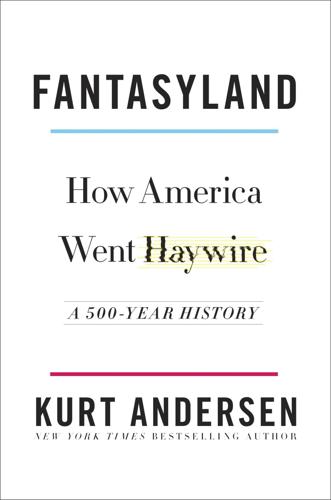
Fantasyland: How America Went Haywire: A 500-Year History
by
Kurt Andersen
Published 4 Sep 2017
As Las Vegas turned into a city posing as a theme park—with hotel-casinos that were huge new simulations of ancient Egypt (the Luxor), medieval England (the Excalibur), the seventeenth-century Caribbean (Treasure Island), Renaissance Italy (the Venetian), contemporary France (Paris Las Vegas), and New York City (New York–New York)—the number of visitors tripled. At the other end of Nevada in the 1990s, a different adult fantasy theme park, chic and singular, was established for one week a year—Burning Man. On the Fantasyland family tree, Burning Man has deep roots in the late 1800s (the original world’s fairs), but the main trunk is from the 1960s (hallucinogens, happenings, be-ins, Woodstock, costumes-as-clothes, worship of nature and the primitive), and adjacent stalks from the 1980s (live action role-playing) and ’90s (cosplay).
…
And as the cultural critic Neil Postman put it in his 1985 jeremiad about how TV was replacing meaningful public discourse with entertainment, we were in the process of amusing ourselves to death. 27 Making Make-Believe More Realistic and Real Life More Make-Believe IT IS NOT MUCH OF a stretch to say that in the 1980s and ’90s, our country became an amazing coast-to-coast theme park, open twenty-four hours. The boundaries between entertainment and the rest of life were definitively dismantled. America became addicted to the make-believe of drag—by which I mean everything from new buildings meant to look old or foreign to the geeks at Comic-Cons and Burning Mans dressing up as fictional beings. Casinos were suddenly ubiquitous. Celebrity-obsessed news media sprawled. Reality television was born. And consider wrestling, the professional and fake kind, which suddenly became a huge, quintessentially American cultural phenomenon and business. To me, all professional sports exist adjacent to Fantasyland.
…
They dress as unicorns, birds, mermaids, geishas, chanteuses, time travelers, butterflies, anything, everything, or they wear no clothes at all. They roam around superb fantasy architecture—rococo polygons and furniture the size of small houses, glowing flowers as big as trees, bridges, log cabins, Shangri-La temples. At Burning Man, they step through the looking glass—that is, through the LED screen—to inhabit Azeroth or Tatooine or the fan-fictionalized nice section of the postapocalyptic Mad Max world. Not so long ago, American adults never dressed up in costumes, certainly not as an annual ritual. When my daughters reached their early twenties, obsessing more than ever over their Halloween costumes, they were shocked when I told them that.
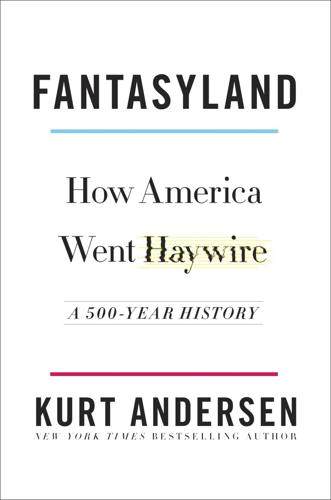
Fantasyland
by
Kurt Andersen
Published 5 Sep 2017
As Las Vegas turned into a city posing as a theme park—with hotel-casinos that were huge new simulations of ancient Egypt (the Luxor), medieval England (the Excalibur), the seventeenth-century Caribbean (Treasure Island), Renaissance Italy (the Venetian), contemporary France (Paris Las Vegas), and New York City (New York–New York)—the number of visitors tripled. At the other end of Nevada in the 1990s, a different adult fantasy theme park, chic and singular, was established for one week a year—Burning Man. On the Fantasyland family tree, Burning Man has deep roots in the late 1800s (the original world’s fairs), but the main trunk is from the 1960s (hallucinogens, happenings, be-ins, Woodstock, costumes-as-clothes, worship of nature and the primitive), and adjacent stalks from the 1980s (live action role-playing) and ’90s (cosplay).
…
And as the cultural critic Neil Postman put it in his 1985 jeremiad about how TV was replacing meaningful public discourse with entertainment, we were in the process of amusing ourselves to death. 27 Making Make-Believe More Realistic and Real Life More Make-Believe IT IS NOT MUCH OF a stretch to say that in the 1980s and ’90s, our country became an amazing coast-to-coast theme park, open twenty-four hours. The boundaries between entertainment and the rest of life were definitively dismantled. America became addicted to the make-believe of drag—by which I mean everything from new buildings meant to look old or foreign to the geeks at Comic-Cons and Burning Mans dressing up as fictional beings. Casinos were suddenly ubiquitous. Celebrity-obsessed news media sprawled. Reality television was born. And consider wrestling, the professional and fake kind, which suddenly became a huge, quintessentially American cultural phenomenon and business. To me, all professional sports exist adjacent to Fantasyland.
…
They dress as unicorns, birds, mermaids, geishas, chanteuses, time travelers, butterflies, anything, everything, or they wear no clothes at all. They roam around superb fantasy architecture—rococo polygons and furniture the size of small houses, glowing flowers as big as trees, bridges, log cabins, Shangri-La temples. At Burning Man, they step through the looking glass—that is, through the LED screen—to inhabit Azeroth or Tatooine or the fan-fictionalized nice section of the postapocalyptic Mad Max world. Not so long ago, American adults never dressed up in costumes, certainly not as an annual ritual. When my daughters reached their early twenties, obsessing more than ever over their Halloween costumes, they were shocked when I told them that.

Brotopia: Breaking Up the Boys' Club of Silicon Valley
by
Emily Chang
Published 6 Feb 2018
“They might say, ‘Do you want to come to this really exclusive hot party? The theme is bondage,’” one female entrepreneur told me. “‘It’s at this VC or founder’s house and he asked me to invite you.’” Perhaps this culture is just one of the many offshoots of the sexually progressive Bay Area, which gave rise to the desert festival of free expression Burning Man, now frequented by the tech elite. Still, the vast majority of people in Silicon Valley have no idea these kinds of sex parties are happening at all. If you’re reading this and shaking your head, saying, “This isn’t the Silicon Valley that I know,” you may not be a rich and edgy male founder or investor, or a female in tech in her twenties.
…
“You can choose not to hook up with [a specific] someone, but you can’t not hook up with anybody, because that would be voyeurism. So if you don’t participate, don’t come in,” says one frequent attendee, whom I’ll call Founder X, an ambitious, world-traveling entrepreneur. This is the same general spirit at play in the orgy dome at Burning Man, popular among techies. “No spectators” is the slogan out on the playa, and so it is back home. They don’t see themselves as predatory, of course. When they look in the mirror, they see individuals setting a new paradigm of behavior by pushing the boundaries of social mores and values. “What’s making this possible is the same progressiveness and openmindedness that allowed us to be creative and disruptive about ideas,” Founder X told me.
…
‘I should be able to have sex with a woman because I’m a rich guy.’ That is not even one particle progressive; that is the same tired bullshit. It’s trying to blend the new and keeping the old attitudes, and those old attitudes are based in patriarchy, so they come at the expense of women.” Jennifer Russell, who runs the established Camp Mystic at Burning Man, is more sympathetic. “Men and women are equally drawn to creating a structure that invites their full sexual expression and events like this are a safe place to dabble,” she says. “It’s way better than a swingers club would feel because this is at a home and you are surrounded by people you know.”

Custodians of the Internet: Platforms, Content Moderation, and the Hidden Decisions That Shape Social Media
by
Tarleton Gillespie
Published 25 Jun 2018
Stop Harassing Emma Kwasnica over Her Breastfeeding Pics Facebook group, January 13, 2012, https://www.facebook.com/notes/fb-stop-harassing-emma-kwasnica-over-her-breastfeeding-pics/facebook-has-contacted-me-aaargh/326125797410484. 35John Seed, “When Is a Nude OK on Facebook?” Huffington Post, May 24, 2010, http://www.huffingtonpost.com/john-seed/when-is-a-nude-ok-on-face_b_586356.html; Elinor Mills, “Oops! Facebook Mistakenly Censors Burning Man Art,” CNET, September 15, 2010, https://www.cnet.com/news/oops-facebook-mistakenly-censors-burning-man-art/; Asher Moses, “Facebook Relents on Doll Nipples Ban,” Sydney Morning Herald, July 12, 2010, http://www.smh.com.au/technology/technology-news/facebook-relents-on-doll-nipples-ban-20100712-106f6.html. 36Emma Kwasnica, “‘Hello,’” One Small Step for Breastfeeding . . ., January 6, 2009, http://bliss-breastfeeding.blogspot.com/2009/01/hello-my-name-is-emma-kwasnica.html. 37Ann Douglas, “Facebook’s Attack on Breastfeeding,” Toronto Star, January 18, 2012, https://www.thestar.com/life/parent/2012/02/01/douglas_facebooks_attack_on_breastfeeding_hurts_women.html. 38Danielle Arnold-Mckenny, “Why Seeing Breastfeeding Is Important: My Personal Challenge to You,” Informed Parenting, October 3, 2010, http://iinformedparenting.blogspot.com/2010/10/seeing-breastfeeding-is-important-my.html. 39Ann S., “Facebook—Amend Breastfeeding-Photo Guidelines!”
…
Google banned the first porn app designed for Google Glass when that device was still imagined to be an exciting consumer market possibility.42 Facebook has regularly been taken to task for deleting what users argue is artistic, educational, or politically relevant nudity, or isn’t even nudity at all: children’s dolls, Burning Man sculptures, hand-drawn cartoons, even an exposed elbow. Major publishers and cultural institutions like the New Yorker and the New York Academy of Art have contested Facebook’s right to intervene as well as its judgment in doing so.43 The larger point is that editorial review can quickly widen to include decisions that are morally loaded, and financially or politically motivated.
…
Nelson, “Facebook Removes Iconic Picture of Fleeing Napalm Girl Over Nudity,” HuffPost UK, September 9, 2016, http://www.huffingtonpost.co.uk/entry/facebook-removes-iconic-picture-of-fleeing-napalm-girl-over-nudity_uk_57d2b381e4b0ced6a09924a0. 18See Baym and boyd, “Socially Mediated Publicness”; Burgess and Green, YouTube; Cammaerts, “Critiques on the Participatory Potentials”; Clark et al., “Participations”; Deuze, “Corporate Appropriation of Participatory Culture”; Fish et al., “Birds of the Internet”; Jenkins, Convergence Culture; Jenkins, Ford, and Green, Spreadable Media; Kelty, “Participation”; Langlois, “Participatory Culture and the New Governance of Communication”; Sandvig, “The Social Industry”; Tufekci, “As the Pirates Become CEOs”; Turner, “Burning Man at Google.” 19Thompson, “The New Visibility.” 20For direct contact, see Baym, Personal Connections in the Digital Age; Doc Searls, “The Giant Zero,” Doc Searls Weblog, February 3, 2016, https://blogs.harvard.edu/doc/2016/02/03/the-giant-zero-2/. For affording new opportunities to speak, see Benkler, The Wealth of Networks; Bruns, Blogs, Wikipedia, Second Life, and Beyond; Hunter and Lastowka, “Amateur-to-Amateur”; Shirky, Here Comes Everybody.
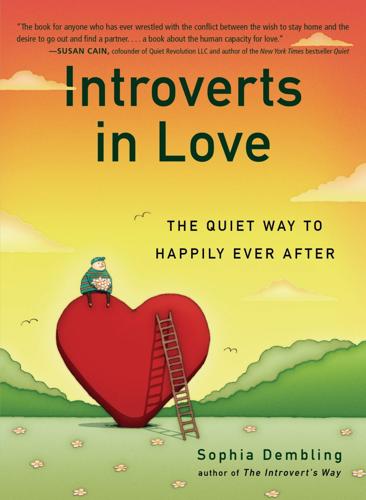
Introverts in Love: The Quiet Way to Happily Ever After
by
Sophia Dembling
Published 6 Jan 2015
Besides, even though we may whine and drag our feet, we sometimes find that we enjoy ourselves despite ourselves, that taking a cultural excursion into the extroverted world can be a lot of fun if we go in with an open mind. Laura’s boyfriend has all the earmarks of a raging extrovert. “This is a guy who goes to Burning Man,” Laura says—which is saying a lot. Burning Man is an arty, uninhibited, counterculture, proudly weird multiday event in the desert, and the very thought of it makes me want to hide under my desk. But, Laura continues, she did once go with him to a Halloween party in costume (something else that makes me sweat) and ended up having a grand time.
…
action, 14–15 inaction, 32–33 adrenaline, 67 adventure, 21 agreeableness, 176 alcohol, 78–79 bar date and, 100 alone time, 102–3, 154–59 creating space for, 35–38 anxiety easing strategies for first dates, 89–93 rejection and, 61 approachability body language and, 50–52 dating and, 49–52 eye contact and, 51, 80–81 group activities and, 63–64 attention, competing for, 16–17 attraction, 5 adrenaline and, 67 shadow theory and, 170–71 sparkle vs. glow and, 16–18 avoidance conflict, 116, 168–69 of group activities, 131 of parties, 131 backing out of plans, 108–9, 149 balance, 15, 91, 131 extrovert-introvert couples, 147–49 bar date, 100 behavior, 5 passive-aggressive, 166–67 patterns, 111 being present, 164–65 best features, 20–22 blind dates, 47–48 blinders, 31–32 body language. See also eye contact approachability and, 50–52 assessing others, 80 confidence and, 50–51 book clubs, 66 Botton, Alain de, 33 boundaries, setting, 104–5 with honest language, 106–9 brain chemistry, 5 builder personality type, 5 Burning Man, 136 Chapman, Gary, 172, 174 chatter, 8, 9, 46, 52, 82 practice, 63–64 with strangers, 68 Chemistry.com, 5 childhood pains, 27 patterns, 170 code phrases, 132 college, 54 comfort zone, 10, 136–37 common ground, 82–83, 130, 138 communication, 153.
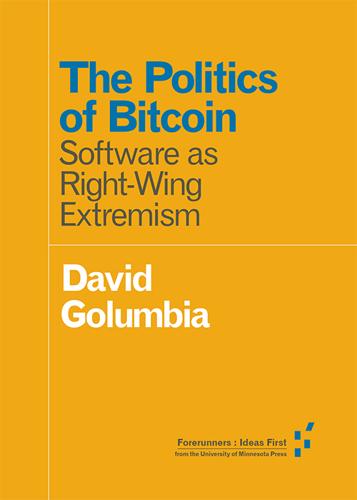
The Politics of Bitcoin: Software as Right-Wing Extremism
by
David Golumbia
Published 25 Sep 2016
As objects of discourse, Bitcoin and the blockchain do a remarkable job of reinforcing the view that the entire global history of political thought and action needs to be jettisoned, or, even worse, that it has already been jettisoned through the introduction of any number of digital technologies. Thus, in the introduction to a bizarrely earnest and destructive volume called From Bitcoin to Burning Man and Beyond (Clippinger and Bollier 2014), the editors, one of whom is a research scientist at MIT, write, “Enlightenment ideals of democratic rule seem to have run their course. A continuous flow of scientific findings are undermining many foundational claims about human rationality and perfectibility while exponential technological changes and exploding global demographics overwhelm the capacity of democratic institutions to rule effectively, and ultimately, their very legitimacy” (x).
…
Casey, Michael J. 2014. “Bitcoin Foundation’s Chief Jon Matonis to Resign.” Wall Street Journal (October 30). http://www.wsj.com/. Chomsky, Noam. 2015. “Creating the Horror Chamber.” Jacobin (July 28). http://www.jacobinmag.com/. Clippinger, John H., and David Bollier, eds. 2014. From Bitcoin to Burning Man and Beyond: The Quest for Identity and Autonomy in a Digital Society. Boston: ID3 / Off the Common Books. Conner, Claire. 2013. Wrapped in the Flag: What I Learned Growing Up in America’s Radical Right, How I Escaped, and Why My Story Matters Today. Boston: Beacon Press. “Controlled Supply.” Bitcoin wiki. http://en.bitcoin.it/.
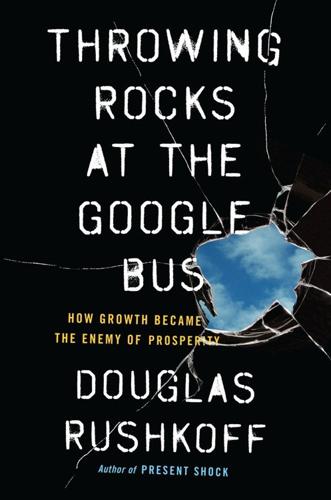
Throwing Rocks at the Google Bus: How Growth Became the Enemy of Prosperity
by
Douglas Rushkoff
Published 1 Mar 2016
By reducing human beings to mere cogs in a machine, we created the conditions to worship growth over all other economic virtues. We must reckon with how and why we did this. MASS MASS MASS For a happy couple of centuries before industrialism and the modern era, the business landscape looked something like Burning Man, the famous desert festival for digital artisans. The military campaigns of the Crusades had opened new trade routes throughout Europe and beyond. Soldiers were returning from faraway places after having been exposed to all sorts of new crafts and techniques for building and farming. They even copied a market they had observed in the Middle East—the bazaar—where people could exchange not only their goods but also their ideas, leading to innovations in milling, fabrication, and finance.
…
That is, we conceive of the digital in terms of the limits of the previous landscape rather than the potentials of the new one. It’s time to understand these potentials not as threats to business as usual but as the true promise of digital economics. THE DIGITAL MARKETPLACE: WINNER TAKES ALL Those of us who thought the digital marketplace was going to look something like a Burning Man festival got it wrong—at least in the short term. The distributed nature of the net, with its decentralized connectivity and ad hoc social activity, appeared to augur an equally distributed marketplace. Instead of buying everything at Walmart and watching our personal and community wealth extracted by a highly centralized corporation, we would now enter a new phase of peer-to-peer commerce.
…
Subsistence farming of the preindustrial era finds new expression in the sustainability agriculture agenda of today. This leap forward by hearkening back is characteristic of any great cultural or economic shift. That’s why at the vanguard of digital culture we see the retrieval of lost medieval values and practices, from the Burning Man festival to peer-to-peer currencies, and paganism to steampunk handcrafts. It’s not moving backward. It doesn’t constitute a regression so much as a recursion—a rediscovery of something old but in an entirely contemporary context. As Pope Francis put it, preempting this very accusation, “Nobody is suggesting a return to the Stone Age, but we do need to slow down and look at reality in a different way, to appropriate the positive and sustainable progress which has been made, but also to recover the values and the great goals swept away by our unrestrained delusions of grandeur.”10 Keep the progress, but recover the lost values.
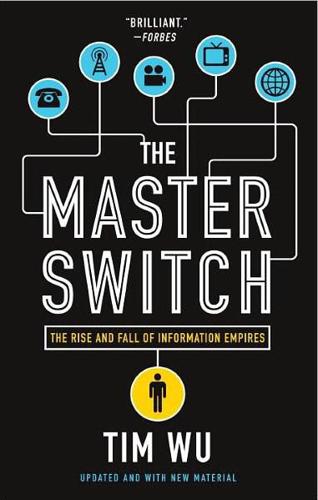
The Master Switch: The Rise and Fall of Information Empires
by
Tim Wu
Published 2 Nov 2010
For example, in a 2007 press release, Verizon announced it was committed to allowing any wireless device and any app on its network. See news.vzw.com/news/2007/11/pr2007-11-27.html. 22. The best account of such a future is a novel by Cory Doctorow, Down and Out in the Magic Kingdom (New York: Tor Books, 2003); it is also the evident vision of the Burning Man festival. On the relationship between the tech world and Burning Man, see Fred Turner, “Burning Man at Google,” 145. ABOUT THE AUTHOR Tim Wu is an author, a policy advocate, and a professor at Columbia University. In 2006 he was recognized as one of fifty leaders in science and technology by Scientific American magazine, and in 2007, 01238 magazine listed him as one of Harvard’s one hundred most influential graduates.
…
To understand this unusual level of consumer preference and trust in a market with other real choices is to understand the source of Google’s singular power. But is this a stroke of cold luck, or is Google something special? Quite enough has been written about Google’s corporate culture, whether one looks to the cafeterias that serve free food, the beach volleyball, or the fact that its engineers like to attend the Burning Man festival in the Nevada desert.14 Not that such things aren’t useful inducements to productivity or the exception in corporate America, but they are more nearly adaptations of a general Silicon Valley corporate ethos than one particular to Google, a point the company readily admits. Boiled down, the Google difference amounts to two qualities, rather than any metaphysical uniqueness.
…
The idea of describing Google as a switch comes from my colleague Charles Sabel at Columbia. 13. Siva Vaidhyanathan, Googlization of Everything: How One Company Is Transforming Culture, Commerce, and Community and Why We Should Worry (London: Profile Books, 2010). 14. This particular corporate tradition is described in Fred Turner, “Burning Man at Google: A Cultural Infrastructure for New Media Production,” New Media & Society 11 (2009): 145. 15. As quoted in, among other places, Janet Lowe, Google Speaks (Hoboken, NJ: John Wiley & Sons, 2009), 39. Google’s origins at Stanford are described in John Battelle, The Search (New York: Portfolio, 2005). 16.

Elon Musk: Tesla, SpaceX, and the Quest for a Fantastic Future
by
Ashlee Vance
Published 18 May 2015
Near the end of the summer that year, Lyndon rented an RV and set out with Musk for the Black Rock desert and the madness of Burning Man. The men used to go on adventures all the time when they were kids and looked forward to the long drive as a way to catch up and brainstorm about their businesses. Musk knew that Lyndon and his brothers were angling for something big. While driving, Musk turned to Lyndon and suggested that he look into the solar energy market. Musk had studied it a bit and thought there were some opportunities that others had missed. “He said it was a good place to get into,” Lyndon recalled. After arriving at Burning Man, Musk, a regular at the event, and his family went through their standard routines.
…
The silver model was then turned into a digital rendering that the engineers could manipulate on their computers. A British company took the digital file and used it to create a plastic version of the car called an “aero buck” for aerodynamics testing. “They put it on a boat and shipped it to us, and then we took it to Burning Man,” Tarpenning said, referring to the annual drug-infused art festival held in the Nevada desert. About a year later, after many tweaks and much work, Tesla had a pencils-down moment. It was May 2006, and the company had grown to a hundred employees. This team built a black version of the Roadster known as EP1, or engineering prototype one.
…
There was a wooden pole perhaps thirty feet high with a dancing platform at the top. Dozens of people tried and failed to climb it, and then Musk gave it a go. “His technique was very awkward, and he should not have succeeded,” said Lyndon. “But he hugged it and just inched up and inched up until he reached the top.” Musk and the Rives left Burning Man enthused. The Rives decided to become experts on the solar industry and find the opportunity in the market. They spent two years studying solar technology and the dynamics of the business, reading research reports, interviewing people, and attending conferences along the way. It was during the Solar Power International conference that the Rive brothers really hit on what their business model might be.
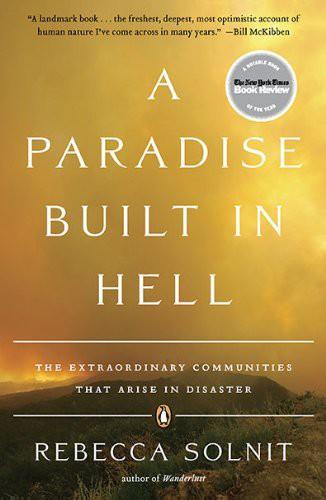
A Paradise Built in Hell: Extraordinary Communities That Arise in Disaster
by
Rebecca Solnit
Published 31 Aug 2010
I have been to a regional Rainbow Gathering, and my response was mixed—I’m not big on clouds of pot smoke, hugs from strangers, hybridized religious appropriations, and grubby personal style—but I saw the desire and partial realization of a goal of creating a mutual-aid gift-economy society and an impressive and moving atmosphere of sweetness, openness, and generosity. A crucial aspect of Rainbow Gatherings that was not true of Wood-stock in 1969 or Burning Man now is that it truly exists as far outside the monetary economy as possible. Burning Man, the huge annual desert gathering, charges a steep admission, patrols to keep the nonpaying out, hires a company to supply and maintain hundreds of chemical toilets, contracts a local hospital to set up a clinic on-site, and leaves all major decisions to the staff of the limited-liability corporation it has become.
…
They did not know for the several hours that they were trapped there in the dark whether the water would continue to rise, but the monks chanted, everyone remained calm, and afterward the national Vietnamese community brought relief supplies and aid in rebuilding the temple (as did the Burners without Borders project started by participants in the annual Burning Man festival in the Nevada desert). The doctor who had been stranded there told me, “Everything is so impermanent. One day we’re having a celebration and a grand opening and the next day it’s all destroyed. So you just sit down and think deeply. It does shock me to go through that. But as for the people it’s very hard.
…
This was the hardest I have ever worked as I got up at 7:00 am to work till midnights each night with sweat pouring down me all day in the 95-103 degree sun. Yet the faces who came each morning and thanked us for giving them hope made it all worth it.” They were serving as many as four thousand meals a day, much of it food donated by the Organic Valley cooperative, in a geodesic dome tent donated by people from Burning Man. That a bunch of latter-day hippies found common ground with evangelical Christians is in some way typical of disasters; the crisis created circumstances in which their common goals mattered a lot and their divergent beliefs and lifestyles didn’t. Some of the churches were doing good works a century ago and may well be doing them a century from now.

Smart Mobs: The Next Social Revolution
by
Howard Rheingold
Published 24 Dec 2011
In the San Francisco Bay Area, a resource center and interest group for wireless activists grew out of PlayaNet—instant broadband infrastructure for a temporary autonomous zone in the middle of nowhere.28 Every year, 25,000 dionysiac technogeeks gather for a collective art ritual in the Nevada desert, the Burning Man festival, constituting the fifth-largest city in Nevada for a week.29 Burning Man has dozens of radio stations and its own WiFi network, one of the earliest. PlayaNet gave birth to the Bay Area Wireless Users Group (BAWUG), which maintains a mailing list of over a thousand and sponsors monthly meetings. BAWUG member Cliff Skolnick publishes a map of voluntarily open WiFi networks in the San Francisco area (which is how I discovered that p2p maven Cory Doctorow had moved from Toronto).
…
Dana Spiegel, email correspondence, 29 January 2002. 26. Jonietz, “Unwiring the Web.” 27. Peter Meyers, “In a Pinch, Wi-Fi Fills the Gap,” New York Times, 4 October 2001, <http://www.nytimes.com/2001/10/04/technology/circuits/04ACCE.html?ex=100> (23 February 2002). 28. PlayaNet, <http://www.playanet.org > (23 February 2002). 29. Burning Man, <http://www.burningman.com > (23 February 2002). 30. Cory Doctorow, email correspondence, 25 February 2001. 31. “SFLan Manifesto,” <http://www.sflan.com/index.html > (23 February 2002). 32. John Markoff, “The Corner Internet Network vs. the Cellular Giants,” New York Times, 4 March 2002, <http://www.nytimes.com/2002/03/04/technology/04MESH.html > (6 March 2002). 33.
…
See Bits and atoms Attentive billboards Auctions and the Prisoner's Dilemma and Reed's Law and reputation systems See also Auctionweb eBay Web site Auctionweb Augmented reality Aula project (Helsinki) Australia Automobiles: GPS devices in manufacturing of Axelrod, Robert Baker and McKenzie Barcode readers Barpoint service Battle of Seattle Baudrillard, Jean BAWUG (Bay Area Wireless Users Group) BBC (British Broadcasting Corporation) News Beatles Becker, Gene Behlendorf, Brian Bell Canada Bell Labs See also AT&T (American Telephone & Telegraph) Bellovm, Steve Benkler, Yochai Bennahum, David Bentham, Jeremy Benzon, William Berners-Lee, Tim Big game hunting See also Hunting Big Sky Telegraph system Billboards, attentive BIND software Bioacoustics research Biology and reputation systems and self-organizing systems and threshold models Bits and atoms: dance of "marriage of," BlackBerry pagers Blink.com Web site Blogs Bluetooth Bluetooth Special Interest Group BMW (Bavarian Motor Works) Boingo Botfighters Botswana Bozofilters BPDG (Broadcast Protection Discussion Group) Bricklin, Dan Britain See also United Kingdom Bronowski, Jacob Browsers, advent of Brunner, John Bryant Park Bryant Park Restoration Corporation Bug's Life, A (film) Building Wireless Community Networks (O'Reilly Associates) Buildings, computer chips in See also Smart rooms Burning Man festival Bush, Vannevar Business plans Butera, William Cable: Internet access modems television Cancer Capitalism Carnegie Bosch Institute Carpenter, Loren Center for Bits and Atoms (MIT) Chechen rebels Chicken game See also Game theory Chwe, Michael Suk-Young Circuit-switched networks Cities, digital Cisler, Steve Citizen Watch Company CITRIS (Center for Information Technology Research in the Interest of Society) City of Bits (Mitchell) Civil libertarians Clark, Andy Climate change Clothing.
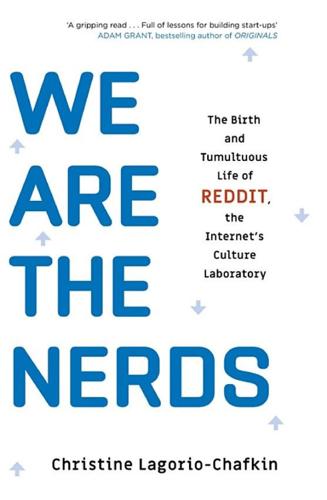
We Are the Nerds: The Birth and Tumultuous Life of Reddit, the Internet's Culture Laboratory
by
Christine Lagorio-Chafkin
Published 1 Oct 2018
That same summer, Huffman and his friends all flew to Ibiza for Seibel’s bachelor party. Huffman dominated the club dance floors all over the Mediterranean island. Also in the summer of 2014, Kan spent evenings and weekends enlisting a group of about twenty friends to prepare for Burning Man, the sixty-thousand-person, clothing-optional experiment in radical self-reliance that takes place at the end of August. As every Burning Man participant is encouraged to gift services or goods to others, Kan’s camp would be called Bao Chicka Wow Wow and would provide warm pork buns to hungry residents of the temporary city. Kan also wanted to create a mobile piece of public art, in the form of a massive “art car,” as many roving vehicles of the playa are known.
…
The physical engineering challenge was a welcome respite from his typical days managing Hipmunk programmers. By 2014, Burning Man had become a weeklong creative outlet for outsider artisans everywhere, but for Silicon Valley’s tech plutocrats it had become an almost mandatory annual social event, an opportunity to rub sunburned, sand-specked elbows with millionaire and billionaire attendees such as Larry Page, Sergey Brin, and Jeff Bezos. Kan’s friends, Huffman included, spent the end of August camping in Black Rock City and roaming it in their massive iceberg on wheels, which had been dubbed “Titanic’s End.” Huffman had embraced the Burning Man mantra of “radical self-reliance.”
…
Sometimes, on nice days, he would take a candidate up to the top floor of 420 Taylor, which was no longer empty; it was equipped with communal tables and desks. He’d open the glass doors to the sprawling, sunny rooftop deck and show them to a chaise. He’d kick his feet up, lean back, and maybe rest a hand behind his head. He was trying to stay balanced. In late August 2017, he took a vacation, out to Burning Man with his girlfriend, Elvie Stephanopoulos. During a windstorm, sand whipping up from the playa, he swooped her up into the air. She wrapped her arms around his shoulders, over which was draped a goofy red Hawaiian shirt, and kicked her dusty black boots up in the air. Under a vintage marquee sign whose letters read “stage your own death,” they kissed.

Western USA
by
Lonely Planet
Wildflower Village MOTEL $ ( 775-747-8848; www.wildflowervillage.com; 4395 W 4th St; r $50-75, B&B $100-125; ) Perhaps more of a state of mind than a motel, this artists colony on the west edge of town has a tumbledown yet creative vibe. Murals decorate the facade of each room, and you can hear the freight trains rumble on by. BURNING MAN For one week at the end of August, Burning Man (www.burningman.com; admission $210-320) explodes onto the sunbaked Black Rock Desert, and Nevada sprouts a third major population center – Black Rock City. An experiential art party (and alternative universe) that climaxes in the immolation of a towering stick figure, Burning Man is a whirlwind of outlandish theme camps, dust-caked bicycles, bizarre bartering, costume-enhanced nudity and a general relinquishment of inhibitions.
…
From dinosaur sculptures to two-headed squirrels to festivals that celebrate desert creativity, weird is the way to go. The bumper sticker we saw in Jerome says it best: ‘We’re all here because we’re not all there.’ Route 66 This two-lane ode to Americana is dotted with wacky roadside attractions, especially in western Arizona (boxed text, Click here) Burning Man Festival A temporary city in the Nevada desert attracts 55,000 for a week of self-expression and blowing sand (boxed text, Click here) Roswell Did a UFO crash outside Roswell, New Mexico in 1947? Museums and a UFO festival explore whether the truth is out there (Click here) Seattle’s Public Sculptures In Fremont, look for a car-eating troll, a human-faced dog and some folks waiting, and waiting, for the train (Click here) Venice Boardwalk Gawk at the human zoo of chainsaw-jugglers and Speedo-clad snake-charmers (Click here) Museums Modern art.
…
PERSEIDS Peaking in mid- August, these annual meteor showers are the best time to catch shooting stars with your naked eye or a digital camera. For optimal viewing, head into the southern deserts. September Summer’s last hurrah is the Labor Day holiday weekend. It’s a particularly nice time to visit the Pacific Northwest, where nights are cool and the days reliably sunny. Fall colors begin to appear in the Rockies. BURNING MAN Outdoor celebration of self-expression known for elaborate art displays, an easygoing barter system, blowing sand, and the final burning of the man. This temporary city rises in the Nevada desert the week before Labor Day (see boxed text, Click here). GREAT AMERICAN BEER FESTIVAL This three-day celebration of beer in Denver is so popular it always sells out in advance, when 400 US breweries get in on the sudsy action (Click here).

Uncanny Valley: A Memoir
by
Anna Wiener
Published 14 Jan 2020
Whenever we saw a stranger at the gym wearing a T-shirt with our logo on it, whenever we were mentioned on social media or on a client’s blog, whenever we received a positive support ticket, we shared it in the company chat room and we felt proud, genuinely proud. * * * I began wearing flannel. I bought Australian work boots and biked to work in them, sweating. I incorporated B vitamins into my regimen and felt more awake, more cheerful. I began dipping into EDM. It was a vestige of Burning Man that never went out of season in the Bay Area, like ecstatic dance or LED-studded sculptures or psychedelic leggings. Listening to EDM while I worked gave me delusions of grandeur, but it kept me in a rhythm. It was the genre of my generation: the music of video games and computer effects, the music of the twenty-four-hour hustle, the music of proudly selling out.
…
An engineer was rumored to have lived in the office for a while, sleeping in a lounge area atop an indoor shipping container—a visual pun on shipping code—until he was discovered, by the security team, bringing home a date. My coworkers treated it as much like an office as a clubhouse. People roamed around barefoot, juggling and playing guitar. They came in wearing expressive and ironic clothing: spandex leggings printed with unicorn emojis, shirts printed with teammates’ faces, bondage collars, Burning Man pelts. Some played video games while they half worked, or napped in the coder caves—dark, cushioned booths designed for those who worked best under conditions of sensory deprivation. It seemed like half of the engineers were DJs—a group of developers regularly performed at a club in the Mission, with a data scientist who projected angular and geometric visualizations on a screen behind them.
…
It’s just about personal leverage. When I was exposed to asbestos, nobody doing comp-sci at an Ivy League was showing up to help.” I had not chosen the right audience. I was not prepared for this argument. This was just the next phase of the artisanal fetish, the engineer said. It was like LARPing, like Burning Man. “It’s a working-class MMOG,” he said, shooting me a withering look. “We are not vulnerable people.” I felt ashamed about my own class privilege, everything I took for granted. My closest brush with manual labor was breaking down cardboard boxes in the basement of an independent bookstore. I retrieved additional seltzer waters for us, tangerine flavor.
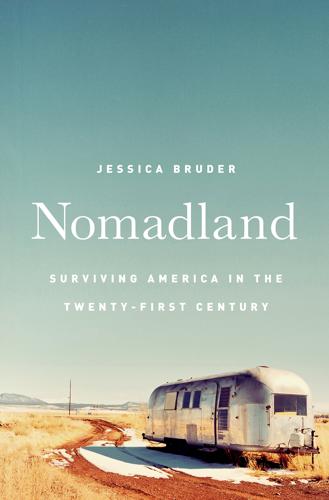
Nomadland: Surviving America in the Twenty-First Century
by
Jessica Bruder
Published 18 Sep 2017
Don was the first member of CamperForce I met, a sharp and entertaining storyteller who spent long hours regaling me with tales of life on the road. He was originally scheduled to work his last CamperForce shift on December 21. His post-Amazon plans included passing through Quartzsite—he called it “Burning Man for geezers”—and visiting friends in the Colorado Rockies. But something very unusual took place instead. In what would become three years of reporting on CamperForce workers, I would never witness anything like it happen again—Amazon offered Don a full-time, year-round job. “Hey, I’m seventy, who else is going to hire me?”
…
But then memories of stealth parking return—how it feels to hide behind covered windows, your heartbeat quickening at a stranger’s approaching footsteps. I walk away. Encountering so many nomads around Brooklyn is eye-opening. It’s not the first time this project has hit close to home, though. Midway through reporting, I learned that Swankie’s younger son, a software engineer from Seattle, is someone I’d met years earlier at Burning Man. Later on, LaVonne and I realized that one of her dear friends is married to a journalist pal of mine in Berkeley. Both times I wondered: What are the odds of that? Maybe not so low. After all, millions of Americans are wrestling with the impossibility of a traditional middle-class existence. In homes across the country, kitchen tables are strewn with unpaid bills.
…
U.S. most unequal: “Inequality Update,” Organisation for Economic Co-operation and Development, November 2016, https://www.oecd.org/social/OECD2016-Income-Inequality-Update.pdf. 248. Comparing nations’ inequality: http://www.indexmundi.com/facts/indicators/SI.POV.GINI/rankings. 248. Octopus in a coconut: https://www.facebook.com/LADbible/videos/2969897786390725. ALSO BY JESSICA BRUDER Burning Book: A Visual History of Burning Man Photographs by Jessica Bruder. Photograph page 34 courtesy of Linda May. Copyright © 2017 by Jessica Bruder All rights reserved First Edition For information about permission to reproduce selections from this book, write to Permissions, W. W. Norton & Company, Inc., 500 Fifth Avenue, New York, NY 10110.

Work Rules!: Insights From Inside Google That Will Transform How You Live and Lead
by
Laszlo Bock
Published 31 Mar 2015
Early on, we decided that “you can be serious without a suit,” and enshrined that notion in the “10 Things We Know to Be True,” a list of ten beliefs that guide how we run our business.vi We even play with our brand, something that most companies hold sacrosanct, swapping our regular logo for Google Doodles on our website. The first one, on August 30, 1998, was a tongue-in-cheek out-of-office notice for Larry and Sergey: The Burning Man Google Doodle. © Google, Inc. They had gone to Burning Man, an annual festival of art, community, and self-reliance in the Nevada desert. The figure in the middle represented the Burning Man himself. On June 9, 2011, we commemorated Les Paul, one of the pioneers of the solid-body electric guitar, with an interactive Doodle. If you brushed the guitar strings with your mouse or finger, you made music.
…
Finally, thank you to the remarkable Googlers I get to work with each day and to the amazing, amazing People Operations team. I’ve told them before and I’ll keep saying it: It’s a privilege to be able to work alongside you, learn from you, create with you. There’s not a team like you on the planet, and it’s a gift to enjoy your company. Photo Credits Here: Google Images & Tessa Pompa Here: Google & Burning Man Here: The Google Doodle team Here: Google Maps Here: Google Maps Here: Google Maps Here: Google Maps (maps.google.com/oceans) Here: Google Maps Here: Google Maps Here: Change.gov Here: Google Here: Google Here: Google Here: Google Here: Google Here: Google Here: Google Here: Google Here: Google Creative Lab Here: Photo courtesy of Brett Crosby Here: Inspired by Adam Wald Here: Google Here: Google Here: Paul Cowan Here: Google Here: Google Here: Google Here: Google Here: Courtesy of Archives & Special Collections at the Thomas J.
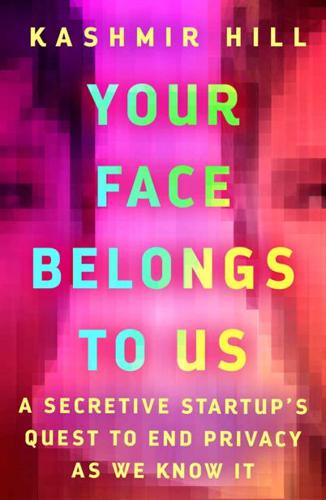
Your Face Belongs to Us: A Secretive Startup's Quest to End Privacy as We Know It
by
Kashmir Hill
Published 19 Sep 2023
He traveled the world for a few months, visiting Paris and Berlin, Vietnam and Australia. He attended Burning Man, an annual festival in Black Rock Desert, Nevada, which attracts bohemians, creatives, and Silicon Valley types who consume art, music, and drugs as a form of soul-searching. Someone there took a serene-looking photo of him on a white bicycle, wearing a silky golden tunic and cream-colored pants, holding an oil-paper umbrella to shield himself from the bright desert sun; yet he had been a polarizing figure in his Burning Man camp. One campmate described him as charismatic and witty, while another said he was “a horrible human being” who loved to provoke and rile sensitive people.
…
“He was a person looking for an identity.” Like Alströmer, many of Ton-That’s friends in New York couldn’t understand how he had come to identify with the nationalistic, pro-white MAGA crowd. Ton-That was smart and sensitive, a feminist who played guitar soulfully at parties and had wandered the radically inclusive camps of Burning Man just the summer before. At the same time, he was a contrarian who liked to play the devil’s advocate in an argument. His friends thought that was part of the reason he supported Trump. Donning a MAGA cap in Manhattan was a very easy way to get a rise out of people. “In today’s world, the ability to handle a public shaming/witch hunt is going to be a very important skill,” he tweeted presciently
…
See also facial recognition; fingerprints/fingerprinting Abrams case and, 209, 211, 212 care with in Illinois, 151, 158 communities of color and, 239 lack of laws regarding, 100 legislation protecting, 82–87, 223, 240 orders to delete information on, 192 possible expansion of use of, 194 use of in United Kingdom, 215–220 BIPA (Biometric Information Privacy Act; Illinois) Clearview AI and, 158, 204, 205, 206, 213 lawsuits filed under, 151–152 passage of, 86 SceneTap and, 122 Bitcoin, 81, 222–223 Black Hat, 108, 110 Black Lives Matter, 11 Blackwater, 51–52 Bledsoe, Woody, 37, 38, 39, 40, 125 Bloomberg LP, 81 Blue Lives Matter, 232 BMI predictors, 32 Booker, Cory, 11 border walls, sensor-based, 57 Borthwick, John, 112–113 Boston Marathon bombing, 287n106 Bosworth, Andrew “Boz,” 243–244 Brandeis, Louis D., viii, 204–205 Bratton, William, 129–130 Bridges, Ed, 308n219 Brill, Julie, 122, 125 Broderick, Matthew, 117 “broken windows” policing, 129 Brown, Dan, 247 Brown, Michael, 11 Brululo, Bridget, 292n134 Buckby, Jack, 272n50 Buolamwini, Joy, 156 Burning Man, 8–9, 10 Bush, George W., ix, 11, 64, 157, 209 Buzz, 102 BuzzFeed News, 165–166 C Cagle, Matt, 137–138 Cahill Gordon & Reindel, 205–206 Cambridge Analytica scandal, 6, 92 cameras.
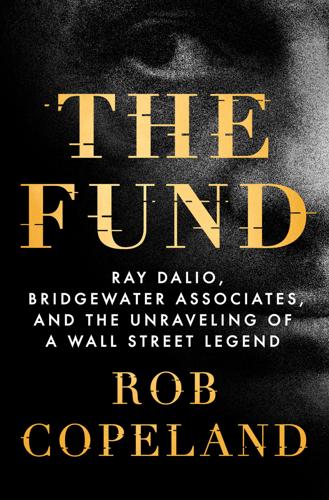
The Fund: Ray Dalio, Bridgewater Associates, and the Unraveling of a Wall Street Legend
by
Rob Copeland
Published 7 Nov 2023
Dorsey, according to Dalio, had even invited him to the tech executive’s mountain estate for a private tutorial on The Principles. Dorsey’s hang-loose vibe apparently was contagious because in September 2019 Dalio showed up at Burning Man, the celebrity hot-spot desert festival best known for psychedelics and all-night ragers. Dalio got in his photo op. He tweeted a photo of himself from Burning Man, clad in tie-dye bell-bottom pants and a multicolored jacket with a cerulean-blue feather trim that made it look as if he were lost on the way to a midnight showing of The Rocky Horror Picture Show. How long he stayed in the desert is unclear (in the Twitter photo, his clothing is immaculate, while the man next to him is covered in sand), but he gave the impression of being a true Burner.
…
How long he stayed in the desert is unclear (in the Twitter photo, his clothing is immaculate, while the man next to him is covered in sand), but he gave the impression of being a true Burner. “What a great vibe and what amazing creativity!” he wrote on Twitter. “If you go next year, 1–5am is best.” The tweet received thousands of likes and elicited responses such as “Ray Dalio is really out there living his best life.” Wrote another, “Burning Man is officially dead.” * * * YET AS Dalio crossed the world glorifying the value of using The Principles in day-to-day life, the software based on them continued to be a wreck. This was the plain reality of what Dalio had built. Bridgewater, judged by the sheer sum of the money it managed, was a financial juggernaut, and much of that had to be credited to its founder.
…
Absolute Return (magazine) Ackman, Bill Adams, Tom Ahuja, Maneet Alexander, Keith Allred, Gloria Allstream project All-Weather portfolio Alpha (magazine) alpha, concept of Apple Arnold, Tara artificial intelligence Aspen Institute Banks of Mid-America Barber, Roy Bar Dea, Nir Barron’s (periodical) Bass, Kyle Bear Stearns believability believability weighting Benioff, Marc Bernanke, Ben beta, concept of Betfarhad, Ramsen Bezos, Jeff Black Mirror Blodget, Henry Bloomberg Businessweek (magazine) Book of the Future project Bridgewater Associates growth of Partnership of Principles of Transparency Library of see also individual entries Bridgewater Ethics Committee Buffett, Warren Burgess, Richard Burning Man festival Business Insider Campbell, Joseph Campbell, Kevin Canner, Niko Cassidy, John CBS This Morning Chief Investment Officer (magazine) China China Care Foundation China International Trust and Investment Corporation (CITIC) China Investment Corporation (CIC) Circle of Trust Cline, Michael cloud painters Coinbase Coltrera, Rick Comey, James B.
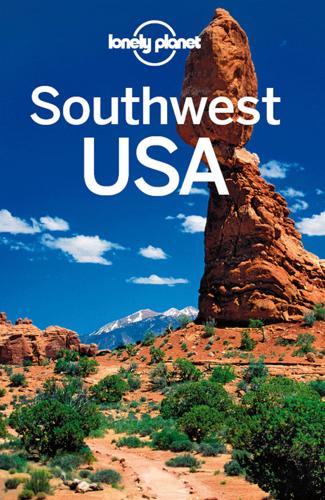
Southwest USA Travel Guide
by
Lonely Planet
The main drag is C St; check out the visitor center (775-847-4386, 800-718-7587; www.virginiacity-nv.org; 86 S C St; 10am-4pm) inside the historic Crystal Bar. Nearby is the Mark Twain Bookstore (www.marktwainbooks.com; 111 S C St; hours vary). GREAT BALLS OF FIRE! For one week at the end of August, Burning Man (www.burningman.com; admission $210-320) explodes onto the sunbaked Black Rock Desert, and Nevada sprouts a third major population center – Black Rock City. An experiential art party (and alternative universe) that climaxes in the immolation of a towering stick figure, Burning Man is a whirlwind of outlandish theme camps, dust-caked bicycles, bizarre bartering, costume-enhanced nudity and a general relinquishment of inhibitions. The cheesy, old-fashioned Way It Was Museum (775-847-0766; 113 N C St; adult/child $3/free; 10am-6pm) offers historical background on mining the lode.
…
Museums of the bizarre. Festivals that spotlight cannibals and desert creativity. Perhaps the bumper sticker we saw in Jerome says it best: ‘We’re all here because we’re not all there.’ Route 66 This two-lane ode to Americana is dotted with wacky roadside attractions, especially in western Arizona (Click here). Burning Man A temporary city in the Nevada desert attracts 55,000 for a week of self-expression and blowing sand (Click here). Roswell, NM Did a UFO crash outside Roswell in 1947? Museums and a UFO festival explore whether the truth is out there (Click here). Ogden Eccles Dinosaur Park Roadside dinosaurs at their kitschy, animatronic best (Click here).
…
Singing Wind Bookshop Destination indie bookstore has everything you’ll ever want to read about the Southwest, and a whole lot more (Click here). month by month Top of section Top Events Sundance Film Festival, January Cactus League, March Telluride Bluegrass Festival, June Burning Man, September Balloon Festival, October January Start the New Year swooshing down mountain slopes in New Mexico, Utah and yes, even Arizona. Artsy events like film festivals and poetry readings will turn your mind from the cold. Snowbirds keep warm in Phoenix and Yuma. COWBOY POETRY Wranglers and ropers gather in Elko, NV for a week of poetry readings and folklore performances.
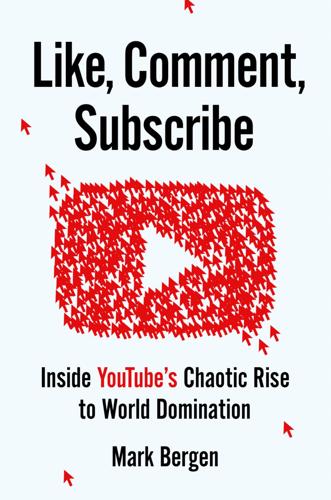
Like, Comment, Subscribe: Inside YouTube's Chaotic Rise to World Domination
by
Mark Bergen
Published 5 Sep 2022
GO TO NOTE REFERENCE IN TEXT went public with their split: Liz Gannes, “Google Co-Founder Sergey Brin and 23andMe Co-Founder Anne Wojcicki Have Split,” All Things D, August 28, 2013, https://allthingsd.com/20130828/google-co-founder-sergey-brin-and-23andme-co-founder-anne-wojcicki-have-split/. GO TO NOTE REFERENCE IN TEXT Brin went to Burning Man: Vanessa Grigoriadis, “O.K., Glass: Make Google Eyes,” Vanity Fair, March 12, 2014, https://www.vanityfair.com/style/2014/04/sergey-brin-amanda-rosenberg-affair. After separating in 2013, Sergey Brin and Anne Wojcicki divorced in 2015. A YouTube representative said the company could not confirm Brin’s attendance at Burning Man. GO TO NOTE REFERENCE IN TEXT said in a statement: Claire Cain Miller, “Google Appoints Its Most Senior Woman to Run YouTube,” The New York Times, February 5, 2014, https://bits.blogs.nytimes.com/2014/02/05/google-appoints-its-most-senior-woman-to-run-youtube/.
…
The staffer also happened to be dating an executive at Google’s Android division. Brin and Anne Wojcicki went public with their split in August 2013, noting, through a publicist, that they “remain good friends and partners.” Anne absconded to Fiji with girlfriends to unwind with yoga. Brin went to Burning Man. But the breakup and awkward love rectangle were a recurring topic in Google’s gossip mill, adding even more tension. Page, a devout family man, didn’t speak with his co-founder for some time afterward. Wojcicki told some confidants that she hated how the divorce unfolded, particularly Brin’s behavior during the episode.
…
As a side project Stack had converted his home in the Hollywood Hills into the Alchemy House, an artists’ space he imagined as a haven for creativity. He invited musicians and YouTubers. Olga Kay first arrived stunned to see Stack, who dressed conservatively at work, in shorts and blue nail polish; Stack, like many Googlers, was a Burning Man regular. In 2013, Stack reconverted his Alchemy House into a “decompression space.” After each VidCon, he invited YouTubers to come enjoy drinks and panoramic views, free from crowds, cameras, and the pressing need to upload. Perhaps Kay could have kept going on this treadmill if it were only twenty YouTube videos a week.
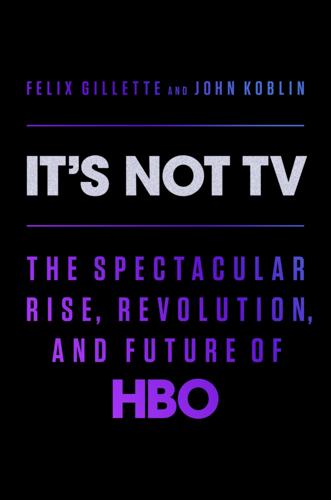
It's Not TV: The Spectacular Rise, Revolution, and Future of HBO
by
Felix Gillette
and
John Koblin
Published 1 Nov 2022
Afterward, Tesla’s Elon Musk, well on his way to becoming one of the richest humans on the planet, bristled at HBO’s uppity, unflattering depiction of the tech world. It was totally off base, he told Recode. “I really feel like Mike Judge has never been to Burning Man, which is Silicon Valley,” Musk said. “If you haven’t been, you just don’t get it.” Judge says he later became friends with Musk, but never made it to Burning Man, the annual arts festival and all-hours rave in Nevada’s Black Rock Desert. The show’s staff, however, did make plenty of other field trips. Between seasons, they would go on safari into the heart of the tech industry, alternately visiting small-time start-ups and enormous tech conglomerates, scooping up fodder for future episodes.
…
Every day, another seemingly obscure tech company was going public: FireEye. Cyan. Rocket Fuel. Gogo. Hordes of hopefuls were descending on the Bay Area, renting and living in closets, drinking meal-replacement shakes, hoovering up venture-backed snacks at company “pivot parties,” getting autographed by tech titans at product rallies, joining Burning Man camps, and commuting in private buses to carnival-like tech campuses. The only thing that felt sorely missing was somebody to make fun of it all. On April 6, 2014, HBO debuted Silicon Valley, a timely new comedy from Mike Judge, skewering America’s self-congratulatory start-up scene. Judge, the creator of several hit TV shows (Beavis and Butt-Head, King of the Hill) and movies (Office Space, Idiocracy) drew inspiration for the series in part from his own brief, lousy experience in the tech industry.
…
But at times Kilar’s exuberant stabs at humor struck some of his colleagues as odd. Not long after joining the company, Kilar popped up on an internal companywide video call wearing a purple wig and a pair of giant orange novelty sunglasses. A stuffed white owl sat on his shoulder. He looked like a rich guy visiting Burning Man for the first time. Then there was his preoccupation with TikTok. The short-form video-sharing site, owned by the Chinese company ByteDance, was exploding in popularity, particularly with young people. There were viral dancing videos. Acting lessons. Fashion tutorials. Recipes. Pranks. Above all else, Kilar wanted HBO Max to have an impressive presence on TikTok.
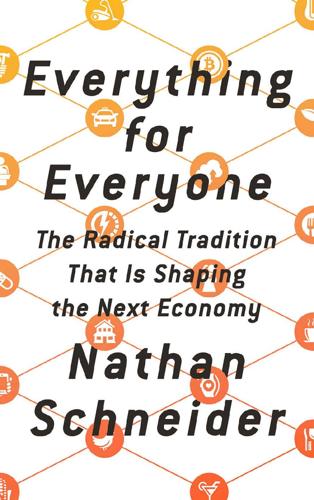
Everything for Everyone: The Radical Tradition That Is Shaping the Next Economy
by
Nathan Schneider
Published 10 Sep 2018
On the Oakland side of the border with Berkeley, a cavernous nightclub-turned-community-center called the Omni Commons is home to Sudo Room, a hackerspace with an anarchist bent, and Counter Culture Labs, where civilian scientists tinker with donated instruments and synthesize new forms of vegan cheese. And of course there is Burning Man, the Bay Area’s annual sojourn into the barren Nevada desert that manages to be both free and expensive, open and exclusive, all at once. Sign at a 2014 [freespace] storefront on Market Street in San Francisco. Hacker experiments turn into systems and workflows, then ways of life, then corporations.
…
But rather than sharing ownership among neighbors or co-workers, these were sharing it over the internet. Early on, lots of people came into this effort craving an instant co-op Uber replica—the same world-disrupting unicorn, except a nice, cooperative version. But we had to realize that Uber came out of a particular kind of ecosystem in Silicon Valley, of accelerators and investors and Burning Man camps and tech schools. To do things cooperatively, we’d need to undertake the patient work of building another kind of ecosystem. Scholz began forming a Platform Cooperativism Consortium to wrangle the various organizations involved, while I took to mapping the network in an online directory, the Internet of Ownership.18 I noticed that the ownership designs appearing among the baby platform co-ops weren’t just copying what was out there already.
…
Some of these might be versions of the unaccredited tech boot camps that promise to produce coders in a matter of weeks, like the Enspiral Dev Academy that I visited in New Zealand. Some might look like the degree-granting institution that Leland Stanford envisioned for the university that became the corporate training-ground for Silicon Valley. But education also happens through culture. Cooperative tech will need festivals more inclusive than Burning Man, journalism less gaga for startup bros than Wired, and a geography that doesn’t concentrate the gains into unaffordable places like Mountain View and Palo Alto. A group of women founders has called for a new culture of “zebra” startups, as opposed to the unicorns that VCs covet. Zebras are real, they say, whereas unicorns are imaginary; zebras run in herds and care for each other, but unicorns always seem to be alone.
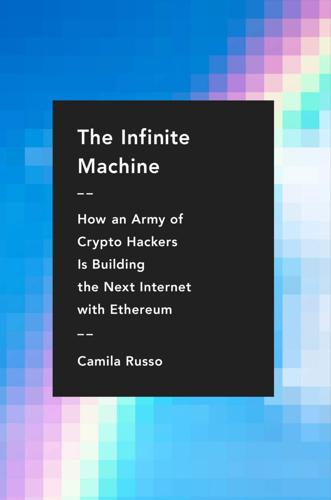
The Infinite Machine: How an Army of Crypto-Hackers Is Building the Next Internet With Ethereum
by
Camila Russo
Published 13 Jul 2020
And that doesn’t jibe with an office job. He sold everything he owned and bought physical bars of silver and gold coins to store his savings so that he could rely as little as possible on banks. He backpacked around South America, Southeast Asia, and India for two years (but always made the trek back home for Burning Man), and financed himself thanks to a friend who was selling his precious metals and transferring the cash. One day his friend thought of using Bitcoin to make the transfers. Griff loved the idea of currency that wasn’t issued by any government and exchanged his real gold for digital gold. He went back to the United States to live with a girlfriend in West Hollywood, where he worked as a massage therapist—he was using the skills he picked up in Thailand—but he couldn’t stop thinking about Bitcoin.
…
It was 3.6 million ETC, or about $5.5 million at the time. Giving Ethereum the middle finger once more, they then donated 1,000 ETC to the Ethereum Classic development fund. As the DAO thief was running off with his ill-gotten bag of cryptocurrency, Griff Green was making his annual pilgrimage to Burning Man, the weeklong, crazy, happy, hippie gathering in the middle of the Nevada desert. Amid art installations and spontaneous musical performances, Griff, decked out in a red Santa hat and Santa-like jacket over a green T-shirt and shorts, took the stage to proselytize about decentralized autonomous organizations.
…
,” Twitter, July 20, 2016, https://twitter.com/avsa/status/755764078098915328. 6. didn’t last long: Initiative for CryptoCurrencies and Contracts (@initc3org), “Heady days in Ithaca: Vitalik Buterin + IC3 Co-Directors celebrate Ethereum Hard Fork with champagne and forks,” Twitter, July 26, 2016, https://twitter.com/initc3org/status/758000698881613824/photo/1. 7. “and special interests”: “Keep the Original Censorship Resistant Ethereum Going,” Ethereum Classic website, 2016, https://web.archive.org/web/20160802024753/https://ethereumclassic.github.io/. 8. “lost a single dime”: Ptelepathetique Movies, “The DAO Explained (with Griff Green) Burning Man 2016,” YouTube, uploaded October 7, 2016, https://www.youtube.com/watch?v=mmVkpfivr8Q. 22: The Shanghai Attacks 1. praise from the community: Vitalik Buterin, “Geth 1.4.12: From Shanghai with Love, hotfix for recent DoS issues. Please update!” Reddit, 2016, https://www.reddit.com/r/ethereum/comments/53fbi0/geth_1412_from_shanghai_with_love_hotfix_for/. 2. year to about 250: “New Dapps per Month,” State of the Dapps, https://www.stateofthedapps.com/stats/platform/ethereum#new. 23: The Burning Wick 1. misogynistic messages instead: giatrosgiatros, “Stop Bashing MEW,” Reddit, 2016, https://www.reddit.com/r/ethereum/comments/5cfap3/stop_bashing_mew/d9w12vd/. 24: Accidentally Ether Rich 1. would go higher: Nathaniel Popper, “Bitcoin Price Soars, Fueled by Speculation and Global Currency Turmoil,” New York Times, January 3, 2017, https://www.nytimes.com/2017/01/03/business/dealbook/bitcoin-price-soars-fueled-by-speculation-and-global-currency-turmoil.html. 2. constant in 2017: US Securities and Exchange Commission, “Self-Regulatory Organizations; Bats BZX Exchange, Inc.; Order Disapproving a Proposed Rule Change, as Modified by Amendments No. 1 and 2, to BZX Rule 14.11(e)(4), Commodity-Based Trust Shares, to List and Trade Shares Issued by the Winklevoss Bitcoin Trust,” news release no. 34-80206, March 10, 2017, https://www.sec.gov/rules/sro/batsbzx/2017/34-80206.pdf. 3. the crypto Super Bowl: Stan Higgins, “Consensus 2017 Recap: The Biggest Main Stage Moments,” CoinDesk, May 27, 2017, updated May 29, 2017, https://www.coindesk.com/consensus-2017-recap-biggest-main-stage-moments. 4.
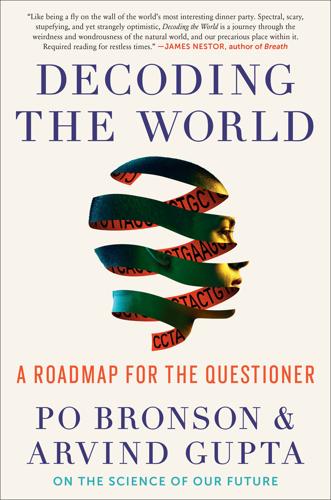
Decoding the World: A Roadmap for the Questioner
by
Po Bronson
Published 14 Jul 2020
But he also eats carbon sources all day long, digesting it into energy, with which he runs around, makes war, and makes love. He even grows carbon sources in his fields, and with all this food around, he replicates in plurality. He makes more humans. They chop down trees to burn. They dig up the terra firma and find black rocks to burn. Man builds machines that in turn harvest and dissipate yet more energy. In the same hundred years that a rock does jack squat, a man disperses the energy of a mountain. To the humble stored-energy sources in Earth, man is chaos. Dispersing it far and wide. Man pleases the entropic laws of the universe.
…
In the real Silicon Valley, trust is built at group houses, at poly communities, at the Russian baths where they whip you with leafy twigs of juniper and eucalyptus, or while kite surfing (in Maui). To deepen these connections, there are no-pants parties, and self-care meditations, and a floating-on-the-water version of Burning Man with renewed idealism. People have teahouses in their basement, where you might run into a VC you know—in a mermaid costume. The word “transformation” is used a lot. People take baths—with sound. Every night, somewhere in Silicon Valley, people are gathering. People go and spend a few hours, and when they walk out, they often feel unsure what it was all about.
…
This actor playing a Nigerian princess welcomed us, served us soup, and talked about how disconnected we’ve become. And then there was the ocean room, which was littered with plastic everywhere, and a woman in a robe was wearing a plastic buckyball molecule around her head and reciting climate change statistics. It was Burning Man lite, without the dust bowl. I wandered into yet another room. The prince was there; he wasn’t attached to a flock of aides and handlers. He said hi to people all by himself. The essential oxymoron of all Social Purpose Parties is the tension between the Party and the Cause, and how that translates into behavior and affect.

Lonely Planet Pocket San Francisco
by
Lonely Planet
and
Alison Bing
Published 31 Aug 2012
Drinking 15 Coffee to the People Cafe Offline map Google map The people, united, will never be decaffeinated at this utopian coffee shop with macramé on the walls, leftist bumper stickers covering tables, a social-change reading library, and 5% of your vegan muffin purchase pledged to community organizations – plus enough fair-trade coffee to revive the Sandinista movement. (1206 Masonic Ave; 6am-8pm Mon-Fri, 6am-9pm Sat & Sun; Haight St; ) 16 Noc Noc Bar Offline map Google map Who’s there? Dreadlocked graffiti artists, electronica DJs and Mad Max–inspired fashion designers, that’s who. This place looks like a post-apocalyptic cave dwelling designed by Tim Burton, and serves a sake cocktail that’ll keep you buzzed until the next Burning Man. Beer and sake drinks only; bring cash. (www.nocnocs.com; 557 Haight St; 5pm-2am; Haight St) 17 Toronado Pub Offline map Google map Glory hallelujah! Beer lovers, your prayers have been heard. Be humbled before the chalkboard altar, which lists 50-plus beers on tap and hundreds more bottled, including spectacular seasonal microbrews.
…
(www.amoeba.com; 1855 Haight St; 10:30am-10pm Mon-Sat, 11am-9pm Sun; Haight St) 28 Piedmont Boutique Clothing, Accessories Offline map Google map Glam up or get out at this supplier of drag fabulousness: faux-fur hot pants, airplane earrings and a wall of feather boas. These getups aren’t cheap, honey, because they’re custom-designed in-house, built to last and in demand by cabaret singers, cross-dressers, Burning Man devotees, strippers and people who take Halloween very seriously – in other words, everyone in SF. (www.piedmontsf.com; 1452 Haight St; 11am-7pm; Haight St) 29 Loyal Army Clothing Clothing, Accessories Offline map Google map Food with high self-esteem is a recurring theme on this San Francisco designer’s cartoon-cute tees, totes and baby clothes: a bag of chips says, ‘All that and me!’
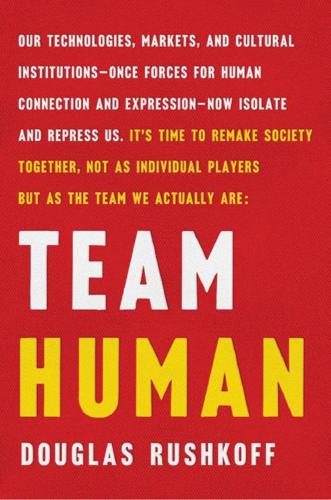
Team Human
by
Douglas Rushkoff
Published 22 Jan 2019
The over-rationalized, alienating approach to science is now joined by the newly retrieved approaches of holism and connectedness. We see peer-to-peer networks and crowdfunding replacing the top-down patronage of the Renaissance, retrieving a spirit of mutual aid and community. Even the styles and culture around this activity, from Burning Man and craft beer to piercing and herbal potions, retrieve the human-scaled, medieval sensibilities repressed by the Renaissance. A renaissance does not mean a return to the past. We don’t go back to the Middle Ages, bloodletting, feudalism, or sword fights in the street. Rather, we bring forward themes and values of previous ages and reinvent them in new forms.
…
Humans, at our best, are capable of embracing seeming paradox. We push through the contradiction and find a dynamic sensibility on the other side. We can think of our newly retrieved collectivism as a way of being both figure and ground at the same time. This is the idealized artistic community envisioned by Burning Man; it’s the politics of consensus that informed Occupy; and it’s the distributed economy aspired to by the open source and blockchain movements—to name just a few. Each of these movements depends on our comfort with what we could call a fractal sensibility, the notion that each tiny part of a system echoes the shape and structure of the whole.

The Future of the Internet: And How to Stop It
by
Jonathan Zittrain
Published 27 May 2009
Zittrain, The Generative Internet, 119 HARV. L. REV. 1974, 1994 n.72 (2006) (mentioning companies that provide edge-caching services). 53. See, e.g., Lemley & Lessig, supra note 48; Tim Wu, Network Neutrality, Broadband Discrimination, 2 J. TELECOMM. & HIGH TECH. L. 141 (2003). 54. See Burning Man, http://www.burningman.com/ (last visited Dec. 2, 2007); see also Xeni Jardin, Burning Man Never Gets Old, WIRED NEWS, Aug. 25, 2003, http://www.wired.com/culture/lifestyle/news/2003/08/60159. 55. See FCC, WIRELINE COMPETITION BUREAU, HIGH-SPEED SERVICES FOR INTERNET ACCESS: STATUS AS OF DECEMBER 31, 2004, at 6 (2005), available at http://www.fcc.gov/ Bureaus/Common_Carrier/Reports/FCC-State_Link/IAD/hspd0705.pdf CHAPTER 3.
…
But the network managed an astonishing leap as it continued to work when expanded into the general populace, one which did not share the world-view that informed the engineers’ designs. Indeed, it not only continued to work, but experienced spectacular growth in the uses to which it was put. It is as if the bizarre social and economic configuration of the quasi-anarchist Burning Man festival turned out to function in the middle of a city.54 What works in a desert is harder to imagine in Manhattan: people crashing on each others’ couches, routinely sharing rides and food, and loosely bartering things of value. At the turn of the twenty-first century, then, the developed world has found itself with a wildly generative information technology environment.
…
See Harvard University, Berkman Center Berners-Lee, Tim, 95 Bessen, James, 190 Bidder’s Edge, 224, 225 biometric readers, 228 BitTorrent, 90, 121, 287n113 BlackBerries, 57, 101, 118, 176 Black Hat Europe hacker convention (2006), 56–57 blogs: from automated robots, 207–8; captcha boxes of, 207–8; censorship of, 113; Libertarian model in, 131; power of, 88, 95; spread of, 148, 151; of teens, 231 Blossom, 195–96 Bomis search engine, 133, 289n19 bookmarks, 58 books.google.com (Web site), 224–25, 242 Bork, Robert, 202 Bostic, Keith, 38 Boston College, data loss by, 204 botnets, 45–47 Boyle, James, 113 Bricklin, Dan, 2 Brin, David, 209 broadband: PC accessibility via, 4; remote updates of, 53; tragedies of the commons in, 158 Brother, “smart” typewriters, 19, 20, 34 browsers, development of, 29 Burning Man festival, 34 business, “long tail” of, 214 “Bus Uncle” of Hong Kong, 211 cable television, 181–82, 183 Camp, Jean, 160 Cap’n Crunch whistle, 40, 42 captcha boxes, 207–8, 227 cars. See motor vehicles Carter, Tom, 22 Carterfone, 22, 25, 26, 81, 121, 182 CB simulator, 23 censorship, 105, 113–17; amplification of, 114–17; circumventing, 180; by commercial filtering programs, 114–15; and endpoint control, 125; Mill on, 98–99, 100; post hoc scrubs, 116; retroactive, 109 CERT/CC (Computer Emergency Response Team Coordination Center), 39, 147–48 chaos, in absence of law, 128 Chapman v.
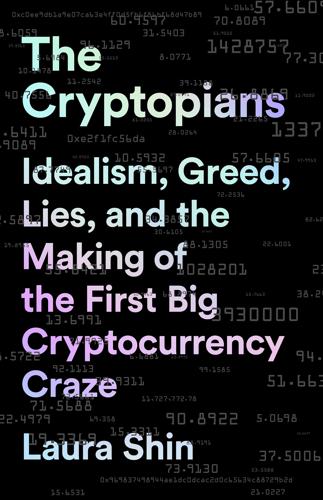
The Cryptopians: Idealism, Greed, Lies, and the Making of the First Big Cryptocurrency Craze
by
Laura Shin
Published 22 Feb 2022
He would take his paycheck to the Northwest Territorial Mint, turn it into gold and silver nuggets, and get dollars by selling to friends from the Seattle Austrian Economics Reading Group. He went full-on hippie, eating raw vegan and losing one hundred pounds. Eventually, in 2011, after his unemployment ended, he closed his bank account, sold everything he owned, bought a van, and checked out Burning Man. Then he exchanged the van for money and said good-bye to the United States (coming back only for his brothers’ birthdays and Burning Man). He traveled to South America, spent a lot of time in Ecuador, and then went to Thailand, where he bought Bitcoin for the first time. From the start, because of his fascination with money, Griff liked alt-coins. They embodied his philosophy that the story of money could be rewritten to have other meanings.
…
(Sam says it was because he could work remotely and conducted “months of business development in Dubai,” led an “IPO readiness process” for the company, and spent time on planes consulting “when seemingly every company in the world needed a blockchain strategy.”) One employee who started at ConsenSys at a time when Joe was off the grid at Burning Man recalled paychecks were delayed two weeks because the company needed to convert ETH for payroll. (Joe says he doesn’t remember this and says he wouldn’t be incommunicado for long or leave the finance department in a bad situation. He says he would typically arrive at Burning Man on Wednesday or Thursday and return to New York on Sunday or Monday.) One former employee described it thus: “The whole situation at ConsenSys was weird honestly, it was ‘executives’ who seemed more interested in partying and hiring their unqualified friends than building a real company.

The Code: Silicon Valley and the Remaking of America
by
Margaret O'Mara
Published 8 Jul 2019
Ken Auletta, Googled: The End of the World as We Know It (New York: Penguin Press, 2010), 20. 9. Stephanie Schorow, “Web heads go ga-ga for Google, for good reason,” Boston Herald, December 4, 2001, 51. 10. Fred Turner, “Burning Man at Google: a cultural infrastructure for new media production,” New Media & Society 11, nos. 1 & 2 (2009): 73–94; “Ten Principles of Burning Man,” https://burningman.org/culture/philosophical-center/10-principles/, archived at https://perma.cc/KS28-9M36. 11. Auletta, Googled, 80. 12. John Battelle, The Search: How Google and Its Rivals Rewrote the Rules of Business and Transformed Our Culture (New York: Portfolio, 2005). 13.
…
Magazine cover stories declared the end of the mania, grim-faced analysts switched their “buy” ratings to “sell,” and Wall Street attention shifted back to the more predictable rhythms of blue-chip stalwarts. The rocketing rise of Amazon felt like a fever dream, Apple had run out of product ideas, Microsoft had been ordered to split itself in two, and Google was a garage operation whose leaders seemed more interested in going to Burning Man than turning a profit.3 How quickly things change. Fast-forward to the present, and Silicon Valley is no longer merely a place in Northern California. It is a global network, a business sensibility, a cultural shorthand, a political hack. Hundreds of places around the world have rebranded themselves Silicon Deserts, Forests, Roundabouts, Steppes, and Wadis as they seek to capture some of the original’s magic.
…
The quirks and perks were typical Silicon Valley style, an update of HP’s back-patio horseshoes and Tandem’s swimming pool, but the primary-colored playfulness of the Google campus topped anything the tech world had seen before.9 Lest Googlers become distracted by all the increasingly luxe bells and whistles around the Plex, the founders continually emphasized the boundary-defying significance of what they were trying to do. Earlier self-actualizing Valley generations had Esalen; the post-2000 crowd had Burning Man. The annual festival of art and drugs and free expression in Nevada’s Black Rock Desert—a self-described “catalyst for creative culture in the world” that the co-founders attended faithfully each year—became metaphor and motif for all things Googley. An homage to the Man adorned the foyer of one of the buildings on Google’s campus.

Another Great Day at Sea: Life Aboard the USS George H.W. Bush
by
Geoff Dyer
Published 19 May 2014
The line of silent people advanced towards us, a slow-moving force of anti-nature. We stood our ground and then turned and joined the hunt. A couple of guys held leather pouches. When people found something—a piece of metal, small bits of stone, stuff too small even to have a name—they held it up and dropped it in a pouch. I was reminded of the Burning Man festival in the Black Rock Desert with its scrupulous adherence to the policy of Leave No Trace and a similar obsession with MOOP (Matter Out Of Place). It was a lovely day—it was a lovely day every day—but there was no time, at the end of the FOD walk, to just hang out, stroll around, enjoy the view.
…
And I’m glad I hadn’t because there couldn’t have been a better first time and place to hear this big-bellied hog-call of a song than here with these kids all lined up and kicking out their limbs as though the Gulf was just a big ole lake in a militarized patch of rural Texas. Everyone piled their trash in cardboard boxes the size of kids’ play pens. At the box for metals a young female rating collected the tabs in a box because they were made of a different, more valuable metal than the rest of the tin. It was like Burning Man again in the way that people always tried to pick up any bit of stay trash that was blowing about the place. Spotting a brief lull in the queue for steaks I snapped a couple of prongs off my fork, broke my knife in two and went up to Harvey with my paper plate. ‘Excuse me, Harvey, I wonder if you have any metal cutlery?’
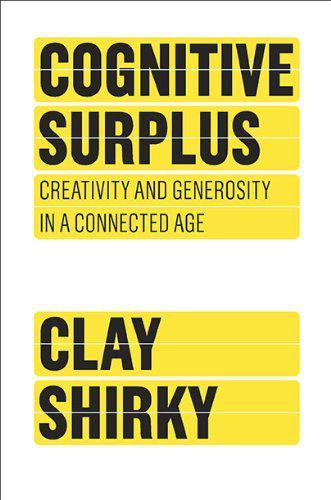
Cognitive Surplus: Creativity and Generosity in a Connected Age
by
Clay Shirky
Published 9 Jun 2010
The mystery isn’t why older people started e-mailing each other; the mystery is how we could have convinced ourselves that e-mail use was mainly about technological novelty rather than social continuity. Given the right opportunities, humans will start behaving in new ways. We will also stop behaving in annoying old ways, even if we’ve always tolerated those annoying behaviors in the past. At the 2006 Burning Man, an annual cultural festival in the Nevada desert, some energetic techies built a phone booth that could make calls via satellite. They proudly invited their fellow Burners (as attendees are called) to make free phone calls, but few people were able to, because no one could remember any phone numbers, and no one had brought their mobile phones to look them up.
…
See generational difference; senior citizens; young people aggregation of cognitive surplus collaborative participation and coordination and creation and sharing and of free time value and alchemy ALS altruistic punishment amateurs connectedness and coordination and motivation and as producers professionals versus satisfaction and societal cynicism and website design and America Online Amtrak Anderson, Chris Anderson, Philip anime Apache webserver Ariely, Dan Association of Pub-going, Loose and Forward Women audiences autonomy, as personal intrinsic motivation Avenir, Christopher Bacca, Pippa Backflip Ballmer, Steve basic groups BeExtra.org behavior cognitive surplus and deterrence and effects of new media tools and inconvenience and internalized standards and norms of opportunity and satisfaction and self-governance and social networks and technology and value and behavioral economics Behlendorf, Brian Benesch, Christine Benkler, Yochai Berstell, Gerald Bibles Bion, Wilfred Blair, Ian Bokardo weblog Bonaventure, Saint books Boyle, Robert Brides on Tour Bruni, Luigino bulletin boards Burning Man festival Cameron, Judy Care2.com carpooling Carr, Nicholas Cassiopeia Catholic church chaos cheating chemistry Christakis, Nicholas civic engagement civic sharing civic value Clarke, Julie CNN.com cognitive surplus aggregation of civic value and communal versus civic value and connectedness and experimentation and free time and generous, public, and social behaviors and harnessing with new media tools market experience and participation and PickupPal and programmers’ use of public and civic value and scale and voluntary contributions and collaborative participation Apache software and competition and development of ideas and Invisible College and passive participation versus social production and collective action combinability common resource management commons-based peer production communal sharing communal value communications revolutions community advertising and combinability and communities of practice creating culture and of shared interest commuting competency, as personal intrinsic motivation competition complacency connectedness amateurs and cognitive surplus and media and social media and as social motivation value and Consumer Product Safety Improvement Act of 2008 (CPSIA) consumption assumed preference for consumers’ media production making and sharing versus participation versus television and coordination amateurs versus professionals and social media and transportation and Copernicus copies costs of Bibles of books of coordination of copying discovery costs experimentation and of public address of sharing spite and of television viewing CouchSurfing.org creativity aggregation and amateurs versus professionals communally created projects fan fiction and governance of groups and reduced television consumption and satisfaction and social production and See also making and sharing Cross, Penny crowding-out effect culture behavioral norms and community and creation of diversity in groups creating public value and growth phase of social media and Invisible College and Napster and new media tools and norms of online study groups and open source software and participation and participatory culture sharing and social media and social production and Ultimatum Game and value and customer versus product research Dahl, Roald David Foster Foundation day-care centers Deci, Edward defaults Delicious.com democracies Derrick, Jaye deterrence de Tocqueville, Alexis Dictator Game digital folk art digital media coordination and copies and economics of as part of real world sharing and symmetry of digital sharecropping Dong Bang Shin Ki (DBSK) DonorsChoose.org eBay education Eisenstein, Elizabeth e-mail emotions Encyclopedia Britannica Etsy experimentation collaborative participation and falling costs and publication and value and external threats extrinsic motivation Facebook amateurs versus professionals and Association of Pub-going, Loose and Forward Women audience-and-cluster spectrum and Causes application cost of social coordination and creation of online study groups and PickupPal and Responsible Citizens face-to-face contact fairness falsifiability fan fiction FanFiction.net Fanning, Shawn fansubbing networks Farrell, Michael feedback FictionAlley.org fines Firstgiving.com Flickr.com Foray, Dominique Fowler, James Fowles, Jib freedom freeloading free time aggregation of cognitive surplus and creating culture and Deci’s Soma experiment and industrialization and making and sharing and opportunities for combining as social asset television viewing and French Impressionist painters Frey, Bruno Friendster fundamental attribution error Gabriel, Shira garbage pick-up generational difference generosity See also sharing Geocities Gleyre, Charles global availability of information global organization Gneezy, Uri Goette, Lorenz governance collaborative participation and of groups power imbalances and value and Gowing, Nik Granovetter, Mark gratitude Groban, Josh Grobanites Grobanites for Africa Grobanites for Charity groups collaborative participation and creation of civic value and emotional components of external threats and governance of group/individual desires internal threats and postpartum support groups study groups Groznic, Larry Gui, Marco Gutenberg, Johannes Gutenberg economics Güth, Werner Haifa, Israel Hallisey, Kelly Hank, the Angry Drunken Dwarf happiness HarryPotterFanFiction.com health-care system Here Comes Everybody (Shirky) Hersman, Erik Hickey, Dave Hill, Dan hobbies Hugenberg, Kurt IBM ICanHasCheezburger.com Idealist.org incomplete contracts inconvenience indulgences industrialization internalized standards internal threats internet accessibility and aggregation and opportunities and post-Gutenberg economics and See also digital media; new media tools; social media intimacy intrinsic motivation amateurism and autonomy as competency as connectedness as creating culture and Deci’s Soma puzzle experiment and extrinsic motivation versus generosity as gratitude as launching new social media and membership as opportunity and payment and private action and public action and social media and Invisible College Ito, Mimi JavaRanch JoshGroban.com Josh Groban Foundation Kahle, Brewster Kahneman, Daniel Kamen, Dean Kamiya, Gary Karatas, Murat Keen, Andrew Kelly, Kevin Kenya Kenyan Pundit blog Kingston, Maxine Hong Kiva.org KOAM.com Kobia, David Lahore, Pakistan Leadbeater, Charlie Lee Myung-bak Lenin, Vladimir Linux operating system lolcats London, England looky-loos Lou Gehrig’s disease Luther, Martin mailing lists making and sharing broadcast media versus social media consumption versus free time and lolcat images and motivation for wider distribution of See also social production Mangalore, India markets communal sharing versus crash of 1987, emotional components of transactions motivation and selfishness and Ultimatum Game and value and Markus, Megan McEwan, Melissa McHenry, Robert McWilliams, Andrew media balanced versus unbalanced changes in landscape of connectedness and cultural diversity and definitions of fluidity of fusion of public/personal media interactivity versus consumption as means of sharing South Korean beef protests and stability of See also digital media; new media tools; professional media makers; social media; television medical information Meetup.com membership amateur design and PatientsLikeMe.com and as social motivation Ultimatum Game and value and Merton, Georgia Microsoft Minow, Newton Mirzoeff, Nicholas misogyny mobile phones Amtrak’s quiet cars and cameras and global interconnection and memorizing phone numbers and Twitter Ushahidi and morality Moro, Silvia motivations amateurs and authority and creating public value and crowding-out effect fan fiction and focus groups and surveys and making and sharing and market alterations of personal motivations social media and for using free time using new social tools and working for free and See also extrinsic motivation; intrinsic motivation; social motivation music, sharing mutual obligation Napster Nasiff, Henry Joseph Jr.
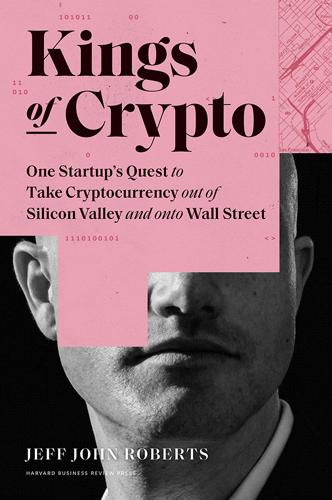
Kings of Crypto: One Startup's Quest to Take Cryptocurrency Out of Silicon Valley and Onto Wall Street
by
Jeff John Roberts
Published 15 Dec 2020
And it was no longer just obscure fro-yo vendors signing up. In a blitz of salesmanship, White also persuaded a series of giants, including Overstock, Expedia, and Dell, to try out cryptocurrency. Not long afterward, he added to the coolness cachet of Coinbase by signing a contract for the company to provide bitcoin services to Burning Man, the drug-fueled techie bacchanalia that takes place in the Nevada desert every August. All of the merchant sign-ups, combined with the roaring consumer market, meant 2014 should have seen Coinbase post-growth results resembling a hockey stick worthy of Wayne Gretzky. It didn’t happen. • • • In early February, a young Frenchman named Mark Karpelès sat in a Tokyo apartment with Tibanne, his orange-and-white tabby cat.
…
Gox Bitcoin Foundation, 54, 55, 56, 58–59 Bitcoin Magazine, 87 bitcoin maximalists, 203 bitcoin meetups, 30 bitcoin Sign Guy, 139 Bitconnect, 141–142 Bitfinex, 108, 114 BitInstant, 54–55, 97, 115–116 Bit License, 127 Bitmain, 171–172 Blankfein, Lloyd, 212 Blockchain, 179 “blockchain not bitcoin” faction, 104–105 Blockchain Revolution (Tapscott and Tapscott), 214, 217 blockchains, 19–21, 24 academic research on, 218–219 block size issues, 152–153 enterprise, 73 future of, 214–220 processing time backlogs in, 83 smart contracts and, 89–95 social engineering for, 21 2.0, 88 block rewards, 21 blocks, 19–20 infrastructure problems with, 75–84 size issues with, 152–153 Bloomberg, 179 Bloomberg Businessweek, 49, 112 Brave, 136 Bridges, Shaun, 59–60 Brooks, Brian, 224 Buffett, Warren, 171 Burges, Kolin, 56 Burnham, Brad, 36 Burning Man, 55 Business Insider, 195–196 Buterin, Vitalik, 48, 87–88, 90, 92, 182 cult of personality around, 202 profile of, 167–168 social media scams using, 143 Byrne, Preston, 206 Cantor Fitzgerald, 101–103 capital gains rules, 122–126 cap tables, 215 Carlson-Wee, Olaf, 24–30 on bitcoin valuation, 62 on Coinbase’s complacency, 177–178 on the crypto bubble, 148 in the crypto winter, 172 on dApps, 188 departure from Coinbase, 95–96, 157 hedge fund of, 223 on hiring, 38–39 legacy of, 220 on Mt.

The Innovation Illusion: How So Little Is Created by So Many Working So Hard
by
Fredrik Erixon
and
Bjorn Weigel
Published 3 Oct 2016
Capitalism did not conquer just because it raised living standards and gave us products like automobiles, refrigerators, and color television. Its winning formula was that it made space for eccentric individuals with unconventional ideas. Other economic systems have failed because they were intolerant to dissent and treated nonconformity as a vice. The deserts of the Siberian tundra, for instance, never had a Burning Man festival like the annual gathering in Nevada’s Black Rock Desert, which draws more than 60,000 techies, entrepreneurs, and others for a celebration of creativity, ingenuity, and self-expression. Without such freedom, investment, innovation, and experimentation cannot thrive. Capitalism, argues the erudite economist Deirdre McCloskey in a series of books on the bourgeois society, lived off individual dignity and virtuous behavior, but also helped their profusion.43 Capitalism’s political history certainly has dark moments of war and oppression.
…
Chance character (i), (ii) Belgium profit margins (i) taxi services and regulation (i) Bell, Alexander Graham (i), (ii) Bell Labs (AT&T) (i) Bellamy, Edward (i) Bellman, Richard (i) benchmarking (i), (ii) benefits, and incomes (i) Benz, Karl (i) Bergman, Ingmar (i) Berkshire Hathaway (i) Berle, Adolf (i) Berra, Yogi (i) Bezos, Jeff (i) Bhide, Amar (i) big firms big firm market dominance (i) and investment allocation for innovation (i) and private standards (i) relative importance of in European countries (i) reputation of (i) see also firm boundaries; firms; multinational (global) companies “big swinging dicks” (i) big-data business models (i) biofuels and EU regulation (i) see also energy sector biotechnological sector, and EU regulation (i) Bismarck, Otto von (i) bitcoin (i) BlackBerry (i) blackboard economics (i) Blackrock (i) blockchain (mutual distributed ledger) technology (i) Blue Ribbon Commission (US) (i) The Blues Brothers (movie) (i) boom and bust cycles (i), (ii), (iii) boomer (or baby boomer) generation (i), (ii), (iii), (iv) Boston Consulting Group index of complicatedness (i) on performance imperatives (i) on working time of managing teams (i) branding (i), (ii) Brazil and BRIC concept (i), (ii) taxi services and regulation (i) BRIC as a Bloody Ridiculous Investment Concept (i) countries (Brazil, India, Russia, and China) (i), (ii) Bridgewater (i) Brin, Sergey (i) Britain see United Kingdom (UK) British managerialism (i) Brockovich, Erin (i) Brookings (i) Brown, Gordon (i) Brynjolfsson, Erik, The Second Machine Age (Brynjolfsson and McAfee) (i), (ii) budget process, and compliance officers (i) Buffett, Warren (i), (ii) bureaucracy and capitalism (i), (ii) and competition (i) and compliance officers (i) and globalization (i), (ii), (iii), (iv) and IBM (i) and index of complicatedness (Boston Consulting Group) (i) and Indian economy (i) and managerialism (i), (ii), (iii) and organizational diversification (i) and principal–agent debate (i) and socialism (i) see also bureaucracy brake; bureaucrats; corporate managerialism; managerialism bureaucracy brake, and regulation (Germany) (i) bureaucrats vs. entrepreneurs (i), (ii) see also bureaucracy; bureaucracy brake Burning Man festival (Nevada) (i) Burns, Scott, The Clash of Generations (Kotlikoff and Burns) (i) business-building skills, vs. financial skills (i) business cycles, and productivity (i) business development, and strategy (i), (ii) business information technology (IT) services (i) business investment and cash hoarding (i) and corporate net lending (i), (ii) declining trend (i) explanations for decline (i) and financial regulation (i), (ii) and gray capitalism (i) investment allocation for innovation and big firms (i) low investment growth vs. fast corporate borrowing growth (i) measuring issues (i) and mergers and acquisitions (i) and policy uncertainty (i), (ii) and shareholders (i), (ii), (iii) UK business investment (i), (ii) US business investment (i), (ii) see also asset managers; investment; R&D business management (i), (ii) see also corporate managerialism business productivity growth (i) Business Week, on Peter Drucker (i) CAC 40 index (France) (i) cadmium (i), (ii) Canada diffusion of innovations (i) GDP figures (i) North American Free Trade Agreement (i) cancer research, and innovation (i), (ii) capital accumulation, and capitalism (i) capital expenditure (capex) (i), (ii), (iii), (iv)n39 capital markets (external) (i), (ii), (iii), (iv), (v) capitalism and agency (i) and asset bubbles (i) and bureaucracy (i), (ii) and capital accumulation (i) “complex by design” capitalism (i) criticism of Western capitalism (i) crony capitalism (i) death of capitalism utopia and socialism (i) decline of Western capitalism (i) and digital age (i) and dissent (i), (ii), (iii) and eccentricity (i), (ii), (iii), (iv), (v) and economic dynamism (i), (ii), (iii) and Enlightenment (i), (ii) and entrepreneurship (i), (ii) financial capitalism (i), (ii), (iii), (iv) free-market capitalism (i) and individual freedom (i), (ii), (iii) and innovation (i), (ii), (iii), (iv), (v) joint-stock capitalism (i), (ii) and labor vs. work (i) vs. the market (i), (ii) Marxist monopolistic theory of (i) “middle-aged” capitalism (i), (ii), (iii) “money manager capitalism” (Hyman Minsky) (i) and organization (i) and planning machines (i) rentier capitalism (i), (ii), (iii), (iv), (v), (vi) and Swedish hybrid economy (i) and technology (i) see also capitalist ownership; corporate managerialism; entrepreneurs; entrepreneurship; the future (and how to prevent it); globalization; gray capitalism; regulation; rich people capitalist ownership and corporate globalism (i) and diversification (i) and gray capitalism: case of Harley-Davidson Motor Company (HD) (i); decline/obituary of capitalist ownership (i); dispersed ownership (i); gray ownership (i), (ii), (iii), (iv), (v), (vi); severing gray capital–corporate ownership link (i) ownership structure reforms (i) and pensions (i) and principal–agent problem (i) and uncertainty (i) car industry car sales and regulation (i) driverless vehicles (i), (ii), (iii), (iv) German car production and value chains (i) lean production (i) US environment-related regulations (i) Carew, Diana G.
…
(i) Taleb, Nassim Nicholas, “Soviet–Harvard illusion” (The Black Swan) (i) tax havens (i) taxes and debt vs. equity financing (i), (ii) and labor (i) and policy uncertainty (i) in Sweden (i) taxi services and driverless cars debate (i) and regulation (i) tech entrepreneurs (i) tech incubators (i) technofeudal society (i) technological platforms, and regulation (i) technological singularity (i) technological unemployment (i), (ii) technology and capitalism (i) dystopian visions of (i) and economy (i), (ii), (iii) and employment (i) and French dirigisme (i) and innovation success (i), (ii), (iii), (iv) and “scientific civilization” thinking (i) technology angst vs. technology frustration (i) technology blitz theory (i), (ii), (iii), (iv) and vertical specialization (i) see also artificial intelligence; automation; diffusion; innovation; New Machine Age thesis; robotics/robots technostructure (i), (ii), (iii), (iv) telecommunications and deregulation (i) and globalization (i) and investment (i) see also Ericsson telephone (i), (ii) see also mobile phones/technology; smartphones Teles, Steven (i) Teller, Astro (i) 1066 and All That (Sellar and Yeatman) (i) Tesla (i) Texas, Special/Permanent School Fund (i) TFP (total factor productivity) growth (i), (ii), (iii) Thiel, Peter (i), (ii) Thomson, George (i) Tiberius (i) Time magazine, “The Committee to Save the World” (i) TNT, attempted acquisition of by UPS (i) total factor productivity (TFP) growth (i), (ii), (iii) Toynbee, Arnold (i), (ii) trade interfirm vs. intrafirm trade (i) see also global trade; mercantilism; protectionism transaction costs (i), (ii), (iii), (iv), (v), (vi) transmission costs (i), (ii), (iii) transparency Linaburg Maduell Transparency Index (LMTI) (i) and regulation (i), (ii) and sovereign wealth funds (i), (ii) Transparency International (i) “triple helix” models (i) “triple revolution” (i) trucking industry (US), shortages of drivers (i) Trump, Donald (i), (ii) Tufts Center for the Study of Drug Development (i), (ii) Tullock, Gordon (i) Twitter, and Nobel Peace Prize (i) Uber (i), (ii), (iii) unbundling of production first (i) second (i), (ii), (iii), (iv) uncertainty and compliance officers (i), (ii) and entrepreneurship (i) and financial regulation (i) and globalist worldview (i), (ii) market uncertainty (i), (ii) policy uncertainty (i), (ii) and probabilistic approach (i), (ii) and risk (i), (ii) and strategy (i) see also predictability; regulatory complexity/uncertainty; volatility unemployment and decoupling (productivity/wages) thesis (i) and Great Recession (i) and New Machine Age hype (i) and productivity (i) technological unemployment (i), (ii) see also labor unicorns (firms) (i) United Kingdom (UK) “boom and bust” and Gordon Brown (i) business investment: declining trend (i); as a proportion of GDP (i) corporate net lending (i), (ii) corporate profit margins (1948–2014) (i), (ii) dependence on larger enterprises (i) EU Leave campaign and older generation (i) exports to China (i) financialization of real economy (i) and globalization (i), (ii), (iii) income inequality and generations (i) “Independent Review of UK Economic Statistics” (Charles Bean) (i) London Stock Exchange and sovereign wealth funds (i) managerialism (i) Middle Ages economy (i) pension deficits (i) pensioners vs. working-age households incomes (i) productivity and incomes (i) productivity puzzle (i) R&D spending (i) retirement savings (i) United States (US) academia and speech codes (i) American Financial Stability Oversight Council (i) banks: and compliance officers (i); and financial regulations (i) Blue Ribbon Commission (i) Burning Man festival (Nevada) (i) capital expenditure (capex) (i)n39 car industry: driverless cars (i); and environment-related regulations (i); and lean production (i) Code of Federal Regulations (i) Consumer Protection Act (i) corporate cash hoarding (i) corporate net lending (i), (ii) corporate profit margins (1948–2014) (i), (ii) corporate renewal levels (i) corporate retained earnings figures (i) corporations’ decline (1980s) (i) debt vs. equity (i) diffusion of innovations (i) dockers and containerization (i) Dodd–Frank Act (i), (ii), (iii), (iv) Energy Policy and Conservation Act (EPCA) (i) Federal Register (i) Federal Reserve (i) financial governance (1990s) (i) financialization of real economy (i) firm entry-and-exit rates (i), (ii), (iii) Food and Drug Administration (FDA) (i), (ii), (iii) GDP figures (i), (ii) and globalization (i), (ii), (iii) high-tech sector (i) Inc 500 ranking (i) incomes: and benefits (i); inequality and generations (i); inequality and productivity (i); and productivity (i), (ii), (iii), (iv), (v) information and communications technology: hardware investment as share of GDP (i), (ii); intensity and productivity (i); sector (i), (ii) investment: business investment declining trend (i), (ii); corporate borrowing and low investment levels (i); corporate investment and shareholders (i), (ii); institutional investors (i); private investment (i) labor: ATMs and teller jobs (i); farming occupation statistics (i); job creation and destruction trends (i), (ii), (iii); labor market flexibility, low rates of (i); occupational licenses (i), (ii); staff turnover rates (i); truck drivers, shortages of (i) market concentration (1997–2012) (i), (ii) Memphis International Airport and FedEx hub (i) mergers and acquisitions (i) New York Stock Exchange (i), (ii), (iii), (iv), (v) North American Free Trade Agreement (i) Organization Man (i) pessimism and capitalist decline (i) policy uncertainty (i), (ii) productivity: downward trend (i), (ii), (iii); via foreign operations (i)n46; and ICT intensity (i); and income inequality (i); and incomes (i), (ii), (iii), (iv), (v); total factor productivity (TFP) growth (i), (ii)n11; and un/employment (i) profit margins (i) public debt (i) public pensions (i) R&D spending (i), (ii), (iii) regulation/deregulation: air cargo services deregulation (i); car industry and environment-related regulations (i); Code of Federal Regulations (i); compliance officers and Dodd–Frank rules (i); drone aircraft rules (i); green building codes (i); index of regulatory freedom (i), (ii); index of regulatory trade barriers (i), (ii); medical devices (i); taxi services (i), (ii) retirement savings (i) robots, fear of (i) Silicon Valley (i), (ii), (iii) start-ups and entrepreneurship (i), (ii) stock market crash and modern portfolio theory (i) subprime mortgage crisis (i) subsidies to firms (i) Texas Special/Permanent School Fund (i) trade: and big business (i); index of regulatory trade barriers (i), (ii) Wall Street (i), (ii), (iii), (iv) universities, and erosion of dissent (i) University of Chicago (i) University of Oxford, Future of Humanity Institute (i) UPS, attempted acquisition of TNT (i) urbanization, and diffusion of innovations (i) value vs. numbers (i) value innovation (i) value chains fragmentation of (i), (ii), (iii) and German corporations (i) globalization of (i), (ii) and market concentration (i) marketization of (i) and outsourcing of supply chains (i) “slicing up” of (i), (ii) and specialization (i), (ii) see also supply chains Van Reenen, John (i) Vanguard Group (i) Vernon, John A.
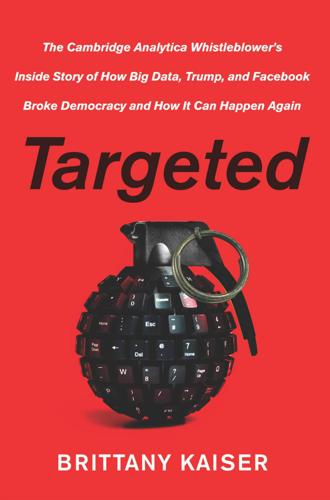
Targeted: The Cambridge Analytica Whistleblower's Inside Story of How Big Data, Trump, and Facebook Broke Democracy and How It Can Happen Again
by
Brittany Kaiser
Published 21 Oct 2019
I was supposed to be back in Mexico City in time for the meeting on Tuesday morning with Alexander, but it was a long weekend, with the Monday a federal holiday in the States, and no passport office would be open until Tuesday morning. I wouldn’t be able to get the replacement travel documents in time to fly back to Mexico City for the meeting. It didn’t help that my vacation had been at Burning Man. I had never been to anything like it. Begun as a summer solstice event in San Francisco in the late ’80s, Burning Man had since grown into a global phenomenon in which tens of thousands of people came together to form a massive, idealistic, money-free impromptu “city” of tents and campers. The celebration went on for a week and culminated in the torching of a forty-foot-tall effigy made of wood.
…
The experience of participating in a society that reimagined an ethical way for people to interact with each other was so transformational that many “Burners” tend to call it home. Alexander would never understand. I was shaking when I called to tell him what had happened. He was still in London, and he fumed. The fact that I had been at Burning Man, something he saw as “frivolous,” and that I had been so thoughtless as to misplace my passport, made him even angrier. I had been irresponsible, he said, childish and selfish. When we finally met up on Wednesday morning in the Polanco office, he had already met, unsuccessfully, with Peña Nieto and Slim—the day before, and this had further enraged him.
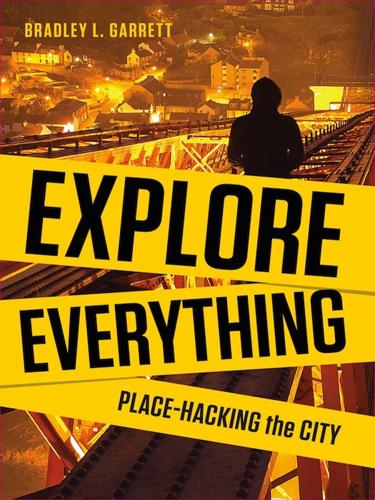
Explore Everything
by
Bradley Garrett
Published 7 Oct 2013
These groups were (and are) known as the Drainiacs and the Cave Clan in Australia; Diggers of the Underground Planet in Russia; Ars Subterranea, Jinx Crew and LTV Squad in New York City; the Cacophony Society in San Francisco; the Action Squad in Minneapolis; Angels of the Underground in Canada; the Berlin Underground Association in Germany; and various cataphile groups in Paris, including UX.33 Interestingly, the Cacophony Society was a spin-off of the San Francisco Suicide Club, founded in 1977. Founding member John Law later helped established the Burning Man festival in Nevada’s Black Rock Desert, which now attracts ten of thousands of visitors each year.34 The first recorded internet-facilitated large-scale urban explorer meet-up was attended by about thirty individuals in Brooklyn in 2002. It was organised by the LTV Squad, a graffiti group turned urban-explorer crew, and was followed by an even larger meet-up in Toronto in June 2004, where sixty-five people gathered to go exploring together.
…
Brick, Subterranean Twin Cities (Minneapolis, MN: University of Minnesota Press, 2009). 26 John Hollingshead, Underground London (London: Kessinger, 2009 [1862]); Charles Dickens, All the Year Round (London, 1861). 27 Whipplesnaith, The Night Climbers of Cambridge (Cambridge: Oleander Press, 2007 [1937]). 28 See Tom Whipple, ‘Confessions of a Night Climber’, Times, 2 November 2007. 29 Tom Wells, ‘Deck the Halls with, er, 150ft-high Santa Hats’, Sun, 4 December 2009. 30 Patrick Sawer, ‘Cambridge University’s 1958 Car on Roof Prank Secrets Revealed’, Telegraph, 28 June 2008. 31 Jon Lackman, ‘The New French Hacker-Artist Underground’, Wired, 20 January 2012. 32 Steven Jones, The Tribes of Burning Man: How an Experimental City in the Desert Is Shaping the New American Counterculture (San Francisco: CCC Publishing, 2011). 33 Geoff Manaugh, The Bldg Blog Book (San Francisco: Chronicle, 2009). 34 D. Wershler-Henry, ‘Urban Life: Usufruct in the City’, Globe and Mail (2005), quoted in Steven High and David W.

I Hate the Internet: A Novel
by
Jarett Kobek
Published 3 Nov 2016
Google X was the pointless indulgence of one of the world’s richest men. It was Sergey Brin’s hobby. It was his awkward way of picking up chicks. It was the absolute heights of decadence. In any practical sense, Sergey Brin had left Google. He was a middle-aged party boy with weird mistresses and a habit of going to Burning Man every August. Burning Man was a big party in the desert where Sergey Brin would pretend like money didn’t matter and that he wasn’t a capitalist. He would surround himself with younger naked people who were high on drugs and dressed like low-rent circus performers and who were simply thrilled to be around someone famous.
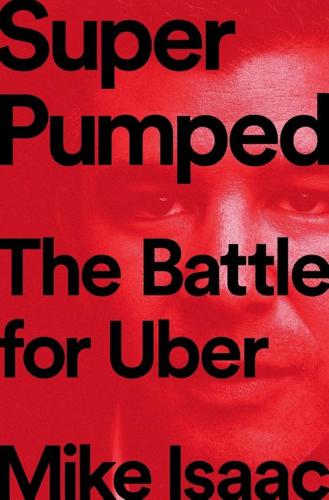
Super Pumped: The Battle for Uber
by
Mike Isaac
Published 2 Sep 2019
As he grew further from his Canadian roots and became a Californian, Camp grew his hair past his shoulders, affecting a kind of neo-hippie vibe. He looked as if he’d be just as comfortable hanging out with a surfboard in Long Beach as he would hunched in front of a MacBook Pro at the Creamery. Camp later became an annual regular at Burning Man, the weeks long off-grid bacchanal in the Nevada desert attended by thousands of techies and hippies from all across the West Coast. StumbleUpon was his claim to fame, a kind of early social network conceived back when he was in college in Calgary, long before the rise of Facebook. The site was perfect for the days of the desktop web; StumbleUpon flicked users between different websites at random, promising to offer surprising and delightful suggestions for users to “stumble upon” and enjoy.
…
A good founder lives and breathes the startup. As Mark Zuckerberg said, a founder moves fast and breaks things. The founder embraces the spirit of “the hacker way”; he is captain of the pirate ship. A good founder will work harder tomorrow than he did today. A good founder will sleep when he is dead (or after returning from a week at Burning Man). Like Kalanick at Red Swoosh, a good founder shepherds his company through difficult funding environments, but chooses his benefactors wisely. A good founder takes credit for his company’s successes, and faces the blame for its shortcomings. A good idea for a company, even if it lands at the right time and in the right place, is still only as good as the founder who runs it.
…
See also specific countries AT&T, 59, 92 Atwood, Renee, 135 August Capital, 31 Austin, Texas, 115, 116 Axis Theater, 10–15 Babbage, 39 Baker, Ed, 137, 174, 254 Baldwin, Alec, 90 Bangalore, India, 148 Bannon, Steve, 207 Bar Crudo, 78 Barrett, David, 49 BART (Bay Area Rapid Transit), 41 Bass, Robert, 277 the Battery, 4 BD, Akshay, 148 Beijing, China, 142 Benchmark Capital, 14, 40, 65, 70, 78–80, 282–86, 311–17, 320, 323, 324–26, 335 attempts to find Kalanick’s replacement and, 314–16 Grand Bargain and, 326–27 plan to force Kalanick’s hand, 289–91, 292–306 Benioff, Marc, 201 Benton, Dan, 67 Best Buy, 39 Beyoncé, 7–8 Bezos, Jeff, 11, 13, 35, 54, 69, 140, 231n, 332 Biewald, Lukas, 49 Big Tech, 201 Bigwords.com, 26 BlackBerry, 36 “Black Gold,” 139 Bloomberg Businessweek, 121 Bloomberg News, 237, 254, 256 Blue Bottle, 98 Bob, 241, 242, 243, 244, 246 Bonderman, David, 101, 202, 255, 270, 272, 274, 276–84, 296, 321 Booker, Cory, 179 Brazil, 174 Brin, Sergey, 34, 54, 76–77, 96, 100, 121, 140, 176, 177, 178, 179, 180 Brown, Mike, 150n Buffett, Warren, 76–77 Burkle, Ron, 23 Burner, 146 Burning Man, 42 Burns, Ursula, 327 Bush, George W., 229 Bush, Sophia, 193 Bush administration, 33 BuzzFeed, 127n, 128–31, 129n, 156 BuzzFeed News, 128–31 Cabulous, 78 Caldbeck, Justin, 285 California, 168. See also specific cities transit authorities in, 254–55 Callinicos, Brent, 122–24, 278 Cambridge, England, 228 Cambridge Analytica, 200 Camp, Garrett, 56–58, 60, 64, 101, 270–72, 287–88, 301, 313, 324, 341 allegiance to Kalanick, 97, 270–72, 287–88, 301 fixation on branding, 58 founder’s challenge and, 53–54 on Uber’s board, 79–80 vision for Uber, 40, 41–45, 48–50, 85 Campbell, Harry, 248 Carlisle, Doug, 293 Carnegie Mellon University, 184 Carolan, Shawn, 192, 288, 293, 301–2 Carr, Paul, 119, 129 Carter, Graydon, 126, 163n Carter, Shawn, 54, 194.
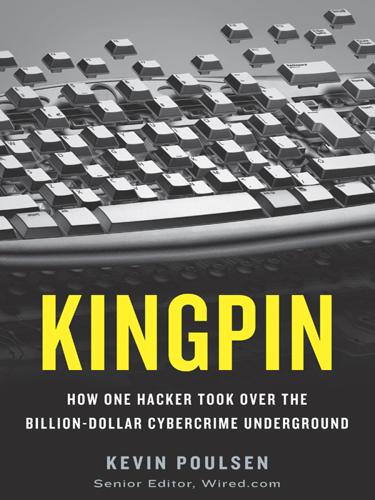
Kingpin: How One Hacker Took Over the Billion-Dollar Cybercrime Underground
by
Kevin Poulsen
Published 22 Feb 2011
The motherboard on Max’s server had burst into flames. Max tried to calm her—all she had to do was replace the motherboard. He could do it in his sleep. Max talked her through the process, but Kimi was realizing she wasn’t cut out for life as the prison wife of a hacker. In August, she went to the Burning Man festival in Nevada to forget her troubles. When she got home, she broke some bad news to Max over the phone. She’d met someone else. It was another betrayal. Max took the news with eerie calm, interrogating her about every detail: What drugs was she on when she cheated on him? What sexual positions did they use?
…
After five months, Norminton and his schemes were sent home to sunny Orange County, California, while Max remained at Taft with another year left on his sentence—long, tedious days of bad food, standing for count, and the sound of chains and keys. In August 2002, Max was granted early release to a sixty-one-bed halfway house in Oakland, where he shared a room with five other ex-cons. Kimi met with Max to present him with divorce papers. She was getting serious with the guy she’d met at Burning Man; it was time, she said, for Max to let her go. Max refused to sign. Max’s relative freedom at the halfway house was tenuous—the facility demanded that he obtain gainful employment or go back to prison, and telecommuting wasn’t allowed. He reached out to his old contacts in Silicon Valley and found his employability had been shattered by his high-profile hacking conviction and over a year in prison.

Exponential Organizations: Why New Organizations Are Ten Times Better, Faster, and Cheaper Than Yours (And What to Do About It)
by
Salim Ismail
and
Yuri van Geest
Published 17 Oct 2014
You need strong leadership to manage the community, because although there are no employees, people still have responsibilities and need to be held accountable for their performances. Typically, there are three steps to building a community around an ExO: Use the MTP to attract and engage early members. The MTP serves as a gravitational force that attracts constituents into its orbit. Tesla, Burning Man, TED, Singularity University and GitHub are good examples of communities whose members share common passions. Nurture the community. Anderson spends three hours every morning attending to the DIY Drones community. Elements of nurturing include listening and giving back. DIY Drones blueprints were open sourced and available from day one, which was fine, but it turned out that the members really wanted DIY Drone Kits.
…
Airbnb hosts and users fill out evaluation forms; taxi disrupters Uber, Lyft and Sidecar encourage clients and drivers to rate one another; and the news platform Reddit invites users to vote on stories. In 2013, Reddit, which has just fifty-one employees, most of whom manage the platform, saw 731 million unique visitors cast 6.7 billion votes on 41 million stories. Talk about a platform…(More on this later.) Tony Hsieh, CEO of Las Vegas-based Zappos, was inspired by the Burning Man community to combine both physical and trait-based communities within his Las Vegas Downtown Project. The project combines work and play in an urban landscape with homes, infrastructure, hacker spaces, shops, cafe/theater and art. In addition to the goal of helping to transform the downtown area into the most community-focused large city in the world, Hsieh aims to create the smartest place on the planet by maximizing the chances of serendipitous learning between Zappos insiders and outsiders.
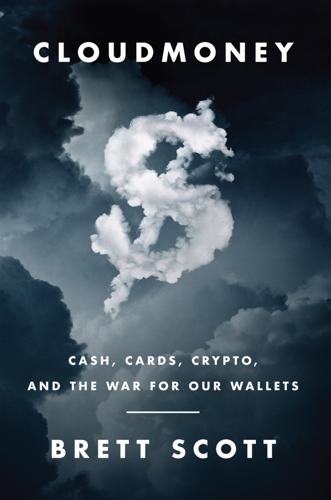
Cloudmoney: Cash, Cards, Crypto, and the War for Our Wallets
by
Brett Scott
Published 4 Jul 2022
Cash also blocks an enormous amount of data from falling into corporate hands, and data – as all of us should know by now – is a hot commodity. 6 Big Brother. Big Bouncer. Big Butler I first met Tyler Hansen at Symbiosis Gathering, a hippie festival in Oakdale, California, where I was co-running a space for hackers, artists and activists called the Hacktivist Village. Tyler was a classic ‘burner’ – a veteran of the legendary Burning Man festival – and had come to my rescue in Oakdale when our amateurish hand-built stage was on the verge of collapsing in the hot Californian gales. I thought I would never see him again, but two weeks later I was strolling down Sunset Boulevard in Los Angeles and walked straight into him. Over a drink, he told me about the problems confronting the marijuana industry.
…
Aadhar system, 44, 97, 169 abacuses, 159 ‘Abracadabra’, 50 accelerators, 17 active choice, 125 Acxiom, 109 Adventures of a Banknote, The (Bridges), 65 Aesop, 45–6 AirBnB, 150 Alameda, California, 102 alcohol, 102, 118, 170 Alexa, 147, 150 Alibaba, 2, 7, 114, 150, 178 Alipay, 114 Alphabet, see Google alt-coins, 13, 217–18 Althusser, Louis, 86 Amazon, 1, 2, 7, 133, 147, 149, 150, 174, 177, 249–50 Alexa, 147, 150 anti-cash lobbying, 41–2, 254 CBDCs and, 243, 244 Coin, 236 Pay, 150 Amazon region, 130, 176, 247, 249 American Revolutionary War (1775–83), 60 Ames Research Center, 153 Amnesty International, 222 Amsterdam, Netherlands, 128–9 Amy, 147 anarchism, 7, 14, 106, 183, 191, 193, 215 anarcho-capitalism, 14, 184 Andes, 96, 129 anthropology, 124 anti-feminism, 226 anti-Semitism, 225, 262 anti-statism, 42, 184, 215–16 antidotes, 52–4 Apollo 11 mission (1969), 153 Apple, 7, 125 apps and, 141 Card, 150 data, 108 Pay, 78, 125, 130 Super Bowl advert (1984), 8 apps, 1, 2, 7, 17, 27, 40, 125, 139–51, 232 data collection, 165–6 interfaces, 139–51 ArcelorMittal, 24 Aria, 169 Armer, Paul, 105–6 Art of Not Being Governed, The (Scott), 228 artificial intelligence (AI), 8, 11, 17, 108, 114, 147, 153–72, 175, 252 biases, 167 credit-scoring, 17, 160, 162–3, 167, 168, 170 data analysis, 108, 153–72 interfaces, 146–8 Asimov, Isaac, 161, 170 Assange, Julian, 183 Assemblage, New York City, 226 Astana, Kazakhstan, 227–9 Athens, Greece, 131 ATMs (automatic teller machines), 32, 34, 35, 36, 39, 48, 61, 62, 248 CIT industry, 62 closure of, 32, 39, 48, 83, 84, 85, 132 crises and, 36, 244 note denominations, 62 profitability, 39 Atwood, Margaret, 117 austerity, 193 Australia, 118 Austria, 7, 109 authoritarianism, 111, 118, 168 automatic payments, 149 automation, 9, 10, 33, 41–2, 99, 123, 126, 133, 137, 142–3, 232 apps, 139–51, 232 artificial intelligence, 153–72 automation of, 153–4 surveillance, 112, 114, 153–72 aviaries, 171 Azure cloud, 233 Back to the Future (1985 film), 198 Baidu, 7, 178 Bangladesh, 32 Bank for International Settlements, 79 Bank Identification Codes (BIC), 76 Bank of America, 38, 75, 147 Bank of England, 40, 242, 243 banking sector, 38–9, 65–82 accounts, 31, 35, 46, 66, 132, 205–6 artificial intelligence, 153–72 ATMs, see ATMs bailouts, 113 centralisation of power, 15, 180–83 closures of ATMs/branches, 32, 39, 48, 83, 84, 85, 132 cloudmoney, 64, 66–82 data, 108–9, 156–7 deposits, 66–7, 69 electronic trading platforms, 158 exiting, 39, 48, 61, 63, 68, 83 federated frontline, 136–8, 147 high-street banks, 39–40, 158 interbank markets, 138, 231 interfaces, 138–51 international transfers, 74–6, 108, 179 Internet banking, 76–7, 139 investment banks, 6, 17, 22–3, 26, 113, 157–8 loans, 70–71, 107, 159 money creation, 59–63, 67–72, 202 operating system, 141–2 secondary system, 50, 63–4 sub-currencies, 72–3 transfers, 72–8 banknotes, 59–63 cash-in-transit companies, 62 counterfeiting of, 60–61 denominations, 62 polymer, 65 Bannon, Steve, 225, 234 Barclays, 38, 72–3, 116 base money, 69 beggars, 115 Better Than Cash Alliance, 34–5, 37, 45, 93, 96, 131 biases, 167 bicycles, 89, 90 Big Bouncers, 114, 170 Big Brother, 113–15 Big Butlers, 114, 170–71 Bill & Melinda Gates Foundation, 44–5 biometrics, 44, 150, 169 biotechnology, 10, 11 Bitcoin, 13–15, 16, 184–5, 187–210, 211–18 blockchain technology, 13–15, 185, 189–90, 195, 197–202 Cash fork (2017), 214, 217 climate change and, 226 as commodity, 206–10, 213–14, 217, 246, 256 countertradability, 209–10, 213, 256–7 decentralisation, 14, 15, 189–94, 196, 258 fixed supply, 191–3, 206 gold comparison, 192–3, 207, 214 millenarianism and, 212, 213 mining, 203–4, 212–13 politics and, 191–3, 211–12, 215–17 proof-of-work, 203–4 public addresses, 194–5 speculation on, 213 syncing, 195–7, 200–202, 231 techno-clerks, 194–5, 196–7, 202–4, 212–13 wallets, 194–5 White Paper (2008), 13, 184–5, 187, 191 Bitcoin Cash, 214–15, 217, 226 Bitcoin Gospel, The (2015 film), 211 Blade Runner 2049 (2017 film), 10 blockchain, 13–15, 185, 189–90, 195, 197–202, 219–26, 258–60 decentralisation, 14, 15, 189–94, 196, 230, 234, 255, 258–60 distributed ledger technology (DLT), 229–46, 258 mutual credit systems and, 260 blood diamonds, 222 Bloomberg, 109 Body of Glass (Piercy), 150 BP, 24, 26, 28 bread-making machine, 164 Bridges, Thomas, 65 British Airways, 29–30 British Bankers Association, 83 Brixton Market, London, 177 Bulgaria, 13 Bundesbank, 35, 47 bureaucracy, 179 Burning Man, 101 busking, 90–91 Buterin, Vitalik, 221, 223 California Ideology, 180 Camberwell, London, 128 Cambridge Symposium on Economic Crime, 111 Cambridge University, 97 Canada, 35 Canary Wharf, London, 17–18, 20, 41, 62, 211 cannabis, 101–3 capitalism, 2, 10, 47, 65, 98–9, 173–4 blockchain and, 15–16, 231–46, 256, 258 charging up, 22–5 core vs. periphery, 28, 248 giant parable, 54–5, 63–4, 188 growth, 123, 126–7, 249 surveillance, 33, 114, 180, 250 carbon credits, 222 CARE, 131 cargo cults, 255–6 Caritas, 131 carnivals, 257 cars, 87–90 cash, 22, 29–48 banking sector and, see banking sector banknotes, 59–63 central banks and, 42–5, 254 crime and, 36, 42–3, 45, 81, 112 crises and, 36, 61 cycle, 63, 68 demonetisations, 43 fintech industry and, 41–2 hoarding, 36 issuance of, 59–63 libertarians and, 215 payments companies and, 39–41 refusal of, 29–30, 40, 41, 43, 84, 128, 133 social class and, 91–9 tax evasion and, 42, 43, 45, 46 thresholds, 42 transactional usage, 36 cash-in-transit companies, 62 ‘cash or card?’
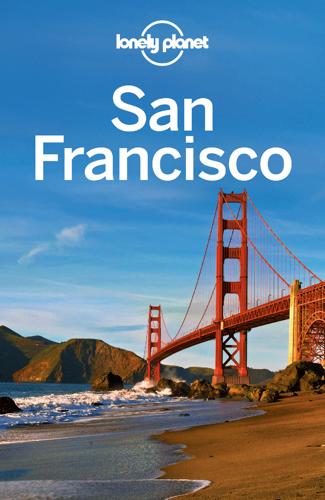
San Francisco
by
Lonely Planet
Britex Fabrics FabricS Offline map Google map (www.britexfabrics.com; 146 Geary St; Mon-Sat; & Powell St; Powell-Mason, Powell-Hyde) No reality design show can compare with the four floors of nonstop fashion drama at Britex. First floor: designers bicker over who gets first dibs on caution-orange chiffon. Second floor: glam rockers dig through a velvet goldmine. Third floor: Hollywood stylists squeal ‘To die for!’ over ’60s Lucite buttons. Top floor: fake fur flies and remnants roll as costumers prepare for Burning Man, Halloween and your average SF weekend. Le Sanctuaire Food, Drink Offline map Google map (www.le-sanctuaire.com; 5th fl, 315 Sutter St; 10:30am-4:30pm Mon-Fri, by appointment; Sutter & Stockton Sts; Powell-Mason & Powell-Hyde) Mad scientists, thrill seekers and professional chefs get buzzed, speakeasy-style (read: appointment only), at this culinary curiosity shop.
…
Quality doesn’t come cheap – expect to pay $10 to $16 a glass – but you can get bargain French takeaway from the Spencer on the Go food truck often parked out front and enjoy it with your wine. Shine Bar, Club Offline map Google map (www.shinesf.com; 1337 Mission St; admission free-$10; 9pm-2am Wed-Sat; Van Ness) Underground house parties erupt at tiny, offbeat Shine, decorated with disco balls and gold fabric wall panels that look like someone’s Burning Man craft project. The DJs are hype for such a small bar, and when the beats heat up, barstools get shoved aside and the whole place becomes a dance floor; check the online calendar. Dig the photo booth, and the tricky bathroom mirror – people primping in the mirror have no idea anyone using the facilities can watch them rub lipstick off their teeth with a finger. 111 Minna Bar, Club Offline map Google map (www.111minnagallery.com; 111 Minna St; admission free-$15; & Montgomery St) A superhero here to rescue the staid Downtown scene, 111 Minna is a street-wise art gallery by day (open from noon to 5pm Wednesday to Saturday) that transforms into a happening lounge space and club by night (evening hours vary).
…
Green Tortoise ( 800-867-8647, 415-956-7500; www.greentortoise.com) Quasi- organized, slow travel on customized, biodiesel-fueled buses with built-in berths that run from San Francisco to points across California and beyond, including Bay Area day tours to Half Moon Bay and Santa Cruz; three-day trips to Yosemite or Death Valley; three-to-five-day jaunts to Burning Man and other festivals; and three-to-seven-day coastal trips south to Monterey, Big Sur and LA. Precita Eyes Mission Mural Tours ( 415-285-2287; www.precitaeyes.org; adult $12-15, child $5; 11am, noon, 1:30pm Sat & Sun) Muralists lead two-hour tours on foot or bike covering 60 to 70 murals in a six to 10 block radius of mural-bedecked Balmy Alley; proceeds fund mural upkeep.
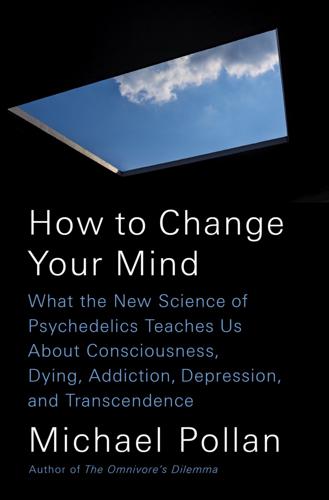
How to Change Your Mind: What the New Science of Psychedelics Teaches Us About Consciousness, Dying, Addiction, Depression, and Transcendence
by
Michael Pollan
Published 30 Apr 2018
On one side was a quartet of tall, slender, curving Psilocybe cubensis, one of the more common species of magic mushroom. On the back was a quotation from William Blake that, it occurred to me later, neatly aligned the way of the scientist with that of the mystic: “The true method of knowledge is experiment.” It seems that the previous summer Roland Griffiths had gone for the first time to Burning Man (had I heard of it?), and when he learned that no money is exchanged in the temporary city, only gifts, he had the mushroom medallions minted so he would have something suitable to give away or trade. Now, he gives the coins to volunteers in the research program as a parting gift. Griffiths had surprised me once again.
…
Brand thinks LSD’s value to his community was as an instigator of creativity, one that first helped bring the power of networked computers to people (via SRI computer visionaries such as Doug Engelbart and the early hacker community), but then was superseded by the computers themselves. (“At a certain point, the drugs weren’t getting any better,” Brand said, “but the computers were.”) After his experience at IFAS, Brand got involved with Ken Kesey and his notorious Acid Tests, which he describes as “a participatory art form that led directly to Burning Man,” the annual gathering of the arts, technology, and psychedelic communities in the Nevada desert. In his view, LSD was a critical ingredient in nourishing the spirit of collaborative experiment, and tolerance of failure, that distinguish the computer culture of the West Coast. “It gave us permission to try weird shit in cahoots with other people.”
…
See also neuroscience of psychedelics Brand, Stewart, 182, 183–85, 359 Brave New World (Huxley), 160 breathwork, 242–44, 245, 245n, 306 Brewer, Judson and expansion/contraction of consciousness, 322, 325 and meditation experiment, 392–95 and quieting of default mode network, 305, 306, 322, 390–91 Bronfman, Jeffrey, 49 Bucke, R. M., 289 Buckley, Lord, 157 Buddhism, 16, 288, 305, 392 Burgess, Tammy, 346 Burning Man, 83, 184 Bush, George, 27, 181 Caen, Herb, 204 California Institute of Integral Studies, 232–33, 402 Canada, 147–50, 171, 198 cancer patient research, 331–58 and authenticity questions, 347–49 and birth experiences, 338–39, 344 common themes in, 344–46 criticisms of research, 350n and death rehearsal process, 346 and fear of death, 8, 79, 336–37, 346–47 and fear/anxiety during treatments, 341, 345 and flight instructions, 338, 341 follow-up study, 351–52 Griffiths’s landmark paper on, 10–11, 29–30 meaning in, 352–55 and mystical experiences, 79, 349, 350–51 at New York University, 332–33, 337–38 origins of, 338–39 and Patrick Mettes, 332, 336, 337–38, 340–44, 346–47, 356–57 and perspective shifts of patients, 339–40 and psycholytic LSD therapy, 159 results of, 349–50 at Spring Grove, 218 treatment rooms in, 331–32 and visions of death, 345–46 volunteers’ accounts of, 351–52 cannabis and marijuana, 36, 37, 138, 138n, 204, 299 Capture: Unraveling the Mystery of Mental Suffering (Kessler), 383 Carhart-Harris, Robin on consciousness-expansion, 322 and depression pilot study, 329–30, 376–81 on disorganizing effect of psychedelics, 314, 314n and effect of psilocybin on brain activity, 300–301 and Feilding, 297, 299 and Gopnik, 323–24 on political effects of psychedelics, 315 on predictive/sensory data, 310–11 psychoanalysis research of, 296–97, 311 on rewiring of brain, 316, 320, 327, 384 on value of psychedelic experiences, 315, 328 See also default mode network (DMN); entropic brain theory carpenter ants, 89, 96–97 CBS News, 57, 113 celebrities on psycholytic LSD therapy, 156–57, 171 Central Intelligence Agency (CIA) and cultural upheaval of the sixties, 206–7 and Hubbard, 166, 171–72 MK-Ultra experiments of, 59, 113n, 172, 172n, 206, 207 and psychotomimetic model, 172 and search for LSD applications, 142, 206 Centre for Psychiatry, Imperial College London, 295–96 Charnay, Amy, 66–67, 73 Chekhov, Anton, 381, 382 children consciousness of, 323–28 and default mode network (DMN), 312, 328 memories from childhood, 222, 307 problem solving in, 325–28 as R&D stage of species, 327 and suppression of entropy, 328 Claviceps purpurea, 84.
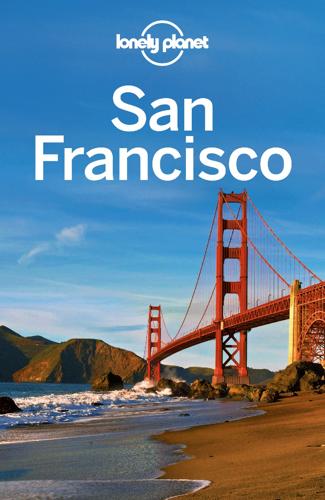
San Francisco
by
Lonely Planet
Britex Fabrics FabricS Offline map Google map (www.britexfabrics.com; 146 Geary St; Mon-Sat; & Powell St; Powell-Mason, Powell-Hyde) No reality design show can compare with the four floors of nonstop fashion drama at Britex. First floor: designers bicker over who gets first dibs on caution-orange chiffon. Second floor: glam rockers dig through a velvet goldmine. Third floor: Hollywood stylists squeal ‘To die for!’ over ’60s Lucite buttons. Top floor: fake fur flies and remnants roll as costumers prepare for Burning Man, Halloween and your average SF weekend. Le Sanctuaire Food, Drink Offline map Google map (www.le-sanctuaire.com; 5th fl, 315 Sutter St; 10:30am-4:30pm Mon-Fri, by appointment; Sutter & Stockton Sts; Powell-Mason & Powell-Hyde) Mad scientists, thrill seekers and professional chefs get buzzed, speakeasy-style (read: appointment only), at this culinary curiosity shop.
…
Quality doesn’t come cheap – expect to pay $10 to $16 a glass – but you can get bargain French takeaway from the Spencer on the Go food truck often parked out front and enjoy it with your wine. Shine Bar, Club Offline map Google map (www.shinesf.com; 1337 Mission St; admission free-$10; 9pm-2am Wed-Sat; Van Ness) Underground house parties erupt at tiny, offbeat Shine, decorated with disco balls and gold fabric wall panels that look like someone’s Burning Man craft project. The DJs are hype for such a small bar, and when the beats heat up, barstools get shoved aside and the whole place becomes a dance floor; check the online calendar. Dig the photo booth, and the tricky bathroom mirror – people primping in the mirror have no idea anyone using the facilities can watch them rub lipstick off their teeth with a finger. 111 Minna Bar, Club Offline map Google map (www.111minnagallery.com; 111 Minna St; admission free-$15; & Montgomery St) A superhero here to rescue the staid Downtown scene, 111 Minna is a street-wise art gallery by day (open from noon to 5pm Wednesday to Saturday) that transforms into a happening lounge space and club by night (evening hours vary).
…
Green Tortoise ( 800-867-8647, 415-956-7500; www.greentortoise.com) Quasi- organized, slow travel on customized, biodiesel-fueled buses with built-in berths that run from San Francisco to points across California and beyond, including Bay Area day tours to Half Moon Bay and Santa Cruz; three-day trips to Yosemite or Death Valley; three-to-five-day jaunts to Burning Man and other festivals; and three-to-seven-day coastal trips south to Monterey, Big Sur and LA. Precita Eyes Mission Mural Tours ( 415-285-2287; www.precitaeyes.org; adult $12-15, child $5; 11am, noon, 1:30pm Sat & Sun) Muralists lead two-hour tours on foot or bike covering 60 to 70 murals in a six to 10 block radius of mural-bedecked Balmy Alley; proceeds fund mural upkeep.
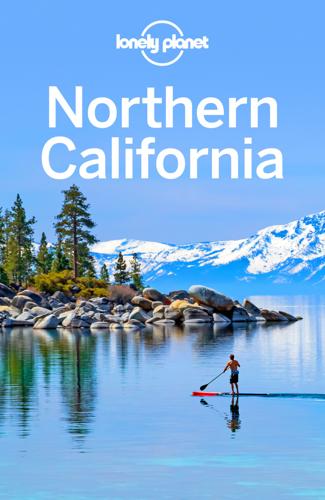
Northern California Travel Guide
by
Lonely Planet
Not for the xenophobic, these festivals are a study in diversity. Hardly Strictly Bluegrass San Francisco’s best free music festival hosts three days of A-list folk, rock, bluegrass and country artists. Reggae on the River In the heart of Humboldt County, this music event is all dreadlocks and Jamaican-influenced jams. Burning Man A trippy art party that also happens to be the world's greatest experiment in culture and community. San Francisco Pride Month The last Sunday in June, a million people descend upon San Francisco to celebrate Gay Pride Day. Bay to Breakers May's zany, costumed Embarcadero to Ocean Beach race; joggers dressed as salmon run upstream.
…
Sonoma Coast State Beach A series of rocky coves and sandy beaches reveal the awesome power of nature. Big Sur This enchanting, rugged stretch of Hwy 1 wins for its cypress trees, rocky cliffs and striking ocean vistas. Month by Month Top Events California State Fair, July North Lake Tahoe SnowFest, March Pride Month, June Mendocino Coast Whale Festivals, March Burning Man, August January Typically California's wettest month. Coastal regions go quiet. The hills turn green. Mountain ski resorts are packed on weekends, quiet on weekdays. Bay Area skies gray. Wine Country a bargain. zChinese New Year San Francisco’s Chinatown (www.sanfranciscochinatown.com/events/chinesenewyearparade.html) sounds like a war zone, as firecrackers announce the lunar new year with parades, lion dancers and street vendors.
…
Wildflowers peak in the High Sierra. 5Strawberry Festival at Monterey Bay The messy marquee event (www.celebratestrawberries.com; hearly Aug) at this Watsonville festival is the pie-eating contest, but live music and tons of fruit keep families entertained. The berries are entirely local: Watsonville produces almost 90% of all the strawberries grown in the US. zBurning Man Although Burning Man (https://burningman.org) happens in Nevada's Black Rock Desert, it began in San Francisco and draws tens of thousands of Northern Californians, who celebrate art's ephemeral nature, radical inclusion, self-reliance and self-expression. No commerce or advertising allowed. Make arrangements way ahead.

The Launch Pad: Inside Y Combinator, Silicon Valley's Most Exclusive School for Startups
by
Randall Stross
Published 4 Sep 2013
We want to change the way people travel by making it super easy and fun to share rides with other people.” The number of rideshare posts on Craigslist—about a thousand are listed at the moment for just the San Francisco Bay Area—provides encouraging evidence of demand. Shen says they will start off with long-distance ridesharing, to the upcoming Burning Man festival in the desert and also between San Francisco and Los Angeles. As the other startups do at the end of their presentations, Shen offers to the batch the expertise of his team’s members: “Kalvin and Randy are developers,” he says, and as for himself, he knows how to stay motivated in the face of rejection.
…
B., 54–55 Brandeis University, 164 Brandery, The, 42 Braveheart, 181 Brezina, Matt, 39 Brightcove, 101, 104 Broadcast.com, 26 Brown, David, 41 Bubinski, Ryan, 124–25, 147–49, 192–93, 194–96, 227 Buchheit, Paul angel investor, 61, 204–5 Dropbox, 225 early career, 203 FriendFeed, 204, 265n8 Google, 61, 63, 203–4 Science Exchange, 171, 175, 176, 180–81 Tagstand, 151, 156–59 YC partner, 63, 150 Buenos Aires, 64 Buffalo, NY, 237 Bugatti Veyron, 101 Burning Man, 121 Busque, Leah, 54 BuySimple, 125 BuySimple/Minno, 105–9 BuzzLabs, 210 C++, 15 Cambridge, MA, 13, 16, 63, 64 Campbell, Brian, 110–17 CampusCred Demo Day, 216 finalist interview, 20–21 Graham, Paul, 174 hackathon hosts, 134–36 MobileWorks, 138 office hours, 110–14 sales representative, 114–17 Can’t Wait, 160 Canada, 101 Cao, Xuwen, 47 Capital Factory, 42 Castro Street, Mountain View, 99, 125 Chan, Hamilton, 51 Chang, Emily, 55 Chesky, Brian, 103 Chicago, 40, 41, 51, 169, 223 Chicago Tribune, 170 China, 17, 238 Chopra, Aneesh, 267n5 Chou, Paul, 98–100, 218 Christiansen, Bjarne, 103 Cincinnati, OH, 42 Clerky, 125–26, 214–15 cloud computing, 2 CloudFront, 101 Clustrix, 78 Codecademy, 231, 238, 239 Code Year, 227–28, 267n1, 267n5 Demo Day, 215–16 Heroku, 196 idea, 148–49 launch, 194–96 Rehearsal Day, 192–93 Cohen, David, 41 Collison, John, 61, 64–66 Collison, Patrick, 61, 64–66 Columbia University, 112, 124 Comcast, 133, 165 Comedy Central, 121 Commodore PET, 156 Computer History Museum, 1, 230 ConAgra, 152 Conde Nast, 106, 152, 155 Conway, Ron, 28, 87, 88, 89, 91 Cornell University, 24, 237 cosplay, 192 Coupons.com, 208 Craigslist, 113, 120, 153, 163, 187–88, 211 Cuban, Mark, 26 CueCat, 157–58 Cybercent, 105 Cybercoin, 105 Dallas, TX, 41, 47 Deglin, George, 191–92 Dell, 165 Denmark, 17, 51, 223, 238 Deutsche Bank, 57 Digicash, 105 Dixon, Chris, 30, 31 Dolphin, David, 17–18 Dorsey, Jack, 91 Draw Something, 225 Dropbox, 119, 123, 230 crowded market, 231 investors seeking next, 95, 207 Kicksend, 188–89 Snapjoy, 186–87, 188 Socialcam, 147 Y Scraper, 224 YC, 3–4, 37, 43, 88, 103, 131, 161, 225 Dubai, 238 Dublin, 17 Dunn, Matthew, 101–2 DuPont, 24 Duracell, 127 Durham, NC, 41 Durkin, Nikki, 267n6 Dwan, Michael, 43–44, 103, 130–33, 186–87 Eaton, Brook, 106, 108 eBay, 60–61, 141, 159, 172 eBoys (Stross), 4–5 Elance, 172 Elankumaran, Pradeep, 188–89 Electronic Arts, 167 Eliot, T.

The Uninhabitable Earth: Life After Warming
by
David Wallace-Wells
Published 19 Feb 2019
Conceivably, given sufficient funding, a small enclosed colony could be built there, or on another planet; but the costs would be so much higher than for an equivalent artificial ecosystem on Earth, and therefore the scale so much more limited, that anyone proposing space travel as a solution to global warming must be suffering from their own climate delusion. To imagine such a colony could offer material prosperity as abundant as tech plutocrats enjoy in Atherton is to live even more deeply in the narcissism of that delusion—as though it were only as difficult to smuggle luxury to Mars as to Burning Man. The faith takes a different form among the laity, unable to afford that ticket into space. But articles of faith are offered, considerately, at different price points: smartphones, streaming services, rideshares, and the internet itself, more or less free. And each glimmers with some promise of escape from the struggles and strife of a degraded world.
…
But however manipulated by marketing consultants, and however dubious its claims to healthfulness, wellness also gives a clear name and shape to a growing perception even, or especially, among those wealthy enough to be insulated from the early assaults of climate change: that the contemporary world is toxic, and that to endure or thrive within it requires extraordinary measures of self-regulation and self-purification. What has been called the “new New Age” arises from a similar intuition—that meditation, ayahuasca trips, crystals and Burning Man and microdosed LSD are all pathways to a world beckoning as purer, cleaner, more sustaining, and perhaps above all else, more whole. This purity arena is likely to expand, perhaps dramatically, as the climate continues to careen toward visible degradation—and consumers respond by trying to extract themselves from the sludge of the world however they can.

Utopia Is Creepy: And Other Provocations
by
Nicholas Carr
Published 5 Sep 2016
He went on: Maybe we should set aside some small part of the world, you know, like going to Burning Man, [that would serve as] an environment where people try out different things, but not everybody has to go. And I think that’s a great thing, too. I think as technologists we should have some safe places where we can try out some new things and figure out: What is the effect on society? What’s the effect on people? Without having to deploy it into the normal world. And people who like those kinds of things can go there and experience that. It’s not only Page. Jeff Bezos and Elon Musk dream of establishing Learyesque space colonies, celestial Burning Mans. Peter Thiel is slightly more down to earth.
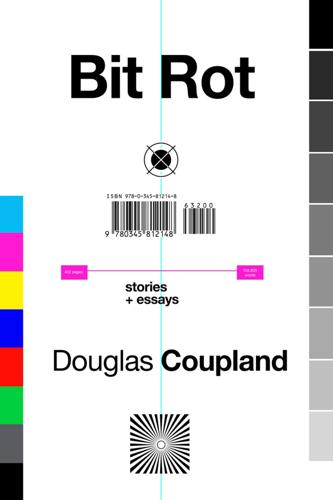
Bit Rot
by
Douglas Coupland
Published 4 Oct 2016
If you compare requests people enter in their Google searches with the items on display at Maker Faire, there is the exact same sense of predictable randomness; the need to find faster, better and cheaper goods and services; a semiotic disconnect from one object to another; and an embrace of glitches as an aesthetic. If the maker aesthetic strays in any one cultural dimension, it would probably be slightly in the direction of Burning Man, but more along the lines of Maker Faire dads building fire-breathing stainless steel golems to enhance a backyard weekend drum circle. After overloading on the noise and imagery of the fair, I found myself at the far end of the hall, taking a breather by a chain-link fence I thought was there to close off unused space.
…
As Karen left the lunchroom, Lydia said to her co-workers, “People always seem to fall in love during that magical time before one person sees the other person display their signature crazy behaviour. Poor Karen.” But Karen’s heart mended from her break with Bartholomew, and within two years she was engaged to a guy who made sculptures out of cardboard boxes that he took to the Burning Man festival in the California desert. And life went on. Bartholomew grew older and buggier. People stopped using land-line telephones altogether. Everyone on Earth used smartphones, even starving people in starving countries. Phones basically cost nothing to make and were as common as, well, the packs of Splenda used in the office lunchroom.
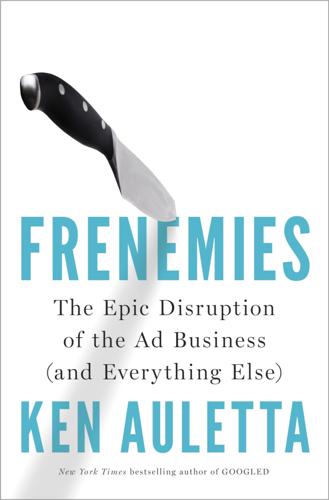
Frenemies: The Epic Disruption of the Ad Business
by
Ken Auletta
Published 4 Jun 2018
Sorrell is constantly in motion, jetting on commercial airlines to attend most ad conferences, be they in Los Angeles or Barcelona, to visit WPP offices in India or Brazil, to sit in on board meetings in Beijing or New York, to chair WPP’s four times yearly Stream conferences in Greece, Cannes, and elsewhere, to attend Google confabs in Sicily and Burning Man in Nevada. The incessant e-mails help forge his reputation as a micromanager, as does his fecund memory for promised but unmet executive goals. More than a few WPP executives, not wanting to be quoted, complain that Sorrell nearly suffocates them with his over-their-shoulder attention to detail.
…
He had a different energy. He had a delight in life. I think it’s from having a very happy union. He’s amused by it. He has a wonderful capacity for play. You’d never believe that because of how hard he works. But Cristiana is a player. She likes to dance. She likes to go to unusual things.” She lured him to attend Burning Man in the Nevada desert. She gave birth to their baby daughter in the fall of 2016. One can fill notebooks with the criticism heaped upon Sorrell. But these don’t paint a complete picture. If we just froze the picture when David Ogilvy called him “an odious little shit” we would miss what happened next.

Don't Be Evil: How Big Tech Betrayed Its Founding Principles--And All of US
by
Rana Foroohar
Published 5 Nov 2019
Subsequent early stage investors would include some Silicon Valley legends, including Amazon founder Jeff Bezos, who put in $250,000 in 1998. “There was no business plan,” said Bezos to journalist Ken Auletta in a New Yorker article. “I just fell in love with Larry and Sergey.”18 And so Google, the company, was born. That first year, they embodied the caricature of a young Silicon Valley start-up, complete with pilgrimages to Burning Man, fancy perks to lure top talent, and plenty of hanky-panky. “Sergey was the Google playboy,” remembers Charlie Ayers, the first company chef, whom Page and Brin hired when the company had only twelve employees.19 “He was known for getting his fingers caught in the cookie jar with employees that worked for the company, in the masseuse room.
…
But by 2012, he was growing concerned about the way in which the engineers at the company paid little attention to the impact of their design choices—making the phone beep or buzz with each new email, for example. Huge amounts of money and time were spent on fine-tuning details, but in Harris’s view, very little was spent on asking the big question: Are we actually making people’s lives better? After a revelatory moment at (where else?) the infamous Burning Man event in the Nevada desert, he put together a 144-slide presentation and sent it to ten other Googlers (the presentation later spread to five thousand more). Entitled “A Call to Minimize Distraction & Respect Users’ Attention,” the deck contained statements such as “Never before in history have the decisions of a handful of designers (mostly men, white, living in SF, aged 25–35) working at 3 companies—Google, Facebook, and Apple—had so much impact on how people around the world spend their attention.”29 The presentation made waves among engineers at the middle ranks, but according to Harris, the top brass (Page himself discussed the topic with Harris) had no interest in making the business model shifts his deck suggested.
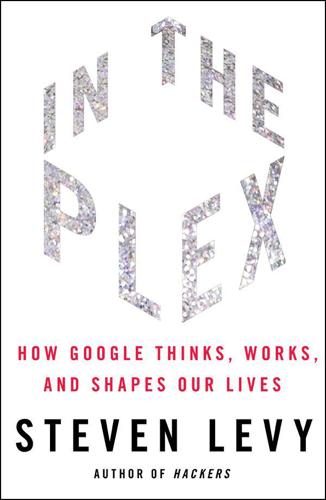
In the Plex: How Google Thinks, Works, and Shapes Our Lives
by
Steven Levy
Published 12 Apr 2011
Later at Excite, he built a multimillion-dollar campaign around the Jimi Hendrix song “Are You Experienced?” His time at Google was brief and rocky. “They were contrarian,” Epstein would later say of the Google founders. “They rejected everything that smacked of traditional marketing wisdom.” Larry and Sergey had their own spin on spin. In 1999, at Burning Man (the posthippie festival in Death Valley that Page and Brin regularly attended), they’d been impressed that someone had projected a laser image onto a nearby hill. Wouldn’t it be great, they asked Epstein, if we could laser google onto the moon? More plausible was their suggestion that Google underwrite shows on NPR, and thus began a long history of public radio sponsorship.
…
In a video of the 1986 prank, you can see Schmidt, wearing glasses with lenses so huge that he looks sort of like a grown-up version of the nerd kid Steve Urkel in Family Matters, staring in stunned but admiring disbelief at the Volkswagen Beetle that his employees had fully disassembled and then reassembled in his office. To cap things off, Brin later said, “He was the only candidate who had been to Burning Man.” When Doerr put Schmidt together with Page and Brin in late 2000, all parties saw the advantages of having Schmidt at Google. Even though they had disagreements in the hours of conversation leading up to the job offer, the Google cofounders respected his acumen and saw that his experience—ranging from start-up to heading a public company—would be a virtue.
…
Google Inc., 9–11, 358–62 Ayers, Charlie, 133–34, 154, 289 Babel Fish, 63 BackRub, 17, 18, 21–24, 26, 28–31; renamed Google, 30–31 Baidu, 4, 273, 279, 281, 292–98, 304, 305, 307 Bailey, David, 58, 59 Baker, Mitchell, 208 Bak, Lars, 209 Ballmer, Steve, 197, 282–83, 380 Barnes & Noble, Nook, 228 Barroso, Luiz, 197–98 BART system, 45, 56 Bartz, Carol, 346 Beard, Ethan, 375–76 Bechtolsheim, Andy, 28, 33–34, 73, 74 Bell, George, 29–30 Berkshire Hathaway, 147, 149 Berners-Lee, Tim, 15–16 Bezos, Jeff, 12, 34, 57, 80, 355, 363 Bharat, Krishna, 38–39, 40, 46, 54, 58, 239 Billington, James, 352 Bisciglia, Christophe, 199–200 Blogger, 101, 335, 374, 376 Bock, Laszlo, 141–42, 256–57, 259, 260 books: and Amazon, 355–56, 363 and class action lawsuit, 9–11, 358–67 digitization of, 11, 347–67 Google Book Settlement, 362–67 metadata in, 351 nondestructive scanning, 348–51, 353, 360 Ocean, 350–55 online future of, 352, 360 “orphan,” 357, 359, 366 payment for use of, 360–63 in public domain, 354 publishers of, 356–62 snippets of, 353, 356, 357, 362 and social good, 360–61, 364, 365, 366 transformative use of, 353–54 Boolean syntax, 36 Boorstin, Robert, 329 Braddi, Joan, 143 brain, virtual, 66, 67–68, 232, 385–86 Branson, Richard, 254 Bray, Tim, 136 Brilliant, Larry, 258 Brin, Michael, 274–75 Brin, Sergey, 3, 5, 16 achievements of, 53, 383 and advertising, 84, 86, 90, 92, 94, 95, 97, 101, 103–6, 108, 110–11, 334, 336–37 ambition of, 128, 139 and applications, 205, 207, 208, 210, 240–42 and artificial intelligence, 385–86 birth and early years of, 13–14, 274–75, 310 and birth of Google, 31–34 and Book Search, 11, 347, 350–52, 364 on capturing all the web, 22–24, 52, 58, 60 on changing the world, 6, 72, 97, 120, 125, 146, 232, 316, 384 and China, 267, 273–74, 276, 277–79, 283, 305, 307, 310–12 and eco-activism, 241 and email, 169–72, 174, 178, 179 and Excite, 29 and funding, 32, 33–34, 73–75 and government issues, 329 and IPO, 146–47, 149–54 and language translation, 63 and management, 74, 75–77, 79–82, 110, 143, 158–60, 162–66, 228, 235, 252–53, 260, 273, 373–74, 386, 387 marriage of, 126, 253 as Montessori kid, 121–25, 127–28, 149 and Obama, 316, 318, 329 and PageRank, 21–24, 48–49 and popular culture, 238 and privacy, 174, 176–77, 253–54, 337 and secrecy, 32, 72, 106, 218 and smart phones, 215–16, 224, 226–30, 234–36 and social networking, 372, 377–78, 380 and speed, 185, 207 and Stanford, 13–14, 16, 17, 28, 29, 34 and trust, 221, 237 values of, 127–28, 130, 132, 135, 139, 141, 146, 196, 275, 305, 364 and web links, 18, 51 and Yahoo, 344 and YouTube, 248, 264 browsers, 204–12 Google Chrome, 208–12, 220, 221, 228, 354 open-source, 204 as operating systems, 210–12 and privacy, 336–37 browser wars, 206, 283 Buchheit, Paul, 102, 259 and email, 167–71, 176, 178–80, 185, 370 and Google motto, 143–44, 170 Buffett, Warren, 147, 149 Burning Man, 76, 80 Bush, Vannevar, 15, 44 Buyer, Lise, 70, 148, 150, 151–52, 154 Buyukkokten, Orkut, 371 Buzz, 377–80 Cairns, Heather, 125 Campbell, Bill, 143, 158–60, 218, 237 Caribou (later, Gmail), 169–71 Cavanaugh, William, 366 Center for Democracy & Freedom, 337, 339 Cerf, Vinton, 222 Chan, Wesley, 113–15, 166, 205, 233–36, 291 Changchun, Li, 306 Chavez, Pablo, 329–30, 346 Chen, Steve, 243–44, 247–51, 264 Cheriton, David, 27–28, 33–34, 79 Cheung, Harry “Spider-Man,” 41, 125, 128 Chin, Denny, 9–10, 365–66 China, 276–314 aim to do good in, 279–80, 303–4, 313 bureaucracy of, 277–79, 280, 291, 295, 298, 304, 312 censorship in, 268, 273, 276, 277, 279, 280–81, 283–86, 290, 293, 295, 297–98, 303–8, 310–13 competition in, 278, 281, 292–98, 300, 305–6, 313 cooperation with government in, 279, 284–85, 292, 297, 299, 301, 302, 305 cultural differences in, 278, 290, 291, 292, 298, 302–3 Google closed in, 311–14, 383 Google’s Chinese name, 287–88 Google’s launch in, 287–89 license to operate in, 277, 279, 280, 295, 340 Obama town meeting in, 324 Olympic Games in, 304 recruitment in, 290–91 “red pockets” in, 297 search in Chinese language, 272–74, 280, 294, 299–300, 304, 306 security issues in, 267–68, 270, 298, 301–2, 303, 308–11, 313–14 stolen code in, 300, 309 and U.S.

Robot Futures
by
Illah Reza Nourbakhsh
Published 1 Mar 2013
First, the cost and complexity of Robot Smog 25 technology needed to make a custom, remote control robot has decreased significantly. Almost anyone can, in a weekend, make a primitive robot, and the construction kits now available make that first robot larger, heavier, and stronger. The second trend is one of attitude. We, as a culture, celebrate scrappy do-it-yourself (DIY) invention, through the world of Burning Man, Maker Faire, Craft, and other such outlets. By building a robot out of a variety of found parts, Terrill joined a celebrated club of enthusiasts who appreciate the idea of building a new device through remix—recycling and repurposing by using parts in ways they were never originally intended to be used.
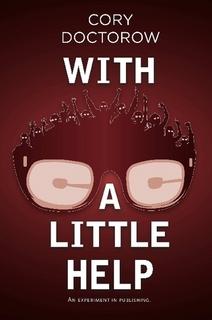
With a Little Help
by
Cory Efram Doctorow
,
Jonathan Coulton
and
Russell Galen
Published 7 Dec 2010
587 Greg turned rotated his head this way and that. "I'm sorry?" 588 "You posted a message to alt.burningman on June 17, 1998 about your plan to attend Burning Man. You posted, 'Would taking shrooms be a really bad idea?'" # 589 It was 3AM before they let him out of the "secondary screening" room. The interrogator was an older man, so skinny he looked like he'd been carved out of wood. His questions went a lot further than the Burning Man shrooms. They were just the start of Greg's problems. 590 "I'd like to know more about your hobbies. Are you interested in model rocketry?" 591 "What?"
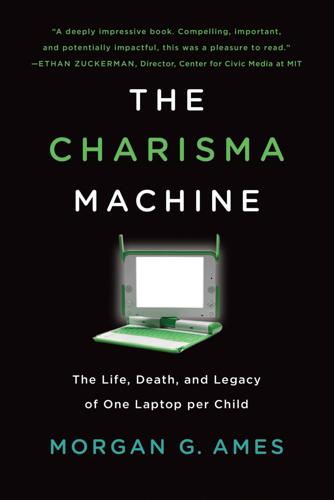
The Charisma Machine: The Life, Death, and Legacy of One Laptop Per Child
by
Morgan G. Ames
Published 19 Nov 2019
See Nye, American Technological Sublime; Douglas, Listening In; Mosco, Digital Sublime; Haring, Ham Radio’s Technical Culture. 20. Winner, “Technology Today,” 1000-1001. 21. See Mosco, Digital Sublime; Turner, From Counterculture to Cyberculture. 22. Mosco, Digital Sublime, 112–113; Turner, “Burning Man at Google”; Turner, “Counterculture Met the New Economy”; Turner, From Counterculture to Cyberculture. 23. Ames and Rosner, “From Drills to Laptops.” 24. Segal, Technological Utopianism, 170. 25. Mosco, Digital Sublime, 22. 26. Mosco, Digital Sublime., 3–6. 27. Tyack and Cuban, Tinkering toward Utopia, 1–11; Ames, “Charismatic Technology.” 28.
…
Technology and Culture 46, no. 3 (2005): 485–512. https://doi.org/10.1353/tech.2005.0154. ———. “How Digital Technology Found Utopian Ideology: Lessons from the First Hackers’ Conference.” In Critical Cyberculture Studies, edited by David Silver and Adrienne Massanari, 257–259. New York: New York University Press, 2006. ———. “Burning Man at Google: A Cultural Infrastructure for New Media Production.” New Media & Society 11, no. 1–2 (February 2009): 73–94. https://doi.org/10.1177/1461444808099575. Twist, Jo. “UN Debut for $100 Laptop for Poor.” BBC News, November 17, 2005. http://news.bbc.co.uk/2/hi/technology/4445060.stm. Tyack, David, and Larry Cuban.
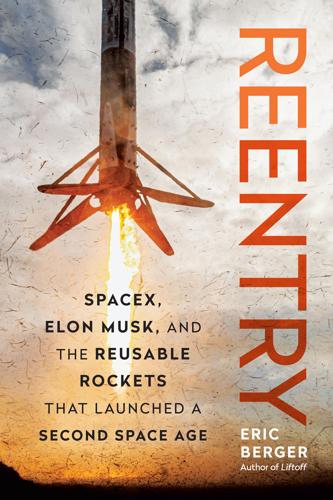
Reentry: SpaceX, Elon Musk, and the Reusable Rockets That Launched a Second Space Age
by
Eric Berger
Published 23 Sep 2024
And we had a rocket that we couldn’t fly.” That morning Musk was asleep at home in Los Angeles. Typically, he works late into the night at SpaceX or Tesla, until two or three in the morning. Then he sleeps for a few hours, until after sunrise. That weekend he had been planning to attend the climax of the Burning Man festival in Nevada, so Musk hoped to store up a few extra hours of rest before long nights of revelry in the desert. As Musk slept, some of his key lieutenants gathered around Shotwell’s office at the company’s headquarters, texting with a group of people who managed Musk’s affairs across SpaceX, Tesla, and other interests.
…
The parachute team would drive to deserts in Southern California and Arizona, staging out of towns like El Centro, near the Salton Sea. They called themselves the “chute show,” and they brought spouses and lovers into the desert because they spent days or weeks there at a time, building large bonfires at night, holding their own Burning Man–like bacchanals between tests. “SpaceXers are kind of crazy workaholics,” Tripathi said. “But the parachute team was a tribe unto itself. If you were on the parachute team, it was a factor of ten more. It was punishing and unrelenting, and these guys practically lived in the desert.” While the chute show busted its ass in the middle of nowhere, dropping parachutes and reviewing data, nearly all of the rest of the company turned its focus toward Starship during the summer and fall of 2019.
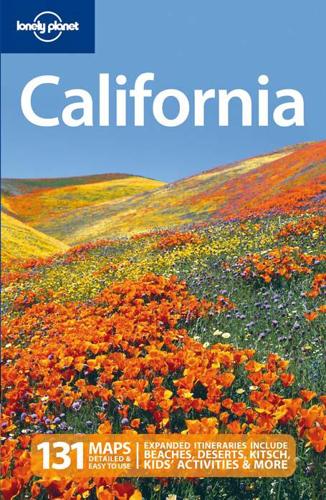
California
by
Sara Benson
Published 15 Oct 2010
Hot August Nights ( 775-356-1956; www.hotaugustnights.net) Catch the American Graffiti vibe during this seven-day celebration of hot rods and rock and roll in early August. Hotel rates skyrocket to their peak. * * * GREAT BALLS OF FIRE! For one week at the end of August, Burning Man (www.burningman.com; admission $210-295) explodes onto the sunbaked Black Rock Desert, and Nevada sprouts a third major population center – Black Rock City. An experiential art party (and alternative universe) that climaxes in the immolation of a towering stick figure, Burning Man is a whirlwind of outlandish theme camps, dust-caked bicycles, bizarre bartering, costume-enhanced nudity and a general relinquishment of inhibitions. And when the last wig-wearing Burner heads home, volunteers make sure to leave no trace, picking up every last hot pink sequin
…
The sleepy sweep of streets from Stanyan to the Pacific is known as the Sunset, with hopping foodie hubs along Irving St around 9th and 19th. Take the N Judah all the way out to the Pacific, and you’ll end up at surfer cafés where conversations revolve around sex wax (for your board, of course). At blustery Ocean Beach (Map) the scene is dominated by wet-suited wave riders and Burning Man devotees keeping warm around ritual fires in new artist-designed tiled firepits. Be sure to follow park rules about fire maintenance and alcohol (not allowed) or you could get fined. On rare sunny days the waters may beckon, but only hardcore surfers and sea lions should brave these riptides. One mile south, Fort Funston (Map; 415-239-2366; Skyline Blvd; 6am-9pm) will double-dare you to hang-glide off cliffs and spelunk defunct Nike missile silos near the parking lot.
…
Aub Zam Zam (Map; 415-861-2545; 1633 Haight St; 3pm-2am) Arabesque arches, jazz on the jukebox and enough paisley to make Prince feel right at home pay homage to the purist Persian charm of dearly departed cocktail fascist Bruno, who’d throw you out for ordering a vodka martini. Noc Noc (Map; 415-861-5811; 557 Haight St) Who’s there? Dreadlocked graffiti artists, electronica DJs and Mad Max–inspired fashion designers, that’s who. This place looks like a post-apocalyptic cartoon cave dwelling, and serves a sake cocktail that’ll keep you buzzed until the next Burning Man. Mad Dog in the Fog (Map; 415-863-2276; 530 Haight St; 11:30am-2am Mon-Fri, 10am-2am Sat & Sun) Footie fans watch matches live on GMT, and know-it-alls arrive by 8:30pm Tuesdays and Thursdays to compete for free beer on Trivia Nights. There’s no hard liquor or credit-card machine, but cash will get you beer, darts and occasionally live rockabilly.

The Paleo Kitchen: Finding Primal Joy in Modern Cooking
by
Juli Bauer
and
George Bryant
Published 7 Jun 2014
(Author’s site: http://robbwolf.com) INFORMATION/RECIPE BLOGS GEORGE Civilized Caveman Cooking Creations civilizedcavemancooking.com PaleOMG (JULI) paleomg.com Against All Grain againstallgrain.com Balanced Bites balancedbites.com BrittanyAngell brittanyangell.com Clean Eating with a Dirty Mind cleaneatingwithadirtymind.com The Clothes Make the Girl theclothesmakethegirl.com The Domestic Man thedomesticman.com Elana’s Pantry www.elanaspantry.com Everyday Paleo everydaypaleo.com Fat-Burning Man fatburningman.com Health-Bent health-bent.com theKitchn thekitchn.com Nom Nom Paleo nomnompaleo.com Paleo Comfort Foods paleocomfortfoods.com Paleo Cupboard paleocupboard.com Paleo Parents paleoparents.com Primal Palate primalpalate.com Real Food Liz realfoodliz.com SlimPalate slimpalate.com The Spunky Coconut thespunkycoconut.com Stupid Easy Paleo stupideasypaleo.com Underground Wellness undergroundwellness.com The Urban Poser urbanposer.blogspot.com Whole9 whole9life.com Zen Belly zenbellycatering.com RECIPE INDEX Breakfast Sun-Dried Tomato Sweet Potato Hash Banana Bread Waffles with Mixed Fruit Topping Pumpkin Waffles Baked Banana Chip Crusted French Toast Cinnamon Chocolate Swirl Banana Bread Sweet Potato Quiche Delicata Squash Frittata Lavender Vanilla Bean Granola Lemon Raspberry Swirl Muffins Vanilla White Peach Muffins Biscuits & Gravy Fluffy Blueberry Pancakes Bacon Sweet Potato Hash with Apples & Pears Cinnamon Rolls Fig Blueberry Jam Blackberry Pear Jam Starters & Snacks Rosemary Crackers Sweet Plantain Guacamole Easy Guacamole Candied Bacon Pulled Pork Nachos Spinach & Artichoke Stuffed Portobello Mushrooms Avocado Caprese Stacks Prosciutto Pears with Balsamic Reduction Citrus Mint Sugar Salad Soups & Hearty Salads Sage & Shallot Delicata Squash Soup Creamy Cauliflower Soup Crock-Pot French Onion Soup Pumpkin Tomato Soup Squash Medley Lavender Soup Chicken Zoodle Soup Savory Beef Chili Steak Fajita Salad Creamy Pesto Chicken Salad Cranberry Chicken Salad Pork Dishes Pan-Seared Rosemary Sage Pork Chops with Apples & Pears Slow Cooker Pulled Pork Twice-Baked Stuffed Butternut Squash Perfect Ribs Shredded Pork Meatloaf Loaded BBQ Sweet Potatoes Asian Cabbage Slaw Pork Burgers Perfect Meatballs with Sage Sweet Potato Noodles Beef Dishes Sweet & Savory Open-Faced Sliders Four-Layer Beef & Bacon Casserole Bacon Beef Stew Marinated Steak & Pineapple Kabobs Carne Asada Garlic & Thyme Standing Rib Roast Mongolian Beef over Cauliflower Rice The Perfect Burger Rosemary Sun-Dried Tomato Meatballs with Tomato Sauce Chicken Dishes Chicken Apricot Curry Honey Mustard Chicken Thighs Lemon & Chive Pasta with Chicken Thighs Lemon Rosemary Roasted Chicken Hot Wings Honey Ginger Wings Slow Cooker Tomatillo Chicken Spaghetti Squash Chicken Fritters Fish & Seafood Dishes Herb Cauliflower Mash with Seared Sea Scallops Creamy Seafood Risotto Shrimp Scampi Honey-Glazed Salmon with Pomegranate & Pineapple Salsa Bacon-Wrapped Scallop & Melon Skewers Sides Honey Dijon & Rosemary Grilled Sweet Potatoes Dill Butternut Squash Fries Bacon Lime Sweet Potato Salad Grilled Baby Bok Choy Bacon Pecan Cabbage Asian Marinated Asparagus Honey Lime Roasted Carrots Coconut Cauliflower Curry Parsnip Puree Cauliflower Rice Refreshing Smoothies & Warming Drinks Watermelon Mint Chiller Afternoon Pick-Me-Up (Coffee Smoothie) Hazelnut Hot Chocolate Cinnamon Pecan Latte Gingerbread Latte Pineapple Green Smoothie Banana Berry Smoothie Ginger Apple Pear Smoothie Orange Cream Smoothie Desserts Coffee Pecan Ice Cream Blueberry Rosemary Ice Cream Honey Pistachio Ice Cream Chocolate Cookie Ice Cream Macadamia Chocolate Chip Cookies Lemon Poppyseed Cookies No-Bake Tropical Escape Cookies Gingersnap Pumpkin Butter Cookie Sandwiches Candied Bacon Chocolate Brownies Vanilla Bean Chocolate-Cayenne Cake Lime Pound Cake Frozen Blueberry Cheesecake Black & White Cake Chocolate Coffee Bread Pudding Individual Apple Crisps Condiments, Nut Butters, & Nut Milks Pistachio Pesto Garlic Aioli Avocado Mousse Pico de Gallo Blueberry BBQ Sauce Tangy BBQ Sauce Coconut Butter Macadamia Nut Butter Maple Cinnamon Pecan Butter Vanilla Bean Almond Butter Homemade Nut Milks Acknowledgments No book is just one person’s adventure, and this one in particular has been quite the team effort.
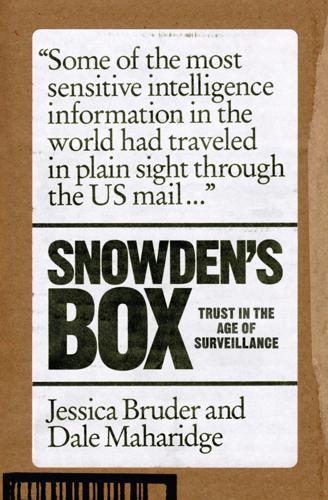
Snowden's Box: Trust in the Age of Surveillance
by
Jessica Bruder
and
Dale Maharidge
Published 29 Mar 2020
It was probably for the best that I didn’t know that in the moment, since it would have just made me more nervous. Like Dale, I felt utterly unprepared for anything that might happen. Being a journalist was no help — I couldn’t talk about anything that was going on, and, besides, much of my reporting focused on subcultures. I had written a book about Burning Man and was now in the early stages of researching a new one, Nomadland, about older Americans who’d traded traditional homes for vans and RVs, becoming itinerant workers to navigate an increasingly polarized economy. The whole situation continued to make me uneasy. Meanwhile, Snowden had fled from Hong Kong and was stranded in Moscow, where he was seeking asylum.

Who Owns the Future?
by
Jaron Lanier
Published 6 May 2013
Just about every technologist I know harbors some Rousseauian fetish in the closet. The same fellow who might work on “Augmented Wilderness,” a technology in which a virtual world is perceived to be superimposed on a remote wilderness trail, will seek out the wild primitivist side of Silicon Valley rituals like Burning Man. The room where I am writing this is filled with rare, archaic, acoustic musical instruments that I have learned to play. I find that digital ways of making music are missing something and I will not let go of that thing. This is entirely reasonable. Is there really something essential and vital about acoustic instruments that computers can’t touch?
…
Brian, 169n artificial hearts, 157–58 artificial intelligence (AI), 23, 61, 94, 95, 114, 116, 136, 138n, 147, 155, 157, 178, 191, 192–93, 325, 330, 354, 359n artificial memory, 35 art market, 108 Art of the Long View, The (Schwartz), 214 ashrams, 213 assets, 31, 60 “As We May Think” (Bush), 221n asymmetry, 54–55, 61–66, 118, 188, 203, 246–48, 285–88, 291–92, 310 Athens, 22–25 atomic bomb, 127 “attractor nightmare,” 48 auctions, 170, 286 aulos, 23n austerity, 96, 115, 125, 151, 152, 204, 208 authenticity, 128–32, 137 authors, 62n automata, 11, 12, 17, 23, 42, 55, 85–86, 90–92, 97–100, 111, 129, 135–36, 155, 157, 162, 260, 261, 269, 296n, 342, 359–60 automated services, 62, 63, 64, 147–48 automated trading systems, 74–78, 115 automation, 7, 85, 123–24, 192, 234, 259, 261, 343 automobiles, 43, 86, 90–92, 98, 118–19, 125n, 302, 311, 314, 343, 367 avatar cameras, 265 avatars, 89n, 265, 283–85 baby boomers, 97–100, 339, 346 bailouts, financial, 45, 52, 60, 74–75, 82 Baird-Murray, Kathleen, 200n “Ballad of John Henry, The,” 134–35 bandwidth, 171–72 banking, 32–33, 42, 43, 69, 76–78, 151–52, 251, 269n, 289, 345–46 bankruptcy, 2, 89, 251 bargains, 64–65, 95–96 Barlow, John Perry, 353 Barnes & Noble, 62n, 182 barter system, 20, 57 Battlestar Galactica, 137, 138n “beach fantasy,” 12–13, 18, 236–37, 331, 366–67 Beatles, 211, 212, 213 behavior models, 32, 121, 131, 173–74, 286–87 behavior modification, 173–74 Belarus, 136 belief systems, 139–40 Bell, Gordon, 313 bell curve distribution, 39, 39–45, 204, 208, 262, 291–93 Bell Labs, 94 Bentham, Jeremy, 308n Berners-Lee, Tim, 230 Bezos, Jeff, 352 big business, 265–67, 297–98 big data, 107–40, 150, 151–52, 155, 179, 189, 191–92, 202–4, 265–66, 297–98, 305, 346, 366, 367 big money, 202–4, 265–67 billboards, 170, 267, 310 billing, 171–72, 184–85 Bing, 181–82 biodiversity, 146–47 biological realism, 253–54 biotechnology, 11–13, 17, 18, 109–10, 162, 330–31 Bitcoin, 34n BitTorrent, 223 blackmail, 61, 172–73, 207, 273, 314, 316, 322 Black Monday, 74 blogs, 118n, 120, 225, 245, 259, 349, 350 books, 1–2, 62, 63, 65, 113, 182, 192, 193, 246–47, 277–78, 281, 347, 352–60 bots, 62, 63, 64, 147–48 brain function, 195–96, 260, 328 brain scans, 111–12, 218, 367 Brand, Stewart, 214 brand advertising, 267 Brandeis, Louis, 25, 208 Brazil, 54 Brooks, David, 326 Burma, 200n Burning Man, 132 Bush, George H. W., 149 Bush, Vannevar, 221n business data, 112–13, 150, 189 business plans, 107–8, 117–20, 154, 169–74, 175, 236, 258, 301–2, 344–45 cached data mirrors, 223 Cage, John, 212 California, University of, at Berkeley, 104, 107–8, 111, 172 call centers, 177n Caltech, 94, 184 Cambridge, Mass., 157–58 cameras, 2, 10, 89, 265, 309–11, 319 capital flows, 37, 43–45, 47, 49, 201, 329, 355–56 capitalism, 11, 16–17, 20, 43–46, 47, 49, 66–67, 79, 208, 243, 246–48, 258, 260–63, 272, 273n, 277, 329 capital resources, 86 “captured” populations, 170–71 carbon credits, 87, 88, 298–99, 300, 301–3, 314 cartels, 158 Catholic Church, 190 cell phones, 34n, 39, 85, 87, 162, 172, 182n, 192, 229, 269n, 273, 314, 315, 331 Central Intelligence Agency (CIA), 199–200 chance, 23n change acceleration, 10, 21, 130–33, 136, 193–95, 217 chaos, 165–66, 273n, 331 cheating, 120, 335 Chicago, Ill., 47 China, 54, 70, 85, 87, 199, 200, 201, 208 Christianity, 190, 193–94, 293 Christian Science, 293 civility, 293–94 civilization, 123, 255, 300, 311, 336 civil liberties, 317–24 classified ads, 177n click-through counts, 183, 286, 347 clothing, 89, 260, 367 Cloud Atlas, 165 cloud processors and storage, 11–12, 19, 20, 42, 62, 88, 92, 100, 110, 113, 121, 124n, 144, 146n, 147, 149, 151, 153–54, 168, 203, 209, 245–46, 255, 258, 261–62, 274, 284, 292, 306, 311–13, 326, 338, 347–48, 350, 359 code, 112, 272 cognition, 111–12, 195–96, 260, 312–13, 314, 315, 328 Cold War, 189 Coleman, Ornette, 353 collectives, 358–60 collusion, 65–66, 72, 169–74, 255, 350–51 Columbia Records, 161n commercial rights, 317–24, 347 commissions, 184 communications industry, 258 communism, 136, 153, 291, 344 compensatory servers, 64 competition, 42, 60, 81, 143–44, 147, 153, 180, 181, 187–88, 246–48, 326 complexity, 53–54 Computer Lib/Dream Machines (Nelson), 229 computer programmers, 113–14, 123, 286n computers: artificiality of, 130, 134 calculations by, 146n, 147–48, 149, 151 cloud processors and, see cloud processors and storage development of, 53, 129–30 as machines, 22–25, 123, 129–30, 155, 158, 165–66, 178, 191, 193, 195, 248, 257–58, 261, 328 memory of, 146n networks of, see digital networks parallel, 147–48, 149, 151 personal (PCs), 158, 182n, 214, 223, 229 programming of, 113–14, 120, 123, 157, 180, 193, 248, 272, 286n, 342, 362–63 remote, 11–12 reversible, 143n security of, 175, 345–46 servers for, 12n, 15, 31, 53–57, 71–72, 95–96, 143–44, 171, 180, 183, 206, 245, 358 software for, 7, 9, 11, 14, 17, 68, 86, 99, 100–101, 128, 129, 147, 154, 155, 165, 172–73, 177–78, 182, 192, 234, 236, 241–42, 258, 262, 273–74, 283, 331, 347, 357 user interface for, 362–63, 364 computer science, 113–14, 120, 123, 157, 180, 193, 248, 272, 286n, 342, 362–63 conflicts of interest, 62n Confucianism, 214, 215–16 connectivity, 171–72, 184–85, 273, 296n, 309, 316, 331 consciousness, 195–96 conservatism, 148, 149–51, 153, 204, 208, 249, 251, 253, 256, 293 construction industry, 151 consultants, 69–72 consumer electronics, 85–86, 162 consumer-facing sites, 179–80, 182, 216 consumers, see economies, consumer “content farms,” 120 contracts, 79–82, 172, 182, 183–84, 246–48, 314, 347, 352–53 copyright, 44, 47, 49, 60, 61, 96, 183, 206, 207, 224–26, 239–40, 263–64 corporations, 265–67, 307, 314, 348–51 correlations, 75–76, 114–15, 192, 274–75 correlative algorithms, 75–76 corruption, 31, 48, 77, 235, 257, 341n cost comparisons, 64 cost-effectiveness, 136–37 cost externalization, 59n countercultures, 24 Craigslist, 177n credit, 52, 116, 177, 193, 287–90, 305, 320, 337–38 credit cards, 185, 186, 269n credit ratings, 52, 116, 177, 193, 320 creepiness, 305–24 crime, 48, 307, 311, 319–21 crowdsourcing, 21, 86, 119–20, 356 cryptography, 14 currencies, 286–87 customer service, 177 cyberactivism, 14, 199, 200–201, 210, 308–9, 335–36, 339 cyberattacks, 201 cybernetics, 230 cyberpunk literature, 309, 356n Daedalus, 22 data, 12, 20, 50–54, 55, 71–76, 92, 167n, 174, 176–77, 178, 196, 223, 234–35, 246–48, 256–58, 271–75, 286–87, 292, 300, 307, 316, 317–24, 347 see also big data databases, 20, 71–72, 75–76, 178, 192, 203 data copying, 50–51 data mining, 120 dating services, 108–9, 113, 167–68, 274–75, 286 Deadpool, 189 death denial, 193, 218, 253, 263–64, 325–31, 367 death tolls, 134 debt, 29, 30n, 54, 92, 95, 96 Debt: The First 5,000 Years (Graeber), 30n decision-making, 63–64, 184, 266, 269–75, 284n decision reduction, 266, 269–71, 284n deconstructionism, 131 democracy, 9, 32–33, 44, 90–92, 120, 200, 202–4, 207, 208, 209, 209, 210, 246–48, 277–78, 321, 324, 336, 342 Democratic Party, 202 demonetization, 172, 176n, 186, 207, 260–61 denial of service, 171–72, 312–13, 315 depopulation, 97, 133 depressions, economic, 69–70, 75, 135, 151–52, 288, 299 deprinters, 88 derivatives funds, 56, 60, 149, 153, 155, 301 determinism, 125, 143, 156, 166–68, 202, 328, 361 devaluation, 15–16, 19–21 developed world, 53–54 Diamond, Jared, 134 dice throws, 23n Dick, Philip K., 18, 137 differential pricing, 63–64 digital cameras, 2 digital networks, 2–3, 9, 11, 12, 14, 15, 16, 17, 19–21, 31, 35, 49, 50–51, 53, 54–55, 56, 57, 59, 60–61, 66–67, 69–71, 74, 75, 77–80, 92, 96, 99, 107–8, 118–19, 120, 122, 129–30, 133n, 136–37, 143–48, 192, 199, 209, 221–30, 234, 235, 245–51, 259, 277, 278, 286–87, 308–9, 316, 337, 345, 349, 350, 355, 366–67 design of, 40–45 educational, 92–97 effects, 99, 153, 169–74, 179, 181–82, 183, 186, 207, 305, 362–63, 366 elite, 15, 31, 54–55, 60, 122, 201 graph-shaped, 214, 242–43 medical, 98–99 nodes of, 156, 227, 230, 241–43, 350 power of, 147–49, 167 punishing vs. rewarding, 169–74, 182, 183 tree-shaped, 241–42, 243, 246 see also Internet digital rights movement, 225–26 digital technology, 2–3, 7–8, 15–16, 18, 31, 40, 43, 50–51, 132, 208 dignity, 51–52, 73–74, 92, 209, 239, 253–64, 280, 319, 365–66 direct current (DC), 327 disease, 110 disenfranchisement, 15–16 dossiers, personal, 109, 318 dot-com bubble, 186, 301 double-blind tests, 112 Drexler, Eric, 162 DSM, 124n dualism, 194–95 Duncan, Isadora, 214 Dyson, George, 192 dystopias, 130, 137–38 earthquakes, 266 Eastern Religion, 211–17 eBay, 173, 176, 177n, 180, 241, 343 eBooks, 113, 246–47, 352–60 eBureau, 109 economic avatars, 283–85, 302, 337–38 economics, 1–3, 15, 22, 37, 38, 40–41, 42, 67, 122, 143, 148–52, 153, 155–56, 204, 208, 209, 236, 259, 274, 288, 298–99, 311, 362n, 363 economies: austerity in, 96, 115, 125, 151, 152, 204, 208 barter system for, 20, 57 collusion in, 65–66, 72, 169–74, 255, 350–51 competition in, 42, 60, 81, 143–44, 147, 153, 180, 181, 187–88, 246–48, 326 consumer, 16–17, 43, 54, 56n, 62, 63–65, 72–74, 85–86, 98, 114, 117, 154, 162, 173–74, 177, 179–80, 182, 192, 193, 215, 216, 223, 227, 241, 246, 247, 248–64, 271–72, 273, 286–88, 293, 323, 347–48, 349, 355–56, 357, 358–60 depressions in, 69–70, 75, 135, 151–52, 288, 299 dignity in, 51–52, 73–74, 92, 209, 239, 253–64, 280, 319, 365–66 distributions in, 37–45 of education, 92–97 efficiency in, 39, 42–43, 53, 61, 66–67, 71–74, 88, 90, 97, 118, 123, 155, 176n, 187–88, 191, 236, 246, 310, 349 entrepreneurial, 14, 57, 79, 82, 100–106, 116, 117–20, 122, 128, 148–49, 166, 167, 183, 200, 234, 241–43, 248, 274, 326, 359 equilibrium in, 148–51 financial sector in, 7n, 29–31, 35, 38, 45, 49, 50, 52, 54, 56–67, 69–70, 74–80, 82, 115, 116–20, 148n, 153–54, 155, 179–85, 200, 208, 218, 254, 257, 258, 277–78, 298, 299–300, 301, 336–37, 344–45, 348, 350 freedom and, 32–33, 90–92, 277–78, 336 global, 33n, 153–56, 173, 201, 214–15, 280 government oversight of, 44, 45–46, 49, 79–80, 96, 151–52, 158, 199, 205–6, 234–35, 240, 246, 248–51, 299–300, 307, 317, 341, 345–46, 350–51 growth in, 32, 43–45, 53–54, 119, 149–51, 236, 256–57, 270–71, 274–75, 291–94, 350 of health care, 98–99, 100, 153–54 historical analysis of, 29–31, 37–38, 69–70 humanistic, 194, 209, 233–351 361–367 of human labor, 85, 86, 87, 88, 99–100, 257–58, 292 identity in, 82, 283–90, 305, 306, 307, 315–16 inclusiveness of, 291–94 information, 1–3, 8–9, 15–17, 18, 19–20, 21, 35, 60–61, 92–97, 118, 185, 188, 201, 207, 209, 241–43, 245–46, 246–48, 256–58, 263, 283–87, 291–303, 331, 361–67 leadership in, 341–51 legal issues for, 49, 74–78 levees in, 43–45, 46, 47, 48, 49–50, 52, 92, 94, 96, 98, 108, 171, 176n, 224–25, 239–43, 253–54, 263, 345 local advantages in, 64, 94–95, 143–44, 153–56, 173, 203, 280 market, 16–17, 20, 23–24, 33–34, 38, 39, 43–46, 47, 50–52, 66–67, 75, 108, 118–19, 126, 136, 143, 144–48, 151–52, 155, 156, 167, 202, 207, 221–22, 240, 246–48, 254–57, 261, 262–63, 266, 277–78, 288, 292–93, 297–300, 318, 324, 326, 329, 344, 354, 355–56; see also capitalism mathematical analysis of, 40–41 models of, 40–41, 148–52, 153, 155–56 monopolies in, 60, 65–66, 169–74, 181–82, 187–88, 190, 202, 326, 350 morality and, 29–34, 35, 42, 50–52, 54, 71–74, 252–64 Nelsonian, 335, 349–50 neutrality in, 286–87 optimization of, 144–47, 148, 153, 154–55, 167, 202, 203 outcomes in, 40–41, 144–45 political impact of, 21, 47–48, 96, 149–51, 155, 167, 295–96 pricing strategies in, 1–2, 43, 60–66, 72–74, 145, 147–48, 158, 169–74, 226, 261, 272–75, 289, 317–24, 331, 337–38 productivity of, 7, 56–57, 134–35 profit margins in, 59n, 71–72, 76–78, 94–95, 116, 177n, 178, 179, 207, 258, 274–75, 321–22 public perception of, 66n, 79–80, 149–50 recessions in, 31, 54, 60, 76–77, 79, 151–52, 167, 204, 311, 336–37 regulation of, 37–38, 44, 45–46, 49–50, 54, 56, 69–70, 77–78, 266n, 274, 299–300, 311, 321–22, 350–51 risk in, 54, 55, 57, 59–63, 71–72, 85, 117, 118–19, 120, 156, 170–71, 179, 183–84, 188, 242, 277–81, 284, 337, 350 scams in, 119–21, 186, 275n, 287–88, 299–300 self-destructive, 60–61 social aspect of, 37–38, 40, 148–52, 153, 154–56 stimulus methods for, 151–52 sustainable, 235–37, 285–87 transformation of, 280–94, 341–51 trust as factor in, 32–34, 35, 42, 51–52 value in, 21, 33–35, 52, 61, 64–67, 73n, 108, 283–90, 299–300, 321–22, 364 variables in, 149–50 vendors in, 71–74 Edison, Thomas, 263, 327 editors, 92 education, 92–97, 98, 120, 150, 201 efficiency, 39, 42–43, 53, 61, 66–67, 71–74, 88, 90, 97, 118, 123, 155, 176n, 187–88, 191, 236, 246, 310, 349 Egypt, 95 eHarmony, 167–68 Einstein, Albert, 208n, 364 elderly, 97–100, 133, 269, 296n, 346 elections, 202–4, 249, 251 electricity, 131, 327 Electronic Frontier Foundation, 184 “elevator pitch,” 233, 342, 361 Eloi, 137 employment, 2, 7–8, 11, 22, 56–57, 60, 71–74, 79, 85–106, 117, 123, 135, 149, 151–52, 178, 201, 234, 257–58, 321–22, 331, 343 encryption, 14–15, 175, 239–40, 305–8, 345 Encyclopaedia Britannica, 338 End of History, The (Fukuyama), 165 endoscopes, 11 end-use license agreements (EULAs), 79–82, 314 energy landscapes, 145–48, 152, 209, 336, 350 energy sector, 43, 55–56, 90, 144, 258, 301–3 Engelbart, Doug, 215 engineering, 113–14, 120, 123–24, 157, 180, 192, 193, 194, 217, 218, 248, 272, 286n, 326, 342, 362–63 Enlightenment, 35, 255 enneagrams, 124n, 215 Enron Corp., 49, 74–75 entertainment industry, 7, 66, 109, 120, 135, 136, 185–86, 258, 260 see also mass media entrepreneurship, 14, 57, 79, 82, 100–106, 116, 117–20, 122, 128, 148–49, 166, 167, 183, 200, 234, 241–43, 248, 274, 326, 359 entropy, 55–56, 143, 183–84 environmental issues, 32 equilibrium, 148–51 Erlich, Paul, 132 est, 214 Ethernet, 229 Etsy, 343 Europe, 45, 54, 77, 199 evolution, 131, 137–38, 144, 146–47 exclusion principle, 181, 202 Expedia, 65 experiments, scientific, 112 experts, 88, 94–95, 124, 133–34, 178, 325–31, 341, 342 externalization, 59n Facebook, 2, 8, 14, 20, 56–57, 93, 109, 154, 169, 171, 174, 180, 181, 188, 190–91, 200n, 204, 206, 207, 209, 210, 214, 215, 217, 227, 242–43, 246, 248, 249, 251, 270, 280, 286, 306, 309, 310, 313, 314, 317, 318, 322, 326, 329, 341, 343, 344, 346, 347–48, 366 facial recognition, 305n, 309–10 factories, 43, 85–86, 88, 135 famine, 17, 132 Fannie Mae, 69 fascism, 159–60 fashion, 89, 260 feedback, 112, 162, 169, 203, 298, 301–3, 363–64, 365 fees, service, 81, 82 feudalism, 79 Feynman, Richard, 94 file sharing, 50–52, 61, 74, 78, 88, 100, 223–30, 239–40, 253–64, 277, 317–24, 335, 349 “filter bubbles,” 225, 357 filters, 119–20, 200, 225, 356–57 financial crisis (2008), 76–77, 115, 148n financial services, 7n, 29–31, 35, 38, 45, 49, 50, 52, 54, 56–67, 69–70, 74–80, 82, 115, 116–20, 148n, 153–54, 155, 179–85, 200, 208, 218, 254, 257, 258, 277–78, 298, 299–300, 301, 336–37, 344–45, 348, 350 firewalls, 305 first-class economic citizens, 246, 247, 248–51, 273, 286–87, 323, 349, 355–56 Flightfox, 64 fluctuations, 76–78 flu outbreaks, 110, 120 fMRI, 111–12 food supplies, 17, 123, 131 “Fool on the Hill, The,” 213 Ford, Henry, 43 Ford, Martin, 56n Forster, E.
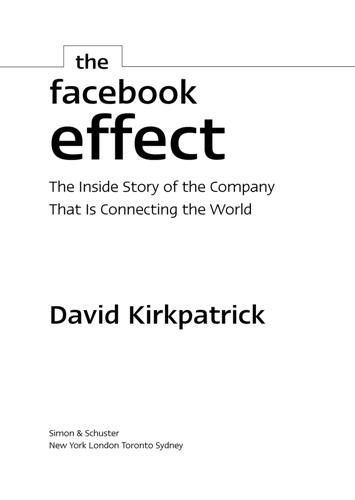
The Facebook Effect
by
David Kirkpatrick
Published 19 Nov 2010
Tribe.net was originally intended to help members share Craigslist-type classifieds so they could buy things from people they knew. Its tribal quality, however, quickly became its trademark, and its most cohesive online tribes were not the ordinary-Joe ones Pincus had envisioned. They included regular attendees at the annual Burning Man festival in Nevada as well as devotees of alternative sexual practices, more interested in just connecting than in buying and selling things. Sean Parker fell in with this San Francisco social networking mafia. At that time, Parker shared a house with Stanford students in Palo Alto, where Friendster was already taking off, and several of these guys were already in his own real-world social network.
…
Index ABC.com, 298 AboutFace, 145 Abrams, Jonathan, 70–72, 73, 75–76 Academy Awards, 298 Accel Partners, 114–27, 215 Facebook’s meetings and deal with, 117–18, 119–20, 122, 124–26, 129, 130, 143, 146–147, 170, 183, 318, 320, 322, 323 fees of, 114 social networking interest of, 115 Addeman, V, 213 AdSeed, 111–12 AdSense, 111, 324 Advance Research Projects Agency (ARPAnet), 66 advertising: cookies and, 142 engagement, 260–61 gender targeting of, 142 on MySpace, 177–78 targeting of, 141–43, 247, 266, 307 see also Facebook, advertising on Aeneid (Virgil), 138 Affinity Engines, 78 Agarwalla, Jayant, 228, 229 Agarwalla, Rajat, 228, 229 AIDS Vaccine Initiative, 254 AKQA, 263 Alexa Internet data service, 281 Allen, Paul, 216 Alliance of Youth Movements Summit, 291 Allposters.com, 132 Al Qaeda, 291, 292 Amazon.com, 158, 161, 178, 250 ambient intimacy, 203–4 American Growth of Cairo, 280 American Library Association, 209 America Online (AOL), 12, 67, 94, 188, 237, 296, 335 chat rooms of, 293 Instant Messenger (AIM) of, 27, 29, 137, 144, 162, 187, 219 Amherst Regional High School, 207 Anderson, Tom, 74–75, 76, 139 Anderson, Will, 289 Andreessen, Marc, 135, 152, 165–66, 272, 312, 319–20, 321 Anglo-Irish Bank, 204 Angwin, Julia, 74, 76, 153 Apache Web server tools, 38 Apple, 102, 104, 112, 141, 176, 188, 209, 215, 218, 220, 226 iChat, 219 aQuantive, 237 Arizona, University of, 43 Armenia, 291 Armstrong, Tim, 237, 238 Arrington, Michael, 304 Asana, 269, 301 Asian Avenue, 69 Association of Harvard Black Women, 24, 25, 26 Association of National Advertisers, 271 Australia, 16 Authoritas: One Student’s Harvard Admissions and the Founding of the Facebook Era (Greenspan), 84–85 Bahamas, 275 Ballmer, Steve, 237–38, 239–41, 245, 267 Baloun, Karel, 137, 138 Barranquilla, Colombia, 4, 5 Baylor University, 101 BBC, 211 Beacon, 201, 246–48, 250–51, 254, 258, 259, 324 Beard, Ethan, 306, 313 Bebo, 152, 335 Bedecarre, Tom, 263, 264 Beirut (beer drinking game), 55, 96, 129, 144, 175 Ben & Jerry’s, 264, 265 Benchmark venture capital, 53, 71, 112, 268 Berkshire Hathaway, 108 Bermuda, 290 Betancourt, Ingrid, 1, 6 Bewkes, Jeff, 187 Bezos, Jeff, 320 Bing, 326 Black, Tricia, 42, 43, 44, 61, 129, 138 BlackBerry, 50, 316 BlackPlanet, 69 blogging, 128, 263 Borthwick, John, 329 Boston University, 37 Bosworth, Adam, 191 Botha, Roelof, 104, 105 Bowdoin College, 79 boyd, danah, 68 Brainstorm, 166 Brand, Stewart, 66 Brazil, 16, 78, 87, 276, 281–82 Breyer, Jim, 115, 138, 148, 198, 236, 251, 254, 320–21, 322 Accel’s investment in Facebook set up by, 119–21, 122, 168 and broadening Facebook to new demographics, 149, 150 open registration and, 196 Parker’s arrest and, 146–47 Yahoo offer and, 183–84, 185–86 Zuckerberg’s dinner with, 122, 168 Brilliant, Larry, 66 Brin, Sergei, 216, 254 broadband, 76 Bronfman, Edgar, Jr., 54, 125 Brown, Scott, 294 Brown University, 37 Brunei, 275 Buddy Media, 267 Buddy Zoo, 27 Buffett, Warren, 108–9 Burma, 291 Burning Man festival, 73 Burton, Jeremy, 299–300 Bush, George W., 290, 294 BusinessWeek, 169 Buyukkokten, Orkut, 77–78 cages, 225–26 California, University of, at Santa Barbara, 292–93 Callahan, Ezra, 103, 111, 126 Caltech, 38 Cambodia, 275 Campus Network, 101 Camus, Albert, 49 Canada, 16, 275, 328 Cassidy, John, 173 Causes, 224–25, 231–32 Chan, Priscilla, 47, 170, 174, 186, 253 Chase credit cards, 175–76 Chatter, 301 Chavez, Hugo, 1 cheerleaders, 141, 142, 247 Cheever, Charlie, 158, 202–3, 220, 269 Chen, Steve, 129 Chernin, Peter, 161 Chien, Chi-Hua, 116 Children of Jihad (Cohen), 280, 281 Chile, 15, 275, 276, 278, 281 China, 105, 276, 282 Christman, Michael, 223 Cisco, 104 Classmates.com, 67, 335 Clemons, Nick, 293 Clinton, Bill, 307 Clinton, Hillary, 204, 293 Clippinger, John, 328 Club Nexus, 36, 77–78, 79, 84 CNN, 296, 298, 306 Coast Guard, U.S., 295 Coca-Cola, 272 Cohen, Jared, 280, 290 Cohler, Matt, 135, 136, 138, 143, 162, 163, 257 in departure from Facebook, 268, 270 DeWolfe’s meeting with, 139 Facebook stock and, 90, 322 on failure of work networks, 173 investors and, 114, 116, 117–20, 121–23, 126, 128 as maturest member of team, 128 and opening of Facebook to new demographics, 149, 150, 196 Parker’s arrest and, 146 platform work of, 222 recruited to Facebook, 105, 116 recruiting by, 129, 130–31 on the “social graph,” 157 at Viacom meeting, 160 Yahoo’s negotiations with, 183, 184, 185 CollegeFacebook.com, 101 Collegester.com, 79 Colleran, Kevin, 138, 139–40, 330 advertising targeting by, 142 Colombia, 1–6, 7, 8, 16, 265, 278, 288, 290, 291 Columbia University, 35, 36, 79, 91, 101, 291 Community, 297 Compete research firm, 326 “Computer as Communication Device, The” (Licklider and Taylor), 66 comScore Media Metrix, 170, 272, 273, 306 condoms, 295 ConnectU, 83 Consumer Federation of America, 209 Consumerist, 308, 310 consumer monetization, 262 Consumers Union, 308 Conway, Ron, 110, 114 cookies, 141–42 Cornell University, 36, 79 cost per acquisition (CPA), 140 cost per thousand views (CPMs), 139–40, 141 Course Match, 19–20, 23, 27, 29, 31, 32, 80, 306 Cox, Chris, 181, 188, 191, 192, 296, 330 Craigslist, 43, 44, 229 Crampton, Tom, 283 Crest White Strips, 176–77 Crowd of One, A: The Future of Individual Liberty (Clippinger), 328 CrowdStar, 232 Cruise, Tom, 56–57, 98 Cuba, 291 CUCommunity, 36, 79, 101 custom targeting, 141, 247 Cyworld, 69 Czech Republic, 16 Daily Jolt, 79 Daily Mail, 205 Daily Telegraph, 211 Daily Wildcat, 190 D’Angelo, Adam, 38, 44, 53, 64, 130, 143, 162, 242, 322 Buddy Zoo built by, 27 in departure from Facebook, 268–69, 270 Facebook code improved by, 132 at Frisson party, 103–4 interviewing by, 131 new schools added to Facebook by, 37 News Feed and, 181 platform work of, 220, 223 on privacy, 208 Synapse built by, 26, 37, 98, 218 Wirehog and, 99, 100, 104, 131 Dartmouth, 37 Dartmouth University, 36–37, 79, 91, 92 Da Vinci Code, The (Brown), 143 Davis, Gareth, 230 Dawson-Haggerty, Stephen, 46 death panels, 294 Def Jam, 176 Deitch, Melanie, 195 Delaware, 62 Dell, Michael, 304 Deloitte Consulting, 203 Democracy in America (Tocqueville), 223 Denmark, 280 derivative value, 261 Design Within Reach, 221 DeWolfe, Chris, 75, 76, 138–39, 222 Digg, 152, 296 digital cameras, 76 Digital Sky Technologies, 232, 284–285, 322–23 Disney, 272 Dodgeball, 184 Dolan, Shaun, 206 dot-com bust, 69, 70, 88, 114, 236, 245 DoubleClick, 324 Draper, Tim, 120, 122 Draper Fisher Jurvetson, 120 Drucker, Peter, 136 Dublin, 285 Dylan, Bob, 233 Dyson, Esther, 12 eBay, 9, 48, 53, 88, 220 e-condoms, 295 Edelman Digital, 264 Efrusy, Kevin, 115, 116–21, 122, 124, 130, 133, 134, 135, 215 Egypt, 8, 280, 289, 291 Electronic Privacy Information Center (EPIC), 201, 208–9, 233, 309 Eliot, T.

Smart Cities: Big Data, Civic Hackers, and the Quest for a New Utopia
by
Anthony M. Townsend
Published 29 Sep 2013
The vast bulk of people interested in physical computing were hackers and artists, not engineers. As Phillip Torrone described it on the blog of Make magazine, a kind of latter-day Popular Science for hardware hackers, “it’s nice to pay your dues and impress others with your massive Art of Electronics book, but for everyone else out there, they just want an LED to blink for their Burning Man costume.”34 The solution to physical computing’s steep learning curve came from Italy’s own Silicon Valley, the town of Ivrea. Best known as the hometown of pioneering Italian computer maker Olivetti, in the early 2000s Ivrea was the site of a short-lived but highly influential design school, the Interaction Design Institute Ivrea (IDII).
…
There, Hirshberg has been a driving force behind a new creative space just down the hill from Haight-Ashbury, the Gray Area Foundation for the Arts. Both physically and spiritually, it sits at the intersection of that 1960s counterculture and a new techno-utopianism. It’s just a few steps to either Twitter’s headquarters or the head office of Burning Man, the radical art festival that builds a temporary city in the Nevada desert each summer. Though he takes inspiration from the hippies, Hirshberg is politically pragmatic. He soon slaps his laptop shut and stops playing dumb. “Look,” he says, “in the 60s you protested the establishment. Today you just write to its API.”

Gnomon
by
Nick Harkaway
Published 18 Oct 2017
So what tears, now, is my body crying up above in the daylight? What complexity measures my situation; what wild, improbable blending of snowflake patterns can do justice to this? And: if I could put my tears under a microscope here and now, inside my refuge, what would I see? My world in pieces, or my house full of police, or a burning man in a room full of ghosts? The mobile that used to hang over my bed when I was a child? What should I decide to see? There’s probably no category for a woman in my position, no word in the lexicon to describe the emotions I feel. Perhaps my tears are unique, the information they contain dense and unanticipated and full of newness.
…
There have been no names for villains in any of this, she realises: Smith is commonplace. Megalos merely means ‘great’. No names, just the things themselves. ‘He doesn’t have a name for me anymore,’ Hunter says, as if overhearing. ‘Just this. This is the meaning of it all. That he can do this to me, and it can disappear, and if that can happen, then the world is broken.’ The burning man leans close to adjust something around her head, and Neith feels the agony and the urge to flee. She hears the words in her head, feels them in her mouth. A puzzle, like everything else. A partial homonym. A flambeau. A torch. A torturer. Who belongs in some measure to her. He is on her side, and for that she must accept a measure of culpability.
…
It is only when their palms touch, soft, dry Hunter and cool Mielikki Neith, that the Inspector understands how important the contact was. This woman is real, and they are in some measure the same. ‘If this is your interrogation, am I like them?’ Hunter’s face is endless. ‘Is there an answer to that question which would change what you’re going to do?’ No, she considers. There is not. Of course not. The right thing. * The burning man leans closer. ‘Oh ho!’ he says. Oh ho! ‘Inspector, we are out of time.’ A smile flickers on Hunter’s face, and on the ravaged face of the body in the chair, defying a stroke-born paralysis of one side. ‘Out of time. Dive. Dive. Dive.’ Oh ho! Darkness falls, and when it does Neith can see in the sky the thing she least wanted to see: a vast, finned shadow lined against a darker background, slow and terrifying.

On the Edge: The Art of Risking Everything
by
Nate Silver
Published 12 Aug 2024
I am a bad friend and left this one on a plane in Macau[.] Doyle gave me one of his old hats, which I’ve been wearing this week,” Twitter, July 17, 2018, twitter.com/DanSmithHolla/status/1019313267871645696. GO TO NOTE REFERENCE IN TEXT battles with depression: Dan Smith, Burning Man Blog (blog), October 13, 2015, dansmithholla.com/burning-man-blog. GO TO NOTE REFERENCE IN TEXT a claim that checks out: Gabriele Bellucci, Thomas F. Münte, and Soyoung Q. Park, “Influences of Social Uncertainty and Serotonin on Gambling Decisions,” Scientific Reports 12, no. 1 (June 17, 2022): 10220, doi.org/10.1038/s41598-022-13778-x; Robert D.
…
said Antonio García Martínez, who founded a VC-backed company called AdGrok and later worked at Facebook before writing about it in the book Chaos Monkeys. “It is because of this religious feeling of creative destruction for the sake of creative destruction. That is our religion. We have to do it. Like, the nonconformism of showing up at Burning Man like everybody else did in a stupid costume? Whatever. Yeah, maybe it’s a little fake. But the business of actually burning down institutions? Yeah, I think that’s actually real.” The Two Essential Traits of Silicon Valley Let’s back up a second, because I want to establish why these cultural traits have an underlying economic rationale.
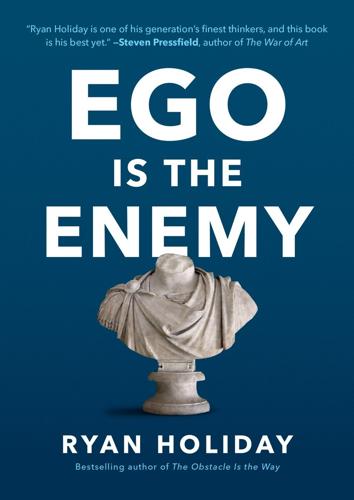
Ego Is the Enemy
by
Ryan Holiday
Published 13 Jun 2016
DON’T BE PASSIONATE You seem to want that vivida vis animi which spurs and excites most young men to please, to shine, to excel. Without the desire and the pains necessary to be considerable, depend upon it, you never can be so. —LORD CHESTERFIELD Passion—it’s all about passion. Find your passion. Live passionately. Inspire the world with your passion. People go to Burning Man to find passion, to be around passion, to rekindle their passion. Same goes for TED and the now enormous SXSW and a thousand other events, retreats, and summits, all fueled by what they claim to be life’s most important force. Here’s what those same people haven’t told you: your passion may be the very thing holding you back from power or influence or accomplishment.
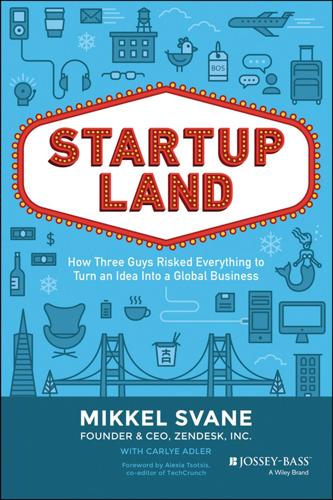
Startupland: How Three Guys Risked Everything to Turn an Idea Into a Global Business
by
Mikkel Svane
and
Carlye Adler
Published 13 Nov 2014
I liked The Warfield, originally built as a vaudeville theater and still one of the coolest concert venues in the Bay Area. I liked the city vibe, and I liked that this was one of the up-and-coming neighborhoods, where rents were still relatively low and where there was a lot of legroom and “heartroom” for new creative businesses. Burning Man had set up headquarters in the area. I knew that technology businesses like Zendesk need creative businesses and inspiration around them in order to evolve. And placing ourselves at what I saw as literally a physical intersection between technology and creativity could only do the business good. 156 Page 156 Svane c09.tex V3 - 10/24/2014 10:32 P.M.
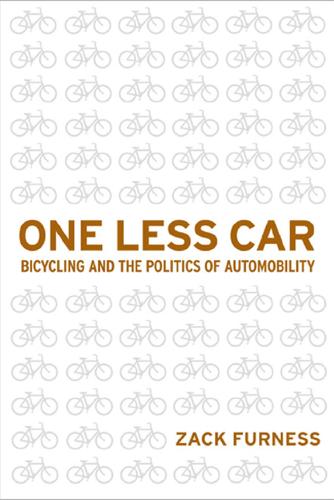
One Less Car: Bicycling and the Politics of Automobility
by
Zack Furness
and
Zachary Mooradian Furness
Published 28 Mar 2010
See Megulon 5, “i Meet the Hard Times Bike Club and live to Tell the Tale,” Chunk 666, October 10, 1997, available at http://www.dclxvi.org/chunk/outside/htbc/ meet.html; C. Bales, “The rat patrol,” in Reglar Wiglar, no. 19 (Chicago: Self-published, 2003). For more on Circus redickuless and the Hard Times Bike Club, see Brian Doherty, This Is Burning Man: The Rise of a New American Underground (new york: little and Brown, 2004), 140–146. Mykle Hansen, “Hell on Wheels,” The Portland Mercury, June 8, 2000. Johnny payphone, “Mutant Bike Culture past and present,” Ghostride Magazine, no. 4 (2006): 23–26; Chris Carlsson, Nowtopia: How Pirate Programmers, Outlaw Bicyclists, and Vacant-Lot Gardeners Are Inventing the Future Today (Oakland, Ca: aK press, 2008), 117.
…
The Independent 70 (april 13, 1911): 775–777. Dixon, leon. National Bicycle History Archive. available at http://nbhaa.com/. Dodge, pryor. The Bicycle. paris: Flammarion, 1996. Doherty, Brian. Radicals for Capitalism: A Freewheeling History of the Modern American Libertarian Movement. new york: public affairs Books, 2007. ———. This Is Burning Man: The Rise of a New American Underground. new york: little and Brown, 2004. Domosh, Mona, and Joni Seager. Putting Women in Place: Feminist Geographers Make Sense of the World. new york: Guilford press, 2001. Donnelly, Thomas Michael. Quicksilver. Columbia pictures Corporation, 1986. Film. Dorgan, Byron l.
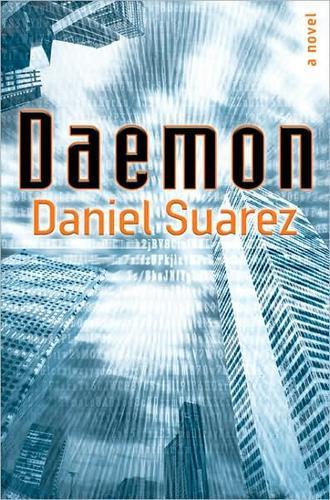
Daemon
by
Daniel Suarez
Published 1 Dec 2006
“Where are you going?” Merritt looked calmly at him. “I’m going to see how that prick deals with flash-bang grenades. Unlock the gaming pit, Major.” The Major appraised Merritt for a moment, then grabbed a radio and headset from a nearby charging station. The man looked as determined as he had in the famous Burning Man images from Sobol’s mansion. He tossed them to Merritt. “Good luck.” The Major watched him exit. Philips turned back to the monitor and keyed the mic again. “Loki, Sobol is using you. What you’re doing is high treason. If you surrender now, I can help you.” “You can help me?” He laughed. “I’m not the one who needs help.
…
The famous Roy Merritt—known to every Daemon operative in the world. The man who tackled Sobol’s home defense system and survived—the entire ordeal captured on Sobol’s security cameras. The one and only Roy Merritt was hanging on to Gragg’s car. Gragg was being pursued—and pursued damned well—by the Burning Man himself. He should have known. The son of a bitch had a knife, and he was doing more damage than a squad of corporate military. Gragg couldn’t deny some level of admiration. Merritt had probed Gragg’s defenses, found a hole—one that would be filled in the future—and improvised an exploit. What hacker couldn’t admire the man’s cojones?
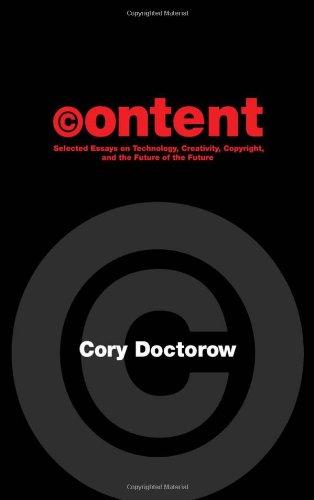
Content: Selected Essays on Technology, Creativity, Copyright, and the Future of the Future
by
Cory Doctorow
Published 15 Sep 2008
boyd, the social scientist who has studied many of these networks from the inside as a keen-eyed net-anthropologist and who has described the many ways in which social software does violence to sociability in a series of sharp papers. Here's one of boyd's examples, a true story: a young woman, an elementary school teacher, joins Friendster after some of her Burning Man buddies send her an invite. All is well until her students sign up and notice that all the friends in her profile are sunburnt, drug-addled techno-pagans whose own profiles are adorned with digital photos of their painted genitals flapping over the Playa. The teacher inveigles her friends to clean up their profiles, and all is well again until her boss, the school principal, signs up to the service and demands to be added to her friends list.

Don't Burn This Book: Thinking for Yourself in an Age of Unreason
by
Dave Rubin
Published 27 Apr 2020
While libertarians err on the side of absolute personal choice here, I believe that some minimal governmental guidelines are appropriate to better ensure we don’t become a nation of addicts. This is where my belief in individual liberty conflicts with the notion of creating a stable, functioning society. Thus the light touch of government. Interestingly, I’d be happy to be proven wrong here. Maybe there is some utopian alternative; perhaps there’s a Burning Man–type city in which every drug known to humankind would be legal and work out just fine. But I suspect not. Until this happens, the best compromise is to remove all federal restrictions and kick everything back to individual states. If some states want to completely declassify everything, then so be it—it’s their choice, just as it’s your choice to leave if you are unhappy with their decision.
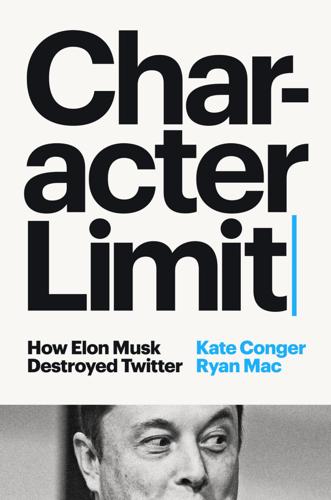
Character Limit: How Elon Musk Destroyed Twitter
by
Kate Conger
and
Ryan Mac
Published 17 Sep 2024
The two men compared the new revamped verification system to the opening up of a country club or the cutting down of VIP ropes at a nightlife hot spot, leading them to name-drop all the exclusive places they had been together. To a group of half-interested engineers, Calacanis name-dropped the Burning Man camp of former Google chief executive Eric Schmidt while Musk casually said they had recently been to actress Bella Thorne’s home. The billionaire left Caracara on Wednesday with a sense of measured success. He had manned the launch like a proud general directing his troops to a beachhead, garnering more than 78,000 signups to the relaunched Blue by that evening.
…
A B C D E F G H I J K L M N O P Q R S T U V W X Y Z A ABC, 156 Abramson, Nelson, 385 Accra, 308–9 acquisitions, 124, 139, 155–56, 160, 219 hostile takeovers, 122, 155–56, 161 nondisclosures in, 161 advertising, 105, 325, 388 on Twitter, 2, 17, 50, 76, 79, 87, 88, 91, 93, 97, 137, 153, 185, 187, 192, 199, 217 Musk’s takeover and, 249–51 revenue from, 217, 281, 291, 292 on Twitter under Musk, 271, 281, 291–92, 297, 301, 313, 320, 345, 350, 364, 406–8 for Apple, 365, 366, 425 content moderation and, 275, 282, 288, 289–91, 302, 320, 338, 339, 357, 365, 366, 418, 419, 425–29 imposter accounts and, 338, 339 meetings with advertisers, 289–92, 294, 301–2 Musk’s political views and, 406, 423–29 revenue from, 294, 320, 325, 330, 339, 340, 354, 357, 365, 380, 381, 388, 401, 403, 409, 417, 419 for SpaceX, 340 Yaccarino and, 417–18 Ukraine war and, 97, 152, 325 Upfronts presentation and, 408 Africa, 35–36, 44, 45, 79 Afshar, Omead, 115, 134 Agarwala, Vineeta, 85, 95, 212 Agrawal, Parag, 46, 55, 77–78, 81–87, 89–93, 94–98, 105, 149, 163, 164, 175, 185, 193–94, 212, 219–20, 258–59, 261, 263, 371 appointed CEO of Twitter, 81–84, 91–92, 94, 95, 106–8, 113, 137, 163, 167, 168, 185, 193, 212 Beykpour and Falck fired by, 186–88, 191, 209 Bluesky project of, 87–88, 90–91, 220–21, 433, 435 bots and spam accounts and, 182–83, 190–92, 225 in coffee meet-and-greets, 219–20 content moderation and, 91–93 Saturn project, 93, 146–48, 172–75, 206, 208, 220–22, 229, 245, 276 cost-cutting plans of, 97–98, 101, 142–43, 148–51, 153, 167 Dorsey and, 78, 81–82, 86, 87, 91, 106, 150, 167, 168–69, 193, 212 education of, 84–85 firing of, 263–66, 343–44 Gadde and, 169–72, 191 Musk and, 85–86, 106–9, 111–12, 114, 116–21, 123–27, 135, 157, 163, 186, 191–92, 193, 212, 215, 251, 263–66, 276, 295, 343–44 Twitter acquisition and, 128, 129, 138, 141–42, 146–52, 158, 163, 164, 167, 169, 171, 174, 180, 185–88, 195–96, 203, 204, 207, 209, 211–12, 221, 222, 225, 229, 234–35, 239, 250–51, 258–59 paternity leave taken by, 95–97, 113, 186 post-Twitter life of, 435 Zatko and, 224, 225 Alemayehou, Mimi, 78 Alexander, Ali, 44, 391–92 alien life, 199 Allen & Company, 212 Allyn, Bobby, 404 Al-Mahmoud, Mansoor bin Ebrahim, 381 Alphabet, 52 Altman, Sam, 435 Al Waleed bin Talal Al Saud, 233–34 Amazon, 86, 87, 158, 356 Web Services, 86, 371 American Express, 44, 294 American Girl, 334 American Jewish Committee (AJC), 418 America Online, 139 Andreessen, Marc, 176, 383 Andreessen Horowitz, 176, 179, 212, 241, 284, 382, 383 Android, 280, 318, 346 Anglin, Andrew, 355 Annecy stabbing attack, 410–11 Anti-Defamation League (ADL), 294, 392, 406, 418–19, 421, 424–25, 427 antisemitism, 392, 406, 418, 419, 424 Musk and, 424–25, 427–29 antitrust law, 139 AOL, 13 Apple, 11, 16, 38, 60, 96, 156, 158, 179 advertising for, 365, 366, 425 App store, 317–19, 333, 365–66 iPhone, 16, 314, 365 iTunes, 14 Apple Park, 366 Arab Spring, 16 Arizona, 338–39 Armstrong, Brian, 179 artificial intelligence, 35, 92, 100, 333, 395, 435 deepfakes, 61–62, 64 OpenAI, 205, 412, 435 xAI, 435 Associated Press, 32 AT&T, 51 Austin, Sheen, 248–50, 256, 267–68, 273, 274, 350, 384–88 B Babylon Bee, 104, 115, 245, 274–76, 340, 354, 375 Baker, Jim, 368–69 Balajadia, Jehn, 239, 241, 279–80, 314–15 banking, 29–31 Bankman-Fried, Sam, 105, 136, 175–76, 179 Bassett, Natasha, 117, 124, 194, 204 BBC, 404 Beckham, David, 381 Beer Hall, 306 Benioff, Marc, 108 Berenson, Alex, 69 Berghain, 109 Berland, Leslie, 44–45, 60, 80, 196–99, 239–43, 280, 289, 295, 298 Beykpour, Kayvon, 46, 55, 72, 76–77, 83, 84, 150, 167 firing of, 186–88, 191, 209 Bezos, Jeff, 124 Biden, Hunter, 67–68, 170, 367 Biden, Jill, 396 Biden, Joe, 65, 67, 68, 73, 104, 139, 368, 391, 393, 396, 321, 434 Bieber, Justin, 118, 285, 290 Biles, Simone, 46 Binance, 179 Binder, Matt, 379 Birchall, Jared, 27, 28, 37, 102, 106, 110, 111, 121, 124–26, 134–36, 155, 156, 175, 178, 179, 191, 241, 260, 261, 298–300, 341–42, 352, 357, 359, 369, 376, 381 birth rates, falling, 205, 213, 214, 389 Bitcoin, 44, 57, 78, 79, 87, 177, 179, 233, 308, 358, 433 Bjelde, Brian, 299 Black, Julia, 205 Blackbirds, 362 Black Lives Matter, 19, 21, 362 BlackRock, 141, 149 Blind, 348 Block, 233 blockchain technology, 87, 90, 119, 134, 179 Blogger, 13, 15 BloodPop (Michael Tucker), 290, 291 Bloomberg, Michael, 177 Bloomberg Businessweek, 24 Bluesky, 87–88, 90–91, 106, 174, 220–21, 413, 433, 435 Boca Chica Village, TX, 423 Bolsonaro, Jair, 317–18, 390 Boorstin, Julia, 420–22 Boreing, Jeremy, 409 Boring Company, 23, 37, 134, 179, 239, 241, 267, 268, 314 Boucher, Claire Elise (Grimes), 23, 95, 100, 124, 204–6, 377 Box, 382 Brand, Dalana, 80, 271, 272 Brazil, 257, 275, 283, 307, 317, 390 Breton, Thierry, 400, 417 Britton, Sam, 157, 159–60 Brown, A. J., 409 Brown, Michael, Jr., 18–19, 183 Buhari, Muhammadu, 75 Burger King, 290 Burning Man, 335 Business Insider, 200, 205, 285 BuzzFeed, 25, 285, 379 C Calacanis, Jason, 134–35, 143, 177–79, 241, 279, 285, 290, 291, 296–98, 313, 317, 335, 378 Caldwell, Nick, 271, 344 Capital Cities, 156 Cardaci, Chris, 374 Carlson, Tucker, 404–6, 424 Catturd2, 390 censorship, see content moderation; freedom of speech Center for Countering Digital Hate, 392 Cernovich, Mike, 104 Chappelle, Dave, 375 Charles Schwab, 284 Chase Center, 171–72, 344, 375 Chen, Jon, 260–63 child sexual exploitation, 16, 20, 92, 146, 372, 392–93 China, 198–99, 244 Christchurch mosque shootings, 42 Christie, Jen, 80 CIA, 27, 173, 183 Clinton, Bill, 223 Clinton, Hillary, 67, 193, 287, 288, 315 CNBC, 406, 408, 420 CNET, 30 CNN, 23, 225, 378 Coca-Cola, 294, 311, 363 CODE Conference, 420–22 Cohen, Lara, 309 Cohn, Jesse, 49–57, 76–78, 110 Coinbase, 179 Coleman, Keith, 173–74 Combs, Sean “Diddy,” 302 Comer, James, 391 Compaq, 29, 156 Confinity, 30 Conger, Kate, 6 Congress, U.S., 57, 58, 59–60, 62, 88, 147, 225, 264 conspiracy theories, 2, 4, 25, 44, 60, 61, 93, 287, 406, 432 Great Replacement Theory, 424 Pizzagate, 25, 104, 390, 426 QAnon, 25, 391, 392, 433 about September 11 attacks, 433 Constitution, U.S., 275, 282, 363 content moderation, 4–6, 13, 15, 146, 206, 435 activist groups and, 294, 320, 392 Digital Services Act and, 244 at Facebook, 92 at Twitter, see Twitter, content moderation at; Twitter under Elon Musk, content moderation at see also misinformation and disinformation Conway, Kellyanne, 65–66 Cook, Tim, 366, 420 Costolo, Dick, 11, 17, 20–21, 42, 149, 170 COVID-19, 53–57, 59, 69–70, 113, 148, 173, 174, 180, 218, 325, 326, 414 misinformation about, 61–64, 68–69, 91, 110, 114, 222, 391 Musk and, 62–64, 99, 114, 128, 136, 375 Tesla and, 63, 96, 99 Twitter and, 53, 56–57, 61–64, 68–69, 77, 83, 90, 91, 97, 98, 185, 186, 255 vaccines for, 68–69, 391 Craft Ventures, 177 Crawford, Esther, 79, 240, 241, 243, 284–86, 297–98, 306, 310–12, 314–19, 323–24, 328–29, 331, 332, 335, 388, 398–99, 402 firing of, 398–99 sleeping photo of, 316 credit card companies, 29–30 crime, 406, 432 Crown Estate, 364 Cruz, Ted, 334, 392 cryptocurrency, 79, 105, 106, 136, 179, 182, 253 Bitcoin, 44, 57, 78, 79, 87, 177, 179, 233, 308, 358, 433 Dogecoin, 141, 144, 179 Culver, Leah, 273–74 D Daily Mail, 373 Daily Stormer, 355 Daily Wire, 408–9 DARPA, 223, 224 data centers, 87, 349, 385–88, 394 Davis, Dantley, 84, 94 Davis, Steve, 134, 241, 260, 261, 267, 271, 279, 283, 298, 324–25, 344, 358–61, 364, 371, 386, 389, 395, 398, 411–12 DealBook Conference, 426–30 deepfakes, 61–62, 64 Delaware, 210, 351, 434 Court of Chancery, 210, 215–18, 232 Division of Corporations, 258 Deloitte, 236 Democrats, 43, 68, 100, 321, 393, 419, 432 Denholm, Robyn, 39 Derella, Matt, 72 DeSantis, Ron, 392 Deutch, Ted, 418 Digital Services Act, 244, 400 disinformation, see misinformation and disinformation Disney, 139, 156, 357, 364, 425, 427–29 diversity, equity, and inclusion, 99–100, 197 Dogecoin, 141, 144, 179 Dominion Voting Systems, 405 Döpfner, Mathias, 104, 115 Dorsey, Jack, 6, 11–17, 22, 84, 102, 114, 150, 153, 163–64, 172, 185, 206, 211, 371, 433 Africa trip of, 44, 45 Agrawal and, 78, 81–82, 86, 87, 91, 106, 150, 167, 168–69, 193, 212 Analyst Day goals and, 76–77 Berland and, 44–45, 196, 239 Bitcoin and, 44, 57, 78, 79, 87, 177, 233, 308, 433 Block company of, 233 Bluesky project of, 87–88, 90–91, 106, 174, 221, 433, 435 Cohn and Elliott Management and, 49–57, 77, 78, 94–95, 106, 120, 150 congressional testimonies of, 57, 58, 59–60 content moderation and, 15, 43, 57, 59–60, 62, 64–75, 91–92 child sexual exploitation material and, 372 early life of, 12 Ferguson protests and, 18–19, 183, 362 in Hawaii, 57–58 health regimen of, 22, 86 LiveJournal posts of, 13 Musk and, 50, 53, 78–79, 105–6, 110, 112, 113, 123, 163 Twitter acquisition and, 123, 142, 143, 163–67, 168–69, 232–33, 308, 432–33 Twitter employee layoffs and, 308, 309 NASA and, 40–41 Nostr and, 382, 433 at Odeo, 13, 14 at OneTeam events, 41–42, 44–48, 55, 86 physical appearance and personal style of, 11–14, 17, 19, 21, 57, 59, 77 politics and, 43, 321 in Polynesia, 69–70, 72 remote work policies and, 53, 57, 336 at Square, 16, 22, 40, 42, 44, 49, 51, 52, 55, 233 Trump ban and, 70–75, 245 as Twitter CEO, 5, 11, 12, 14, 15, 17, 21, 40–42, 49–58, 60, 77–78, 81, 84, 129, 138, 140, 142, 149, 165, 166, 177, 194, 308, 432, 433 resignation as, 79, 80–83, 91, 105, 106, 108, 163–64, 193 Twitter created by, 13–14, 16, 194 Twitter offices toured by, 44 Twitter’s board and, 15–17, 49–51, 53, 73, 77, 78, 81–82, 105, 112, 142, 164, 194, 433 on Twitter’s rebranding as X, 416 Zatko and, 223 Dorsey, Marcia, 21, 45 dot-com bubble, 30 DoubleClick, 81 Dow Chemical, 139 Dowell, Christian, 332, 393 D’Souza, Dinesh, 133 DuPont, 139 Durban, Egon, 54–56, 95, 106–7, 127, 138–39, 143–45, 151, 163, 194–95, 209, 228 E eBay, 31, 51 Eberhard, Martin, 31, 32 economy, 152, 158, 188–89, 204, 336, 364, 388 financial crisis of 2008 in, 160, 325 global, 324, 325, 364 inflation in, 314 Edgett, Sean, 66, 73, 80, 210, 226, 231, 247, 248, 257, 368 firing of, 263–65 Edwards, Jon, 201 elections, 317, 342 in Brazil, 257, 275, 283, 307, 317, 390 in U.S.
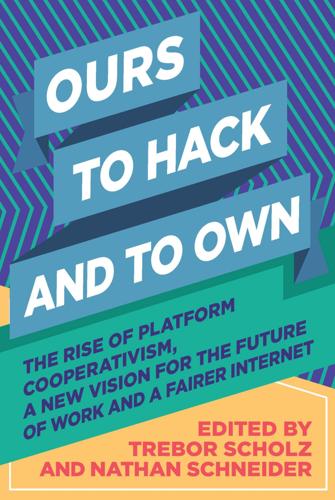
Ours to Hack and to Own: The Rise of Platform Cooperativism, a New Vision for the Future of Work and a Fairer Internet
by
Trebor Scholz
and
Nathan Schneider
Published 14 Aug 2017
Not only were peer-to-peer currencies outlawed, but guilds were disbanded, the commons were privatized, and craftspeople used to being paid for the value they created became wage laborers working by the hour, with no ownership stake in their enterprises. Laugh all you like at the rise of artisanal beers and hand-knitted sweaters, but these seemingly precious throwbacks augur the retrieval of the medieval sensibility as surely as Burning Man, Game of Thrones, and the newly expanded menu of body modifications offered by the piercing place at the mall. We are already retrieving the lost spirit of medievalism in our culture and media. The migration of this sensibility to our economy is next. And necessary. Through the establishment of guilds, such as the Institute of Electrical and Electronics Engineers, technologists are setting their own standards for how they’ll apply their skills—and the price of the NASDAQ is not on their list.

The Secret War Between Downloading and Uploading: Tales of the Computer as Culture Machine
by
Peter Lunenfeld
Published 31 Mar 2011
The emphasis is on producing new and networked objects, and the response was strong enough that Frauenfelder and his coworkers decided that they could expand into producing live events to bring together their community, offering demonstrations and workshops, and growing the number of people interested in these new DIY phenomena. The resulting events, called MAKER Faires, drew from other communities, like the DIYers who have been such a huge part of the Burning Man festival in the Nevada desert, and became social spaces that blended consumption and production, fan and maker, and online interaction with real-life excitement. The point here is less the commercial success and long-term viability of the etsy and MAKE DIY communities than the ways in which their very existence points toward a future of blended real and virtual communities devoted to the material production of culture along with its integration into more open spaces of commerce, trade, and exchange.
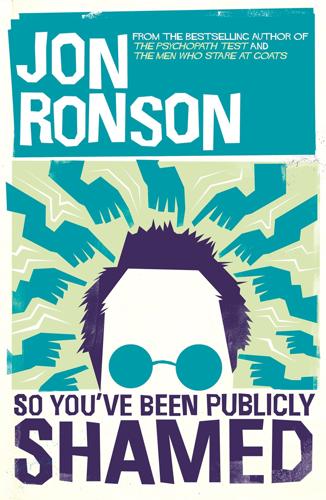
So You've Been Publicly Shamed
by
Jon Ronson
Published 9 Mar 2015
And that was how I discovered a man teaching a course in how to refuse to feel ashamed. 8 THE SHAME ERADICATION WORKSHOP Twelve Americans - strangers to one another - sat in a circle in a room in the JW Marriott hotel in Chicago. There were buttoned-down, preppy-looking businessmen and women, a young Burning Man type drifter couple, a man with a Willie Nelson ponytail and deep lines in his face. In the middle sat Brad Blanton. He was a large man. His shirt, open to his chest, was yellow-white, like his hair. With his sunburned face he looked like a red ball abandoned in dirty snow. Now he stirred. ‘To begin,’ he said, ‘I want you to tell us something that you don’t want us to know.’
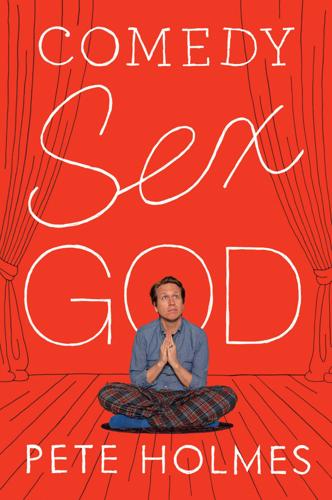
Comedy Sex God
by
Pete Holmes
Published 13 May 2019
Fortunately, just as I was beginning to despair I saw the bright, open, real-life face of Duncan Trussell as he walked into the tent with his girlfriend. I eagerly waved him over, happy to have another comedian with whom we could share our hesitations. I sat him down, whispering conspiratorially, “What are we doing here? This feels like Burning Man. These people look like they make their own soap.” Duncan laughed, but he was into it. “Just wait, man,” he said. “You’ll see.” After sitting quietly through a traditional Hawaiian musical performance that was lovely but seemed to have nothing to do with anything, the room hushed as a young man pushed Ram Dass in his wheelchair into the room.
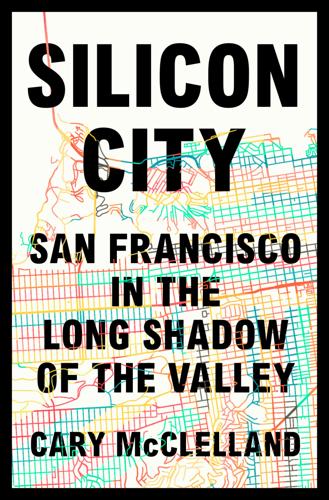
Silicon City: San Francisco in the Long Shadow of the Valley
by
Cary McClelland
Published 8 Oct 2018
And of course there was everything happening in the culture, in politics and technology—the space program. Technology was somehow going to bring us together and allow us a chance to talk, so we can work things out instead of kill each other. All these simplistic ideas drove that mad rush. It was like being in the eye of a hurricane: you can’t feel the impact. I fell into a large group at the Burning Man. They were on fire—their abandon. I just fell madly in love. And I became famous for collecting crazy nerds. The wackier, the better. John Draper, “Captain Crunch,” he’d whistle and simulate these phone signals. He could stand in a phone booth and whistle his way through all these phone systems, go loop the world, and then call the phone booth next to him.

Life Will Be the Death of Me: ...And You Too!
by
Chelsea Handler
Published 8 Apr 2019
If I managed to grab Bert and tried to put a leash on him, he’d flinch or snap as soon as I touched his neck. Tying a leash around a dog’s midsection also doesn’t work, and if you don’t believe me, try it. They were skittish and confused, and where there wasn’t drool on the floor, there was piss. My house smelled like a chamber pot and looked like the grounds of the Burning Man festival, three days after it ended. Once Brandon and Tanner arrived, it was revealed upon further family discussion that not only were these dogs not potty-trained, they hadn’t lived indoors ever. Somewhere along the way, Tanner had forgotten to disclose this little tidbit of information when he was doing their background check.
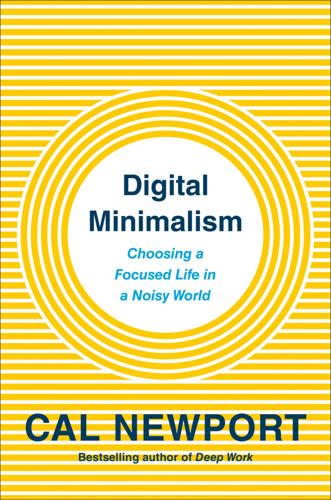
Digital Minimalism: Choosing a Focused Life in a Noisy World
by
Cal Newport
Published 5 Feb 2019
Following this established path, Harris, once sufficiently schooled in the art of mind-device interaction, dropped out of the master’s program to found Apture, a tech start-up that used pop-up factoids to increase the time users spent on websites. In 2011, Google acquired Apture, and Harris was put to work on the Gmail inbox team. It was at Google where Harris, now working on products that could impact hundreds of millions of people’s behaviors, began to grow concerned. After a mind-opening experience at Burning Man, Harris, in a move straight out of a Cameron Crowe screenplay, wrote a 144-slide manifesto titled “A Call to Minimize Distraction & Respect Users’ Attention.” Harris sent the manifesto to a small group of friends at Google. It soon spread to thousands in the company, including co-CEO Larry Page, who called Harris into a meeting to discuss the bold ideas.
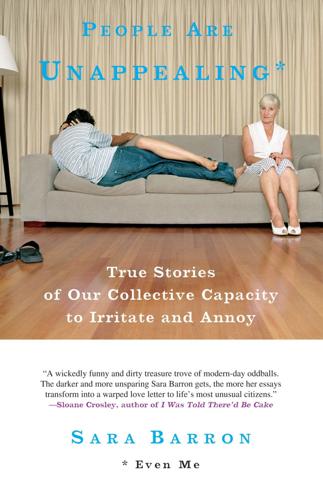
People Are Unappealing: Even Me
by
Sara Barron
Published 10 Mar 2009
You could forget what day it was looking at these things, and until you got used to them, until they ceased to surprise you, it was easy to ignore the other offsetting facets of their owner. You could ignore the fact that judging by the rest of her appearance, Ms. Manishevitz thought she was heading out not for a day teaching drama to children ages eleven to fourteen, but rather to Burning Man or back a few decades to Woodstock. Someplace for hippies to gather and swap rain sticks and chlamydia. Her accessories featured an impressive amount of hemp and highlighted the obvious absence of a brassiere. A tie-dyed bandanna she felt naked without, an array of floor-length peasant skirts that turned transparent in fluorescent light.

The Milky Way: An Autobiography of Our Galaxy
by
Moiya McTier
Published 14 Aug 2022
We had contests to see who could eat the most gas and who could form stars the fastest—the usual youthful debauchery—in part because it was fun to compete, but mostly because we knew that the biggest galaxies were the ones who would survive. Those first few hundred million years were one big, wild, high-stakes party, not unlike your Burning Man. The party was only possible because the universe was so much hotter and denser then than it is now. The average temperature back then was about 50 Kelvin, which is cool even by your standards, but the fast-moving particles of the early universe made it easier to form, swap, and merge material with other galaxies.

Whistleblower: My Journey to Silicon Valley and Fight for Justice at Uber
by
Susan Fowler
Published 18 Feb 2020
“When we first started dating 18 months ago I was going out to a party house in Tahoe and this girl I had just been dating was going to be there but my gf wasn’t. She said sex was sex and it was no big deal if something happened during that weekend.” Oh, God, I thought. This guy can’t be for real. “. . . and I returned the favor when she went to Burning Man.” What the hell? “Honestly, it favors her more than it favors me . . .” How is this guy my new manager? I thought. I looked up from my laptop and surveyed the floor, hoping to spot a coworker or two, looking for anyone I could show these chats to, trying to find someone who could serve as a witness in case Jake continued.

The Breakup Monologues: The Unexpected Joy of Heartbreak
by
Rosie Wilby
Published 26 May 2021
This ethical couple are so respectful to the primary partnership that they even try and ensure that any separations with secondary lovers happen while the other one is away, and preferably uncontactable. They want to avoid bringing in negative energy from the breakup back into their partnership. Diana says, ‘I broke up with someone while Geoffrey was at Burning Man. So that there was no way I would lean on him about it.’ Kathy Labriola is author of The Polyamory Breakup Book. She says, ‘It is very challenging to be fully present physically and emotionally in your remaining relationships when you are so devastated by a breakup with a lover. When you go through a monogamous breakup, you can wallow in self-pity, endlessly processing with your ex about whose fault everything was, spending hours contemplating revenge, hiding in your room crying and cyberstalking your ex and their new lovers on social media, and drinking yourself to sleep every night.
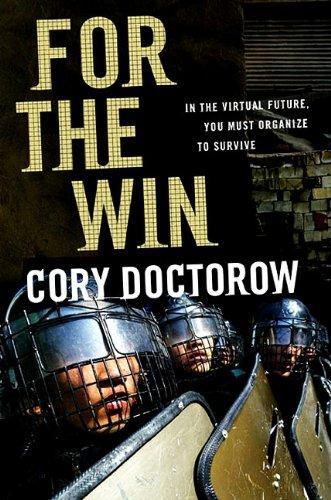
For the Win
by
Cory Doctorow
Published 11 May 2010
The third was outside of San Francisco, in a gigantic ghost-mall that was already being used as a flea-market. They had two former anchor-stores, one of which was being squatted by artists who needed studio space. The other one made a perfect location for a new ride, and the geeks who planned on building it had cut their teeth building elaborate Burning Man confectioneries together, so Perry gave them his blessing. The fourth was to open in Raleigh, in the Research Triangle, where the strip malls ran one into the next. The soft-spoken, bitingly ironic southerners who proposed it were the daughters of old IBM blue-tie stalwarts who’d been running a women’s tech collective since they realized they couldn’t afford college and dropped out together.
…
It’s a lot bigger, you know—and it’s a different division. Really different feel, or so I’m told.” “You kidding? Perry, we came here for your ride. It’s famous, you know.” “Net.famous, maybe. A little.” He felt his cheeks burning. “Well, there will be one in your neck of the woods soon enough.” He told her about the Burning Man collective and the plan to build one down the 101, south of San Francisco International. Kettlebelly returned then with the kids, and he managed to get them into their seats while sucking back a coffee and eating a biscuit from the basket in the center of the table, breaking off bits to shove in the kids’ mouths whenever they protested.

The Bend of the World: A Novel
by
Jacob Bacharach
Published 13 Apr 2014
Someone said, He’s definitely got a problem but I don’t want to say anything because he’d probably just tell me that I do a lot, too, but that’s totally not the point and he knows it. Someone said, Fucking mosquitoes. Someone said, There’s never any food here we should drive down to the gas station who’s coming? Someone said, Who’s Winston Pringle? Someone said, I saw them making out in one of those boxes. Someone said, Last year they lit the whole thing on fire like at Burning Man but I guess maybe it caught someone’s car on fire, too, so this year they’re just doing a regular bonfire. Someone said, This weed sucks have you see Scooty? Someone said, Where the fuck is Mandy? Someone said, I’ve got a job interview there tomorrow but I told them I was going to probably be late or maybe have to miss it and they were all, like, Well, if you miss it you don’t get the job and I just think that’s such bullshit because I have a life, too, you know.

Whiplash: How to Survive Our Faster Future
by
Joi Ito
and
Jeff Howe
Published 6 Dec 2016
What used to take companies three months from factory to store now only took three days—to anywhere in the world. They also went to HAX Accelerator, a hardware incubator in the middle of the market district, which is run by a pair of French entrepreneurs.34 What the group experienced at all of these companies was an entire ecosystem. From the bespoke little shop making fifty blinking computer-controlled Burning Man badges to the guy rebuilding a phone while eating a Big Mac to the clean room with robots scurrying around delivering parts to rows and rows of SMTs—the low cost of labor was the driving force to pull most of the world’s sophisticated manufacturing here, but it was the ecosystem that developed the network of factories and the tradecraft that allows this place to produce just about anything at any scale.

The End of the Suburbs: Where the American Dream Is Moving
by
Leigh Gallagher
Published 26 Jun 2013
Hsieh wants as many of his employees—and those of the other start-ups—to live in the area as possible, and he knows that having good schools is critical, so his team is working on building an early-childhood school set to open later this year. He’s investing in bringing displays of artwork from the Burning Man festival to the area, and his team is developing bike-sharing and car-sharing programs. “The idea went from, ‘Let’s build a campus’ to ‘Let’s build a city,’” Hsieh says over shots of Fernet, the bitter digestif that has become the team’s signature drink, at his new neighborhood’s Cheers equivalent, the Downtown Cocktail Room.
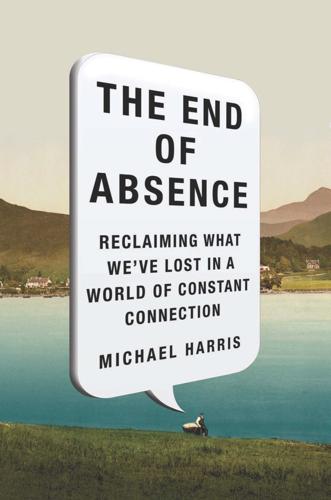
The End of Absence: Reclaiming What We've Lost in a World of Constant Connection
by
Michael Harris
Published 6 Aug 2014
We look up symptoms on Mayoclinic.org but indulge in “natural” medicine; we refuse to obey any church’s laws, yet we want to hold on to some idea of spirituality and read our Eckhart Tolle; we hunch plaintively over our cell phones for much of the year and then barrel into the desert for a week of bacchanalian ecstasy at the Burning Man festival. One friend of mine, who is more addicted to his phone than most, visits a secret traveling sauna once a month located inside a specially outfitted van. He gets naked with a bunch of like-minded men and women and chats about life inside the van’s superheated cabin; then he tugs his clothes back on and reenters his digital life.
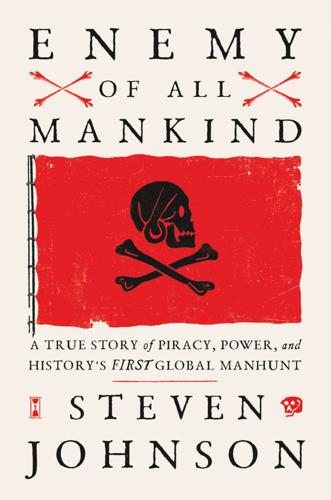
Enemy of All Mankind: A True Story of Piracy, Power, and History's First Global Manhunt
by
Steven Johnson
Published 11 May 2020
(Far more people travel annually during Chinese New Year, but they are distributed in rural regions across China, not converging on a single destination as they do in the hajj.) Each year, the Saudis erect an immense pop-up city outside Mecca consisting of 160,000 air-conditioned fiberglass tents, each housing fifty pilgrims, a desert settlement that makes the temporary housing of Burning Man look like a shantytown. Because the Islamic calendar follows a lunar cycle, each Islamic year is approximately eleven days shorter than a year following the Gregorian calendar, which means that the actual timing of the hajj shifts backward from year to year. Measured by a Western calendar, a hajj that begins January 1 would be followed the next year by one that commences on December 20.

I'm Judging You: The Do-Better Manual
by
Luvvie Ajayi
Published 12 Sep 2016
They think because they have that one boss who is a woman, we’ve made enough progress. They know that one person who didn’t take her husband’s last name, and he doesn’t even care! We can pack it in! Those people are lying to themselves, but they’re not as bad as the people who hear the word “feminist” and think of a caricature version of the bra-burning man-hater whose purpose is to tear down all men. (Most feminists I know love our bras for keeping our nipples from telling everyone the weather.) Way too many people have come to think of feminism as the belief system of hating or emasculating men. Misandry is not feminism, and if an eye for an eye makes the world go blind, we will all need service dogs if we try to fight hate with more hate.
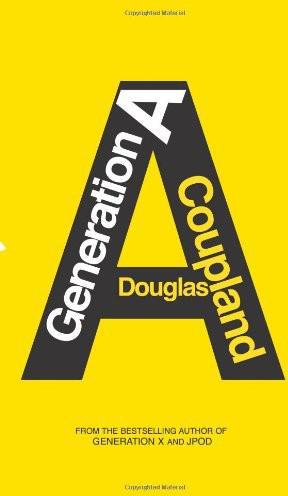
Generation A
by
Douglas Coupland
Published 2 Jan 2009
As Karen left the lunchroom, Lydia said to her coworkers, “People always seem to fall in love during that magical space before one person sees the other display their signature crazy behaviour. Poor Karen.” But Karen’s heart mended from her break with Bartholomew, and within two years she was engaged to a guy who made sculptures out of cardboard boxes, which he took to the Burning Man festival in the Nevada desert. And life went on. Bartholomew grew older and buggier. People stopped using land-line telephones altogether. Everyone on earth used PDAs, even starving people in starving countries. All languages on earth collapsed and contracted and Bartholomew’s endgame scenario was coming true—language was dying.

Complete Guide to Fasting: Heal Your Body Through Intermittent, Alternate-Day, and Extended Fasting
by
Jimmy Moore
and
Jason Fung
Published 18 Oct 2016
Meet the FASTING ALL-STARS ABEL JAMES Abel James is a New York Times bestselling author and modern-day Renaissance man. He stars as a celebrity coach on ABC Television and has been featured in People magazine, WIRED, Entertainment Tonight, and NPR. As host of the number one podcast in more than eight countries, Fat-Burning Man, Abel has helped millions reclaim their health and perform at their best with cutting-edge science, outdoor workouts, and outrageously good food. Abel has keynoted for the federal government, lectured at Ivy League universities, and advised Fortune 500 companies, including Microsoft, Danaher, and Lockheed Martin.

USA Travel Guide
by
Lonely, Planet
Wildflower Village MOTEL $ ( 775-747-8848; www.wildflowervillage.com; 4395 W 4th St; r $50-75, B&B $100-125; ) Perhaps more of a state of mind than a motel, this artists colony on the west edge of town has a tumbledown yet creative vibe. Murals decorate the facade of each room, and you can hear the freight trains rumble on by. BURNING MAN For one week at the end of August, Burning Man (www.burningman.com; admission $210-320) explodes onto the sunbaked Black Rock Desert, and Nevada sprouts a third major population center – Black Rock City. An experiential art party (and alternative universe) that climaxes in the immolation of a towering stick figure, Burning Man is a whirlwind of outlandish theme camps, dust-caked bicycles, bizarre bartering, costume-enhanced nudity and a general relinquishment of inhibitions.
…
You’ll find country crooning, wondrous carvings (in butter), livestock shows, sprawling food stalls and a down-home good time in America’s heartland. Runs over 10 days in mid August. September With the end of summer, cooler days arrive, making for pleasant outings nationwide. The kids are back in school, and concert halls, gallery spaces and performing arts venues kick off a new season. BURNING MAN FESTIVAL Over one week, some 50,000 revelers, artists and assorted free spirits descend on Nevada’s Black Rock Desert to create a temporary metropolis of art installations, theme camps and environmental curiosities. It culminates in the burning of a giant stick figure (www.burningman.com; Click here).
…
There’s no legally mandated closing time for bars, so get ready to see sequin-clad grandmas in the casino, beers in hand and trading dollars for blackjack chips, at 2am. Nevada banks on what people really want. Wherever you travel in the Silver State, just remember that Nevada is weird. Witness the peaceful riot of self-expression at Burning Man, try to spot alien UFOs, visit atomic-weapons testing grounds and drive the ‘Loneliest Road in America’: they’re all part of this surreal, unforgettable landscape. Information Prostitution is illegal in Clark County (which includes Las Vegas) and Washoe County (which includes Reno), although there are legal brothels in many of the smaller counties.

Before Babylon, Beyond Bitcoin: From Money That We Understand to Money That Understands Us (Perspectives)
by
David Birch
Published 14 Jun 2017
London: Guardian Books. Pantaleone, W. 2014. Italy seizes 556,000 euros in fake coins minted in China. Daily Mail, 12 December. Peck, M. 2013. Ripple credit system could help or harm Bitcoin. IEEE Spectrum, 14 January. Pentland, A. 2014. Social physics and the human centric society. In From Bitcoin to Burning Man and Beyond (ed. D. Bollier and J. Clippinger), pp. 3–10. Boston, MA: ID3. Perez, C. 2005. The changing nature of financial and institutional innovations. In Technological Revolutions and Financial Capital, pp. 138–151. Cheltenham: Edward Elgar. Postman, N. 1993. The judgement of Thamus.
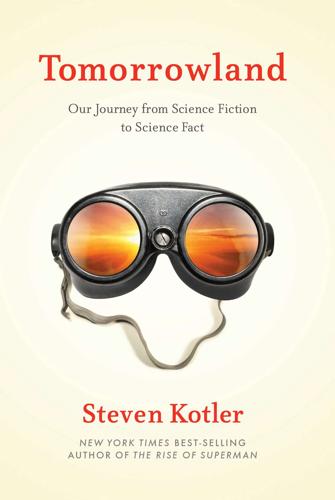
Tomorrowland: Our Journey From Science Fiction to Science Fact
by
Steven Kotler
Published 11 May 2015
A week after checking out of the hospital, as June sweeps into July, at 10:45 a.m., Mara drops 140 mgs of MDMA, adding a booster pill of another 55 mgs about an hour later. “Buy the ticket,” said Hunter S. Thompson, “take the ride.” 6. Rick Doblin is fifty-six years old, with a strong, stocky frame, curly brown hair, a wide forehead, and a face creased with laugh lines. His demeanor is mostly high school guidance counselor, though his stories are often Burning Man. He was born Jewish, in Oak Park, Illinois, and raised, he says, “under the shadow of the Holocaust.” This produced a teenager who eschewed sports and girls for books about civil disobedience. At fourteen, he had already devoted his life to social justice. By sixteen, he’d decided to become a draft resister, meaning he would always have a criminal record and “couldn’t be a lawyer or a doctor or do most of the things a good Jewish boy was supposed to do.”
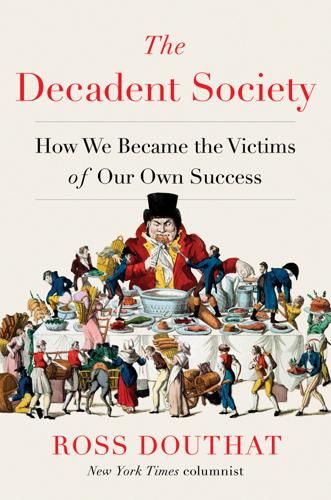
The Decadent Society: How We Became the Victims of Our Own Success
by
Ross Douthat
Published 25 Feb 2020
For that to happen, not only would there have to be some syncretistic convergence at the popular level between Oprah devotees, practicing Hindus, and would-be druids and shamans, but the highbrow pantheists—the intellectuals and tastemakers—would need to embrace a clearer cultic aspect for their faith, a set of public rituals of the kind we associate with, say, classical Roman devotions, as opposed to just private experiences with ’shrooms or meditation. (Burning Man almost gets you there, but not quite…) Maybe that’s impossible; the Western intelligentsia tiptoed in that direction in the spoon-bending, “What’s your sign?” days of 1970s religion, but nowadays our intellectuals seem embarrassed by anything too frankly supernaturalist, and our Silicon Valley overlords prefer to launder their religious impulses through techno-utopianism rather than New Age rituals.
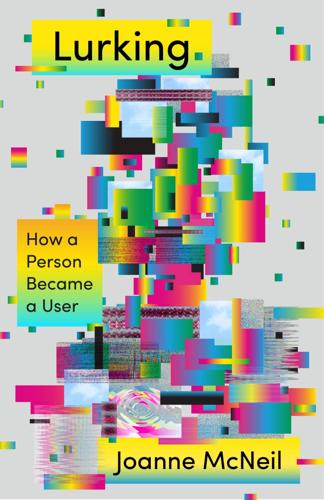
Lurking: How a Person Became a User
by
Joanne McNeil
Published 25 Feb 2020
But contrast these recent statements with what was written in a 2003 New York Times profile of danah boyd: “Friendster is trying to cut off any behavior that is not in line with their marketing perspective and the idea that this is a dating site,” boyd told the Times. “He didn’t want to know anything that would help user experiences unless it has to do with dating … At another point he told me that it was my type of people who were ruining the system, meaning the Burning Man, freak, San Francisco crowd” (Jonathan Abrams, Internet History podcast, September 19, 2016; Michael Erard, “Decoding the New Cues in Online Society,” The New York Times, November 27, 2003). The quote about Friendster as a “way to surf through [Abrams’s] friends’ address books for good-looking girls” comes from another New York Times story (Gary Rivlin, “Wallflower at the Web Party,” October 15, 2006).

The Buddha and the Badass: The Secret Spiritual Art of Succeeding at Work
by
Vishen Lakhiani
Published 14 Sep 2020
And when we get it in the workplace, life and work fuse together seamlessly. As the founder of a company in personal growth, I witness over and over how people struggle alone with thoughts and experiences that are universal. I’ve experienced hundreds of transformational events where people connect more deeply than they usually do in public—from Burning Man to A-Fest to Mindvalley University. It’s magical when groups are given permission to share authentically. That’s when our insecurities, challenges, weirdnesses even, dissolve. This allows people to shift from feeling alone, confused, and fearful to feeling supported, understood, and fearless. Social bonds are the number one variable that raises a person’s physical health, mental state, and day-to-day performance.

Listen, Liberal: Or, What Ever Happened to the Party of the People?
by
Thomas Frank
Published 15 Mar 2016
3 The connection between counterculture and corporate power was a typical assertion of the New Economy era, and what it implied was that rebellion was not about overturning elites, it was about encouraging business enterprise. I myself mocked this idea in voluminous detail at the time. But it did not wane with the dot-com crash; indeed, it has never retreated at all. From Burning Man to Apple’s TV commercials, it is all over the place today. Think of the rock stars who showed up for Facebook billionaire Sean Parker’s wedding in Big Sur, or the rock ’n’ roll museum founded by Microsoft billionaire Paul Allen in Seattle, or the transformation of San Francisco, hometown of the counterculture, into an upscale suburb of Silicon Valley.

Infinite Detail
by
Tim Maughan
Published 1 Apr 2019
The sound systems are out, dotted here and there like alien monoliths, bass resonating through the architecture. People are dancing, talking, sitting. Smoke rises from makeshift fires and barbecues. Here and there tents have been thrown up by those who won’t or can’t leave. Pure carnival vibes. It’s somehow both friendly and apocalyptic, welcoming and tense at the same time, like Glastonbury Festival or Burning Man dropped into an urban space too cramped and ill-designed to safely hold it. “Have you seen the chat recently?” Rush is continuing. “Looked at the public timelines? It’s a fucking mess. It’s just full of randoms screaming at each other. It’s impossible to follow anything, impossible to make announcements, get information out … It’s a fucking mess.
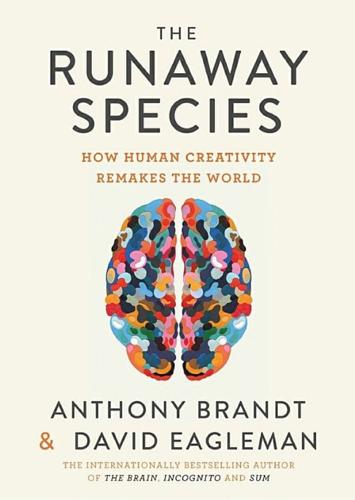
The Runaway Species: How Human Creativity Remakes the World
by
David Eagleman
and
Anthony Brandt
Published 30 Sep 2017
John Gardner’s novel Grendel retells the epic poem Beowulf from the vantage point of one of the monsters. Taking myths and fables from around the world, students can shift points of view to make something new. Another strategy is to update stories. In Tim Manley’s Alice in tumblr-land, King Arthur parties at Burning Man, Thumbelina stars in a reality TV show, and the Frog Prince sits in a park wearing a sign that says “Free Hugs.” Alternate histories are another technique for honing intelligent intuitions by extrapolating creatively from what students have learned. Kingsley Amis’ novel The Alteration imagines what modern times would be like if Henry VIII had never ruled England.
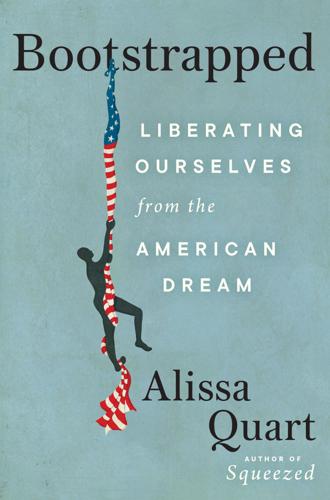
Bootstrapped: Liberating Ourselves From the American Dream
by
Alissa Quart
Published 14 Mar 2023
Because she helped define how certain moneyed classes think about their power and was one of the premier faces on the proverbial postage stamps of tech individualism. Her effect could be said to be Alger 2.0, and as with Alger, her favored vehicle for transmitting this American archetype was pulp fiction. Her contemporary followers are legion and include the King-of-the-NASDAQ-by-way-of-Burning Man Travis Kalanick, cofounder of Uber, who had the cover of a Rand book as his Twitter avatar, as well as the founder of Snapchat, Evan Spiegel, and Twitter’s Jack Dorsey. Lisa Duggan, in her account of Rand entitled Mean Girl, writes that the most “influential figure in the industry, after all, isn’t Steve Jobs or Sheryl Sandberg, but rather Ayn Rand.”
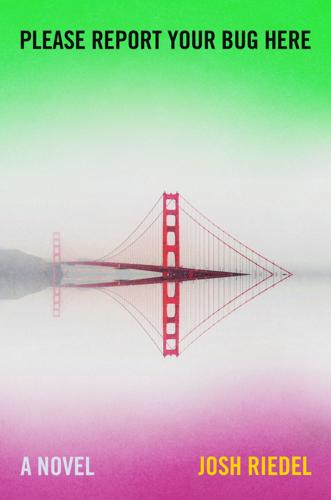
Please Report Your Bug Here: A Novel
by
Josh Riedel
Published 17 Jan 2023
I walked down 7th Street, past the Pentecostal Way of Truth, and hung a left after the post office. In the parking lot outside the warehouse, a dozen or so Yarbons mingled. Everyone wore work pants like mine, except theirs were paint-splattered or grease-stained. Is this what it means to be alternative in the tech industry? To hack in Oakland, not Palo Alto, and to wear vintage Burning Man T-shirts instead of company swag? I worked my way through the crowd, hoping no one noticed me. I caught snippets of a conversation about hacking a sewing machine. A woman with a circuit diagram tattooed across her chest poured pints of kombucha from a keg, while others lined up for lunch at a taco truck on the lot’s edge.
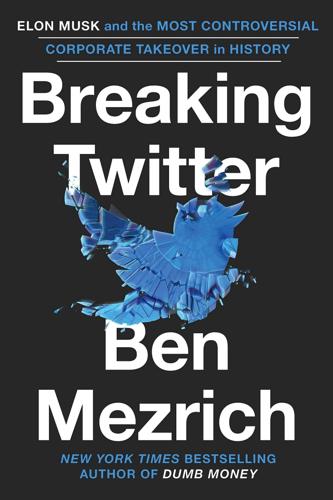
Breaking Twitter: Elon Musk and the Most Controversial Corporate Takeover in History
by
Ben Mezrich
Published 6 Nov 2023
All that money, and power, and all those people who circled around him—yet he seemed so completely alone in that big glass conference room, with just his phone as company. She thought back to a conversation they’d had a few weeks earlier, in the heat of restructuring Twitter Blue. It had just been the two of them, and they had been talking about family, about how they’d both gone to Burning Man and it had made them think hard about their place in the world, and where they came from. Elon had told her that his older kids, his teenagers, didn’t like to hang out with him. Although she was very close to her own kids, she knew that teenagers could be difficult. But this was Elon Musk, a man who made self-driving cars and rocket ships and flamethrowers, who dug tunnels under Las Vegas and was going to put a man on Mars.
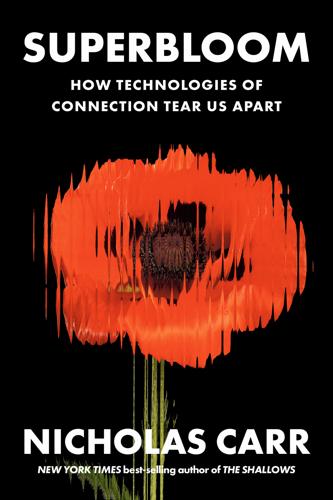
Superbloom: How Technologies of Connection Tear Us Apart
by
Nicholas Carr
Published 28 Jan 2025
One high school teacher Boyd interviewed related the shock she felt when some of her students came up to her in class one day and asked why she liked to do drugs. It turned out they had joined Friendster, discovered her profile, and read some conversations she’d had with friends about attending a Burning Man festival.17 As people came to realize that the versions of themselves they presented to different sets of acquaintances could no longer be kept separate—the audience was a jumble now—they grappled with a new sort of identity crisis. How do you speak to everyone at once? How do you shape a self fit for mass consumption?
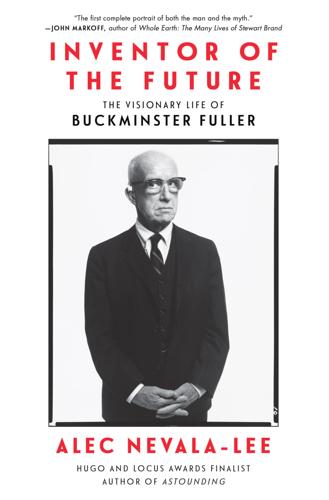
Inventor of the Future: The Visionary Life of Buckminster Fuller
by
Alec Nevala-Lee
Published 1 Aug 2022
Aside from issues with leaks, they would be difficult to connect or expand, and tensional forces would cause most large domes to rip themselves out of their foundations in low gravity. On earth, the dome endured in popular culture, but it had relatively few practical applications. Apart from playgrounds, it could be seen at the annual Burning Man festival and in scientific projects that benefited from its advantages in cold climates, as well as in more doubtful settings. A glass sphere loomed over a factory that the Taiwanese technology company Foxconn promised but failed to establish in Wisconsin, while the notorious Fyre Festival offered lodging in “geodesic domes”—although they were actually repurposed tents from the Federal Emergency Management Agency.
…
airport project and, 390 in Carbondale, 366–367, 382 Design Science Institute and, 414 Designing a New Industry and, 200 on Fuller, 438 on Fuller’s alcohol use, 334 on Fuller’s fears, 415 Presidential Medal of Freedom and, 443 recruitment of, 199 resignation of, 205 on solar energy and Fuller’s diet, 333 Synergetics and, 367, 391–392, 393–394, 397–398, 399, 400–401, 433 Archigram, 367 Architects Club, 103 Architectural Design, 315 Architectural Forum, 173, 235, 255, 263, 269 Architectural League of New York, 58, 80, 117 Architectural Record, 160 Armour & Company, 51–52, 61, 70–71, 74 Armstrong, Edwin Howard, 171 Armstrong, Neil, 363 Arnold, John E., 5 Arnstein, Karl, 508n112 Around the World in 80 Days, 287–288 Arrow Plane, 142 ArtCenter College of Design, 431 Arts & Architecture, 193 Artzybasheff, Boris, 323 Asawa, Ruth, 231–232, 237, 310, 410, 432 Asbury, Keith, 441 Asimov, Isaac, 590n419 Aspen Design Conference, 469 aspension dome, 312–313, 316 Astor, John Jacob, IV, 76 Astor, Vincent, 76–77, 81, 114, 499n70 Atkinson, Brooks, 43 Atkinson, Edward W., 46–47, 48 Atkinson, Haserick & Co., 46 “Atomic Buckalow,” 224 Atwood, Leland, 112, 152, 199, 227 Auchincloss, Douglas, 323–324 Auchincloss, Lily, 323 “auto-airplane,” 113 Automatic Machine Company, 140 automation, 474 Autonomous House, 438, 446 Autonomous Living Package, 235, 260 Baer, Steve, 334–335, 355–356, 368 Baird, Bil, 161, 164, 183, 435 Baird, Patrick, 248, 252, 408 Baker, Newton D., 69 Balanchine, George, 214 Baldwin, Jay, 368–369, 441, 468, 514n132 ball clock, 221 “Ballistics of Civilization” (Fuller), 169 Banham, Reyner, 293 Barcroft, Taylor, 1–3 Bardacke, Gregory, 193, 194, 205 “bare maximum” concept, 363 Barr, Alfred, 175–176 Basing, Charles, 80 Bass, Ed, 470 Bassett, John, 354 bathroom project, 160–161, 160fig, 162–164, 220 Battiste, Roy, 373 Battlestar Galactica, 387 Bauersfeld, Walther, 244 Bauhaus school, 81, 115, 129, 220, 229, 274 Bayer, Herbert, 189, 540n238, 564n266 Bear Island, Maine Alexandra and, 72 Allegra and, 117 ecological threats to, 389 Fuller on, 27–28, 28fig, 29, 30, 32–33, 34, 62, 71, 76, 117, 123, 128, 293, 349, 381 Lacey on, 214 loss of share of, 154 renting out of, 173 Tomkins on, 331–332 Beard, Marjorie, 62 Beatty, Warren, 347–348 Beaux Arts Ball, 58, 124 bebop, 234 Becker, Sal, 373 Beckett, Samuel, 364, 365, 370 Beckett Theatre, 364–365, 377–378, 404 Bedford, Gladys, 72 Beech, Walter, 195–196 Beech Aircraft, 193–194, 197, 207, 210 Béhar, Yves, 12, 469 “Being with Bucky,” 408, 410 Beirn, Ken, 183, 192 Bel Geddes, Norman, 154, 278–279 Bell, Alexander Graham, 256–257 Bell Telephone, 157 Bellinger, Patrick, 64, 65, 66, 137 Ben-Eli, Michael, 336, 373–374, 384, 391 Benshetrit, Dror, 471 Benson Manufacturing of Missouri, 186 Berger Brothers, 288 Bernofsky, Gene, 334, 335 Bertalanffy, Ludwig von, 554n296 Better Homes and Gardens, 286 Beyond the Horizon (O’Neill), 70 Bezos, Jeff, 472 Biddle, Anna “Nannie,” 136, 138–139, 140, 141, 143–144, 148, 154 Big House, Bear Island, Maine, 30 biohacking, 11 biology, Fuller’s interest in, 316–317 Biosphere, 410 Biosphere 2, 470 Black Mountain College, 227–233, 230fig, 237–243, 239fig Blake, Peter, 234, 301–302, 328 Blouke, Pierre, 110 Blue Hills Reservation state park, 25 Board of Economic Warfare (BEW), 180–181, 182, 183, 192 Bodky, Erwin, 232 Boggs, Samuel Whittemore, 185 Bonenkamp, Nettie, 94, 95 Bonnie and Clyde, 347–348 Borland, John Nelson, II, 93 Boudreau Machine and Tool Company, 139 Boy-Ed, Karl, 60–61 Bragdon, Claude, 111 Braggiotti, Mario, 168 brain/mind distinction, 355 Brancusi, Constantin, 120, 121 Brand, Stewart Clock of the Long Now and, 472 on dome, 400 in Fuller’s classes, 338 Fuller’s legacy and, 366 on Great Depression, 120 Joint Computer Conference and, 357–358 Kahn and, 368 meeting with in California, 338 as outlier, 359 Whole Earth Catalog and, 4, 356–357 whole earth photo and, 352–353 Brave New World (Huxley), 387 Brazil, 188, 189 Breath (Beckett), 370 Breck, John, 183 Breines, Simon, 129 Brenneman, Richard J., 596n432 Brewer, Kidd, 252 Brezhnev, Leonid, 375 Bridges, Jeff, 467 British Commonwealth Scientific Office, 191 Brokaw, Clare Boothe (later Luce) Hale and, 167–168 later interactions with, 183, 193, 438 Milan Triennale and, 271, 547n272 Presidential Medal of Freedom and, 443 relationship with, 149–151, 169 Vanity Fair and, 134–135 Bromberg, Manuel, 236, 257, 547n269 Brook Farm, 38 Brooklyn Dodgers, 278–280 Brooks, Jefferson Davis, III, 282 Brooks, Louise, 98 Browall, Harold, 154 Brown, Howard, 388, 412, 440, 468 Brown, Jerry, 400, 435 Brownjohn, Robert, 234 Bryan, Joseph “J.,” III, 504n95 Bryn Mawr College, 383, 449 Bubble House, 252, 259 Buck, Pearl S., 593n426 Buckley, William F., Jr., 382 Buckminster Fuller: An Autobiographical Monologue/Scenario (Fuller), 433 Buckminster Fuller: At Home in the Universe (Hatch), 398 Buckminster Fuller Institute, 468, 589n415 Buckminster Fuller Reader, The (Fuller), 370 Buckminster Fuller to Children of Earth (Fuller), 384 Buckminster Fuller’s Universe (Sieden), 16 buckminsterfullerene, 9, 462–467, 465fig Bucky (Kenner), 389–390 buckyball. See buckminsterfullerene Buffington, George N., 114 Bundy, McGeorge, 316, 322 Burgess, Frederick V. “Bunny,” 85, 86 Burgess, Starling, 34, 132, 139–144, 148, 152 Burklyn Business School, 437 Burning Man, 471 Burns, Robert, 32 Burr, Laurence Hewlett, 74, 75 Burr, Robert, 75, 79 Burroughs, William S., 320 Burstyn, Ellen, 435–436, 449 Burton, Isabel, 92 Burton, Richard, 322, 404 Burton, Richard Francis, 92 Bush, Vannevar, 191 Butler Manufacturing of Missouri, 173–174 Butts, Don, 408 Butts, J.

The Sharing Economy: The End of Employment and the Rise of Crowd-Based Capitalism
by
Arun Sundararajan
Published 12 May 2016
—Lewis Hyde, The Gift, 49 It is May 2015, and I’m contemplating the future of capitalism at OuiShare Fest, a gathering in Paris with a decidedly non-capitalist vibe.1 Over a thousand sharing-economy enthusiasts have gathered in and around the main venue, a giant red tent called Cabaret Sauvage, for a celebration that feels part TED, part Burning Man, and part Woodstock. I’m sitting outdoors enjoying the springtime sun with two of the founders of OuiShare and eating my conference-provided lunch, a bowl of organic lentils and beets. Behind me, preparations are afoot for the Love Fest, an all-night party that brings the three-day event to a close.
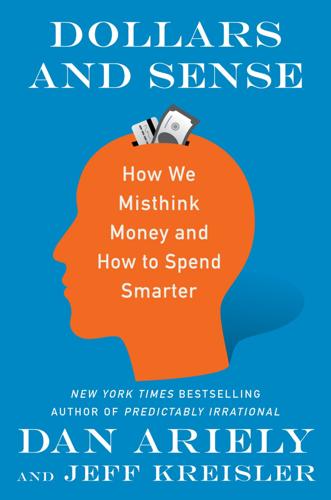
Dollars and Sense: How We Misthink Money and How to Spend Smarter
by
Dr. Dan Ariely
and
Jeff Kreisler
Published 7 Nov 2017
This pattern has not escaped the attention of some businesses. Prepayment has become trendy. Fancy restaurants like Trois Mec in Los Angeles, Chicago’s Alinea, and New York’s Atera are now encouraging customers to prepay for meals online. But prepaying isn’t just a trend, it’s all around us. We buy Broadway tickets, airfare, and Burning Man passes well before we use them. Heck, you paid for this book before you consumed it, rather than waiting to finish the last page (at which time you’ll likely want to send us a thank-you note with a substantial tip). If we pay for something before consuming it, the actual consumption of it feels almost painless.
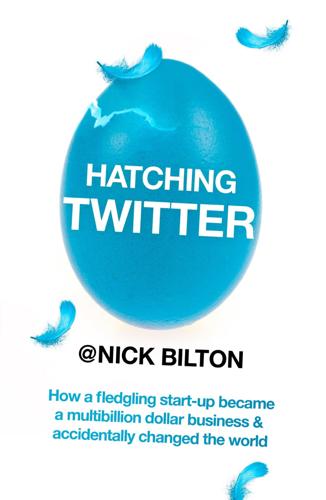
Hatching Twitter
by
Nick Bilton
Published 5 Nov 2013
As of a few minutes ago, he might have become the only person he trusted in San Francisco. The two had worked together in the past, and although a business they had once started in partnership had ended with near bloodshed, Kidd had always been there for Jack. In 2005, after Jack had spent a week at Burning Man, traipsing through Black Rock City and dancing inebriated until sunrise to techno music, he had shown up on Kidd’s doorstep in Berkeley, jobless and essentially homeless. He had been a different Jack back then, sporting blue dreadlocks and grimy clothes. Still, Kidd had taken him in and let him stay in the guesthouse in the backyard.
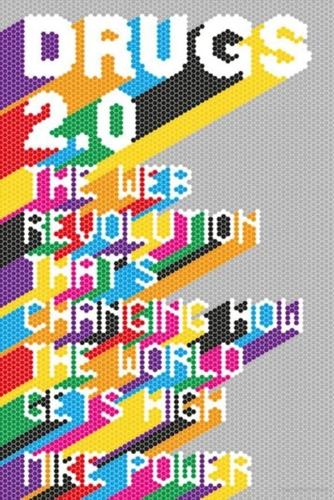
Drugs 2.0: The Web Revolution That's Changing How the World Gets High
by
Mike Power
Published 1 May 2013
It’s horrible but you might like it.’ Hardly a recommendation. But I’m a curious type. I’ve taken my fair share of pills and powders in two decades of drug-taking, with Ecstasy, cocaine and ketamine regularly on the menu, as well as the occasional acid or mushroom trip. I even did DMT once, and rattled around Burning Man 2005 guzzling the postcode drugs (2C-B, 2C-E and their chums). I asked my mate more. Turns out it was something synthetic. ‘One of those new ones, off the net,’ he said. The important thing was to only do a tiny amount. He stressed this: ‘Just half what you’d do if it was K.’ I knew about the new synthetics and I knew dosage was a serious thing: overdo it even a little and you’d be cabbaged or worse.

Peers Inc: How People and Platforms Are Inventing the Collaborative Economy and Reinventing Capitalism
by
Robin Chase
Published 14 May 2015
Profiles could also include a very short audio clip (telling us, say, what you had for breakfast, or a joke) because we had learned from research that people are more likely to trust someone if they can hear the other person’s voice. People could form groups that either would be open to all (the Burning Man group, the rock climbing group, the IKEA group) or private (the Arlington youth soccer group), and trips could be broadcast easily to the entire group. You could create trip alerts so that if anyone was ever going between your neighborhood and IKEA, or New York, or Walden Pond, you would know about it.
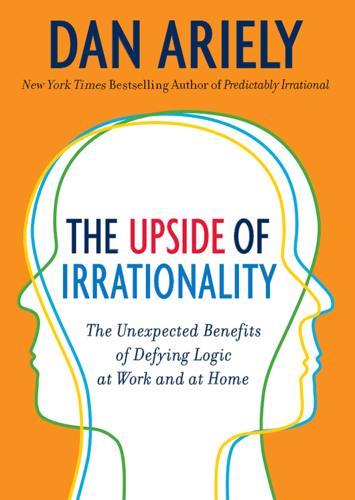
The Upside of Irrationality: The Unexpected Benefits of Defying Logic at Work and at Home
by
Dan Ariely
Published 31 May 2010
(If you happen upon another Gneezy on my list of collaborators, this is not because it is a popular last name.) Uri Gneezy Uri is one of the most sarcastic and creative people I have ever met. Both of these skills enable him to turn out important and useful research effortlessly and rapidly. A few years ago, I took Uri to Burning Man, and while we were there he completely fit into the atmosphere. On the way back he lost a bet and, as a consequence, was supposed to give a gift to a random person every day for a month. Sadly, once back in civilization he was unable to do so. Uri is currently a professor at the University of California, San Diego.
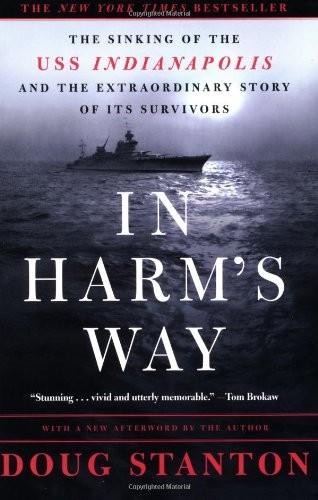
In Harm's Way: The Sinking of the U.S.S. Indianapolis and the Extraordinary Story of Its Survivors
by
Doug Stanton
Published 2 May 2003
Dropping their syringes and rolls of bandages, Haynes and Schmueck ran across the deck and up a ladder to the next deck, which led to the number-one smokestack and several gun mounts. Here, boys were cutting down life vests and passing them out to a constant flow of men. Haynes grabbed as many as he could, and then he and Schmueck ran back down the ladder to their writhing patients. Haynes approached the burned man with the wings for skin. As he loosely tied the canvas straps around the man, he kept telling him, “I have to do this. I have to do this. Oh Christ, I have to do this.” The man screamed as Haynes pulled the vest snug. And then Haynes turned his attention to the next wounded man. Working steadily by the weak light of an intermittent moon, he tried his best as his heart broke.
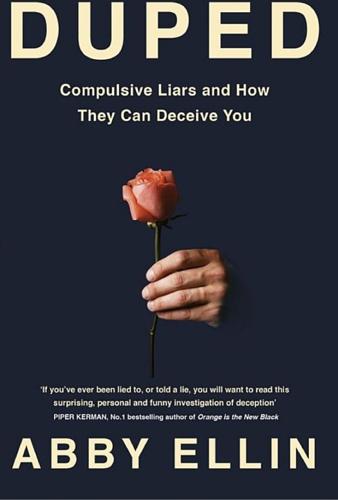
Duped: Double Lives, False Identities, and the Con Man I Almost Married
by
Abby Ellin
Published 15 Jan 2019
Excitement! And yes, love. Grown-up love. Not backbreaking, mind-numbing passion, which tends to induce craziness. But life-mate kind of love. The kind of love on which foundations are built. The beauty of it was that he wasn’t the sort of man I usually went for, which is to say he didn’t know a Burning Man from a burning bush, nor did he care. He (non-ironically) liked the music of the 1970s Muzak band Bread. He was up at 5:00 a.m. As far as I’m concerned, nothing good happens before 10:00. I worried about our different nocturnal habits. But compromise is key, right? The person you end up with is rarely the person you thought you’d end up with.

SAM: One Robot, a Dozen Engineers, and the Race to Revolutionize the Way We Build
by
Jonathan Waldman
Published 7 Jan 2020
He aspired to prove SAM’s worth without the Silicon Valley VCs. Venture capital money might have been green, but to Scott, it was poisonous. He wanted to maintain his modesty, remain the underdog, and make things the way Americans once did—the way his grandfather had. He wanted to thrive without the hype—without Burning Man—and end up more successful than people realized. As such, with friendly funding, the redesign commenced, and the Alpha machine was dropped as the Beta machine was developed. Don Golini, who had found insights in The Innovator’s Dilemma and Crossing the Chasm, knew that Scott had to devote as much effort toward sales as to engineering.

The Rationalist's Guide to the Galaxy: Superintelligent AI and the Geeks Who Are Trying to Save Humanity's Future
by
Tom Chivers
Published 12 Jun 2019
This doesn’t appear to have been a cult-leader invention enforced from the top by Eliezer Yudkowsky; Paul Crowley thinks that ‘the group house phenomenon is just a necessity given the Bay housing situation’ (house prices there being, to my amazement, comparably extortionate to London), which is where a large number of them live, and that, anyway, Rationalists are the sort of people who tend to end up in group houses. ‘The libertarian/futurist/Burner [Burning Man festival regular] circles were in named group houses long before Eliezer moved here,’ he said. ‘At university in the 1990s my social circle was the science-fiction society, and we all lived in named group houses.’ Ben Harrison, a British man in his early twenties who got involved with the Rationalists through reading the blogger Gwern and ended up following the LessWrong/Slate Star Codex stuff, told me that the group houses are ‘a bit like university halls, but the kitchen sink is a little cleaner’.
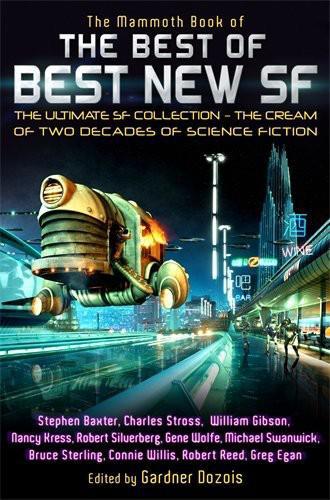
The Best of Best New SF
by
Gardner R. Dozois
Published 1 Jan 2005
I looked around and it was true: on the opposite side of the aisle, two seats ahead, Milo sat watching me over his shoulder, a trickle of blood running down his forehead. One corner of his mouth pulled tighter in a rueful smile. Mr. Graves came back from the front seat and shook my hand. I saw the fat singer from the country club, still naked. The locker-room boy. A flickering light from the back of the bus: when I turned around there stood the burning man, his eye sockets two dark hollows behind the wavering flames. The shopping-mall guard. Hector from the hardware store. They all looked at me. “What are you doing here?” I asked Ruth. “We couldn’t let you go on thinking like you do. You act like I’m some monster. I’m just a person.” “A rather nice-looking young lady,” Graves added.
…
“Actually, miss, the reason we caught on to you is that someone saw you walk into the men’s room.” He looked embarrassed. “But you didn’t catch me, did you?” Ruth snapped back. She turned to me. “You’re afraid of change. No wonder you live back here.” “This is all in my imagination,” I said. “It’s because of your drugs.” “It is all in your imagination,” the burning man repeated. His voice was a whisper. “What you see in the future is what you are able to see. You have no faith in God or your fellow man.” “He’s right,” said Ruth. “Bull. Psychobabble.” “Speaking of babble,” Milo said, “I figured out where you got that goo-goo-goo stuff. Talk – ” “Never mind that,” Ruth broke in.
…
That was a mistake: the bus began to pitch like a sailboat. I grabbed for Ruth’s arm but missed. “Who’s driving this thing?” I asked, trying to get out of the seat. “Don’t worry,” said Graves. “He knows what he’s doing.” “He’s brain-dead,” Milo said. “You couldn’t do any better,” said Ruth, pulling me back down. “No one is driving,” said the burning man. “We’ll crash!” I was so dizzy now that I could hardly keep from being sick. I closed my eyes and swallowed. That seemed to help. A longtime passed; eventually I must have fallen asleep. When I woke it was late morning and we were entering the city, cruising down Eglinton Avenue. The bus had a driver after all – a slender black man with neatly trimmed sideburns who wore his uniform hat at a rakish angle.
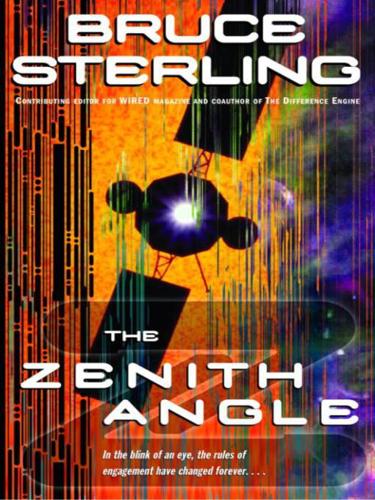
The Zenith Angle
by
Bruce Sterling
Published 27 Apr 2004
Of course the UFO was still up there. It wasn’t there like a piece of aircraft metal—it was there like a terrifying bloody haze, occult, supernatural. “Yeah. It’s still there. It’s hovering. I think it’s watching us.” “Tom, I never thought I would have to use this with you. But I learned this in the chill-out tent at Burning Man. Tell that thing to move, Tom. Give it an order, out loud. Speak right to it. Because if it’s all in your head, then it’ll do whatever you say.” “That proves I’m crazy.” “You’re the boss, Tom. Tell that thing where to get off.” DeFanti craned his neck and stared. He was encountering a UFO. He didn’t have many choices.
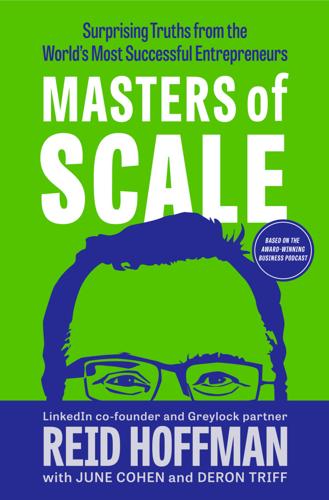
Masters of Scale: Surprising Truths From the World's Most Successful Entrepreneurs
by
Reid Hoffman
,
June Cohen
and
Deron Triff
Published 14 Oct 2021
So he asked himself, What would it look like if we could connect with our tribes and then use those tribes to find apartments and jobs and couches and cars? While it wasn’t initially aimed at any particular section of society, Tribe turned out to be very popular with certain subcultures—the most famous of these being people who attended Burning Man, the annual gathering in Nevada’s Black Rock Desert known for its countercultural creativity. While Tribe was a hit among this small but loyal user base, it failed to appeal to a more general audience. Looking back at it, Mark sees the exact moment he might have turned things around, if only he’d listened to a fateful and emphatic “No.”
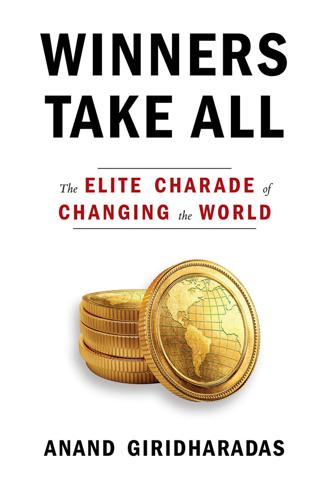
Winners Take All: The Elite Charade of Changing the World
by
Anand Giridharadas
Published 27 Aug 2018
The idea of doing well for yourself by doing good for others is a gospel, one that is celebrated and reevangelized at an unending chain of tent revivals around the world. The citizens of MarketWorld can reinforce the mission at conference after conference: Davos, TED, Sun Valley, Aspen, Bilderberg, Dialog, South by Southwest, Burning Man, TechCrunch Disrupt, the Consumer Electronics Show, and now, at Summit at Sea, on a cruise ship full of entrepreneurs wishing to change the world. Summit at Sea was a four-day-long maritime bacchanal honoring the credo of using business to change the world—and perhaps of using “changing the world” to prosper in business.

Falter: Has the Human Game Begun to Play Itself Out?
by
Bill McKibben
Published 15 Apr 2019
In southern Australia in 2018, Tesla announced plans to build the world’s largest “virtual power plant,” covering the roofs of fifty thousand homes with solar panels that will be linked together to supply the grid. The panels are going up on public housing first, cutting residents’ power bills by a third.12 Again, we’re not talking about earth shelters in Aspen built of adobe and old tires by former software executives who converted to planetary consciousness at Burning Man. The Borkowskis’ house couldn’t be more ordinary: the girls’ rooms feature Frozen bedspreads and One Direction posters, as well as two rabbits and a parakeet named Oliver. The family had no particular interest in the environment: “If it’s not on the Disney Channel, I don’t hear about it,” Sara told me.
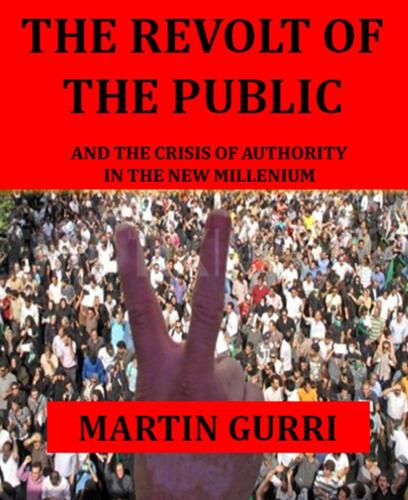
The Revolt of the Public and the Crisis of Authority in the New Millennium
by
Martin Gurri
Published 13 Nov 2018
The immoral act in question, let’s recall, consisted of teenagers exchanging music files.[11] Few incidents better illustrate the pervasiveness of authority as a belief system which anoints the chosen few, or the implacable fury of the anointed against a trespassing public. If Jack Valenti had had the power to convict Shawn Fanning to 19 ½ years in a Federal penitentiary, I’m fairly certain he would have done so. A Burning Man on Facebook Lights the Way for Political Change in Tunisia You could object that this has been a tragic tale, signifying nothing. Even if Hoder threatened the Iranian authorities on the plane of morality, little was changed down here on planet Earth. The Islamic Republic rolled on, dictatorial as always, still ruled by unpleasant men.
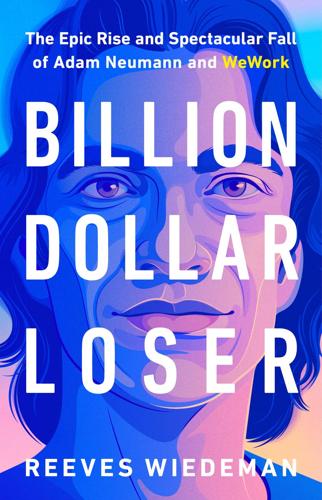
Billion Dollar Loser: The Epic Rise and Spectacular Fall of Adam Neumann and WeWork
by
Reeves Wiedeman
Published 19 Oct 2020
In August of 2014, WeWork’s two hundred employees boarded buses in New York and Boston, where the company had opened its newest location, to make their way to WeWork’s annual corporate retreat, called Summer Camp. The New York crowd gathered at sunrise in front of the American Museum of Natural History. “This is like a mini Burning Man,” one person said, standing in front of the statue of Theodore Roosevelt on horseback. At 6:45 a.m., someone opened a bottle of Patrón and offered a toast: “To Summer Camp!” For a third straight year, WeWork was hosting its employees and members at a children’s camp five hours north of New York City that was owned by the parents of Mark Lapidus, Rebekah’s cousin, who helped Adam land the Woolworth Building deal and had since joined WeWork as its head of real estate.

The Quiet Damage: QAnon and the Destruction of the American Family
by
Jesselyn Cook
Published 22 Jul 2024
They were floundering in the terminal months of a marriage consumed by truculent bickering and mutual resentment. Christopher was coming undone. He wanted to take the wheel, he just didn’t know how. Then Alice came along. She helped him rediscover the magic and the possibility in life. Fifteen years his junior, she was a radiant, spiritual, intensely kind and earnest Burning Man type with a silky-soft voice, elfin beauty, and an endearing innocence about her—the kind of person who still wished for world peace when she blew out the candles, and had the courage to do the things that made her happy. She spoke to a part of Christopher that had been screaming to get out. During his bitter ensuing divorce, as he was exiled from his social community, Alice welcomed him into her own, a potently progressive bubble of Bernie Sanders–loving, Donald Trump–hating free spirits who happily embraced him.
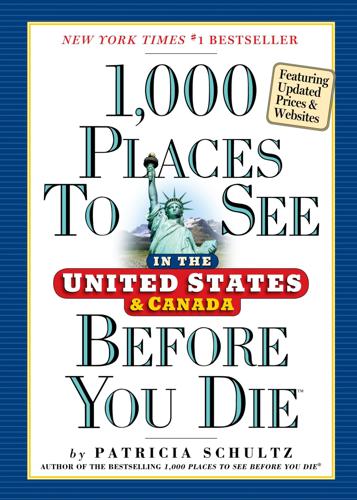
1,000 Places to See in the United States and Canada Before You Die, Updated Ed.
by
Patricia Schultz
Published 13 May 2007
Tel 800-241-3333 or 970-748-6200; www.ritzcarlton.com. Cost: from $195. BEST TIMES: ski season mid-Nov–early Apr. Party Arty BURNING MAN Black Rock City, Nevada Don’t worry if you can’t find Black Rock City on a map. It exists for only a few short days—erected on a playa, a dried-up lake bed, in the middle of the scorching Nevada desert. But for its self-proclaimed citizens, it is its own universe and the place they consider home. It is the setting for Burning Man, a weeklong art project/installation/festival that celebrates art, survival, and life—and the opportunity for some 25,000 fierce individualists to go crazy.
…
And yet participants, many of whom go year after year, report very little other than kindness, silliness, and great inspiration. The peak (though it takes place on the penultimate night) is the burning of the “Man,” a four-story wooden figure erected with great care, only to be destroyed in an act of sacrifice and acknowledgment of the fleetingness of art and life itself. Then the Tribe of the Burning Man returns to what clansmen call the “default world,” already planning for next year. WHERE: 120 miles north of Reno. Tel 415-TO-FLAME; www.burningman.com. Cost: from $225, includes entrance fee and a campsite. When: late Aug–early Sept. Where Have All the Cowboys Gone? COWBOY CULTURE Nevada The American cowboy is the very symbol of American spirit, strong and proud.
…
See Culinary Experiences, 1082 BREWSTER’S KANANASKIS GUEST RANCH, Alta., 1032 Brick Pit, Ala., 290 Bridal Veil Falls, Colo., 715 Bridal Veil Falls, N.Y., 999 BRIDGE DAY FESTIVAL, W.Va., 277, 281 Bridgehampton, N.Y., 160 Bridgehampton Polo Club, N.Y., 161–62 BridgePort Brew Pub, Oreg., 878 BRIDGES OF MADISON COUNTY, Iowa, 511, 522–23 Bridgeton, Ind., 512 Briermere Farms, N.Y., 164 Bright Angel Trail, Ariz., 685 Bright House Networks Field, Fla., 329 Brightwood Inn, Ill., 503 BRIMFIELD, Mass., 66–67 Brimfield Outdoor Antiques Show, Mass., 66–67 British Columbia, Canada, 1036–64 BRITT FESTIVALS, Oreg., 873–74 BROADMOOR, Colo., 707–8 Broken Group Islands, B.C., 1054 Broken Kettle Grasslands, Iowa, 519 Broken Spoke, Tex., 757 Bronx, N.Y., 196–98 BRONX ZOO, N.Y., 196–97 Brookings, Oreg., 877 Brooklin, Maine, 22–23 Brooklyn, N.Y., 198–200 BROOKLYN BOTANIC GARDEN, N.Y., 199–200 BROOKLYN BRIDGE, N.Y., 198–99 Brooklyn Museum, N.Y., 200 Brooks Lodge, Alaska, 921 Brown County State Park, Ind., 509 Bruce Museum, Conn., 6 Brush Creek Guest Ranch, Wyo., 672 Bryant Park, N.Y., 168 Bryant’s Barbecue, Mo., 455 Bryce Canyon Lodge, Utah, 790 BRYCE CANYON NATIONAL PARK, Utah, 789–90, 793 Bubba’s, Ark., 392 Bubba’s Bar-B-Que, Wyo., 669 Buckeye Trail, Ohio, 564 Buckhead, Ga., 335 Buckhorn Exchange, Colo., 712 Buckingham’s, Ill., 486 Buckman Tavern, Mass., 58 BUCKS COUNTY, Pa., 215–16 Bucks County Playhouse, Pa., 215 Buckstaff Bathhouse, Ark., 394 Buddy Guy’s Legends, Ill., 492 Buena Vista café, Calif., 851 Buena Vista Winery, Calif., 861 Buenos Aires National Wildlife Refuge, Ariz., 699 Buffalo, N.Y., 141–42 Buffalo Bill Cody Scenic Byway, Wyo., 664 Buffalo Bill Historical Center, Wyo., 664 Buffalo Bill Museum and Grave, Colo., 715 Buffalo Chip, S.Dak., 660 BUFFALO NATIONAL RIVER, Ark., 391 Buffalo Outdoor Center, Ark., 391 Buffalo Roundup, S.Dak., 654 Buffalo Roundup Arts Festival, S.Dak., 654 BUFFALO WINGS, N.Y., 141–42 Buffy’s, Mass., 52 Buhl Planetarium, Pa., 229 Bullfrog Marina, Utah, 792 Bully’s Soul Food, Miss., 441 Burdick Handmade Chocolates, N.H., 77 BURLINGTON, Vt., 92–93 Burlington Bike Path, Vt., 93 BURNING MAN, Nev., 724–25 Burntside Lodge, Minn., 549 Busch Gardens Williamsburg, Va., 256 Bushnell Park, Conn., 13 BUTCHART GARDENS, B.C., 1059–60 Butcher and Singer, Pa., 225 Butcher Hollow, Ky., 404 Butler, Md., 125 Butler Wash Petroglyph Panel, Utah, 789 Butterfly Tours, B.C., 1047 Buttermilk, Colo., 703 Byron T’s Saloon, N.Mex., 742 C Cabbage Key, Fla., 326 Caboose Ice Cream, Ga., 331 CABOT TRAIL, Cape Breton Island, N.S., 986–87 CADDO LAKE, Tex., 774–75 CAESARS PALACE, Nev., 727–28 Caesars Tahoe, Nev., 726 Café Adelphi, N.Y., 203 CAFÉ ANNIE, Tex., 772 Café Beaujolais, Calif., 830 Café Boulard, Fla., 325 Café Campagne, Wash., 898 Café Cardoza, Fla., 318 Café des Amis, La., 435 Café Diablo, Utah, 792 Café du Monde, La., 425 Café Poca Cosa, Ariz., 700 Café Vermilionville, La., 422 Café Wha?

The Stack: On Software and Sovereignty
by
Benjamin H. Bratton
Published 19 Feb 2016
The trial balloon of an information technology free zone echoes remarks made in 2013 by Google CEO Larry Page during his Google I/O keynote speech, as he wondered aloud about a “Google Island” where we “set aside a part of the world. … I think as technologists we should have some safe places where we can try out new things and figure out the effect on society. What's the effect on people, without having to deploy it to the whole world.”34 Page compared his speculative temporary autonomous zone to Burning Man, a city that comes and goes on an annual cycle unlike an actual island, and so of only limited experimental significance and value. Page's thought bubble presents more than few problems, even taken at face value (especially taken at face value). “Without having to deploy it to the whole world” implies that the island is a society-sized laboratory with all the standard measures in place to isolate and contain contaminants from entering or exiting.35 Accordingly the test-bed can prototype the ideal software society within its formal boundary only if that border is enforced by draconian walls and firewalls.
…
See also camp/enclave; walled gardens within airports, 155–156, 324 within cities, 311–312 conflicts, 9, 120, 144 economy of, 323 of enclosure and escape, 22, 32–33, 149–150, 172–176, 303 enforcing, 310 as envelope-interface, 172–173 formal and informal, 97 geopolitical geography of, 6–7, 97, 120, 144, 172–173, 308–310, 323–324, 409n42 globalization destabilizing and enforcing, 23 interfaces as, 220 Internet, 318 reversibility of, 23, 32–33, 148–149 of self, 262 software, 315 of technology, 29 virtual, 309 Borges, Jorge Luis, 209, 211, 363 Chinese Encyclopedia problem, 451n61 bots, 278, 344 boundaries of self, 262 Bourdieu, Pierre, 424n41 “Brain Is the Screen, The” (Deleuze), 219 brand, power of, 128, 130 Branzi, Andrea, 150–151 Brassier, Ray, 390n19 breach theory, 113 Brin, David, 454n75 Brin, Sergey, 139 Broad Museum, 320 bunker. See camp/enclave bureaucracy, 7, 342 Burning Man, 315 Burroughs, William S., 157 Bush, George W., 322 California Ideology, 57, 385n20 Calit2 (California Institute of Telecommunications and Information Technology), 267 CalTrans building, 320, 322–323 Calvino, Italo, 147 Cameron, David, 399n37 camp/enclave. See also borders defined, 368–369 exceptionality of, 23, 32–33 free of information technology, 313, 315 gated communities as, 311–312 interiority/exteriority of, 173–175, 311–312 nomos of the Modern, 20, 369 refugee, 174–175, 308, 312 reversibility of, 23, 32–33, 312, 324 walled gardens compared, 187 Campus 2 (Apple), 186–187, 189, 320 Čapek, Karel, 279 capital, computational, 80–81 capitalism accomplishments of, 332 algorithmic, 72, 80–81 Anthropocenic, 213 cognitive, 110, 116, 203, 241, 258, 295 digital, 80 future of, 321 industrial/postindustrial, 80, 128, 254 of people versus things, 212 capitalist pricing problem, 333, 337, 369 carbon economy, 98 carbon footprint China, 259 of data computing, 92–96 electricity generation, 95 India, 95 stabilizing, 259, 303 US, 259 carbon governance, 88–90 carbon police, 306 Carpenter, John, 427n51 cars car+phone hybrid, 280 communication in, 280 driverless, 238, 279–283, 342, 344, 437nn57–58 (see also Google Car) hacking, 283–284 human-driven, 283, 344–345 redefining, 238–239 vehicle-to-vehicle (V2V) networks, 281–282, 438n60 cartography function of the state, 119 cassiterite, 82 Castells, Manuel, 416n28 catallaxy, 329–331, 375 Celebration, Florida (Disney), 311 cellular phones.

The Inevitable: Understanding the 12 Technological Forces That Will Shape Our Future
by
Kevin Kelly
Published 6 Jun 2016
Avatars communicated via text balloons floating over their heads, typed by owners. It was like walking around in a comic book. This clunky interface held back any deep sense of presence. The main attraction of Second Life was the completely open space for constructing a quasi-3-D environment. Your avatar walked onto an empty plain, like the blank field at a Burning Man festival, and could begin constructing the coolest and most outrageous buildings, rooms, or wilderness places. Physics didn’t matter, materials were free, anything was possible. But it took many hours to master the arcane 3-D tools. In 2009 a game company in Sweden, Minecraft, launched a similar construction world in quasi-3-D, but employed idiot-easy building blocks stacked like giant Legos.
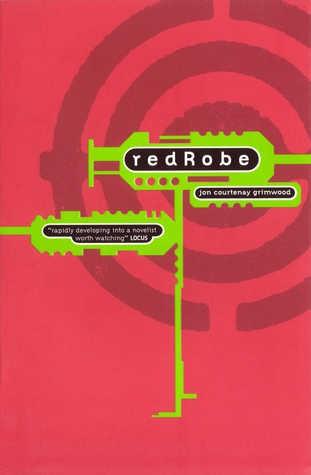
Redrobe
by
Jon Courtenay Grimwood
Published 1 Jan 2000
In one of the man’s hands was a rope, except that when the rope saw the Colt it opened its mouth and hissed. And the man’s other three arms were waving slowly like seaweed caught in a gentle tide as fire danced up his sides burying him beneath an aura of fractal-edged flame. ‘Fucking Jesus,’ said the Colt, and the burning man grinned. ‘Right idea, wrong culture.’ The Colt grinned back, wickedly. Still busy cutting itself in and out of loops, finessing silent corns connections… And if the old man of the flames knew what the ghost of the gun was doing he didn’t let it show. Though given the glint in a thousand eyes, the Colt wouldn’t have liked to bet on him not knowing.
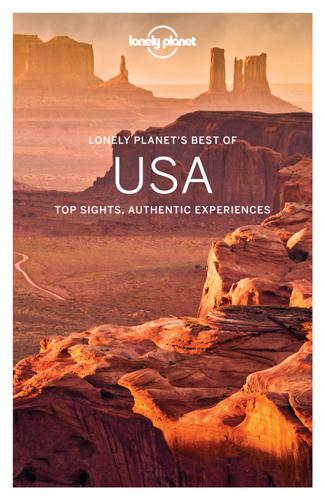
Lonely Planet's Best of USA
by
Lonely Planet
. (%415-831-1200; www.amoeba.com; 1855 Haight St; h11am-8pm) Amoeba Records / RANAPICS / ALAMY STOCK PHOTO © Britex Fabrics Fabric Map Google Map Runway shows can’t compete with Britex’s fashion drama. First floor: designers bicker over dibs on caution-orange chiffon. Second floor: glam rockers dig through velvet goldmines. Third floor: Hollywood costumers make vampire movie magic with jet buttons and silk ribbon. Top floor: fake fur flies as costumers prepare for Burning Man, Halloween or an average SF weekend. (%415-392-2910; www.britexfabrics.com; 146 Geary St; h10am-6pm Mon-Sat; g38, jPowell-Mason, Powell-Hyde, mPowell, ZPowell) Electric Works Art, Books Map Google Map Everything a museum store aspires to be, with a fascinating collection of arty must-haves – beeswax crayons, East German ice-cream spoons, Klein bottles, vintage wind-up toys – plus limited-edition prints and artists’ books by David Byrne, Enrique Chagoya and other contemporary artists.
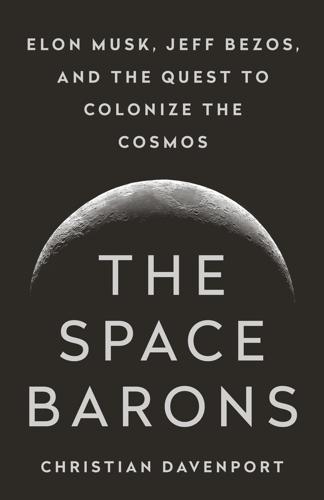
The Space Barons: Elon Musk, Jeff Bezos, and the Quest to Colonize the Cosmos
by
Christian Davenport
Published 20 Mar 2018
But they seemed to overlook a key detail—the Q & A session that would follow. The organizers left the microphones accessible to anyone in the audience, and it soon took a turn into the absurd, as general audience members took the opportunity to ask Musk whatever they wanted. Someone named Aldo, who sounded as if he was stoned, said he had just gotten back from Burning Man, the annual pilgrimage in the Nevada desert, where he said it was cold, dusty, and uncomfortable—and compounded by overflowing sewage. “Is this what Mars is going to be like—just a dusty, waterless shitstorm?” Aldo asked. Another guy told Musk he wanted to give him a comic book about the “first man on Mars, just like you.”
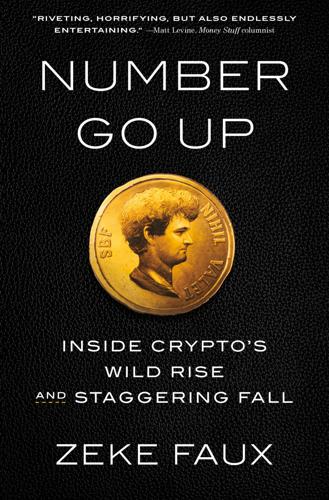
Number Go Up: Inside Crypto's Wild Rise and Staggering Fall
by
Zeke Faux
Published 11 Sep 2023
He had mounted a vanity presidential campaign in 2020, with the singer Akon as his chief strategist. He wore loud hats, vests, and bracelets, like Johnny Depp in Pirates of the Caribbean, and spoke in riddles, like Johnny Depp in Charlie and the Chocolate Factory. He had a tattoo of a scorpion on his right shoulder. He was, of course, a regular at Burning Man. CHAPTER THREE Doula for Creation Brock Pierce was at seemingly every crypto convention, but I’d had a hard time getting his undivided attention. I figured that Tether’s co-founder would know whether the company really had those billions of dollars in reserves. At least he would be able to give me a clue.

The Heat Will Kill You First: Life and Death on a Scorched Planet
by
Jeff Goodell
Published 10 Jul 2023
“Jonny was somewhat awkward in his own skin growing up,” Richard told me. “When he moved to San Francisco, he found his people. He loved it there.” Gerrish was six foot four and a bit shaggy, with a beard and longish hair that looked like a comb had never run through it. He wore Vans and supported Greenpeace and listened to techno and deep house music. Burning Man, the clothing-optional psychedelic super-rave that is held in the Nevada desert during the late summer, was his most holy holiday. His friends (of whom there were many) called him Jonny, a name that captured his boyish enthusiasm and charm. “You don’t see many men happier than Jonny,” a friend told me.
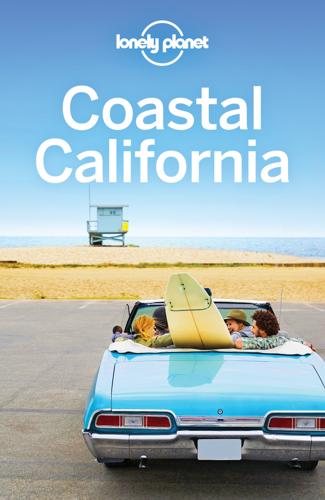
Coastal California Travel Guide
by
Lonely Planet
Jasper O’Farrell’sBAR ( GOOGLE MAP ; %707-829-2062; 6957 Sebastopol Ave; hnoon-2am) Busy bar with billiards and live music most nights; good drink specials. 7Shopping Antique shops line Gravenstein Hwy S toward Hwy 101. Funk & FlashCLOTHING ( GOOGLE MAP ; %707-829-1142; www.funkandflash.com; 228 S Main St; h11am-7pm) Disco-glam party clothes, inspired by Burning Man. Midgley’s Country Flea MarketMARKET ( GOOGLE MAP ; %707-823-7874; www.mfleamarket.com; 2200 Gravenstein Hwy S; h7:30am-4:30pm Sat, 6:30am-5:30pm Sun) The region’s largest flea market. Copperfield’s BooksBOOKS ( GOOGLE MAP ; %707-823-2618; www.copperfields.net; 138 N Main St; h10am-7pm Mon-Sat, to 6pm Sun) Indie bookshop with literary events.
…
I Madonnari Italian Street Painting FestivalART, FOOD ( GOOGLE MAP ; www.imadonnarifestival.com; hMemorial Day weekend, generally last weekend in May; c; g6, 11)F Colorful chalk drawings adorn Mission Santa Barbara’s sidewalks over Memorial Day weekend, with Italian-food vendors and arts-and-crafts booths too. oSummer Solstice CelebrationFESTIVAL (%805-965-3396; www.solsticeparade.com; hlate Jun)F Kicking off summer, this wildly popular and wacky float parade down State St feels like something out of Burning Man. Live music, kids' activities, food stands, a wine-and-beer garden and an arts-and-craft show happen all weekend long. Santa Barbara County FairFAIR ( GOOGLE MAP ; %805-925-8824; www.santamariafairpark.com; Santa Maria Fairpark, 937 S Thornburg St, Santa Maria; adult/child $10/8, child under 5yr free; hmid-Jul; c) This old-fashioned county fair combines agriculture exhibits, carnival rides and lots of food and wine.
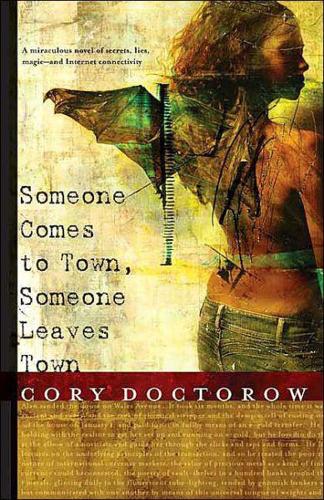
Someone comes to town, someone leaves town
by
Cory Doctorow
Published 1 Jul 2005
The idea had seized him. He was drunk on it. The buzzer sounded and Kurt got up to answer it. Alan craned his neck to see a pair of bearded neohippies in rasta hats. "Are you Kurt?" one asked. "Yeah, dude, I'm Kurt." "Marcel told us that we could make some money here? We're trying to raise bus fare to Burning Man? We could really use the work?" "Not today, but maybe tomorrow," Kurt said. "Come by around lunchtime." "You sure you can't use us today?" "Not today," Kurt said. "I'm busy today." "All right," the other said, and they slouched away. "Word of mouth," Kurt said, with a jingling shrug. "Kids just turn up, looking for work with the trash."
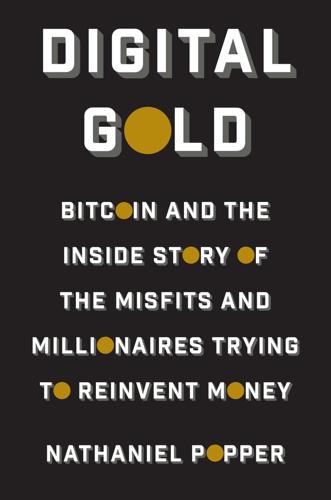
Digital Gold: Bitcoin and the Inside Story of the Misfits and Millionaires Trying to Reinvent Money
by
Nathaniel Popper
Published 18 May 2015
In 2009 Briger had been named cochairman of Fortress, which then controlled investments worth around $30 billion, including the resort company that owned the lodge where the men were staying. Wences was not an alpha male like most of the other guests. He liked to stay in touch with his humble origins in Patagonia, and his driveway was filled with Subarus instead of Teslas or sport cars. Rather than taking luxury vacations, Wences used his time off to go with his wife to Burning Man, and he had recently done a vision quest—involving days without any creature comforts—in the wilderness of the Andes with one of his best friends from his younger years in Argentina. But Wences had a good-natured self-confidence and a willingness to listen that had always allowed him to get along easily with hard-driving power players.

Digital Wars: Apple, Google, Microsoft and the Battle for the Internet
by
Charles Arthur
Published 3 Mar 2012
Eventually it ended in March 2001 when they hired Eric Schmidt. Born in April 1955, he was very experienced, the former chief executive of Novell – a company whose glory days were behind it and which was struggling to compete with Microsoft. Page and Brin also liked him because he had been to the Burning Man festival, a meeting place for geeks. The venture capitalists liked him because he looked like, as Schmidt put it, ‘adult supervision’. Boom With a business model in place, Google could expand aggressively. It started to benefit too from the network effect among advertisers. If you advertised on Google and you got business from it, then you’d probably point people back towards it.

The Upstarts: How Uber, Airbnb, and the Killer Companies of the New Silicon Valley Are Changing the World
by
Brad Stone
Published 30 Jan 2017
She helped Chesky recruit his original chief financial officer, Andrew Swain, who came from the accounting software maker Intuit, as well as Mike Curtis, vice president of engineering from Facebook, who could help Nate Blecharczyk manage a large engineering team and a global, rapidly scaling website. Chesky trusted Johnson and befriended her; they twice attended the annual Burning Man festival in the Nevada desert together with groups of friends and colleagues and he said they spoke “every day, multiple times a day.”2 Chesky had good reason to make a veteran attorney his first major outside hire. The company had mounting regulatory challenges around the world, where its fierce sense of its own righteous mission was clashing with an increasingly hostile reception in cities like San Francisco, Barcelona, Amsterdam, and particularly New York City, its largest market at the time.
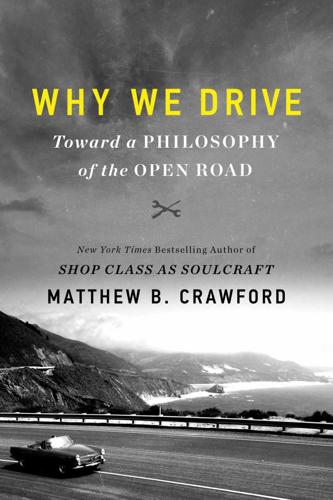
Why We Drive: Toward a Philosophy of the Open Road
by
Matthew B. Crawford
Published 8 Jun 2020
Act II: Adult Soap Box Derby A soapbox derby is a race, usually held by children, in which the cars are powered solely by gravity. Portland’s Adult Soapbox Derby has been running annually since 1997 on Mt. Tabor, a steeply hilled park within the city limits. The event’s website conveys the flavor of it—Burning Man on wheels would be an apt formula—and gives an account of its origins in an experience one of the founders had in San Francisco in 1994 when he witnessed a similar event. He describes the clothing first (“punk,” “postindustrial,” “ripped and stained pants”) and then the action, with some cars smashing into others.

The Future Is Faster Than You Think: How Converging Technologies Are Transforming Business, Industries, and Our Lives
by
Peter H. Diamandis
and
Steven Kotler
Published 28 Jan 2020
Buying a cup of coffee became an experience, a caffeinated theme park of sorts. The next iteration of this idea is the Transformation Economy, where you’re not just paying for an experience, you’re paying to have your life transformed by this experience. Early versions of this can be seen in the rise of “transformational festivals” like Burning Man, or fitness companies like CrossFit, where the experience is generally bad (you work out in old warehouses), but the transformation is great (the person you become after three months of working out in those warehouses). What all this tells us is that business as usual is becoming business unusual.
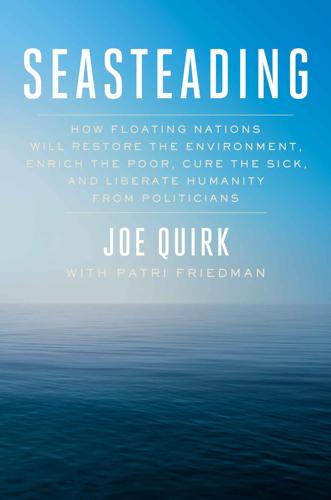
Seasteading: How Floating Nations Will Restore the Environment, Enrich the Poor, Cure the Sick, and Liberate Humanity From Politicians
by
Joe Quirk
and
Patri Friedman
Published 21 Mar 2017
Four years later, the principles of seasteading emerged in microcosm. Like a Fish to Water In the summer of 2009, the Seasteading Institute hosted the first annual floating festival of self-governance on the Sacramento Delta and called it Ephemerisle, which has since come to be known as “Burning Man on the water.” Every year, a few hundred people create a makeshift island by connecting a variety of boats, platforms, inner tubes, and floating art projects. Want to attend? Bring your own land. The annual event has since blossomed without our help and with no central organizer. This kick-start method is the essence of our nonprofit role.
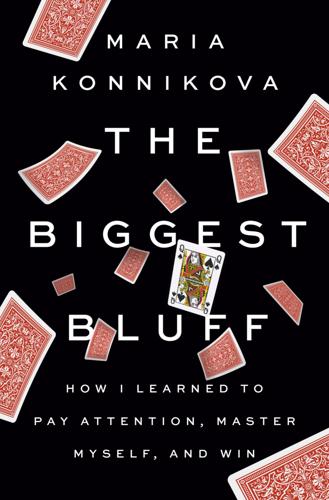
The Biggest Bluff: How I Learned to Pay Attention, Master Myself, and Win
by
Maria Konnikova
Published 22 Jun 2020
Kid Poker, who seems to be the only one happily chattering away. There’s a player who looks exactly like Harry Potter, a mess of dark hair swept to the side, dark-rimmed glasses, everything there but the scar (Ike Haxton, I’ll later learn). There’s one who looks like he’s arrived straight from Burning Man, with a shock of spiked neon pink hair (Justin Bonomo). Another who looks like he should be finishing an Ironman triathlon, not sitting playing cards (Jason Koon). One who looks like a very friendly cartoon character—every time I glance in his direction he is smiling and bopping his head to some inner music (Dan Smith).
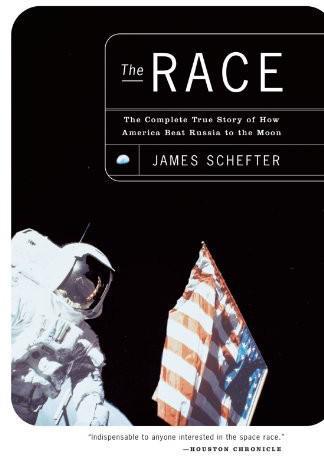
The Race: The Complete True Story of How America Beat Russia to the Moon
by
James Schefter
Published 2 Jan 2000
With the retros gone, Vostok’s ball shape sucked the thickening atmosphere around it and the tumbling rates slowed. Still it wobbled back and forth, up and down. He saw fire outside and heard crackling sounds. But the all-encompassing asbestos heat shield was working. Vostok did not come apart. Nor did it flare briefly and brightly and burn man and ship into the nothingness of superheated molecules. The spinning and g-forces grayed out Gagarin’s vision for a long moment. Then it was over. Gravity felt normal. He heard air whistling outside. It was time to bring the adventure to its end, and to begin a deceit that Yuri Gagarin and all the Soviet space experts would play out in public for years to come.

Machines of Loving Grace: The Quest for Common Ground Between Humans and Robots
by
John Markoff
Published 24 Aug 2015
In 2003 Intraspect was sold for a fire sale price to Vignette and that was the end. Gruber stayed at Vignette for a couple of months and then took a year off to recharge and think about what he would do next. He traveled to Thailand, where he went scuba diving and took pictures. He discovered Burning Man, the annual weeklong gathering in the Nevada desert that attracted tens of thousands of the Valley’s digerati. When Gruber’s sabbatical year ended he was ready to build a new company. He knew Reid Hoffman, who had by then started LinkedIn, the business networking company. Because of his experience at Intraspect, Gruber had good insights into “social software.”
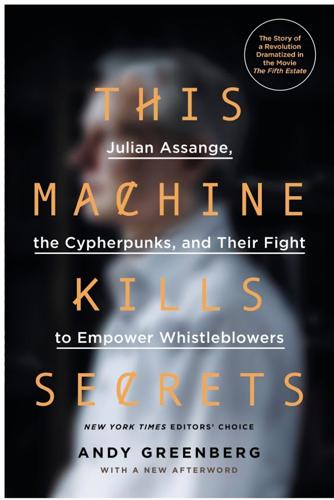
This Machine Kills Secrets: Julian Assange, the Cypherpunks, and Their Fight to Empower Whistleblowers
by
Andy Greenberg
Published 12 Sep 2012
The three thousand or so hackers hold research presentations in underground hangars on code-breaking, government surveillance, and insanely ambitious DIY projects. (One talk at the latest Camp set a new goal for the CCC: Put a hacker on the moon by 2034.) At night, they build elaborate light-shows and sculptures around the remains of the Soviet aircraft and tanks that litter the terrain. The result is something like a colder, wetter Burning Man for the radical geek elite. I spend my first two hours at the Chaos Communication Camp wandering in the dusk around the surreal ruins: past a statue of Lenin with headphones and turntables added to convert him into a socialist DJ, a rusting fighter jet with elaborate rainbow-knitted caps for its pointed engines and nose.

User Friendly: How the Hidden Rules of Design Are Changing the Way We Live, Work & Play
by
Cliff Kuang
and
Robert Fabricant
Published 7 Nov 2019
The contours of his life are those of the protagonist from a docu-comedy about Silicon Valley. Summing up one of his Facebook posts, Wikipedia reported, “He dated a woman named Jordan starting in 2010, but her path to Peruvian shamanism ended their love, so Rosenstein had a heart sculpture constructed at Burning Man that featured lyrics from songs she had written, and they planned an epic friendship.”4 But Rosenstein also has a numinous earnestness. So while his Facebook stock eventually became worth hundreds of millions, he seemed to have no interest in it at all. He locked it away in a trust and promised to give it away before he spent any.5 Instead of his own mansion, he lived in a twelve-person commune called Agape among other entrepreneurs with New Agey sidelines.6 He is also a genius in at least one way.

Ukraine
by
Lonely Planet
The town’s central Pysanky Museum, housed in a giant Easter egg, is the obvious highlight, but aimless wandering also bears fruit in the shape of some twirling art nouveau architecture from the town’s Austro-Hungarian days. ULANA SWITUCHA/ALAMY Sheshory (ArtPole) Festival 10 Think Woodstock meets Burning Man and you have Sheshory (Click here), an annual three-day gathering in mid-July of musicians and artists from all over Eastern Europe. For the first few years the event was held in the Carpathian village of Sheshory, but has since gone walkabout, and now the action takes place in rural Podillya. If your experience of Ukraine has been mostly scowling receptionists and shop assistants with dyed hair, the hippy spirit of the Sheshory festival comes as a very pleasant surprise.
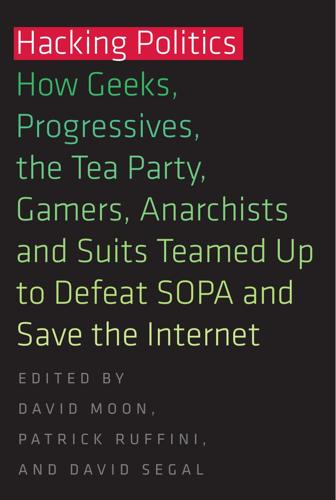
Hacking Politics: How Geeks, Progressives, the Tea Party, Gamers, Anarchists and Suits Teamed Up to Defeat SOPA and Save the Internet
by
David Moon
,
Patrick Ruffini
,
David Segal
,
Aaron Swartz
,
Lawrence Lessig
,
Cory Doctorow
,
Zoe Lofgren
,
Jamie Laurie
,
Ron Paul
,
Mike Masnick
,
Kim Dotcom
,
Tiffiniy Cheng
,
Alexis Ohanian
,
Nicole Powers
and
Josh Levy
Published 30 Apr 2013
Or is it a creation of the software’s originator, since all of the player’s moves are necessarily allowed for by the work of the engineers and artists who put the game together? It’s an intriguing, if obscenely esoteric, debate of the sort that might be fodder for an undergrad’s final paper in a media studies class, or ought to be had as technologists and hippies confab over peyote in the Nevada desert at Burning Man each summer—but suffice it to say that we don’t think the world should be such that the answers to these questions might determine whether or not somebody goes to prison or has to pay exorbitant fines. The fact that these considerations are even at hand is just further evidence that we’ve drawn copyright laws along ludicrously fundamentalist lines.

Stamping Butterflies
by
Jon Courtenay Grimwood
Published 1 Jan 2004
"Want one?" Another silence. This didn't worry Petra Mayer, who'd once ingested so much lysergic acid diethylamide that it was seventy-six hours before the Wernicke area of her brain could organize enough words to tell a very pretty German boy about the rainbow on the tip of her tongue. They were at the Burning Man in Nevada. Needless to say, no one else noticed a thing. "Okay." Putting flame to her cigarette, the small woman smiled. "Let me tell you what's going on. As I said, my name is Professor Petra Mayer and for the purposes of irritating the Pentagon I've been made a general in the US Army. I am here at the direct request of the President of the United States of America.
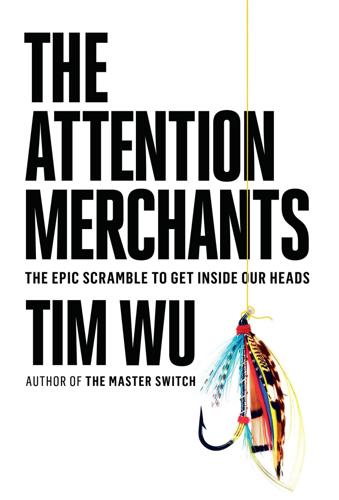
The Attention Merchants: The Epic Scramble to Get Inside Our Heads
by
Tim Wu
Published 14 May 2016
In that way the early web was exactly like the 1960s counterculture: it encouraged both a Great Refusal of what had always been handed down from on high, and asked people to spend more time with each other. It asserted that money need not be involved in attentional barter, and that everyone had an inherent potential to be a creator. In the early days at some companies, like Google, the link was more explicit, with much of the company retreating to the Burning Man festival every year and management espousing the value of putting in place a practical, pragmatic implementation of the counterculture’s ideas. Perhaps that’s why in the early 1990s, Timothy Leary advised people to “turn on, boot up, jack in”; he even wrote a computer game.15 As in the 1960s, this great turning away was the cause of no little consternation, if not degrees of panic, in the old attention industries.
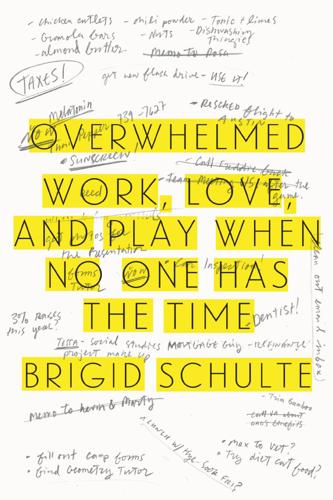
Overwhelmed: Work, Love, and Play When No One Has the Time
by
Brigid Schulte
Published 11 Mar 2014
Divorced with two grown children and living alone, Robinson will sometimes hop the Metro in D.C. with The Washington Post’s Weekend Section and no idea where he’s going. He gets off when he feels like it and sets off for adventure. He watches late-night TV because he can and runs two miles every day. He spends winters at a condo in Berkeley, is a proud member of BURP, a Belgian beer-tasting society, and makes an annual pilgrimage to Burning Man, the wild, no-holds-barred free-for-all that culminates in a fiery conflagration in the Nevada desert. A few days earlier, Robinson had given me the first of his “leisure lessons”—to just have fun—taking me to a cheap secondhand wedding apparel store near the train station. I had dutifully shuffled along behind him as he scoured racks of clothing, until my head began to hurt and I just wanted to sit down.

Actionable Gamification: Beyond Points, Badges and Leaderboards
by
Yu-Kai Chou
Published 13 Apr 2015
Google’s playful culture was also famously demonstrated by their periodic logo changes. Major holidays, historic dates, or notable current events are periodically represented by logo doodles, which inspires a lot of Core Drive 7 among their users. The first doodle was created in 1998 to mark the first full company trip to the week-long Burning Man festival. The doodles and the I’m Feeling Lucky Button have remained intact within the company culture despite their transformation into something “more corporate-like” in the early 2010’s. More recently, Google changed the “I’m Feeling Lucky” button so that, true to Core Drive 7 principles, when users moused-over it, a slot machine mechanism is revealed, featuring different search options.
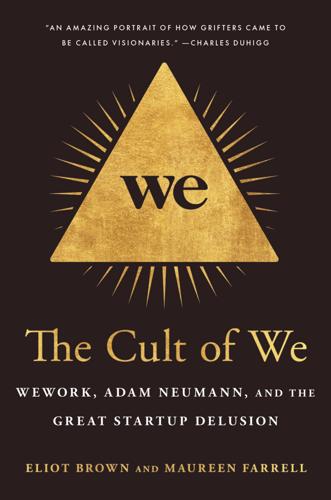
The Cult of We: WeWork, Adam Neumann, and the Great Startup Delusion
by
Eliot Brown
and
Maureen Farrell
Published 19 Jul 2021
Like WeWork at the time, it was scrappy—canoes were stuffed with ice and cans of Coors Light—and somewhat intimate. Work was sprinkled amid play; Neumann once led an introspective discussion with thirty people about what was working and what wasn’t inside WeWork. At night he’d party with everyone. In the years since, it had ballooned into a massive production—part music festival, part Burning Man, part corporate development retreat—all caked in exuberant partying and cultlike self-adulation. It was meant for staff for the first half, then opened up to WeWork members, too, to party alongside the employees. Startups and money-losing tech companies had become notorious for injecting their workplaces and off-site events with perks that seemed more out of a frat house than a workplace.
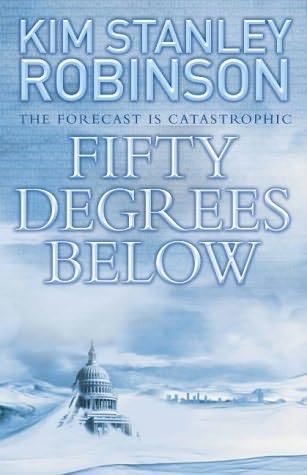
Fifty Degrees Below
by
Kim Stanley Robinson
Published 25 Oct 2005
In the immediate vicinity of this newly-identified “Pole Berg” idled many of the largest ships in the fleet, ranging from small cruise ships to huge private yachts, with a few old icebreakers on hand as well, looking overweight and unwanted. This was the fifth midsummer festival at the Pole. Every year since lanes of water had opened in the summer Arctic ice, a larger and larger group of sea craft had sailed or motored north to party at the pole. The gatherings had a Burning Man festival aspect to them, the sybaritic excess and liberal shooting off of fireworks leading many to call it Drowning Man, or Freezing-Your-Butt-Man. This year, however, the party had been somewhat taken over by the Inuit nation Nunavut, in conjunction with the Intergovernmental Panel On Climate Change, who had declared this “The Year of Global Environmental Awareness,” and sent out hundreds of invitations, and provided many ships themselves, in the hope of gathering a floating community that would emphasize to all the world the undeniable changes already wrought by global warming.
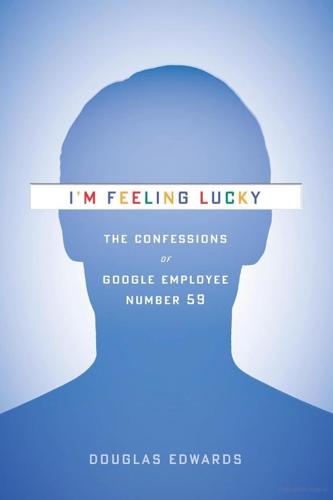
I'm Feeling Lucky: The Confessions of Google Employee Number 59
by
Douglas Edwards
Published 11 Jul 2011
And though we had millions of users, we were hardly so well known that we could assume people already had our brandmark burned into their brains. Sergey didn't see the big deal. He had changed the logo twice during Google's infancy, adding a clip-art turkey on Thanksgiving in 1998 and putting up a Burning Man* cartoon when the staff took off to explore nakedness in the Nevada desert. But now Google was a real company, I reminded him. Real companies don't do that. Even as we argued, Sergey enlisted webmaster Karen White to resurrect the turkey for Thanksgiving, create a holiday snowman in December, and festoon the logo with a hat and confetti for New Year's 2000.
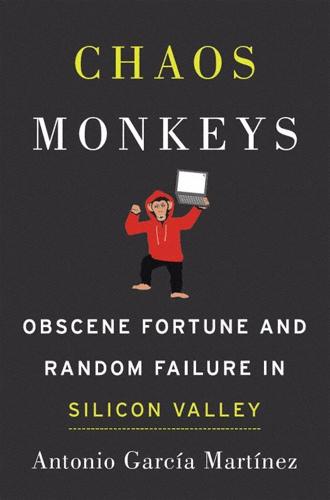
Chaos Monkeys: Obscene Fortune and Random Failure in Silicon Valley
by
Antonio Garcia Martinez
Published 27 Jun 2016
These are the only real values we have left in the twilight of history, the tired dead end of liberal democratic capitalism, at least here in the California fringes of Western civilization. Clap at the clever people getting rich, and hope you’re among them. Is it a wonder that the inhabitants of such a world clamor for contrived rituals of artificial significance like Burning Man, given the utter bankruptcy of meaning in their corporatized culture? Should we be surprised that they cling to identities, clusters of consumption patterns, that seem lifted from the ads-targeting system at Facebook: “hipster millennials,” “urban mommies,” “affluent suburbanites”? Ortega y Gasset wrote: “Men play at tragedy because they do not believe in the reality of the tragedy which is actually being staged in the civilized world.”

Evil Geniuses: The Unmaking of America: A Recent History
by
Kurt Andersen
Published 14 Sep 2020
He was a true believer who needed to keep feeling the rage, for whom politics as well as religion was a fundamentalist crusade where compromise was an abomination, an archetypal Fox News viewer before Fox News existed.*1 He wasn’t one of the cynics and operators. Nor was he a consistent libertarian like Norquist, one of the overgrown boys who hated taxes as much as they loved Burning Man and themselves. Rather, Weyrich was the ultimate late-stage Republican because he madly dreamed of returning America to the past in all ways, both the political economy and the culture. He sincerely wanted business unregulated and the rich untaxed and government minimized, and he sincerely pined for an explicitly Christian culture bordering on theocracy where women didn’t have equal rights and racial segregation was considered okay.*2 * * * — The surname Sununu is familiar today mainly because of a pair of recent New Hampshire politicians, a governor and a U.S. senator, but the most significant Sununu was their father, John H.
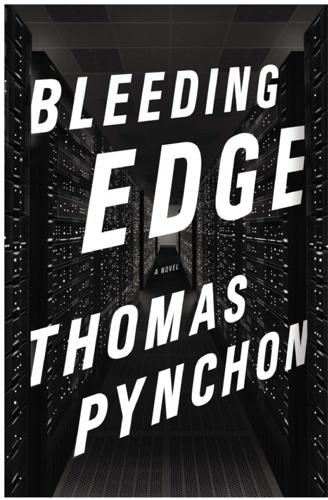
Bleeding Edge: A Novel
by
Thomas Pynchon
Published 16 Sep 2013
’cause I need to, don’t I—aahhrrgghh!’ “‘You’re . . . into pain? you’re a nutcase? what is it? Why not just let it go?’ “‘OK, check it out—can’t you see how beautiful it is? lookit, the way it glows? like, the different colors? and aahhrrhh, shit . . .’ “‘But carrying it around in your hand like this, it’s giving you third-degree burns, man, couldn’t you like set it down someplace and just look at it?’ “‘Somebody might take it.’ “So forth.” “So,” Maxine asks, “what happens? He lets go of it?” Shawn gives her a nice long stare and with Buddhist precision, shrugs. “He lets go of it, and he doesn’t let go of it.” “Uh, huh, I must’ve said something wrong.”

The 4-Hour Chef: The Simple Path to Cooking Like a Pro, Learning Anything, and Living the Good Life
by
Timothy Ferriss
Published 1 Jan 2012
He’s duct-taped a tube onto the exhaust release, and the carbon monoxide is going straight out a window. I strike up a conversation with “Bob” and ask him about the make and model. It is a Honda EU2000i, the preferred generator for die-hard “Burners,” as he points out. Burners are attendees of the annual Burning Man event, which takes place on the Nevada salt flats and lasts more than a week. The mantra: bring everything you need, leave nothing. I’d been twice, which explained why I recognized the sound. By 5 p.m., two more men have discovered Bob’s “thump, thump” and are asking if they can borrow it. His tool was what everyone needed and he was now the unenviable center of attention.

May We Be Forgiven
by
A. M. Homes
Published 14 Jun 2012
I ask, figuring I should take care of a few things on my checklist while I’ve got him on the phone. “Chocolate,” he says. “And what about the Torah—have you decided what you want to do in terms of a reading?” “You know,” he says, “I’m not really so into Hebrew as a language. I kind of want to write my own thing.…” “Consisting of what?” “Have you ever been to Burning Man?” Sofia sends out the invites, each addressed in her beautiful calligraphic script. She gives me a computer spreadsheet to track the RSVPs. I know the invitations have landed when Cousin Jason starts e-mailing me bad press about South Africa, articles saying that car crashes are the leading cause of tourist death, and about how many people are mugged at the airports, and that there’s been increased violence against white people and diseases like Ebola, and that if you’re stopped at a red light at night, people will come and smash your windows and grab whatever is in your car, or hijack you.

New York 2140
by
Kim Stanley Robinson
Published 14 Mar 2017
They put it in bumper sticker terms: massive sea level rise sure to follow our unprecedented release of CO2! They published their papers, and shouted and waved their arms, and a few canny and deeply thoughtful sci-fi writers wrote up lurid accounts of such an eventuality, and the rest of civilization went on torching the planet like a Burning Man pyromasterpiece. Really. That’s how much those knuckleheads cared about their grandchildren, and that’s how much they believed their scientists, even though every time they felt a slight cold coming on they ran to the nearest scientist (i.e. doctor) to seek aid. But okay, you can’t really imagine a catastrophe will hit you until it does.

The Pot Book: A Complete Guide to Cannabis
by
Julie Holland
Published 22 Sep 2010
In fact, in my own informal polling, the impact of marijuana on motivation was second only to “paranoid effects” as a reason for quitting the drug altogether. Given all this, what I had most trouble understanding were the kinds of people—old friends from my college days, for instance—who could work as stockbrokers or corporate lawyers all day for months on end, and then charter a jet out to a rock concert or the Burning Man festival and smoke pot for a week. Not only did they seem capable of surviving pot’s introspective zone with nary a guilty flush, they could go back to work Monday morning and continue to push “interest free” mortgages or other shamelessly predatory financial instruments. I finally decided to spend a weekend with them to figure out their formula for maintaining such a decidedly arm’s-length relationship with a drug that so many others experience as all-or-nothing.

Like Dreamers: The Story of the Israeli Paratroopers Who Reunited Jerusalem and Divided a Nation
by
Yossi Klein Halevi
Published 4 Nov 2014
A scout was killed, and others leaped over the bridge, a seven-meter fall. One man held on to the edge with burned hands. A jeep tried to turn around and crashed into the jeep just behind it. The lead tank too tried to turn around and toppled into the valley below. A soldier was on fire. Another rushed over, tearing off the wounded man’s clothes. Shoot me, the burning man pleaded. His rescuer hoisted him over his shoulders. A Jordanian bullet hit the wounded man in the head. The main part of the scouts’ column hadn’t yet left the area near the Rockefeller. Arik ran toward the jeeps. “Stop!” he shouted at Kapusta, the commander. Motta ordered tanks from another unit to prepare to move out, toward Augusta Victoria.

Facebook: The Inside Story
by
Steven Levy
Published 25 Feb 2020
Pincus hedged his bet: he split his $15,000 investment with a friend. Now the social-media idea was taking off. Pincus had started a social-network site called tribe.net, devoted to local community building. He thought of it like Craigslist with pictures. It became best known as the digital glue behind the “burners” who attended the Burning Man festival in the Nevada desert. But it had yet to explode more generally, and it wasn’t clear that it would. And now Parker was telling him about a kid with what might be the best bet yet. Some months before, well before anyone in Silicon Valley was paying attention to a site working out of a dorm room to connect college students, some interesting news had reached Hoffman: the sixdegrees patent was going up for auction.
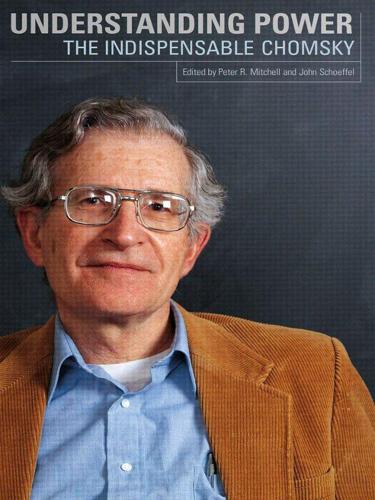
Understanding Power
by
Noam Chomsky
Published 26 Jul 2010
I mean, I think people have a right to burn books if they want. I was in fact interviewed about it, I said the obvious thing—I’d rather they read them than burn them, but if they want to burn them, I don’t care. Actually, you don’t really have to worry about burning books—burning books is virtually impossible. Books are like bricks: they’re very hard to burn. MAN: Was that a popular rabble or something? How did it happen? It was actually Vietnamese refugees. There’s a Vietnamese refugee community that heard, or decided, or whatever, that I was … I don’t know what. It was impossible to find out what they’d heard. They obviously knew that I was against the Vietnam War, and they were obviously very pro-war—you know, they thought the Americans should have stayed in and won it, that’s why they’re Vietnamese refugees.
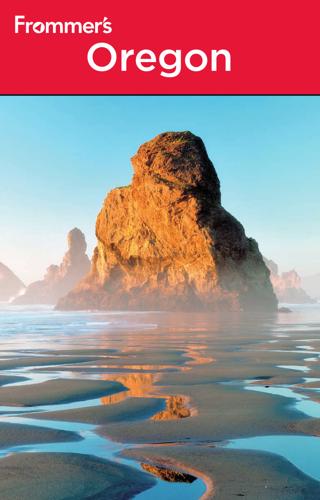
Frommer's Oregon
by
Karl Samson
Published 26 Apr 2010
Summer Lake Hot Springs, 41777 Ore. 31, Paisley, OR 97636 (& 541/943-3931; www.summerlakehotsprings.com), 125 miles southeast of Bend on Ore. 31, has rock-lined, open-air soaking pools and a hot swimming pool inside an old barn. There are also two houses ($125–$150 per night) and two adorable cabins done in a sort of architectural salvage/shabby-chic styling ($75 per night). This place is something of a counterculture resort and is particularly busy during summer music festivals and before and after the Burning Man festival in Nevada. Crystal Crane Hot Springs, 59315 Ore. 78, Burns, OR 97720 (& 541/4932312; www.cranehotsprings.com), 25 miles east of Burns on Ore. 78, is a bit less off the beaten path if you happen to be out this way birding at Malheur National Wildlife Refuge. Here you’ll find a hot-springs-fed pond for swimming ($3.50 day-use fee) and several indoor private soaking tubs that can be rented by the hour ($7.50 per person per hour; reservations recommended).
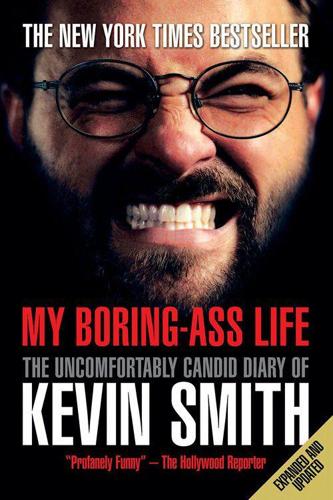
My Boring-Ass Life: The Uncomfortably Candid Diary of Kevin Smith
by
Kevin Smith
Published 24 Sep 2007
Wake up, shower, and head to Harley’s school, where we drop off a bunch of her old toys and books and head to a meeting of first and second grade parents with the new Principal. An hour and a half later, we head home, and I check email ‘til it’s time to work out with Larry. We do the dog walk, during which he tells me all about his week at Burning Man. We shoot back to the home gym and do legs (weights, squats, and lunges) for an hour. When we’re done, I climb into my woobs and bury myself in the home office most of the day, iChatting with Scott about Clerks 2 stuff, including the A.D. choices. By day’s end, we hire the dude who’s gonna be the 1st A.D. for our seventh film.
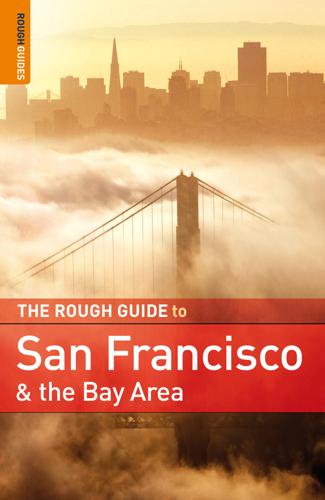
Rough Guide to San Francisco and the Bay Area
by
Nick Edwards
and
Mark Ellwood
Published 2 Jan 2009
F e s ti val s and e v e n t s August | August • September AfroSolo Arts Festival (Aug through Oct; t 415/771-2376, w www.afrosolo.org) This annual arts, music, and culture festival, held in various locations, celebrates the works, struggles, and achievements of AfricanAmericans and artists from all over the African Diaspora. Nihonmachi Street Fair (early Aug; t415/7719861, w www.nihonmachistreetfair.org) Weekend-long Pan-Asian festival, centered on the Japan Center, with lion dancers, plenty of kids’ amusements, and even an Asian-American bike show. The big draw, though, is the delicious food. Burning Man (last week of Aug & first of Sept; t 415/863-5263, w www.burningman.com) When an artist called Larry was dumped by his girlfriend, he reacted by creating an effigy of her and burning it on Ocean Beach. That single act of romantic defiance has morphed into this surreal event, with very expensive tickets, when locals and visitors now head for a psychedelic stay in the Black Rock Desert camping in a temporary money-free civilization with elaborate art installations, dancing, and generally tripping out, all the activities centered on a fifty-foot sculpture that’s ritually burned at the end of the festival.
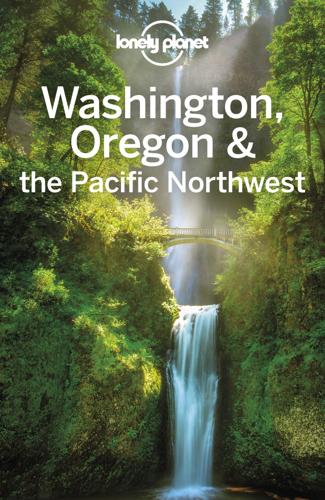
Lonely Planet Washington, Oregon & the Pacific Northwest
by
Lonely Planet
oSummer Lake Hot SpringsCABIN$$ (%541-943-3931; www.summerlakehotsprings.com; 41777 OR 31, Paisley; cabins $100-250, camping $20; Ws#) S Cozy pine cabins, all with geothermal-heated floors and kitchens, sit in this beautiful, sparse landscape. There are rock-lined outdoor pools and a big indoor pool making this one of the nicest, rustic-style hot spring ‘resorts’ in the state. It’s a popular stop for Oregonians heading to/from the Burning Man festival in California every September. Day-use of the thermal pools is $10. 6Drinking & Nightlife Pioneer Saloon & RestaurantPUB (%541-943-3289; 327 Main St, Paisley; mains $7-12; h10am-8pm, to 9pm Sat, closed Mon) This historic Old West saloon, built in the 1880s, has a great atmosphere, with cattle brands and barbed-wire on the walls and an antique carved-wooden bar.
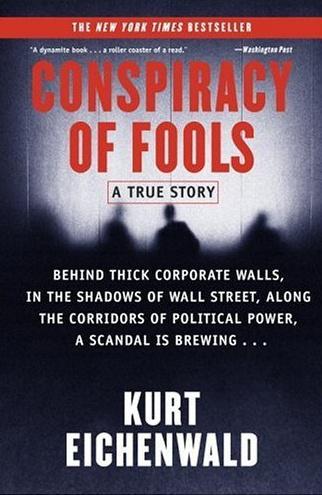
Conspiracy of Fools: A True Story
by
Kurt Eichenwald
Published 14 Mar 2005
Lay and Seidl knew someone had to pay the price for the debacle, and it certainly was not going to be Lay. While Seidl continued at Enron for a couple of years, his responsibilities gravitated to Rich Kinder, now working as chief of staff, sort of a roving Mr. Fixit. While Seidl was viewed internally as indecisive, Kinder was a barn-burning man of action who inspired fear in Enron’s executive ranks—just the sort of manager the company needed. Lay acknowledged soon after the announcement of the trading losses that Enron would have to change its ways. In late October 1987, he called an all-employee meeting in Houston. He held himself up as a victim of Borget and Mastroeni, as someone who had no reason to suspect the problems in Valhalla.
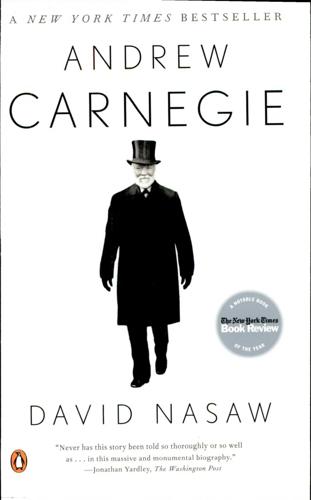
Andrew Carnegie
by
David Nasaw
Published 15 Nov 2007
He had even dictated a short statement on the occasion of his birthday: “Say to the reporters who usually call on my birthday that all goes well with me. Dr. Garmany marvels at the splendid return to health which a Summer on the Maine Coast has wrought. The world grows better and we are soon to see blessed peace restored and a world court established, when, in the words of Burns: Man to man the world o’er Shall brothers be for a-that. For his friends, his extended silence was both baffling and frightening. Not only had he given up public appearances, interviews, visits to Washington, after-dinner speeches, and his letters to the editor, but he had stopped communicating with them as well.
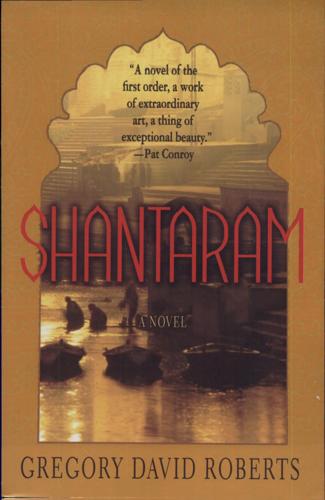
Shantaram: A Novel
by
Gregory David Roberts
Published 12 Oct 2004
It was the kind of breathing that does more harm than good. I suddenly realised that I hadn’t eaten for too many hours, and I was very hungry. With that thought—hunger, food—I felt sick for the first time. I felt the sweaty wave of nausea surge over me, and I shook my head free of it. When we returned our attention to the burned man we found that he, too, had succumbed. I covered the still body with a canvas camouflage drop-sheet. My last glimpse of his scorched, featureless, melted face became a prayer of thanks. One of the agonising truths for a battle medic is that you pray as hard and almost as often for men to die as you pray for them to live.

Lonely Planet Mexico
by
John Noble
,
Kate Armstrong
,
Greg Benchwick
,
Nate Cavalieri
,
Gregor Clark
,
John Hecht
,
Beth Kohn
,
Emily Matchar
,
Freda Moon
and
Ellee Thalheimer
Published 2 Jan 1992
CAR & MOTORCYCLE To rent a car, call Hertz ( 313-53-28), at the airport, or Budget ( 315-99-42; Av Camelinas 2315). Return to beginning of chapter RESERVA MARIPOSA MONARCA In the easternmost corner of Michoacán, straddling the border of México state, lies the incredible 563-sq-km Monarch Butterfly Reserve (admission M$35; 6am-6pm mid-Nov–Mar), the site of the butterfly Burning Man. Every autumn, from late October to early November, millions of monarch butterflies flock to these forested Mexican highlands for their winter hibernation, having flown all the way from the Great Lakes region of the US and Canada, some 4500km away. As they close in on their destination they gather in gentle swarms, crossing highways and fluttering up steep mountainsides where they cling together in clusters that weigh down thick branches of the oyenal (fir) trees.